Early Los Angeles City Views (1900 - 1925)
Historical Photos of Early Los Angeles |
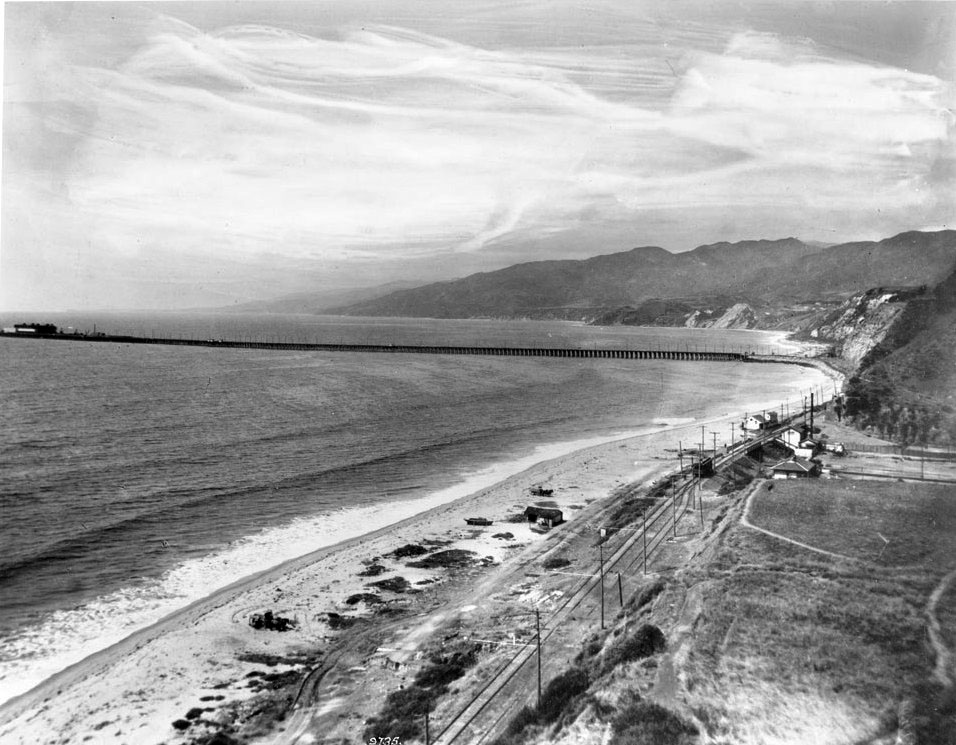 |
||
| (ca. 1912)^^ - View of Santa Monica Canyon and Long Wharf. The entrance to the Santa Monica Canyon is to the right. Railroad tracks and a pole line can be seen running parallel to the beach. The mountains along the Pacific coastline are visible in the distance. The long dock extends from the beach on the right to a large ship in the open ocean on the left. |
Historical Notes When the Southern Pacific Railroad arrived at Los Angeles, a controversy erupted over where to locate the city's main seaport. The SPRR preferred Santa Monica, while others advocated for San Pedro Bay. The Long Wharf was built in 1893 at the north end of Santa Monica to accommodate large ships and was dubbed Port Los Angeles. At the time it was constructed, it was the longest pier in the world at 4700 feet, and accommodated a train.*^ However, just a short four years after the Long Wharf's construction, San Pedro Bay was chosen over Santa Monica to be the main seaport of Los Angeles. The Long Wharf was demolished in 1920. |
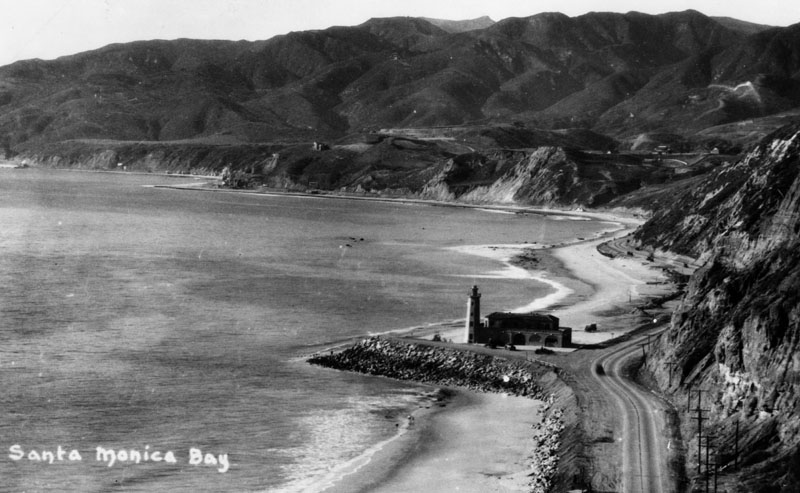 |
||
| (ca. 1927)^ - View of the Santa Monica Bay coastline, showing a lighthouse and bathhouse near the Pacific Palisades. The lighthouse stands at the spot where the Long Wharf used to extend out into the ocean. |
Historical Notes The Pacific Palisades lighthouse was built as a bathhouse with a working light in 1927. In the early 1930s the structure along with the beach was sold to Will Rogers and later the beach was given to the state of California and renamed the Will Rogers State Beach.^ |
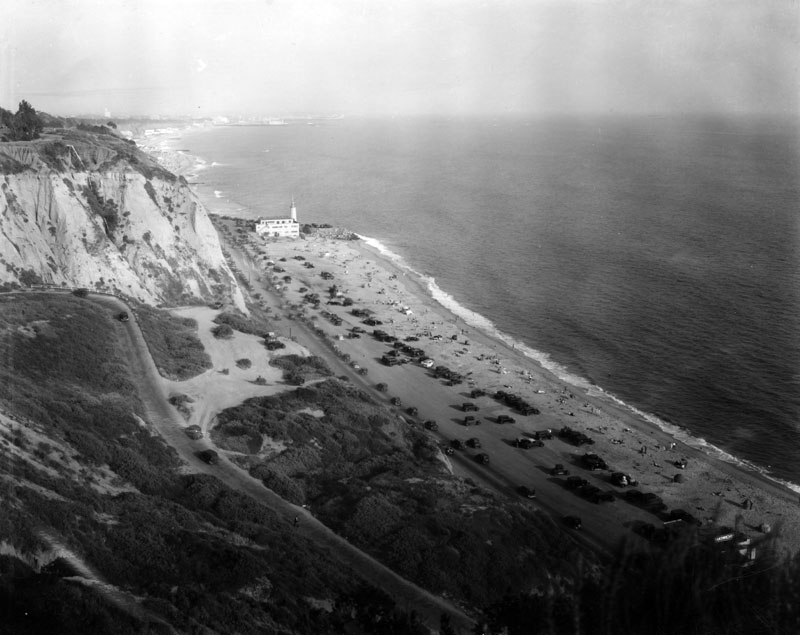 |
||
| (ca. 1920s)^ - Looking south along Roosevelt Highway, later renamed the Pacific Coast Highway (PCH), in Pacific Palisades. The highway runs parallel with the ocean where visitors enjoy the sun and surf. Visible in the distance, the landmark Lighthouse bathhouse that stood on Pacific Coast Highway at the point where the Santa Monica Mountains come down to the shore. In the far background can be seen a pier. |
Historical Notes In 1922, the Rev. Charles H. Scott and the Southern California Methodist Episcopal Church bought the land where Incville Studios was located. That same year Scott founded Pacific Palisades, envisioning an elaborate religious-intellectual commune. Believers snapped up choice lots and lived in tents during construction. By 1925, the Palisades had 100 homes. In one subdivision, streets were named for Methodist missionaries. The tents eventually were replaced by cabins, then by bungalows, and ultimately by multimillion-dollar homes.*^ |
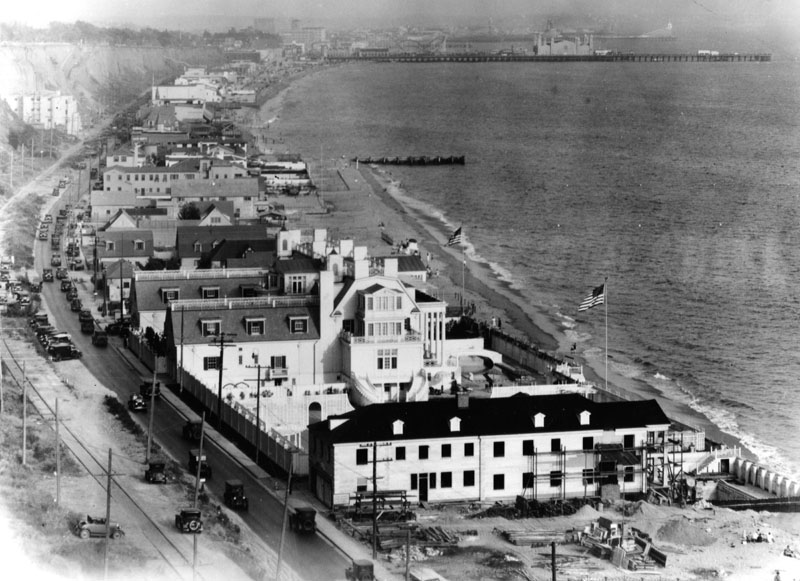 |
||
| (ca. 1920s)^ - Photo shows the buildings along the ocean front on Santa Monica beach. A continuous stream of cars can be seen as they travel along PCH. The pier and amusement park can be seen in the background. The large building with the numerous chimneys is Marion Davies' famous beach house. The guest house closest to the camera still exists. |
Historical Notes In the 1920s, William Randolph Hearst commissioned William Edward Flannery to construct a grand beach house for his longtime companion, actress Marion Davies. In 1926, architect Julia Morgan was hired to complete the design and oversee construction of the estate, which featured an ornate swimming pool, several houses, gardens and an opulent 110-room mansion. The beach house served as Davies’ primary residence from 1929 to 1942. In 1947, Davies sold the estate and it was converted into the Oceanhouse Hotel and Sand & Sea Beach Club. The main mansion was demolished in 1956, and the property was sold to the State of California in 1959. The Sand & Sea Club remained popular with regulars all the way through until the 1990s.*^*# |
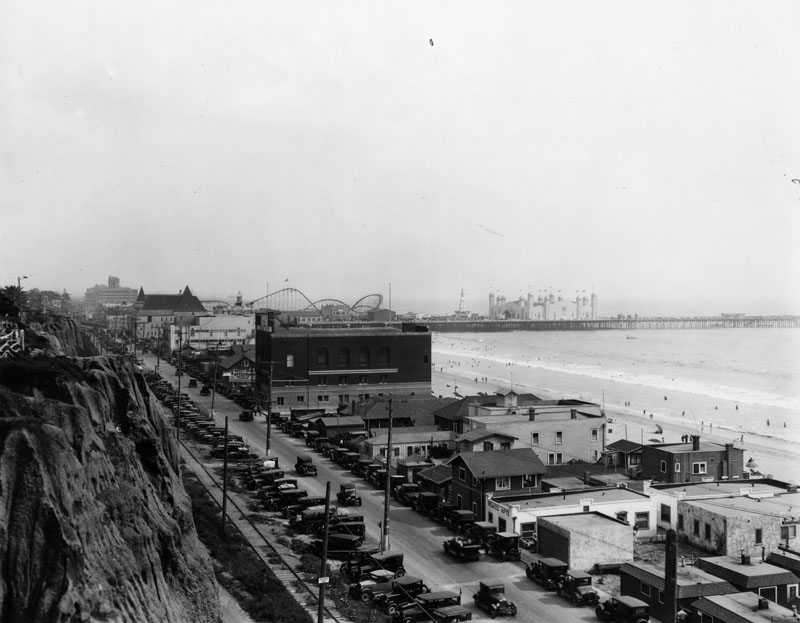 |
||
| (ca. 1920)^ - Hillside view of Santa Monica. The buildings, cars parked on both sides of the highway and Santa Monica beach can be seen. The amusement park and La Monica's ballroom on the pier is in the background. |
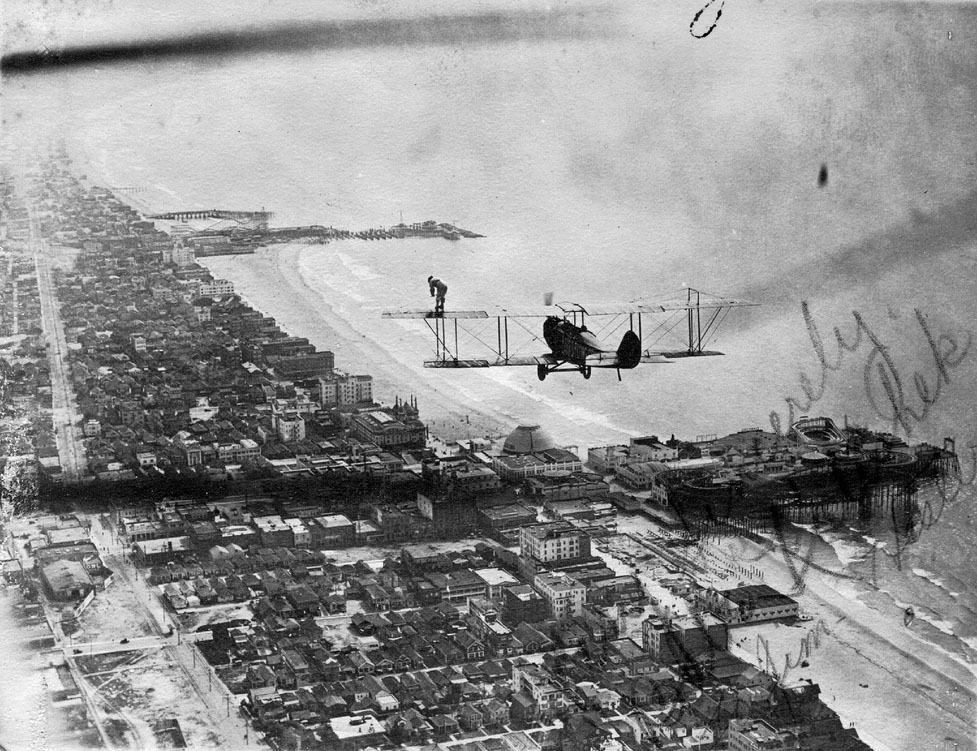 |
||
| (1918)*#^# - Walking over Santa Monica. Aerial view of a bi-plane flying over Santa Monica. A woman is standing on the wing looking down. Ocean Park Pier with its amusement park appears just below the plane and Venice Pier is seen in the distance. |
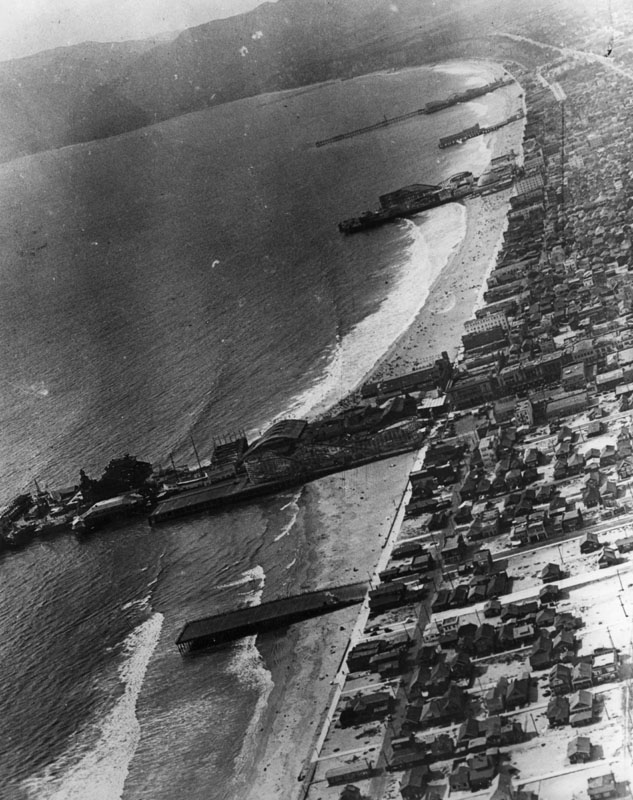 |
||
| (1920s)^ - Aerial view looking north all along the coast of Venice and the whole Santa Monica Bay area. At least 6 or 7 piers can be seen extending out into the ocean. Venice Pier and amusement park can be seen in the foreground. Ocean Park Pier, with its own amusement park, is the next pier over. Beyond that, the long pier at the top of the photo, is the Santa Monica Pier. It also had an amusement park. |
Historical Notes The Venice, Ocean Park and Santa Monica amusement piers were within a mile and one half of each other and they competed directly with each other for the tourist's entertainment dollars. Fourteen coasters were built there from 1904 to 1925.^*^*^ Click HERE to see more in Early Views of Southern California Amusement Parks |
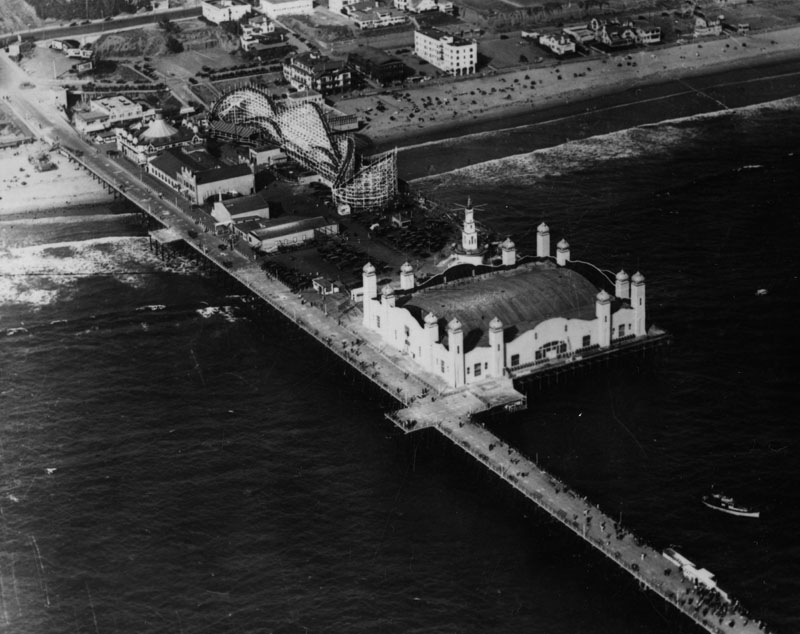 |
||
| (1924)^ - The Santa Monica Pier, with the La Monica Ballroom, captured from above. |
Historical Notes The Spanish and French Renaissance style La Monica Ballroom was designed by T.H. Eslick; it opened in 1924 and was demolished in 1963.^ More than 50,000 people attended the July 23, 1924 grand opening of the La Monica Ballroom, enough to cause the first traffic jam recorded in Santa Monica history. Its 15,000 square-foot hard maple floor and exquisite “submarine garden” interior made the La Monica the hottest ticket in town.*^*^* |
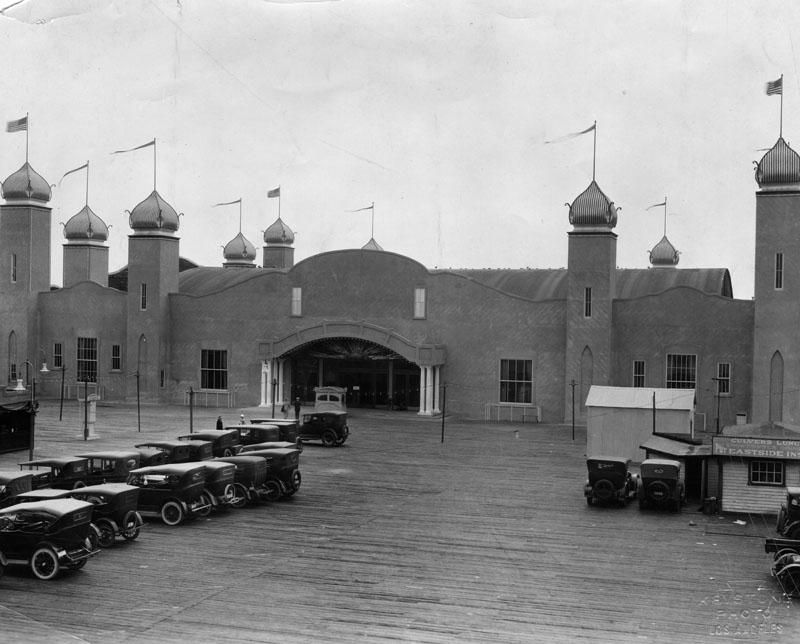 |
||
| (1924)^ - Cars are parked outside the La Monica Ballroom on the Santa Monica Pier. |
Historical Notes The La Monica Ballroom was located at the end of the 1,600-foot long Santa Monica Pier. It was especially popular during the Big Band Era of the 1920s & 30s, up to 2,500 couples could kick up their heels in this grand ballroom located at the end of the Pier.*^*# It’s success was short-lived as the Great Depression effectively ended the dance hall days. By the mid-1930’s it became a convention center, lifeguard headquarters and, for a short interim period, the City Jail.*^*^* |
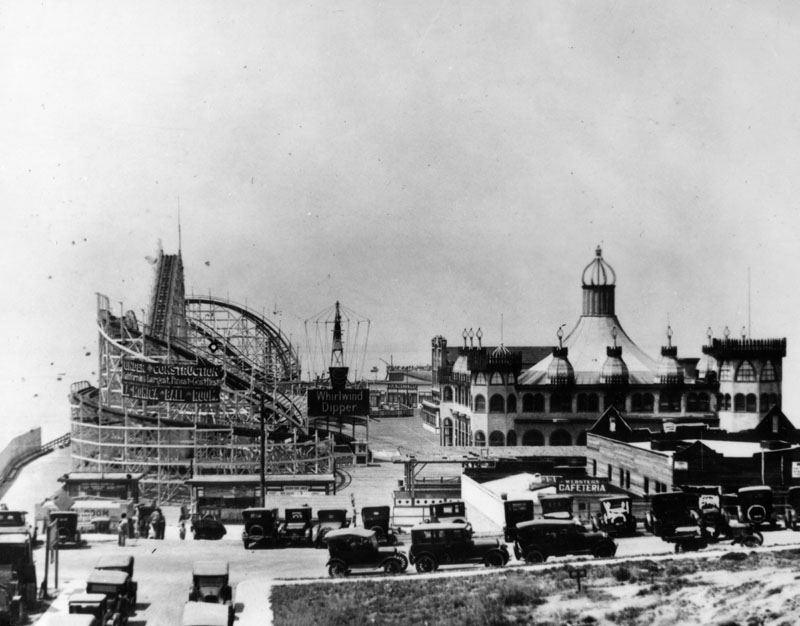 |
||
| (ca. 1924)^ - View shows an Ocean Park, complete with wooden roller coaster, on the Santa Monica pier. Click HERE to see more in Early Views of Southern California Amusement Parks |
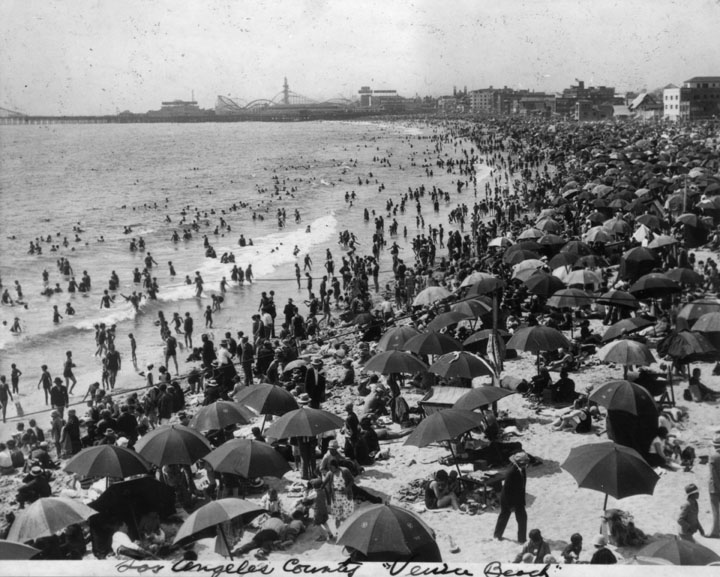 |
||
| (ca. 1925)^ - The ocean water is filled with people swimming or playing, and the beach is likewise filled with people and umbrellas (to keep off the sun). The view is looking north towards Ocean Park. |
Click HERE to see more in Early Views of Santa Monica |
* * * * * |
Playa del Rey
.jpg) |
|
| (ca. 1902)*– View looking east showing a well-dressed man holding his shoes while standing knee deep in the Playa del Rey lagoon. |
Historical Notes The Playa del Rey area, located about two miles south of Kinney's Venice of America resort, was once, centuries ago, the mouth of the Los Angeles River. But after the river shifted course to begin emptying in Los Alamitos Bay in Long Beach, it left behind a sleepy lagoon more than two miles wide and one fifth of a mile wide with a trickle of fresh water flowing to sea along La Ballona Creek. |
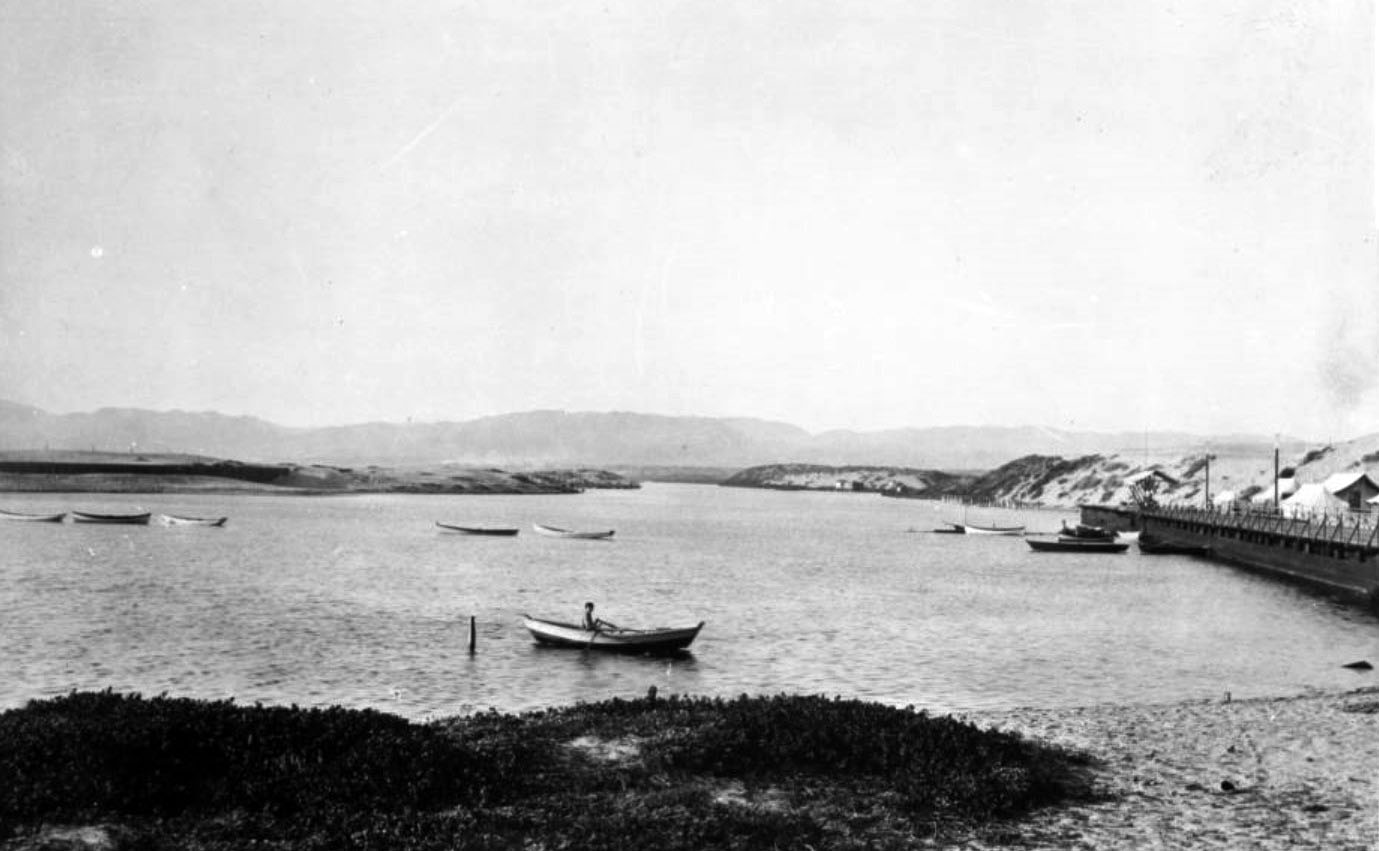 |
|
| (1902)^^ - Photoprint reads, “Quiet Waters and Quiet Days.” View from the south end of the Playa del Rey lagoon looking northward. About eight rowboats can be seen at anchor in the calm water. One person is rowing a boat in the foreground. The shoreline is visible on all three sides. Several of the boats are moored to a dock at right, behind which several structures, mainly tents, are visible. |
Historical Notes Playa del Rey, “The King’s Beach,” had rustic beginnings. In 1871, a man named Will Tell built a lodge at the unnamed area near a lagoon that existed where Ballona Creek emptied into the Pacific Ocean. It became a popular spot for hunters and fishermen until an 1884 storm wiped out the small resort.* |
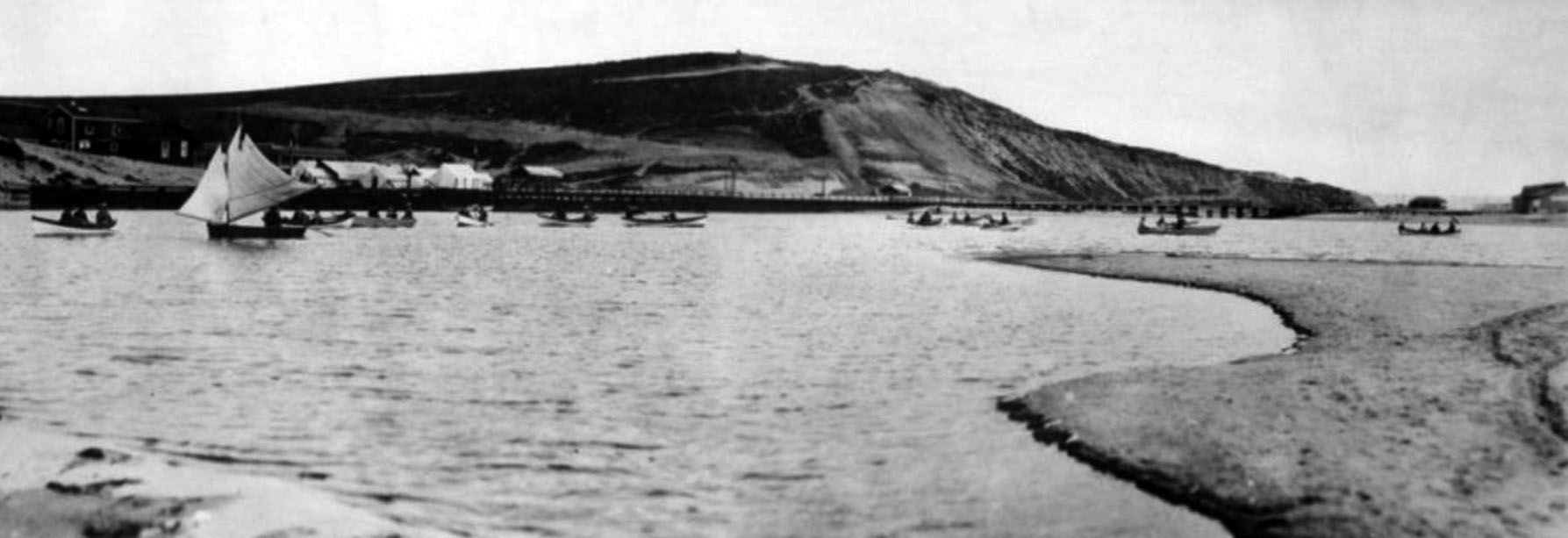 |
|
| (1902)^ - View looking south showing of the beach and lagoon at Playa del Rey on November 12, 1902. A sail boat and about a dozen row boats can be seen in the Playa del Rey lagoon. |
Historical Notes With the late 19th and early 20th Ballona hosted a slew of new businesses that, thanks to calamitous weather, endured a short though fruitful run. A German named Will Tell built a business at the mouth of Ballona where sportsmen could hunt from his small boats. His business soon washed away, but interest in the area continued to mount. In the 1880’s Moy Wix envisioned “Port Ballona” a plan that would link the ocean to a new two-mile Harbor. The Santa Fe Railway planned to follow; and while a passenger train was successful in transporting Angelinos to Port Ballona in 1887. Strong tides and winter rains inevitably washed away the wharf, putting an end to the grand project. |
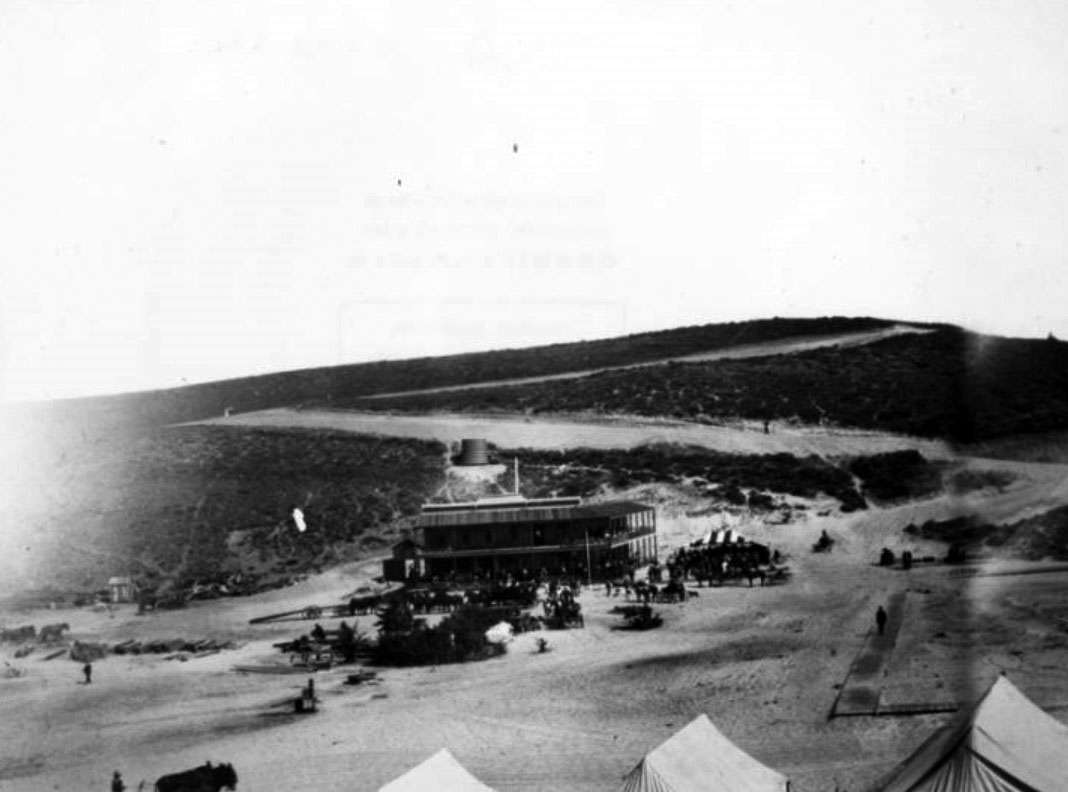 |
|
| (1902)^ – View looking south from the edge of the Playa del Rey lagoon showing tents in the foreground and a two story building (Hotel Playa) at the base of a hill. Horse-drawn wagons are seen in front of the hotel. Note the water tower on the hill. |
Historical Notes Henry Barbour of the Beach Land Company bought 1,000 acres of land in the area in 1902, and renamed it Playa del Rey. He announced plans to build a full-fledged resort there, based around the impending arrival of the Pacific Electric Railway “red car” system that eventually would link all the beach cities from Venice to Manhattan Beach. Construction on the various structures was well under way when the new Playa del Rey had its coming out party on July 16, 1902. Hundreds of potential buyers arrived on Santa Fe trains (the Pacific Electric had yet to be completed) to inspect Barbour’s work and potentially invest in housing lots in the area. About 100 lots were sold on the first day, for an approximate total of $150,000.* |
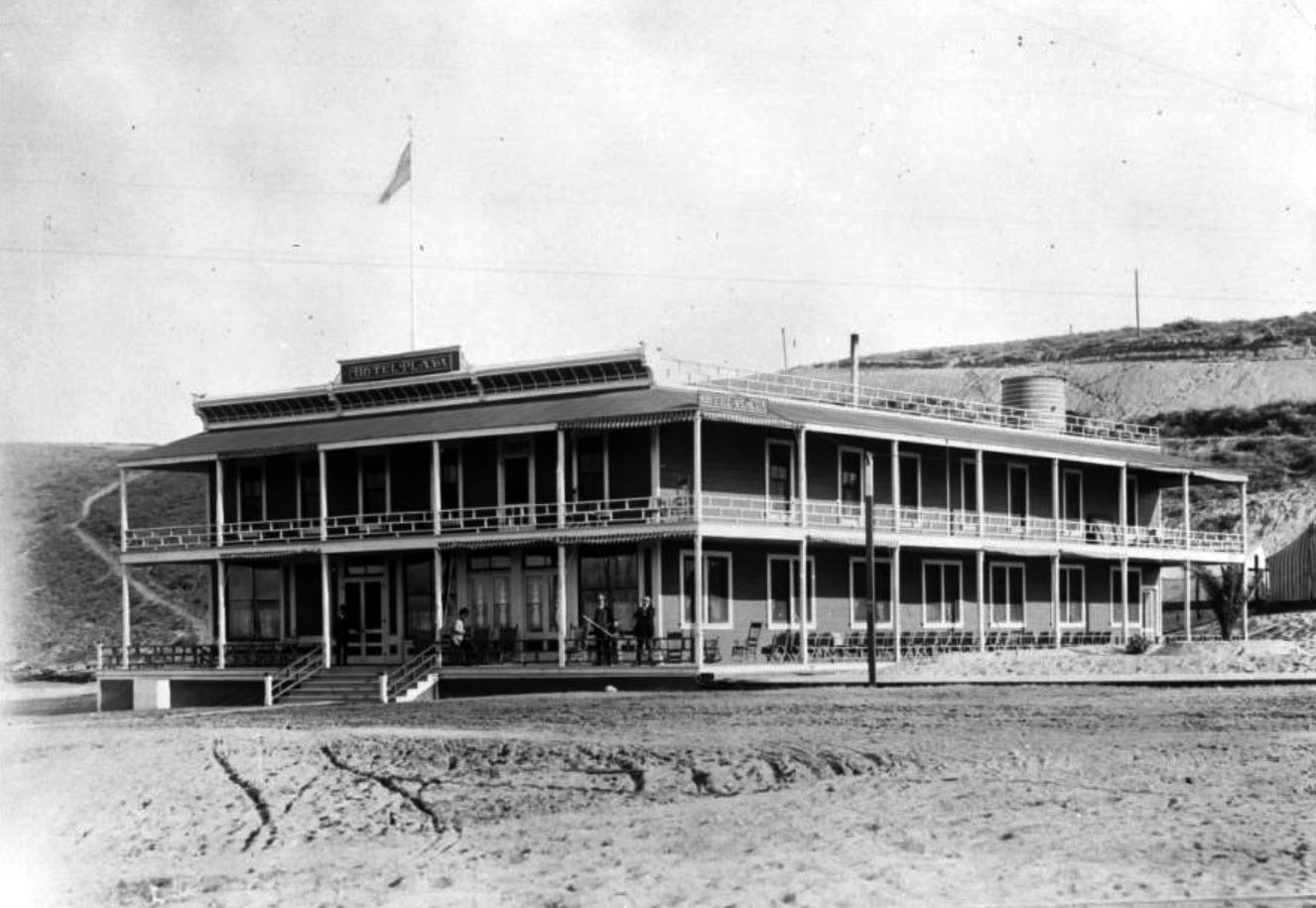 |
|
| (ca. 1905)^^ - Close-up view of the Hotel Playa in Playa del Rey. The two-story hotel has a wrap-around porch and balcony, and rows of large rectangular windows cover the perimeter of the building. |
Historical Notes The Hotel Playa was on Speedway Boulevard, (today called Culver Boulevard), at more or less the location of the modern Tanner’s Coffee Co. |
 |
|
| (ca. 1908)^^ - A man is seen standing on the balcony of a large home looking down toward the Playa del Rey lagoon with the Del Rey Hotel, Playa Del Rey Pavilion and pier in full view. The lagoon is in the shape of a track & field, except the field is the lagoon. Inclined bleachers encircle the lagoon's waterline allowing people a spectacle view of the water activities that go on within the lagoon. |
Historical Notes With the completion of the Sherman and Clark owned Los Angeles Pacific electric trolley line, the 'Short Line,' to Los Angeles on October 19, 1902, hundreds began visiting the new resort. A pavilion and small hotel were eventually built in Oriental craftsman rather than Venetian style, around the lagoon in 1904. |
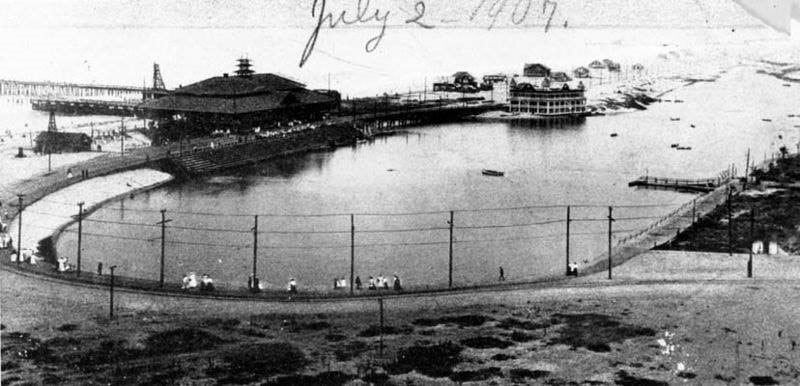 |
|
| (1907)^ - Closer view of the lagoon, pier, pavilion and hotel. July 2, 1907. (Courtesy of the California Historical Society Collection) |
Historical Notes The pavilion building opened with much fanfare on Thanksgiving Day in 1904, the same year that the resort got its own post office. Wooden boardwalks were constructed surrounded the lagoon, and a concrete bridge built across the lagoon was described as the longest one of its type at the time. Boat racing became extremely popular; a boathouse built near the ocean did a brisk business.* |
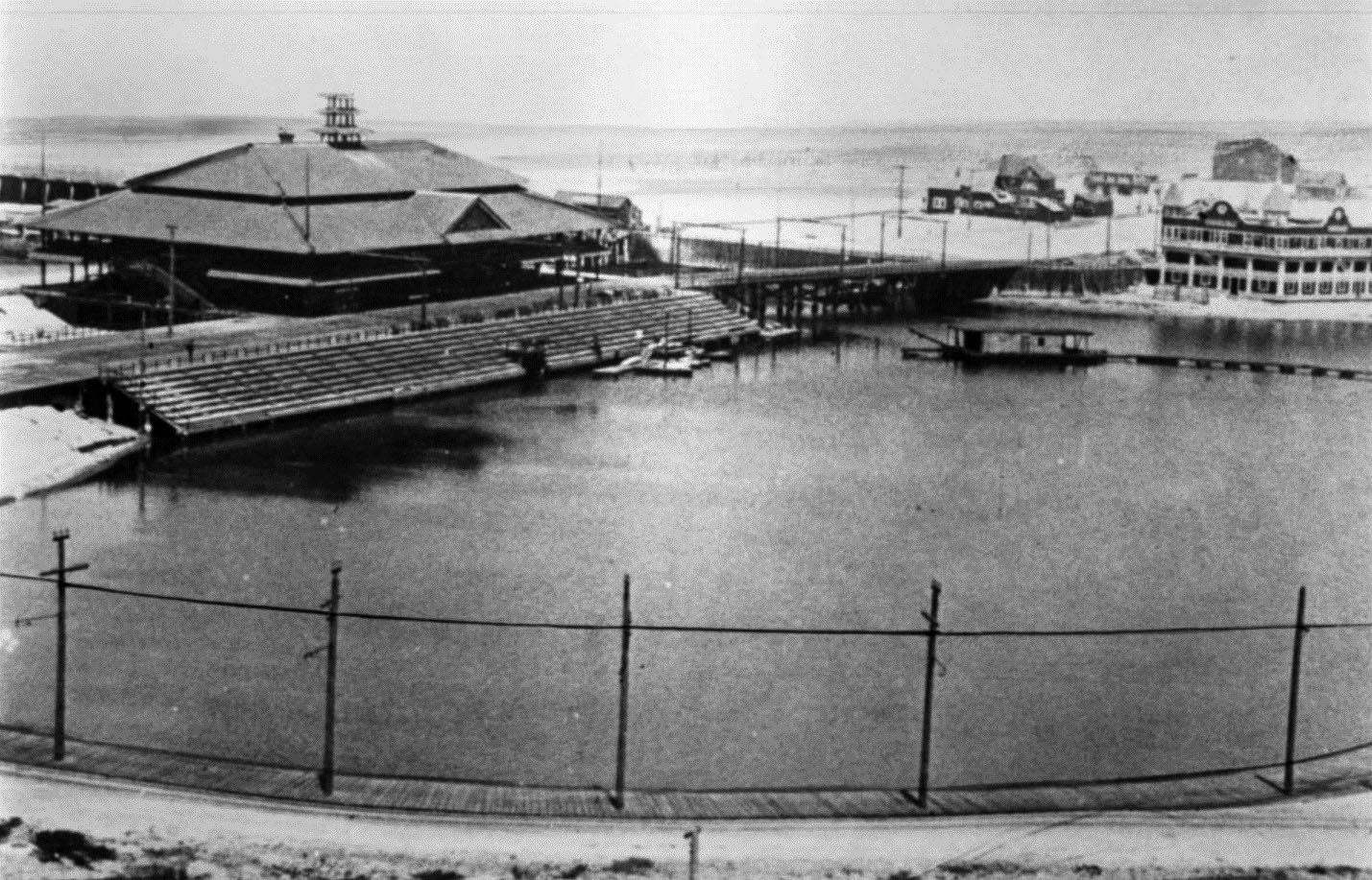 |
|
| (ca. 1904)^^ – Photograph of the Playa Del Rey Pavilion and Del Rey Hotel. The hotel is in the background on the right side. The Japanese-craftsman style Pavilion is on the left, and in front of it are grandstands to watch boat races. In the foreground is the lagoon used as a race course; there is a barge and several small sailing vessels anchored in it. A bridge crosses a canal to connect the hotel and the pavilion near the center of the image. |
Historical Notes The company built an impressive three-story, $100,000 pavilion with restaurant and dining rooms, bowling alleys and dance floor. Sherman and Clark's Los Angeles Pacific Railway Company built the $200,000 Hotel Del Rey with fifty guests rooms. A boat-racing course was laid out and a grandstand and boathouse erected on shore. A bridge spanned the lagoon's ocean entrance and a 1200-foot long fishing pier was built nearby."^^ |
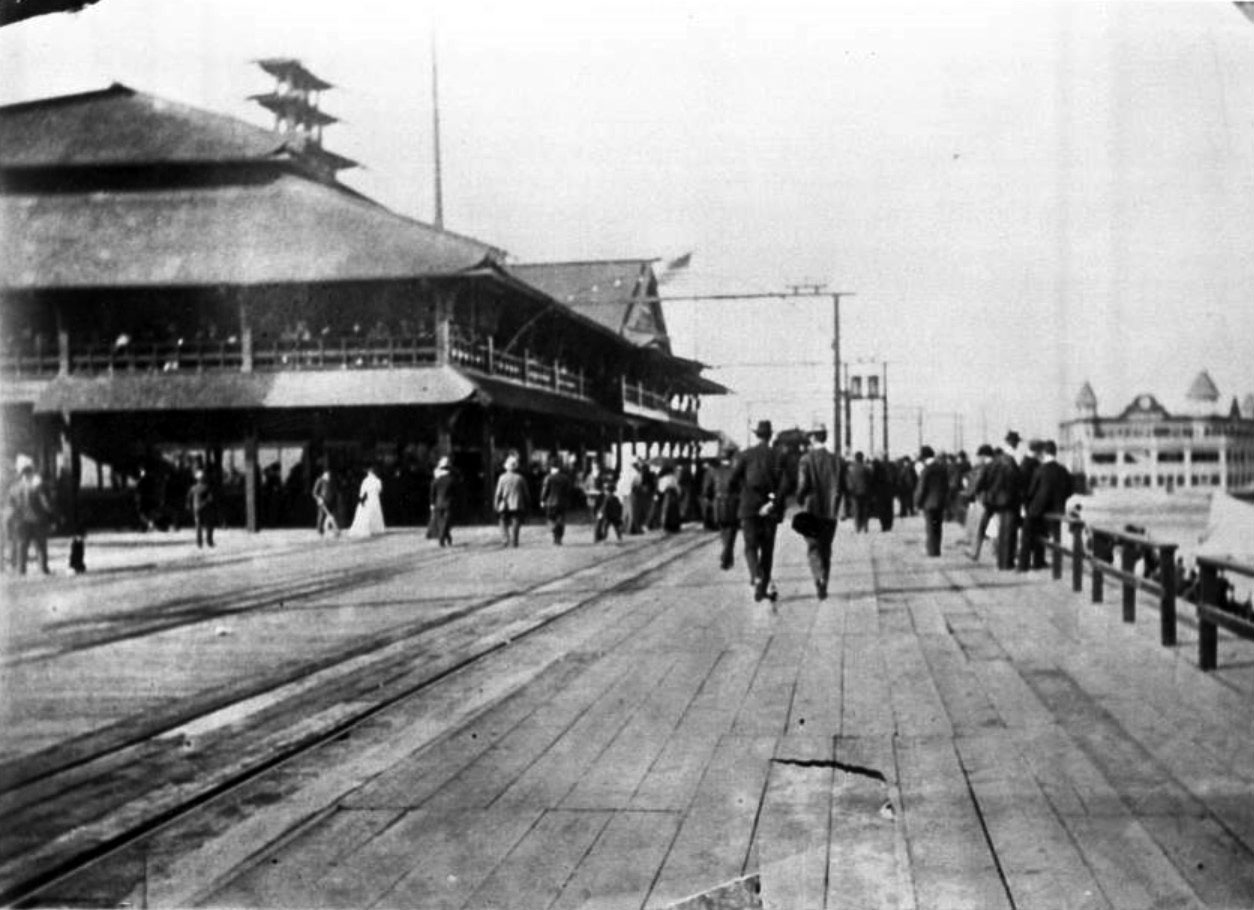 |
|
| (ca. 1908)^^ – View of the boardwalk in front of the Playa Del Rey Pavilion. The pagoda-style Pavilion is on the left of the image and towers over the wooden boardwalk below. There are many tourists crowding the boardwalk, down from Los Angeles on the Balloon Trolley trip. The Del Rey Hotel is visible in the background on the right. |
Historical Notes While Playa del Rey was considered a modest success in attracting day tourists, it proved to be Abbot Kinney's inspiration and served as an example of a resort that wasn't large enough in scope to attract investors or excite the public. Playa Del Rey flourished as a resort from 1902-1913. In 1905, a furnicular railway was built from the Playa del Rey beach to the top of the steep bluffs that surrounded it. Its two cars were nicknamed “Alphonse” and “Gaston.” In 1910, the Playa del Rey Motordrome, a wooden banked raceway track built for automobile and motorcycle racing, opened for business at the present-day intersection of Culver and Jefferson boulevards.. Many of the great auto racers of the day, including Barney Oldfield, raced at the Motordrome until its wooden structure caught fire and burned to the ground in 1913. In 1913, a fire destroyed the Playa del Rey Pavilion and the Del Rey Hotel, and the resort’s promise faded. However, the area’s appeal as a housing location continued. In 1921, the Palisades Del Rey development on the bluffs above the beach became a desirable location for homeowners. The Minneapolis real estate firm of Dickinson & Gillespie built houses there, and also developed the Surfridge tract just south of of Playa del Rey. Celebrities such as film director Cecil B. DeMille and actor Charles Bickford were among the area’s homeowners.* |
Surfridge (Playa del Rey, originally Palisades del Rey)
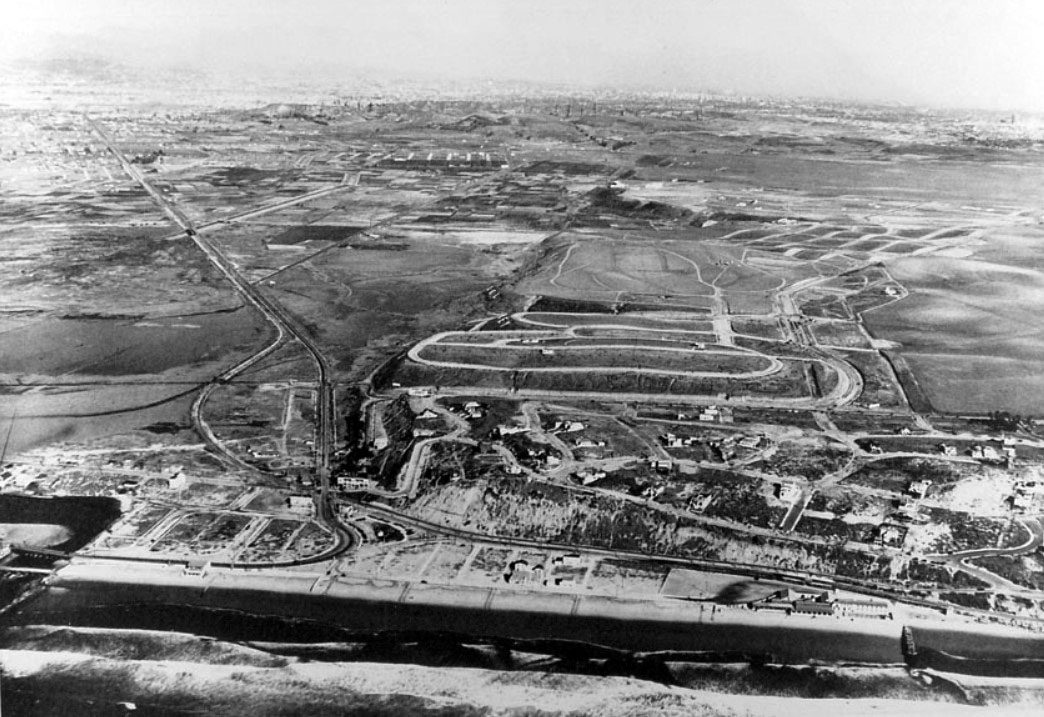 |
|
| (1921)** - Aerial view showing Playa del Rey, Bluffs and Playa Vista. The center-right area became Mines Field and later LAX. The beach area at bottom-right would become a new housing development called Surfridge. |
Historical Notes In 1921 the Minneapolis-based firm of Dickinson & Gillespie billed this stretch of coastline as "The Last of the Beaches". Situated between Venice and Hermosa beaches, it is now part of Playa del Rey.^ A southern portion of Playa del Rey became known as "Surfridge". Today, this area is bounded on the East by Los Angeles International Airport, on the north by Waterview and Napoleon streets, on the South by Imperial Highway, and on the West by Vista del Mar. The beach to the west of the area is Dockweiler State Beach.*^ |
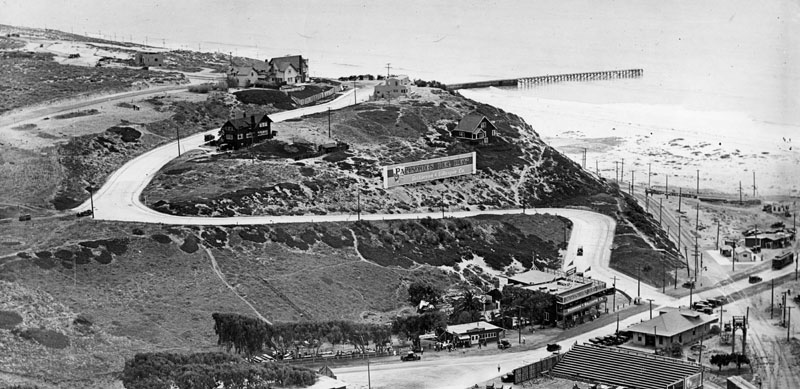 |
|
| (ca. 1920s)^ - On the winding road up the cliff, a billboard advertises the "Palisades del Rey" dream of a house by the beach. |
Historical Notes Surfridge was developed in the 1920s and 1930s as "an isolated playground for the wealthy." In 1925 the developer held a contest to name the neighborhood and awarded the $1,000 prize to an Angeleno who submitted the winning name. The Los Angeles Times wrote that Surfridge was chosen "due to its brevity, euphony, ease of pronunciation ... but above all because it tells the story of this new wonder city."*^ |
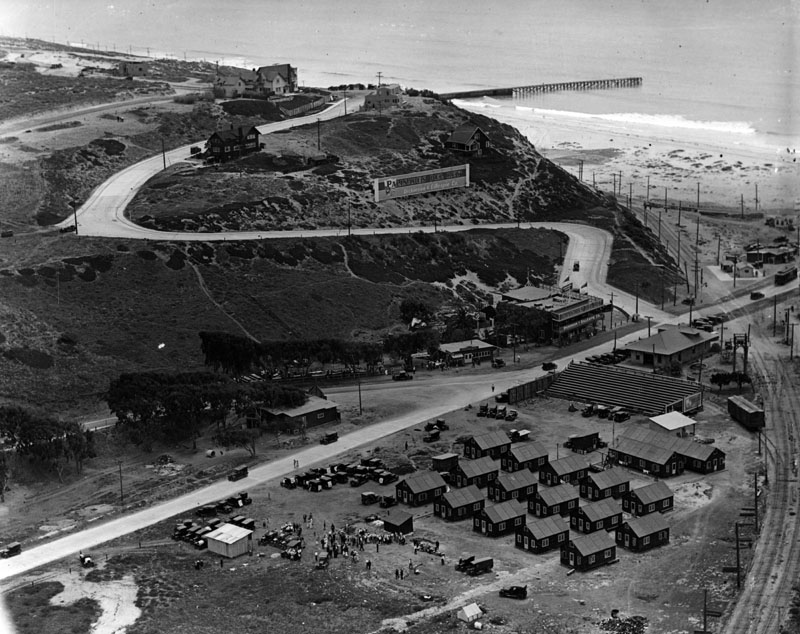 |
|
| (ca. 1920s)^ - Another view of the "Palisades del Rey" beach area. A grandstand is opposite the real estate office, bottom right. A picnic area to the left of the office is busy with an event. A pier extends past the breakwater. |
Historical Notes Salesmen pitched tents on the sand dunes and sold lots for $50 down and 36 monthly payments of $20. House exteriors could only be stucco, brick or stone; frame structures were prohibited. Development was slowed by the onset of the Great Depression, but in the early 1930s the wealthy began to buy lots to build large homes.*^ Palisades del Rey later becaome known as Playa del Rey. |
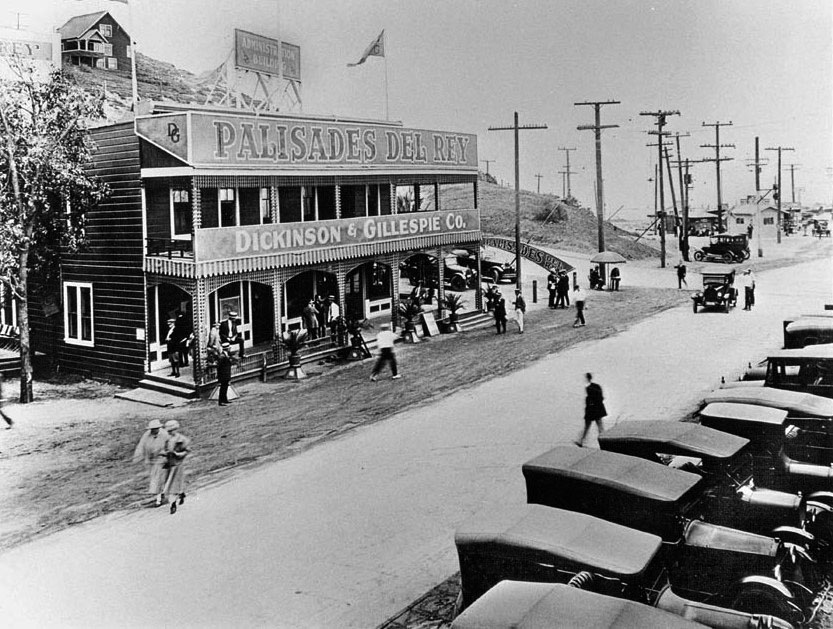 |
|
| (ca. 1920s)** – Close-up view showing the real estate building of Dickinson & Gillespie Co. on Culver Blvd. near Vista del Mar. They were promoting the new residential beach development of Surfridge. |
Historical Notes The Dickinson & Gillespie Co. real estate building was originally the Hotel Playa, built in 1902. It was on Speedway Boulevard, (today called Culver Boulevard), at more or less the location of the modern Tanner’s Coffee Co. ##*^ |
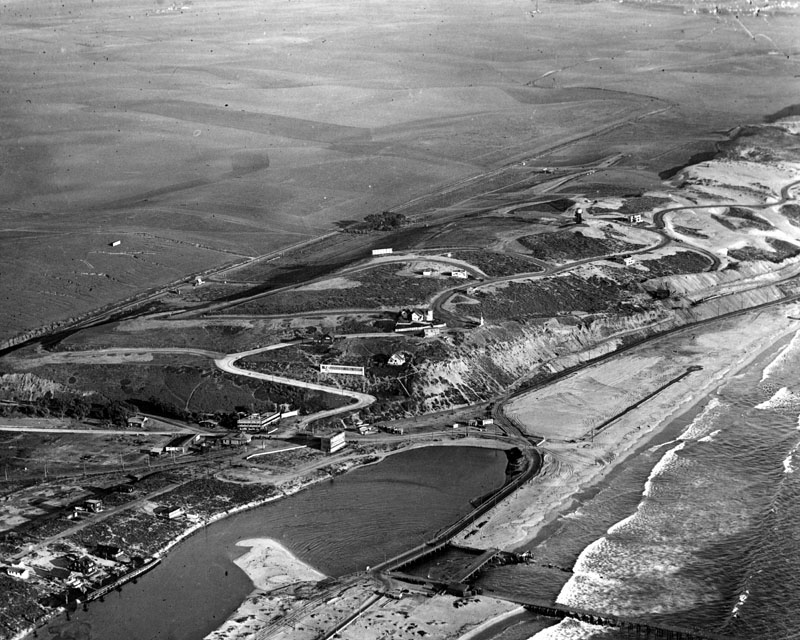 |
|
| (ca. 1920s)^ - Aerial view of Playa Del Rey lagoon (lower-left) and the area called "Surfridge". The Dickinson & Gillespie Co. real estate building can be seen at lower center-left. |
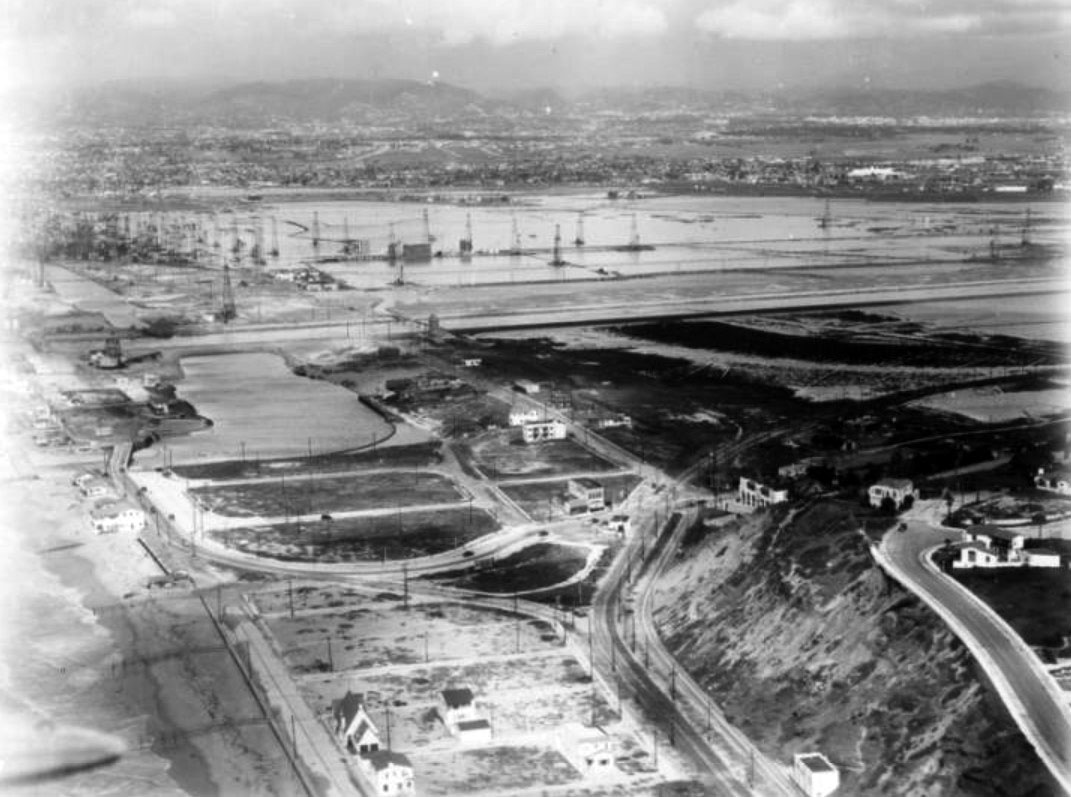 |
|
| (ca. 1929)^ – Aerial view looking north showing the Palisades del Rey/Surfridge area in the foreground. At center-left is the Playa del Rey lagoon and in the the distance can be seen the southern portion of the Venice Oil Field which would later become Marina del Rey. |
Historical Notes A small airfield opened to the east of Surfridge in 1928. It became a popular location for residents to see air shows. The growing number of commercial flights into Los Angeles following World War II meant a higher number of planes flying low over Surfridge. Many residents learned to co-exist with the noise from propeller planes, but jet engines were impossible to ignore.*^ |
Surfridge and the Jet Age
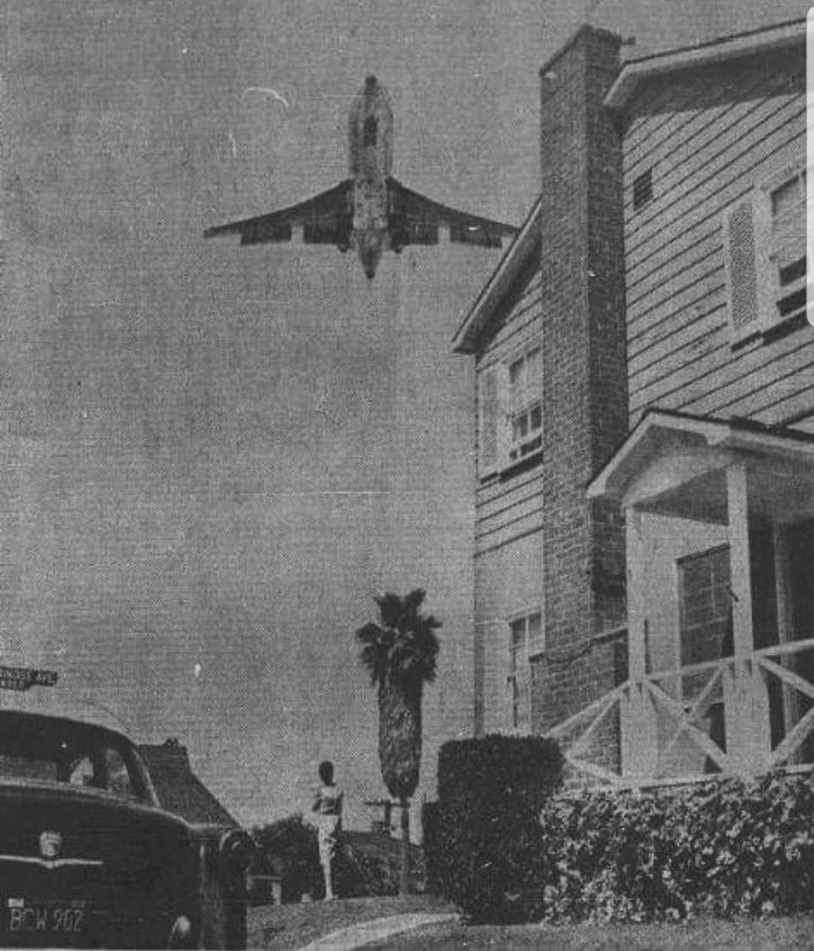 |
|
| (1960s)^ – A Boeing 727 departing from LAX flies over a house in the community of Surfridge. |
Historical Notes Ever since the beginning of the jet-age the area started to vanish due to the expansion of LAX by eminent domain. People who lived there were complaining about the jet noise and the jet engine soot that was landing on their properties.*^ |
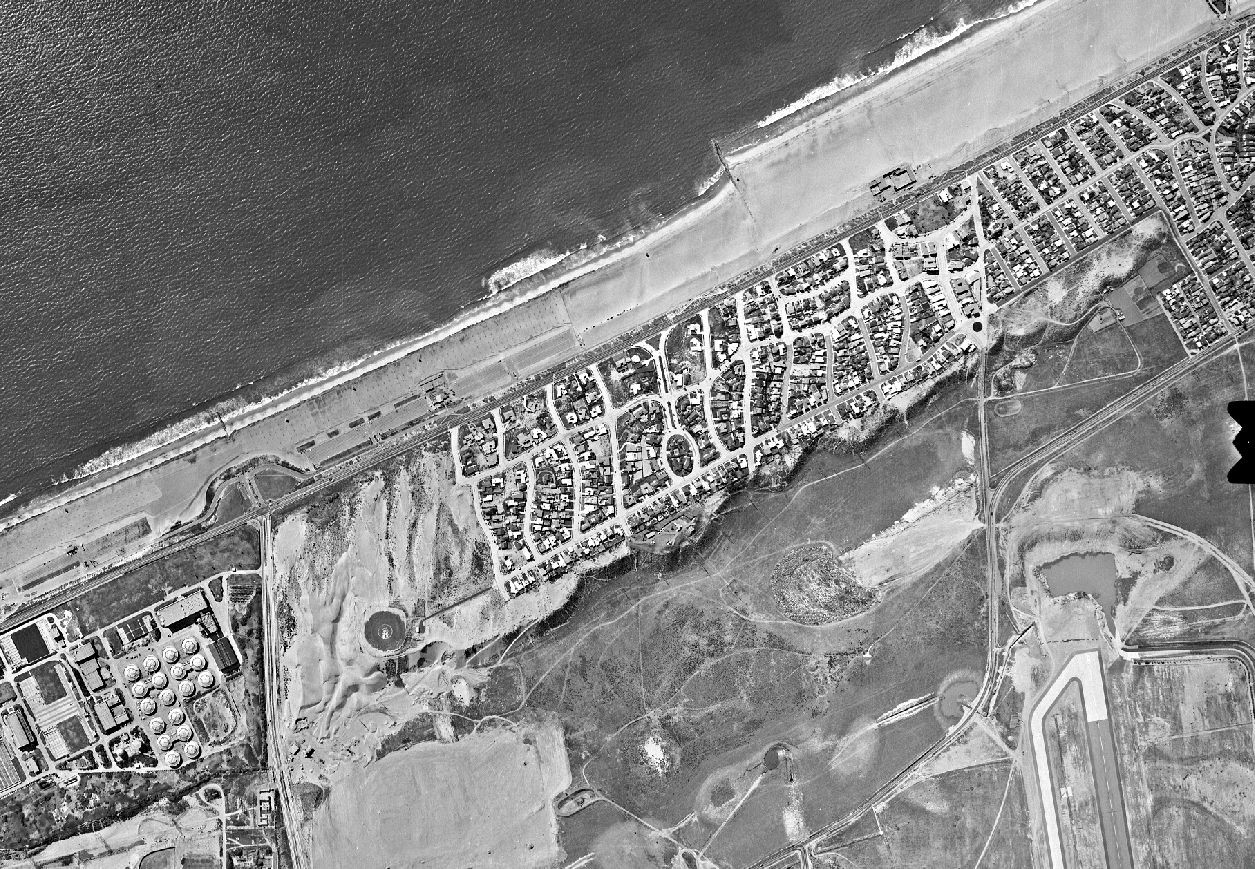 |
|
| (1960s)* - Aerial view over Surfridge (upper-right) showing the subdivision full of homes. That would soon change. |
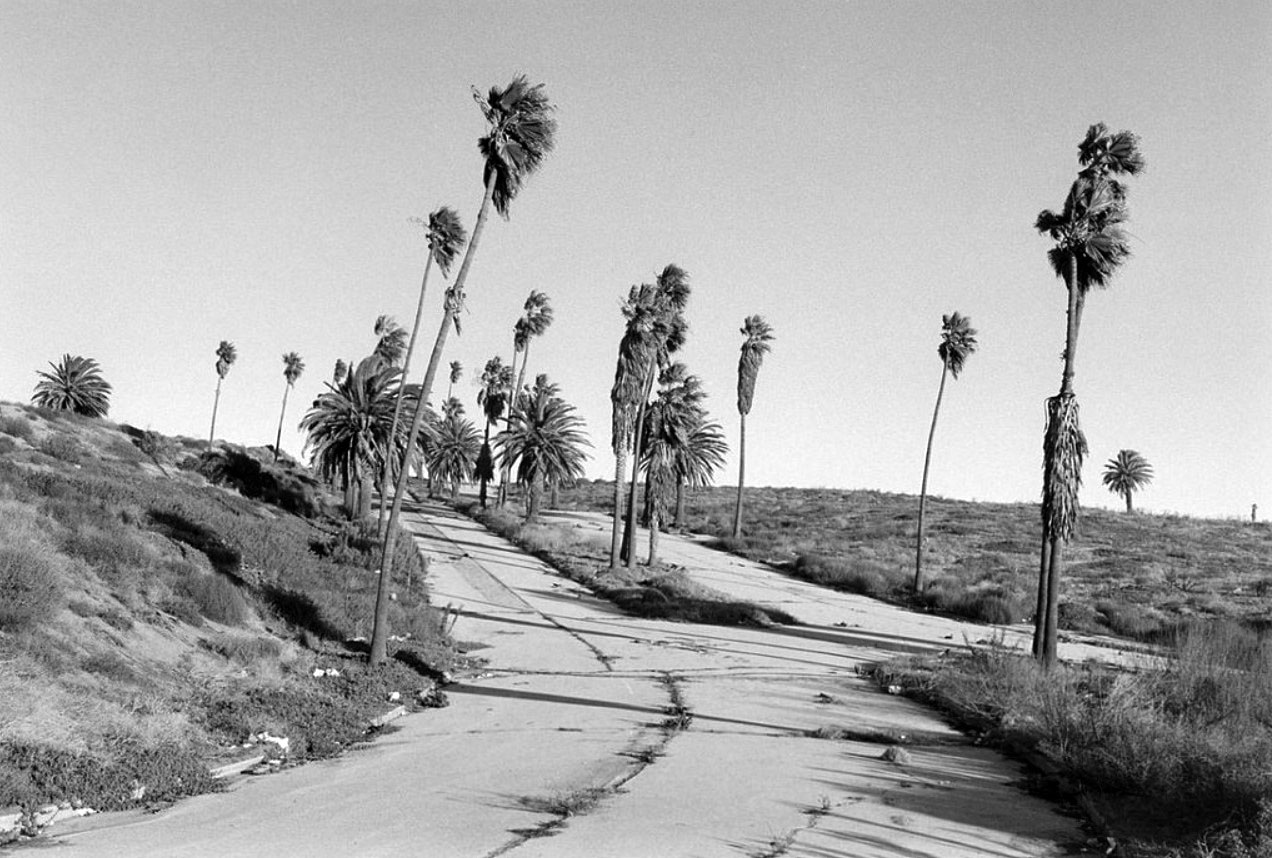 |
|
| (1985)*– View showing the area where middle class houses were condemned and leveled to make way for the westward expansion of Los Angeles International Airport. The beach is directly behind the camera. |
Historical Notes In the 1960s and 1970s, the Sufridge area was condemned and acquired by the City of Los Angeles in a series of eminent domain purchases to facilitate airport expansion and to address concerns about noise from jet airplanes. Homeowners were forced to sell their property to the City. Several homeowners sued the City and remained in their houses for several years after the majority of houses were vacated. Eventually all the houses were either moved or demolished.*^ |
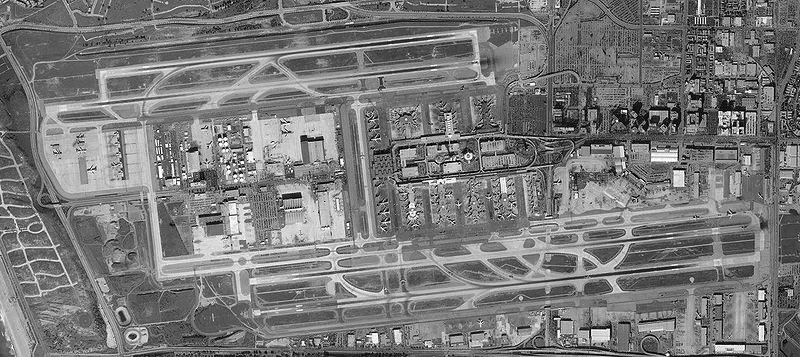 |
|
| (2004)*^ - The old Surfridge area sits vacant to the west of LAX, on the left side of photo. |
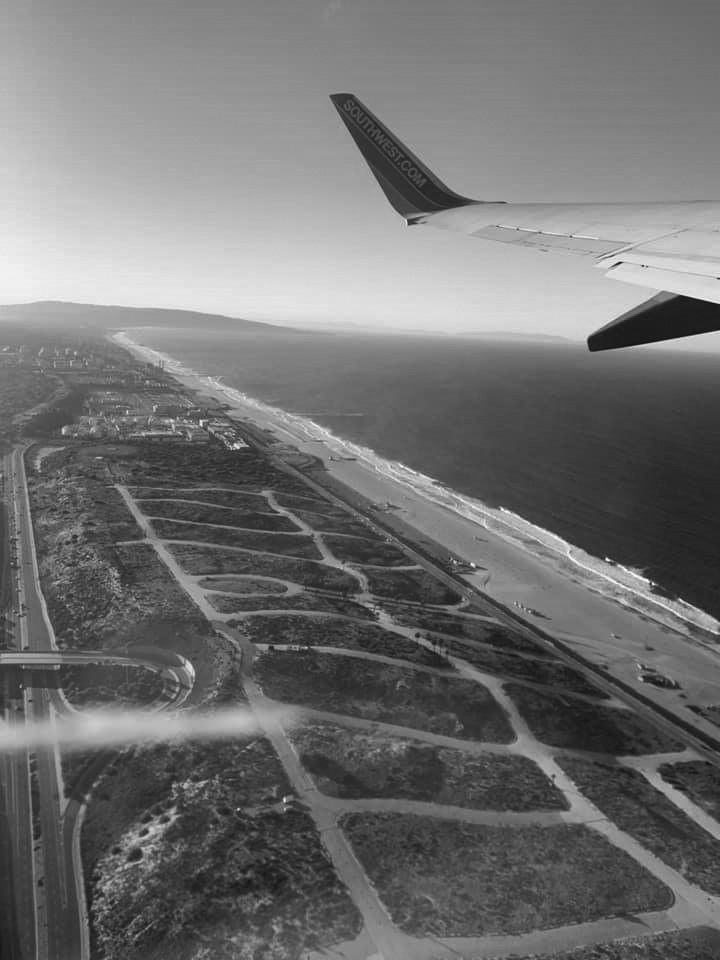 |
|
| (2020)^ - Aerial view looking down at what used to be the Surfridge community showing empty lots and abandoned roads. |
Historical Notes Today one can see only barbed-wire fences protecting vacant land and old streets where houses once sat. Recent LAX rejuvenation plans call for the city to finally remove the old streets that still line the empty neighborhood. The condemned areas of the community are now a protected habitat of the endangered El Segundo blue butterfly.*^ |
Dockweiler Beach
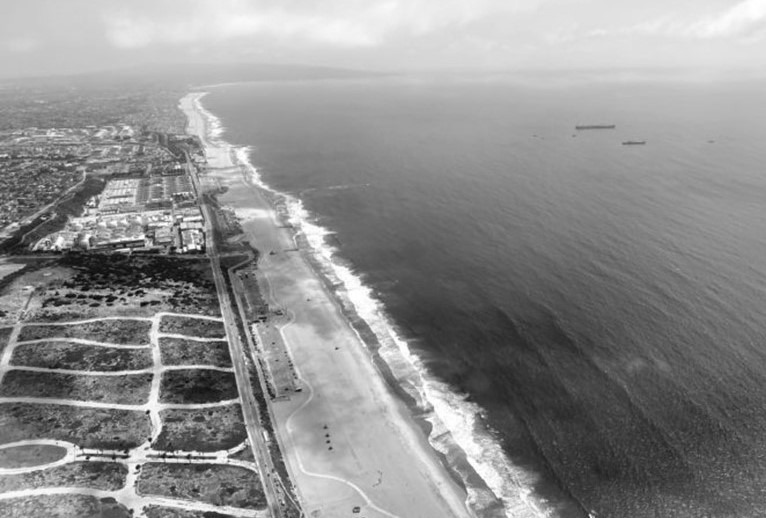 |
|
| (2021)* - Dockweiler State Beach and El Segundo as seen after taking off from Los Angeles International Airport (LAX). |
Historical Notes Dockweiler State Beach has 3.75 miles of shoreline. The 91-acre property was established in 1948. Originally part of Venice-Hyperion Beach State Park, it was renamed in honor of prominent early Angeleno Isidore B. Dockweiler in 1955. Although a unit of the California state park system, it is managed by the Los Angeles County Department of Beaches and Harbors. Part of the park is located directly under the flight path of the adjacent Los Angeles International Airport (LAX). |
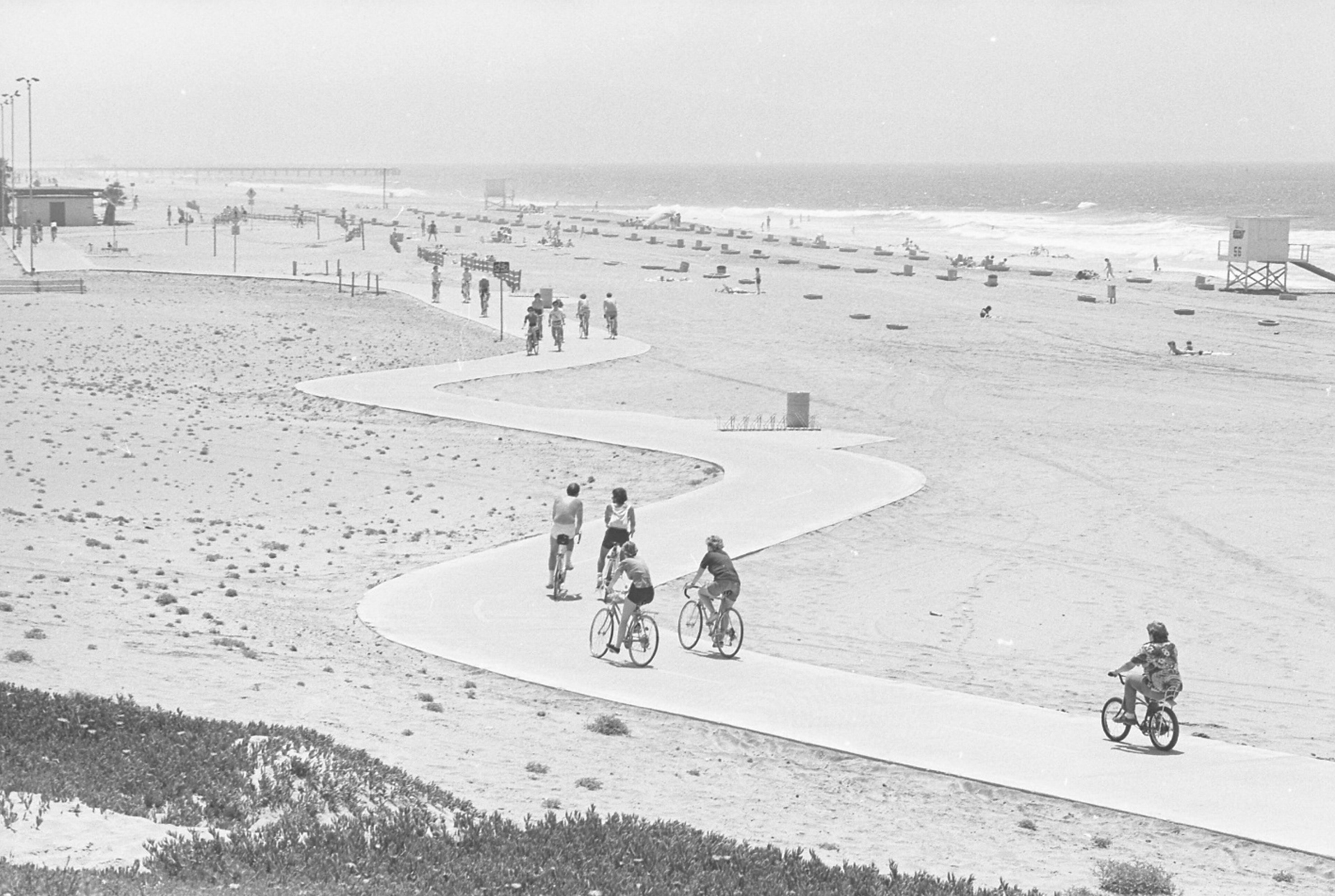 |
|
| (1976)* - Cyclists riding along the bike path at Dockweiler State Beach on a hazy day. |
Historical Notes The Dockweiler State Beach bicycle path is maintained by the Los Angeles Department of Transportation. It runs from Ballona Creek to the El Segundo city limit. This bicycle path connects to the Ballona Creek bicycle path at its northernmost point and is part of the 22-mile coastal Marvin Braude Bike Trail system.* |
 |
|
| (n.d)* - A KLM 747 jet takes off over Dockweiler Beach. |
Historical Notes Jetliners leave Los Angeles International Airport, passing a few hundred feet above the beach. |
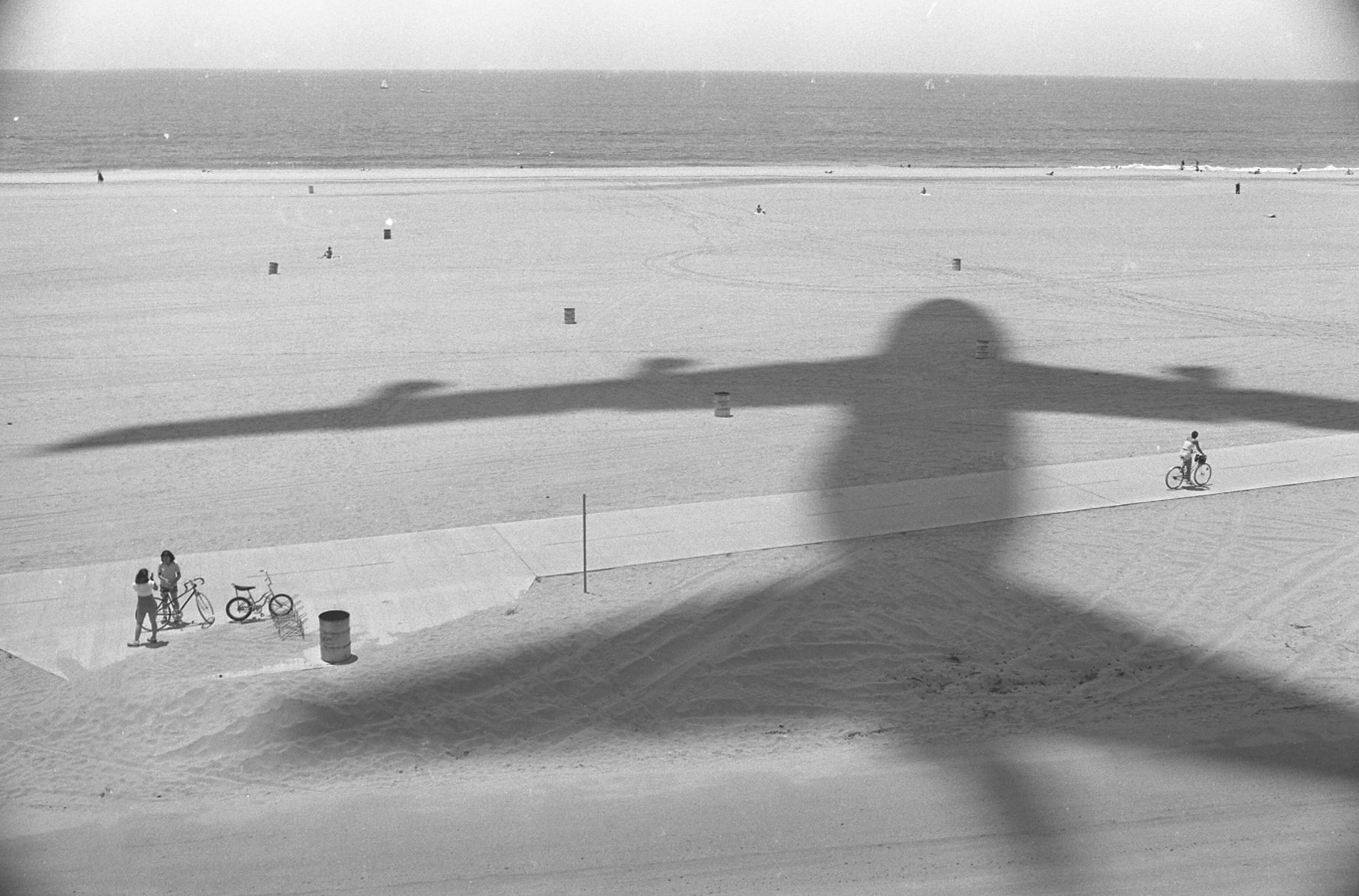 |
|
| (1979)* - Shadow of 747 jet flying over Dockweiler Beach south of Playa del Rey. The huge jetliners leave Los Angeles International Airport, passing a few hundred feet above the beach. |
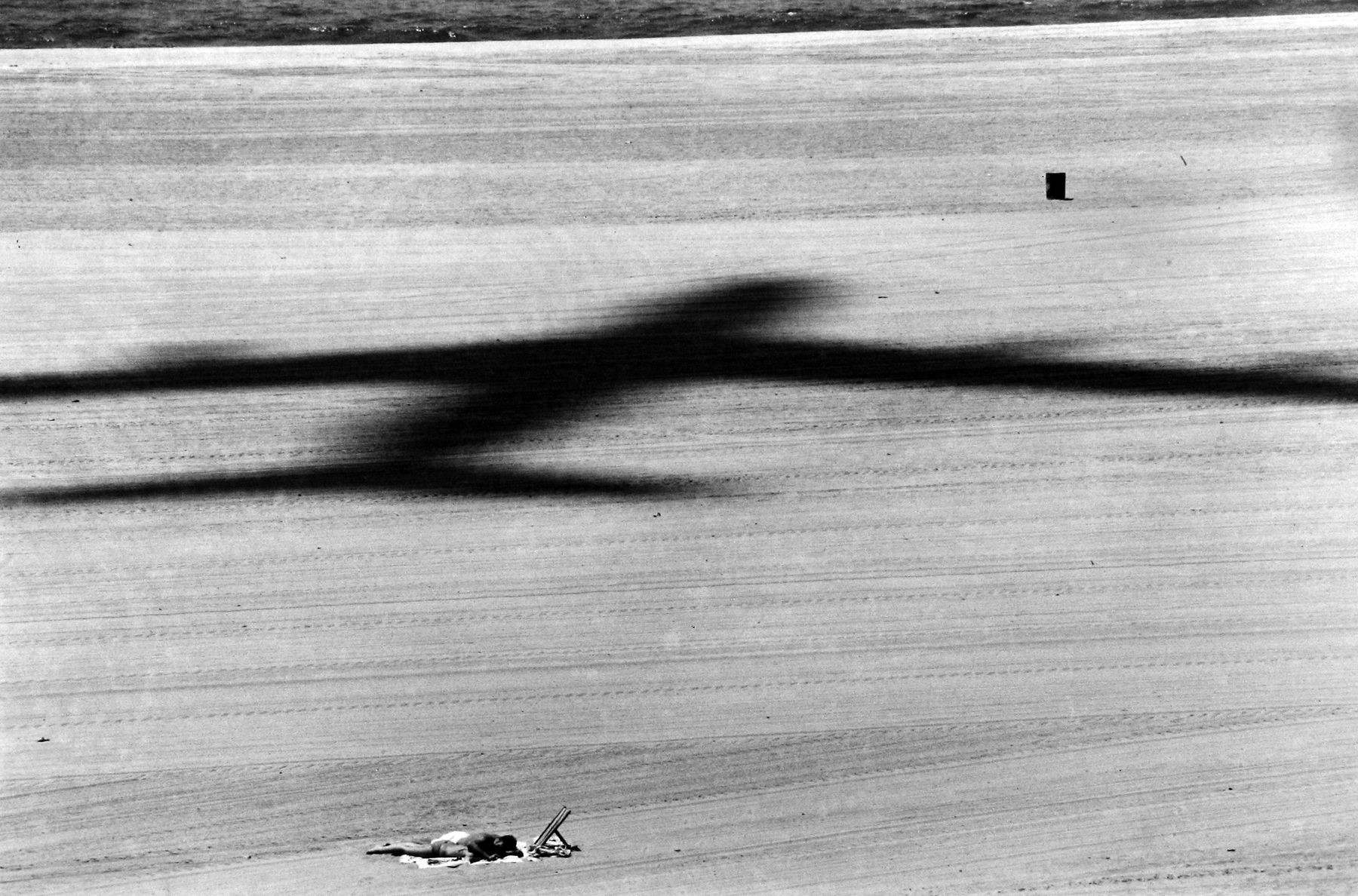 |
|
| (1970s)* - A quiet moment alone before the crowds come. |
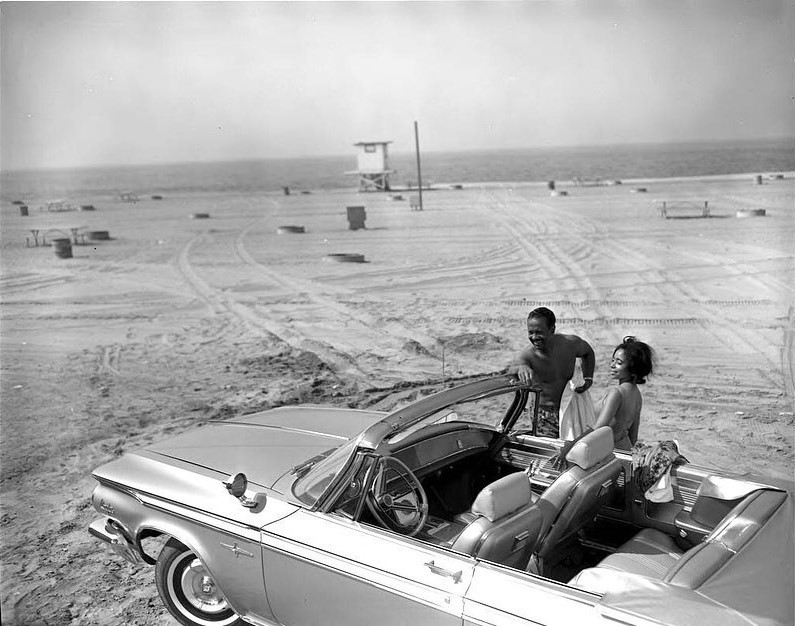 |
|
| (1963)* – Chrysler ad showing a young couple enjoying a day at Dockweiler Beach next to a new Chrysler 300 convertible. Photo by Charles Williams |
Historical Notes Chrysler was the first of the major American car companies to use black models in their advertising, starting with a 1957 ad campaign for the Plymouth convertible that appeared in Ebony Magazine. GM and Ford had also been advertising in Ebony at that time, but with the same ads they'd been using in every other magazine, usually featuring photos of white families. The simple shift in representation led to such a big increase in Chrysler-Plymouth sales that Studebaker started producing inclusive ads in 1959, with Ford and General Motors making similar changes in the early 1960s. Source: California State University, Northridge |
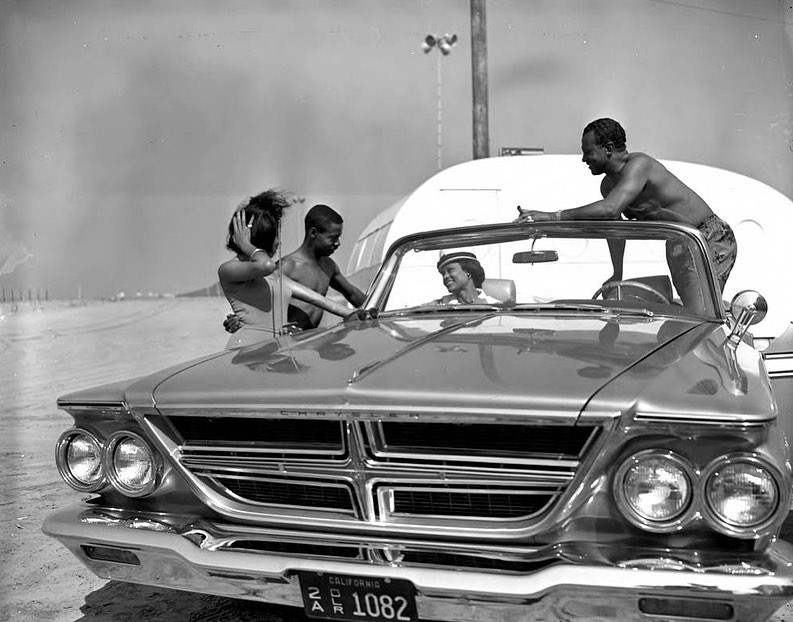 |
|
| (1963)* – Enjoying a day in the sun at Dockweiler Beach. Photo by Charles Williams |
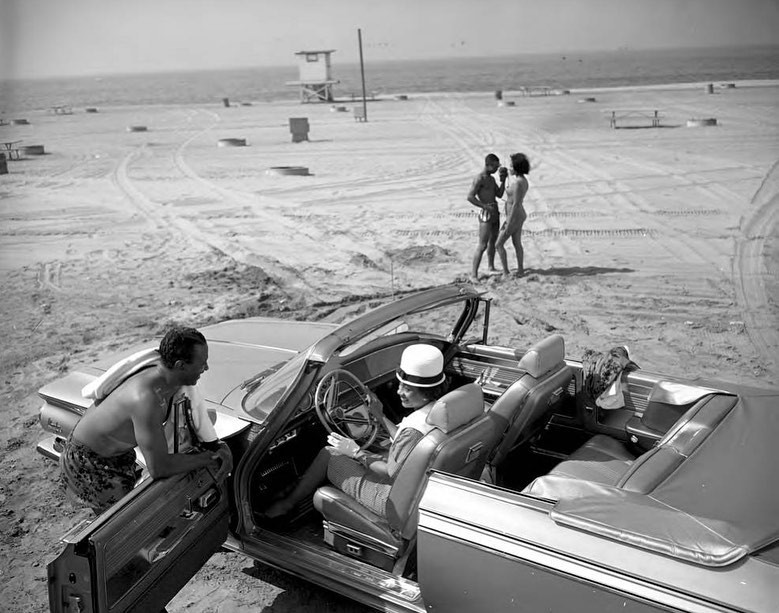 |
|
| (1963)* – Chrylser promotional photo taken at Dockweiler Beach. Photo by Charles Williams |
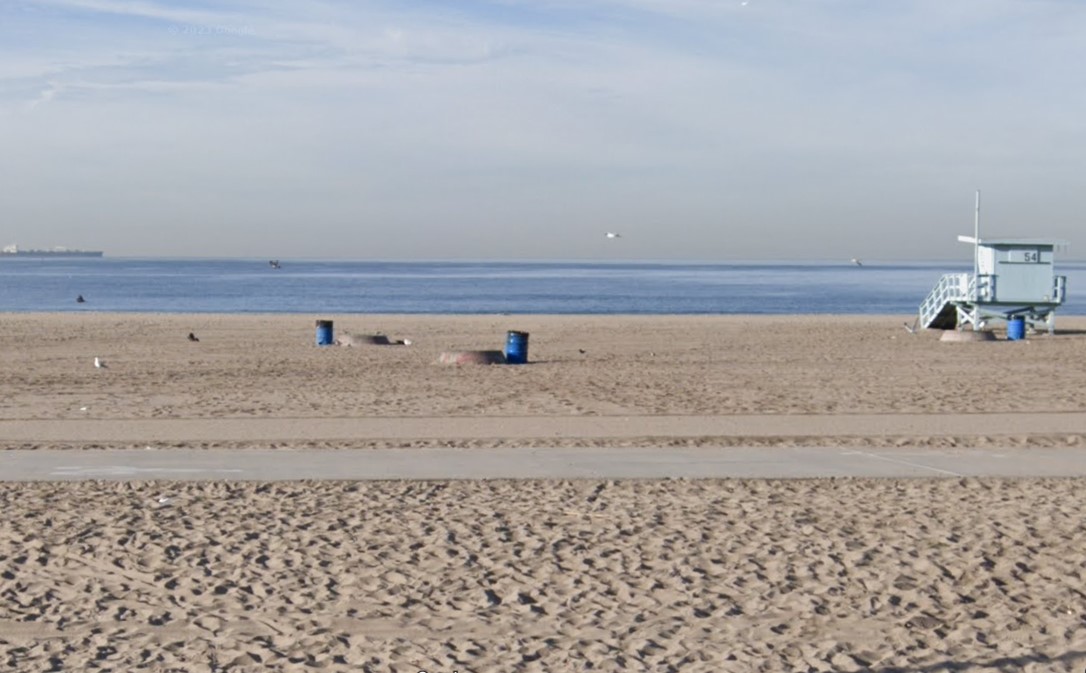 |
|
| (2022)* - Contemporary view of Dockweiler Beach. |
* * * * * |
Marina del Rey (and Ballona Creek)
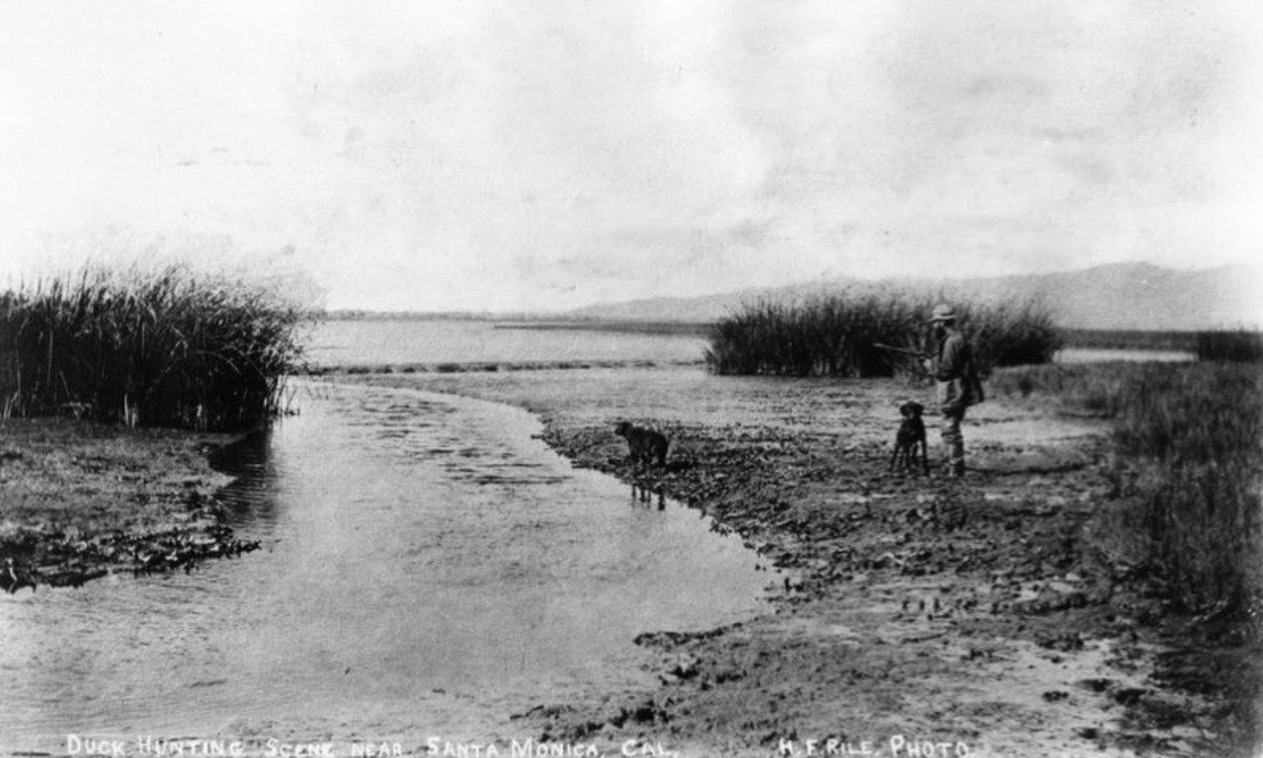 |
|
| (1890)* - Duck hunting in the Ballona wetlands near Santa Monica, in the area that would later become Marina del Rey. Photo by H. F. Rile |
Historical Notes In the late 19th century, the Ballona wetlands formed a vast estuarine ecosystem of salt marshes and freshwater ponds near the mouth of Ballona Creek. Popular with duck hunters, the area remained largely undeveloped, with seasonal flooding making permanent structures impractical. This image, captured by early photographer H. F. Rile, offers a rare glimpse into the pre-development ecology of what would later become Marina del Rey—then a remote and biologically rich marshland frequented only by outdoorsmen and a few settlers. |
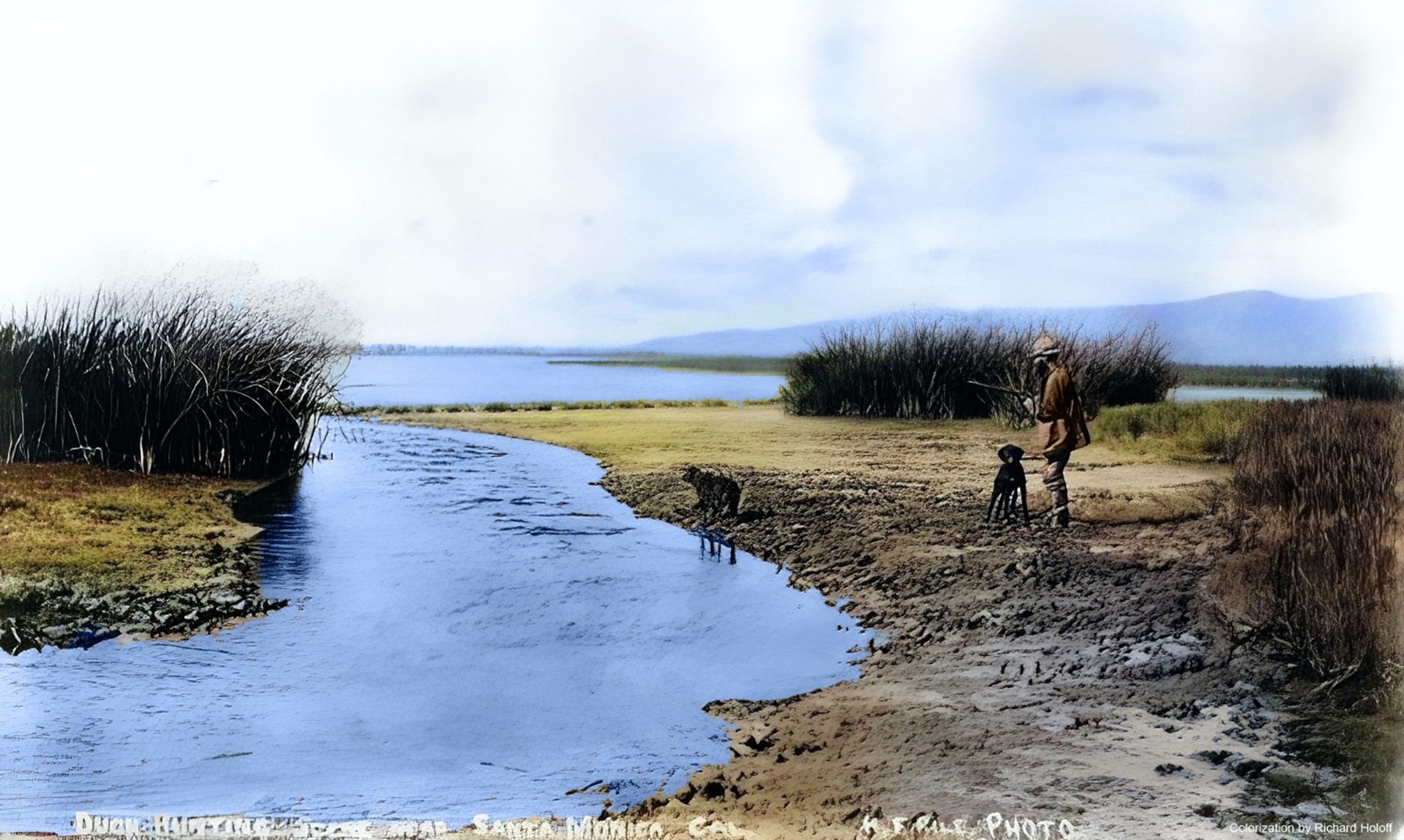 |
|
| (1890)* - Duck hunting near Santa Monica on the Ballona lowlands; now Marina del Rey. Photo by H. F. Rile; Image enhancement and colorization by Richard Holoff |
Historical Notes This colorized version of an original photo shows what the Ballona wetlands looked like before the area was changed forever. At the time, it was a quiet place visited by hunters and surrounded by nature. Birds migrated here by the thousands. It’s hard to imagine that this peaceful marsh would later become a busy harbor with homes, shops, and thousands of boats. |
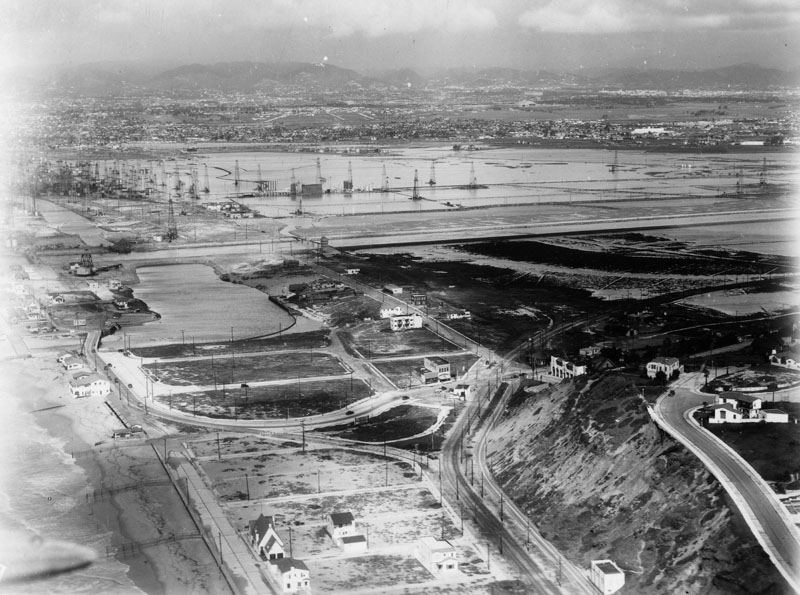 |
|
| (ca. 1929)^ - Aerial view of Marina del Rey, with oil wells prevalent on the other side of Ballona Creek. Surfridge is at lower right. |
Historical Notes By the 1920s, the area around Ballona Creek was full of oil drilling. After oil was discovered near downtown L.A. in 1892, people rushed to drill all over Southern California—even near the beaches. This photo shows how much of the land near Marina del Rey was used for oil wells. Because of this, plans to build a marina were delayed for many years. |
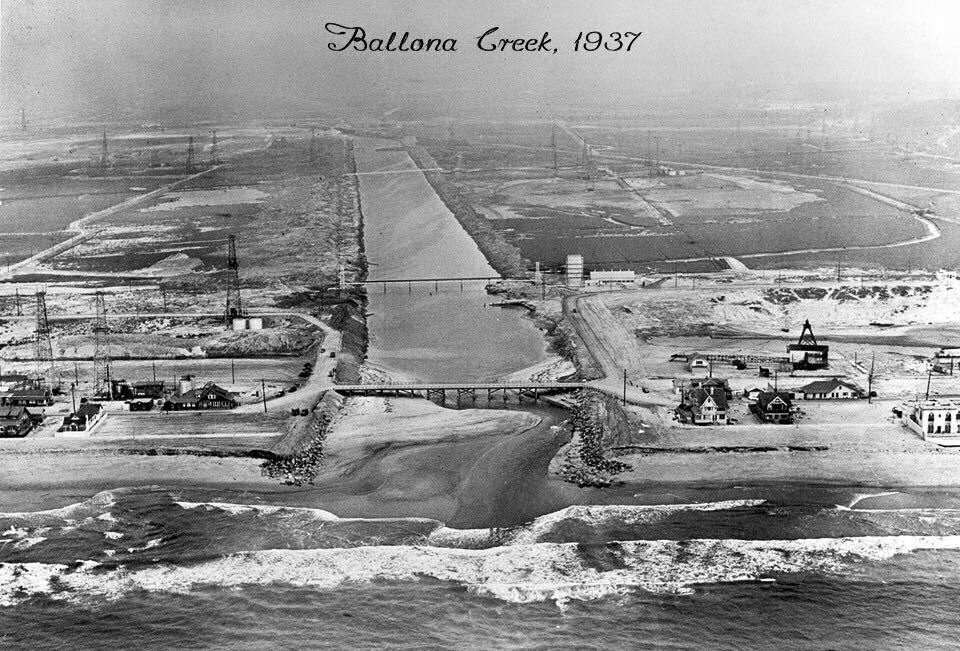 |
|
| (1937)* - View showing Ballona Creek as an enclosed flood control channel, before it was lined with concrete. The area at left would become Marina Del Rey. Photo Source: Marina del Rey Historical Society |
Historical Notes Originally, Ballona Creek was a natural stream that often overflowed during heavy rain. In the 1930s, Los Angeles started building flood control channels to stop the flooding. This photo shows the creek before those changes. After a major flood in 1938, the U.S. Army Corps of Engineers decided to line the creek with concrete, which allowed for future development—like Marina del Rey. |
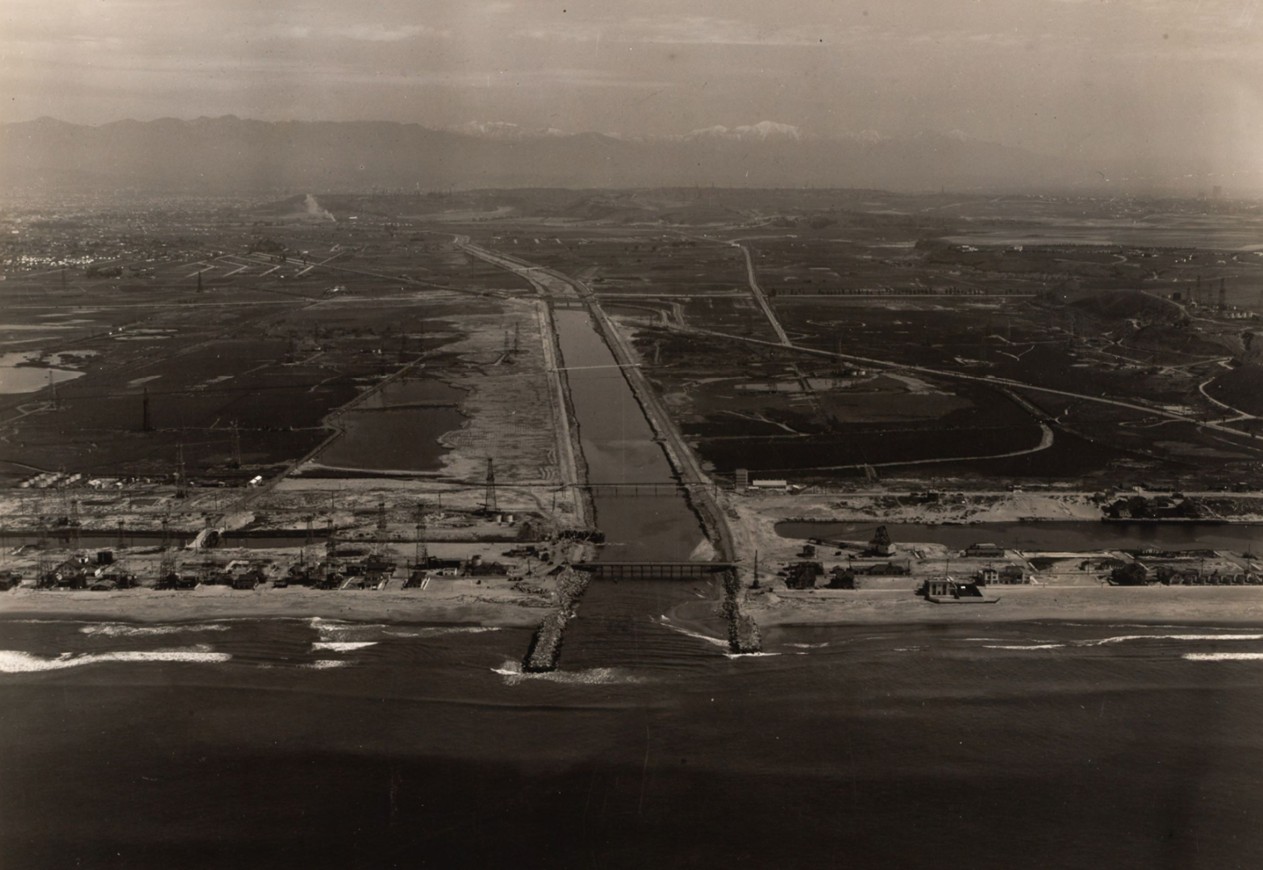 |
|
| (1938)* - Aerial view of the coastline centered on Ballona Creek lined with concrete walls as seen emptying into the Santa Monica Bay near Marina del Rey. Oil rigs and bridges are visible on the beach and inland. |
Historical Notes This photo shows Ballona Creek just after it was lined with concrete following the disastrous 1938 flood. Concrete walls helped control the flooding but also changed the natural environment. At the same time, oil drilling was still going strong near the beach. The image shows how industry, flood control, and coastal land use were starting to shape what would eventually become Marina del Rey. |
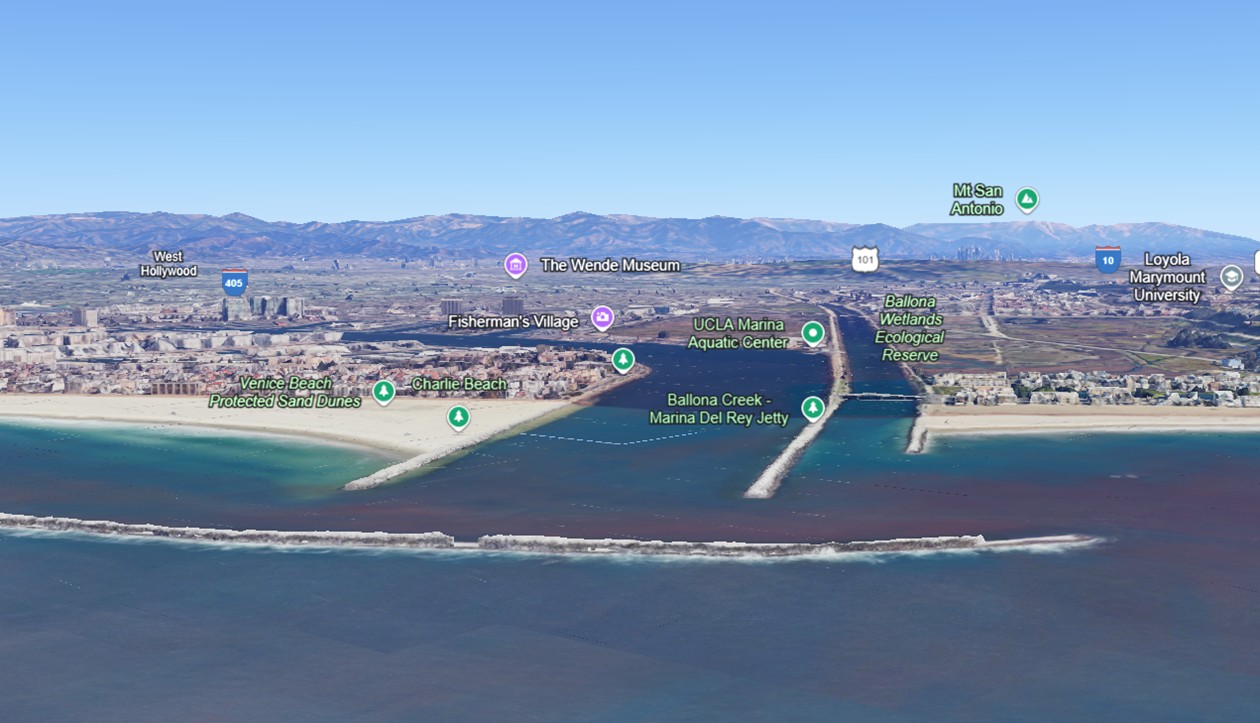 |
|
| (2022)* - Contemporary view of Ballona Creek, Marina del Rey, Playa del Rey, and surrounding area. |
Then and Now
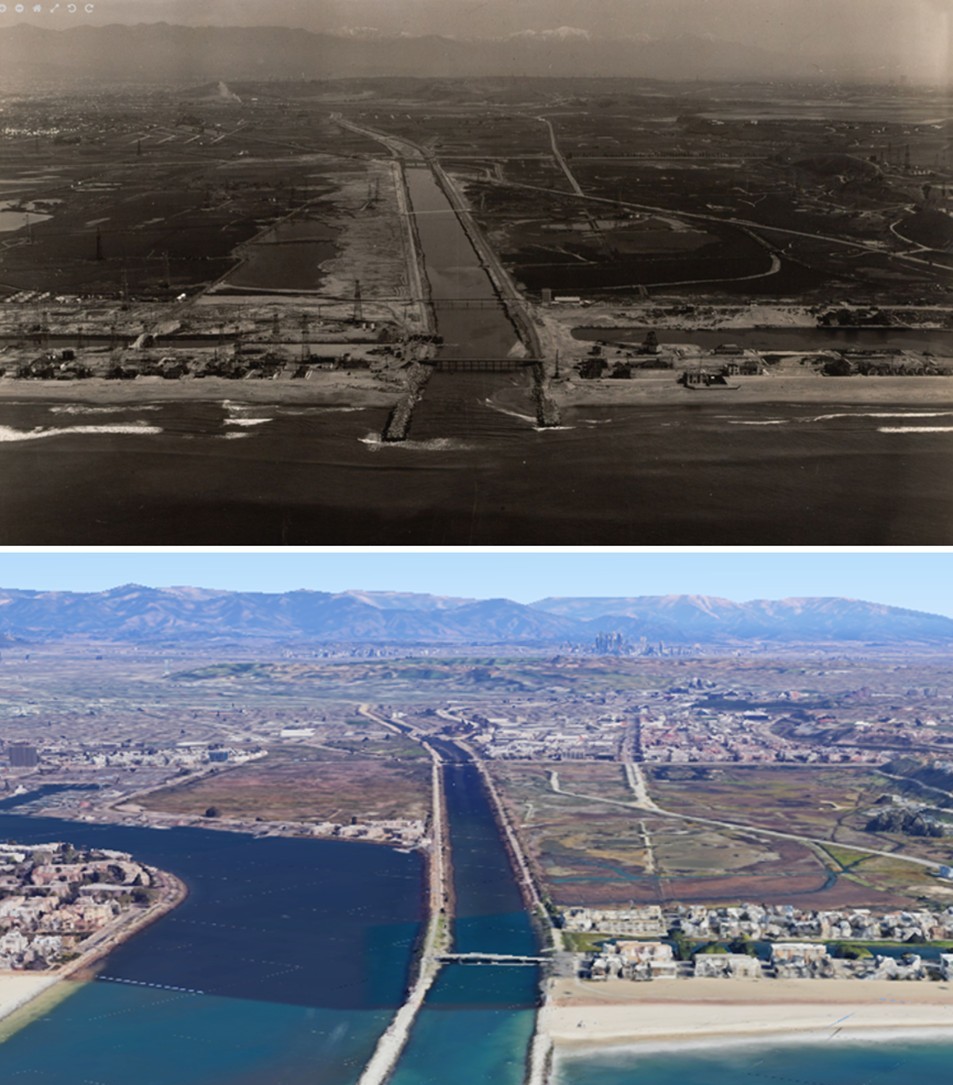 |
|
| (1938 vs. 2022)* – A ‘Then and Now’ aerial view of Ballona Creek looking northeast from the Pacific. Photo comparison by Jack Feldman. |
Historical Notes In 1938, the freshly channelized creek cut through a flat expanse dominated by oil wells, marshes, and scattered structures. By 2022, the landscape had transformed dramatically—what was once oil field and open wetlands is now Marina del Rey, one of the largest man-made small-craft harbors in the world, with Playa del Rey homes and restored wetlands visible at the bottom of the frame. |
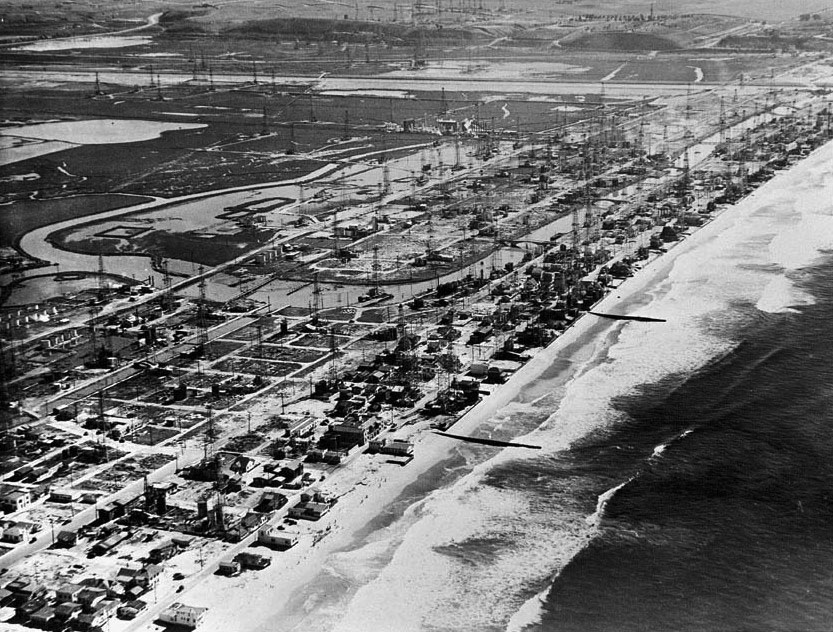 |
|
| (1938)* – Aerial view showing part of Venice Oil Field and Playa del Rey. The area at center would become today's well known Marina del Rey harbor. Ballona Creek can be seen running horizontally from left to right at top. |
Historical Notes Before Marina del Rey was built, this land was part of the Venice Oil Field. There were oil derricks throughout the area, even close to the beach. Although the idea of building a harbor here had been around for decades, oil drilling took priority. This photo shows what the area looked like before boats, apartments, and parks replaced the oil equipment. |
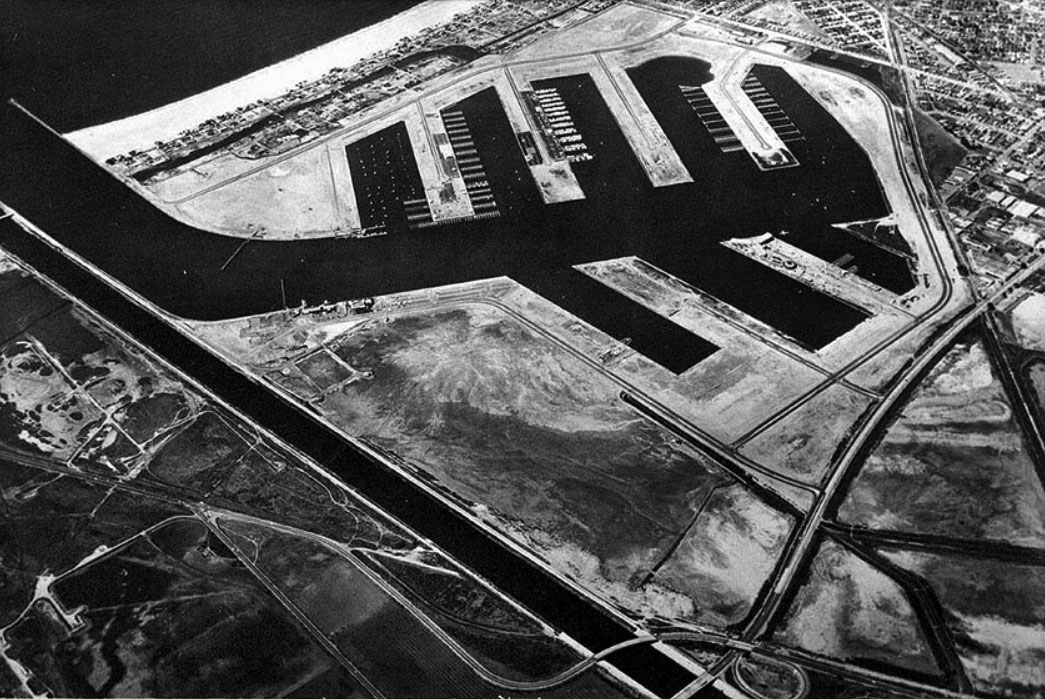 |
|
| (1964)* – Aerial view showing the Marina del Rey with its first boats docked. Ballona Creek runs diagonally from lower-center to upper-left. |
Historical Notes After years of planning and construction, Marina del Rey was finally completed in the early 1960s. It was funded by Los Angeles County and the federal government. This photo shows the first boats arriving at the docks. The area that was once marshland and oil fields had now become the world’s largest man-made small boat harbor. |
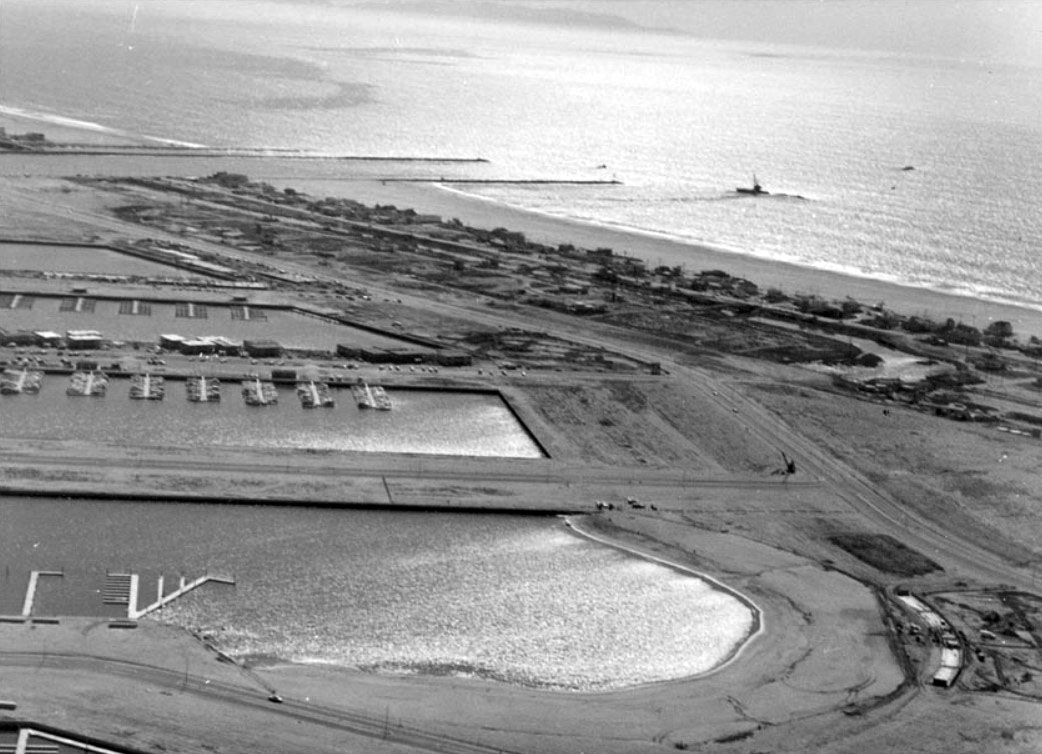 |
|
| (1965)* – View of Marina del Rey as it appeared in 1965 with the Inland Beach (Mother’s Beach) at lower right. |
Historical Notes By 1965, Marina del Rey was almost fully built. The small beach shown here, now known as Mother’s Beach, was created for families and children. But in 1962–63, strong winter storms caused major damage to the new marina. To protect it, a large breakwater was built at the entrance. This helped make the harbor safer for boats and more stable overall. |
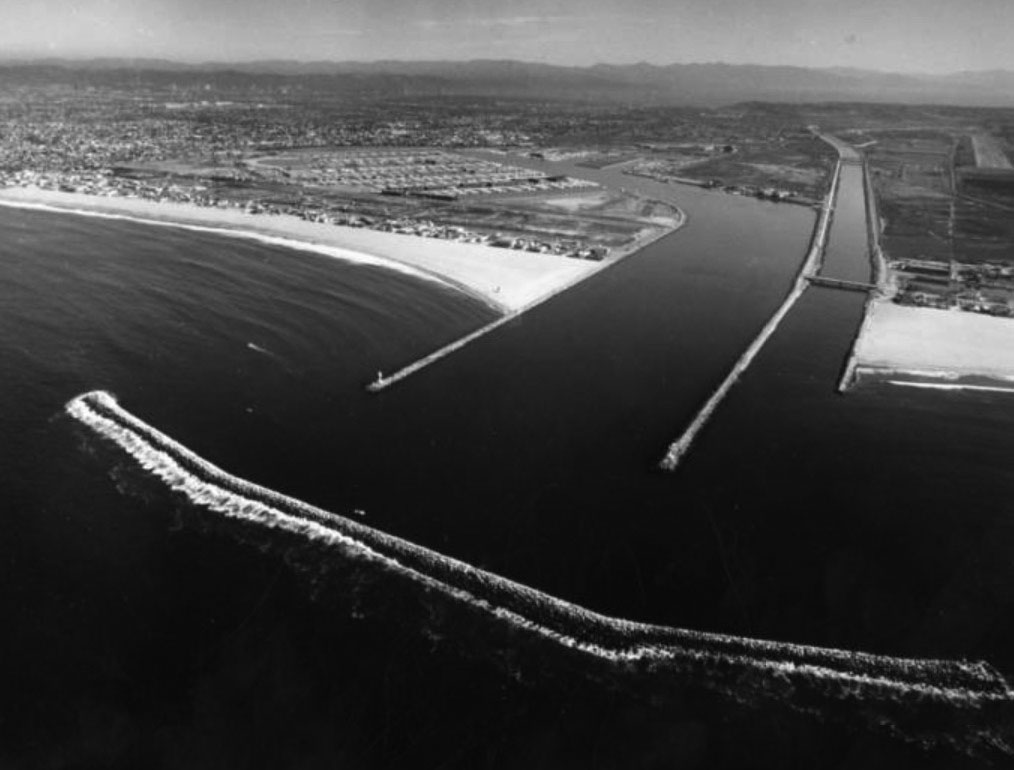 |
|
| (1968)* - Aerial view of Marina del Rey on October 16, 1968, showing the entrance to the marina and its new breakwater. |
Historical Notes The breakwater shown here was finished in the mid-1960s to protect the marina from ocean waves and storms. This 1968 photo shows the fully developed harbor, just a few years after it was officially opened in 1965. It had cost over $36 million to complete and quickly became a popular destination for boaters and tourists. |
Before and After
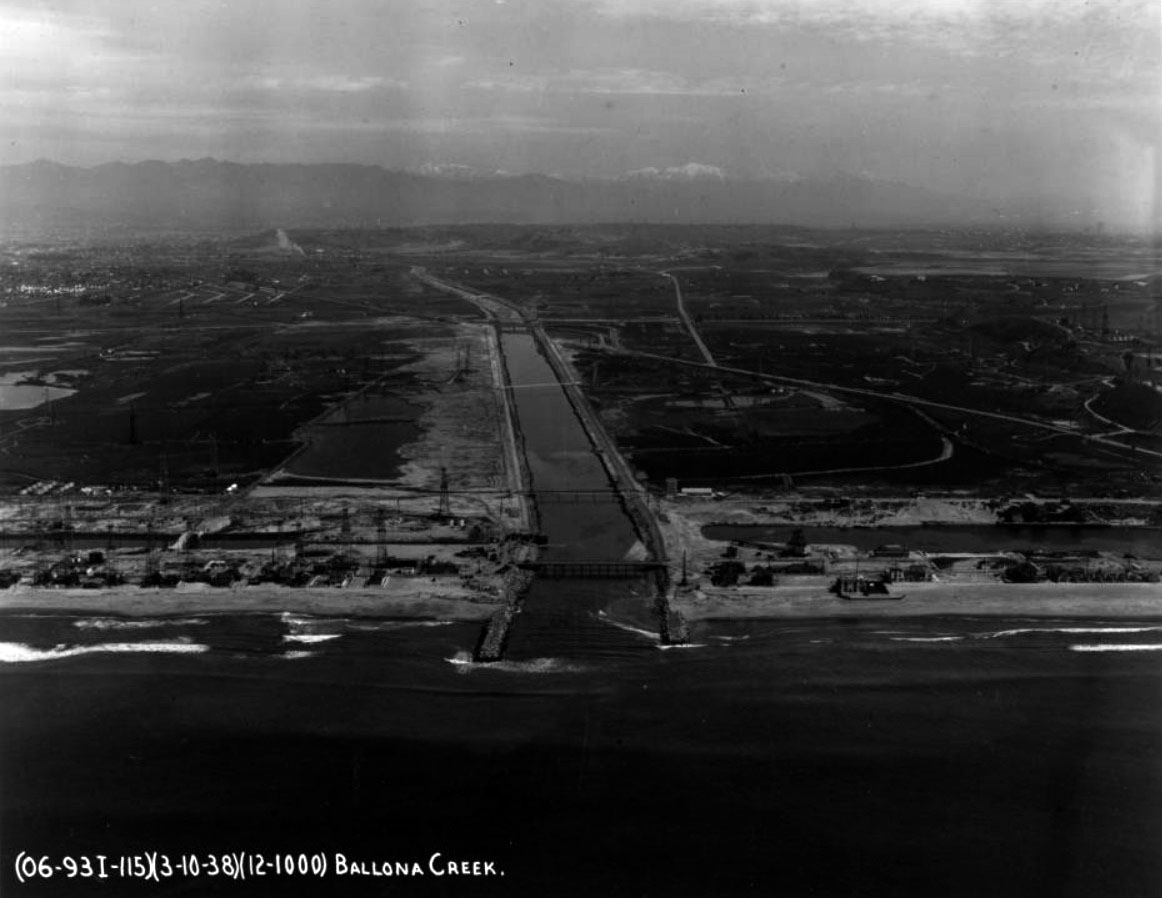 |
|
 |
|
| (1938 vs. 1968) - Marina del Rey |
Historical Notes These two images—30 years apart—show just how much the area changed. In 1938, the land was mostly wetlands and oil fields. By 1968, it had been turned into a modern marina with docks, roads, and buildings. The comparison highlights how quickly Los Angeles County transformed natural spaces into urban centers in just a few decades. |
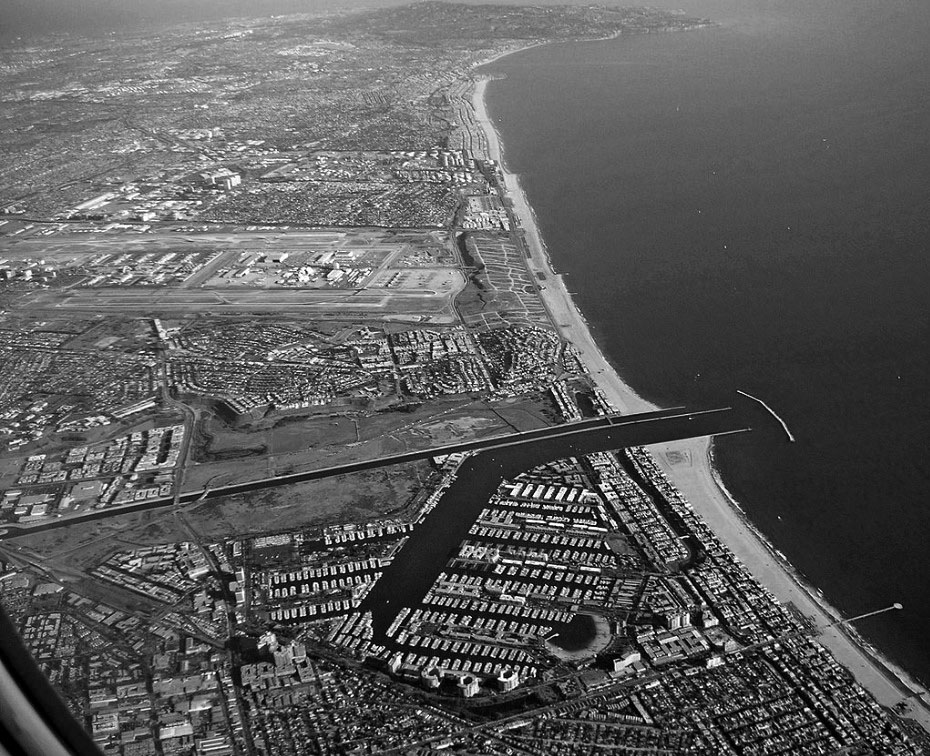 |
|
| (2007)* - Aerial view showing Marina del Rey and Ballona Creek looking south. |
Historical Notes By 2007, Marina del Rey had become a major hub for recreation and tourism. With thousands of boat slips, high-rise condos, and restaurants, it had completely replaced the original wetlands. However, the nearby Ballona Creek and remaining marshes were starting to get more attention from environmental groups who wanted to protect what was left of the area’s natural habitat. |
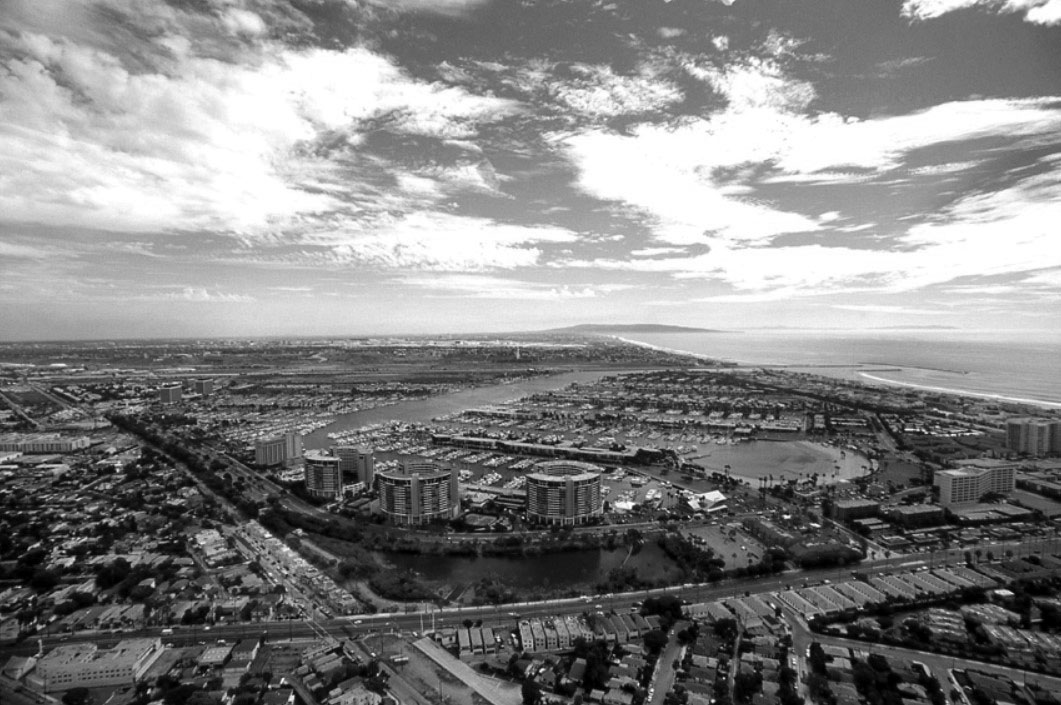 |
|
| (ca. 2012)* - Aerial view showing the Marina del Rey as it appears today. |
Historical Notes Today, Marina del Rey is a mix of public space, private homes, marinas, and parks. While most of the original wetlands are gone, parts of the Ballona Wetlands have been preserved and are being restored. This shows a shift in thinking—from changing nature to protecting it—while still enjoying all that the marina has to offer. |
* * * * * |
Hyperion Sewage Plant
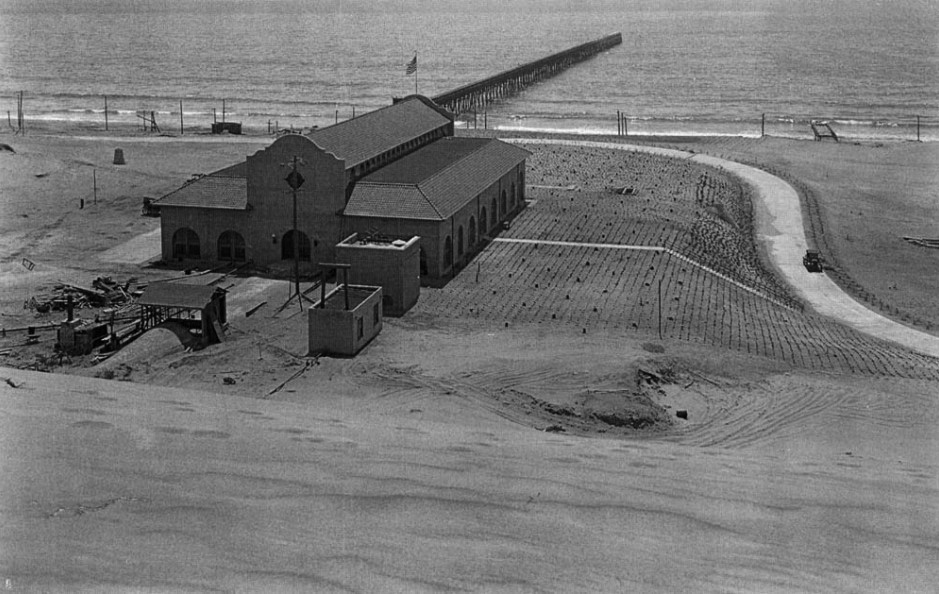 |
|
| (ca. 1925)* - Initial Hyperion Treatment Plant (primary treatment only). Note the "sewage pier" with outfall pipe. |
Historical Notes Until 1925, raw sewage from the city of Los Angeles was discharged untreated directly into Santa Monica Bay in the region of today's Hyperion Treatment Plant. With the population increase, the amount of sewage became a major problem to the beaches, so in 1925 the city of Los Angeles built a simple screening plant (seen above) in the 200 acres the city had acquired in 1892. |
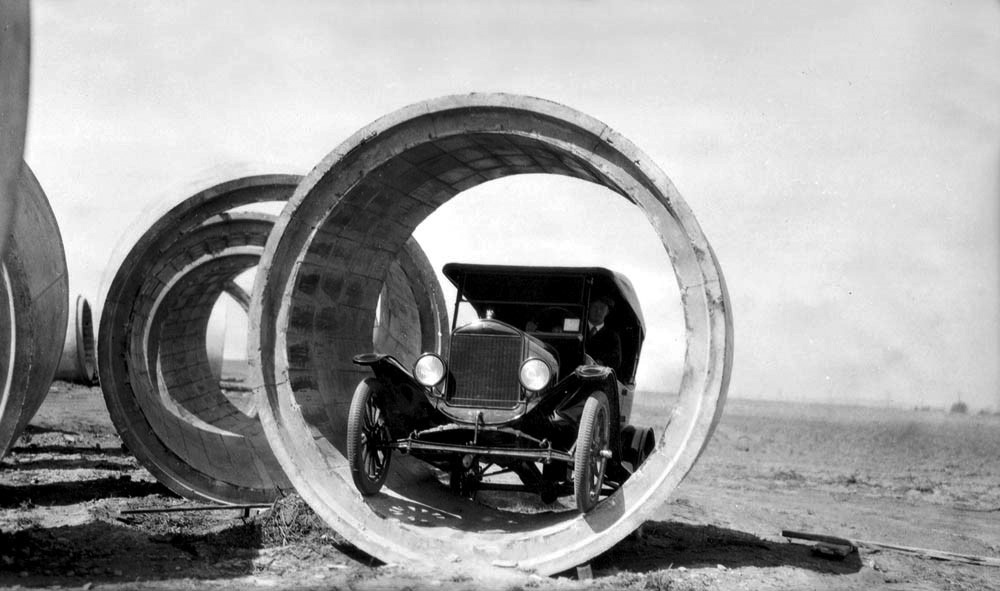 |
|
| (1920s)* - Concrete pipe for a segment of the North Outfall with a car inside. |
Historical Notes The North Outfall conveyed sewage to the early (primary) Hyperion Treatment Plant and ocean outfall. |
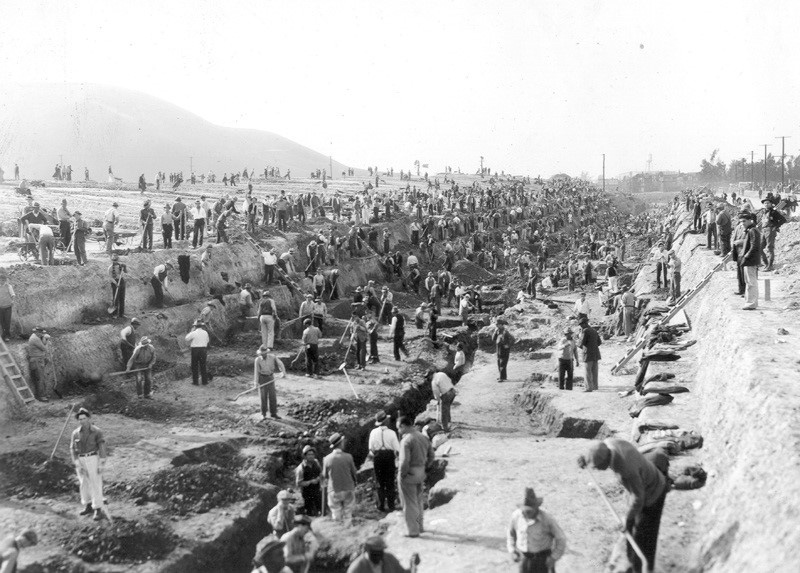 |
|
| (ca. 1937)* - View showing hundreds of workers moving sand behind the old Hyperion screening plant in preparation for a new sewage treatment plant planned by then City Engineer Lloyd Aldrich. |
Historical Notes Despite a $7 million grant from the federal government, only an experimental plant to handle a small amount of sewage was started and apparently was never actually placed in operation. |
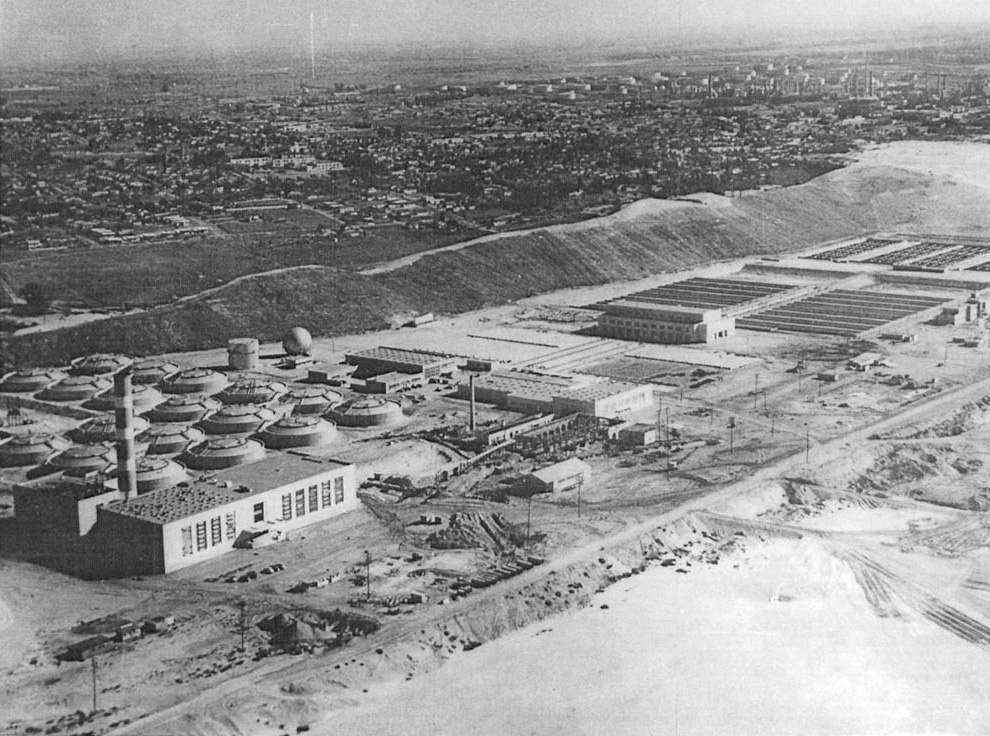 |
|
| (1952)* – View showing the Hyperion Sewage Treatment Plant located at 12000 Vista del Mar, Playa del Rey. |
Historical Notes Even with the screening plant, the quality of the water in the Santa Monica Bay was unacceptable, and in 1950 the city of Los Angeles opened the Hyperion Treatment Plant with full secondary treatment processes. In addition, the new plant included capture of biogas from anaerobic digesters to produce heat dried fertilizer. In order to keep up with the increase of influent wastewater produced by the ever growing city of Los Angeles, by 1957 the plant engineers had cut back treatment levels and increased the discharge of a blend of primary and secondary effluent through a five-mile pipe into the ocean. They also opted to halt the production of fertilizers and started discharging digested sludge into the Santa Monica Bay through a seven-mile pipe. Marine life in Santa Monica Bay suffered from the continuous discharge of 25 million pounds of wastewater solids (sludge) per month. Samples of the ocean floor where sludge had been discharged for 30 years demonstrated that the only living creatures were worms and a hardy species of clam. Additionally, coastal monitoring revealed that bay waters often did not meet quality standards as the result of Hyperion's effluent. These issues resulted in the City entering into a consent decree with the United States Environmental Protection Agency and the State of California to build major facility upgrades at Hyperion. In 1980, Los Angeles launched a massive sludge-out to full secondary program to capture all biosolids and keep them from entering the Bay. The sludge-out portion of the program was completed in 1987. |
* * * * * |
Hermosa Beach
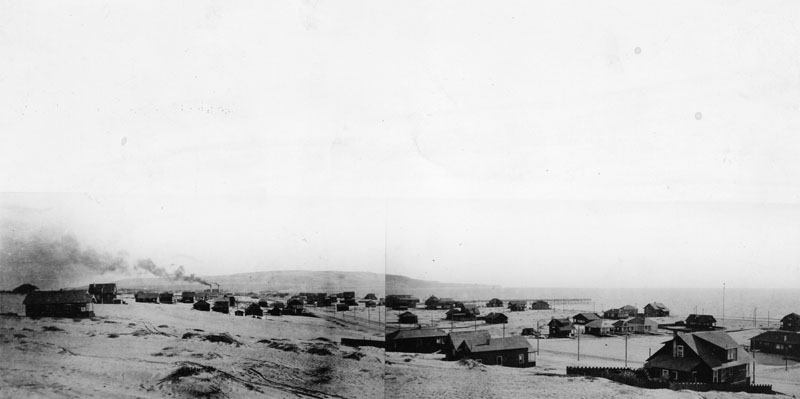 |
|
| (ca. 1904)^ - View of residential homes in Hermosa Beach with the Palos Verdes Peninsula seen in the background. Also seen is the Hermosa Beach Pier, built in 1904. |
Historical Notes Hermosa Beach was originally part of the 1884 Rancho San Pedro Spanish land grant that later became the ten-mile Ocean frontage of Rancho Sausal Redondo. In 1900 a tract of 1,500 acres was purchased for $35 per acre from A. E. Pomroy, then owner of the greater part of Rancho Sausal Redondo. Messrs. Burbank and Baker, agents, bought this land for Sherman and Clark who organized and retained the controlling interest in the Hermosa Beach Land and Water Company. The first city election for city officers was held December 24, 1906. On January 14, 1907, Hermosa Beach became the nineteenth incorporated city of Los Angeles County.*^ |
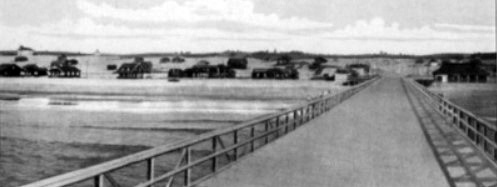 |
||
| (ca. 1904)+*^ – View showing the first Hermosa Beach Pier with houses in the background. |
Historical Notes The first Hermosa Beach Pier was built in 1904, two years before the city officially incorporated. Constructed out of wood, the 500-foot-long pier broke up and much of it floated out to sea during a violent storm in 1913. The strength of such winter storms along the west-facing South Bay beaches was the undoing of many such structures over the years, including various incarnations of the Redondo Beach pier, and had much to do with San Pedro’s victory in winning the battle to become Los Angeles’ official port in 1907. |
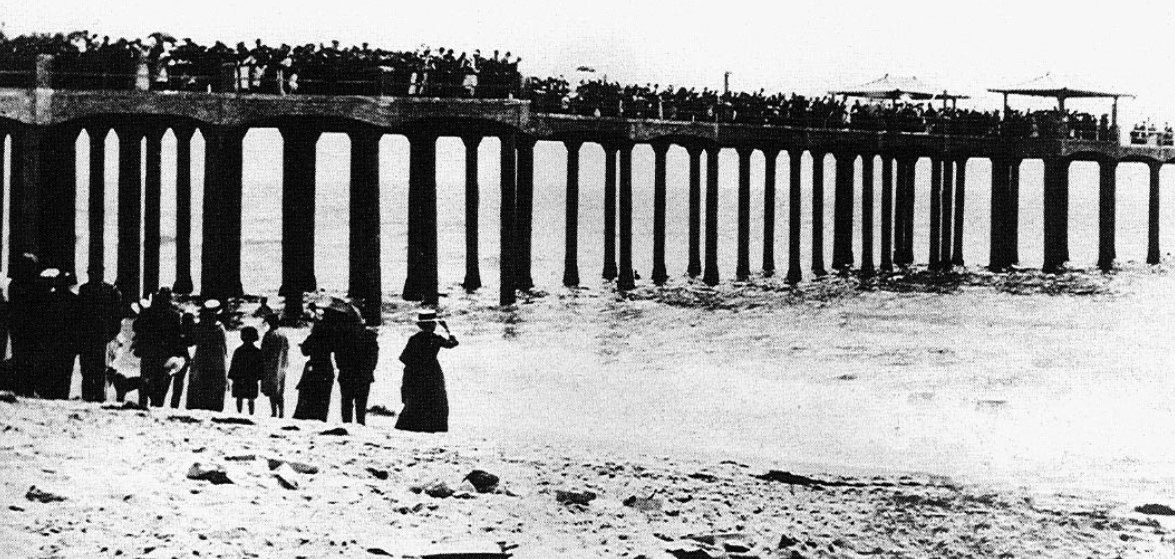 |
|
| (1914)^x^ – Crowds gather on the new concrete Hermosa Beach pier for its dedication. Photo: Hermosa Beach Historical Society. |
Historical Notes Hermosa Beach’s second pier was built in 1914. Constructed of concrete, the pier was 1,000 feet long and paved with asphalt its entire length. Small tiled pavilions were erected at intervals along the sides to afford shade for fishing and picnic parties. A bait stand was built eventually out on the end.*^ |
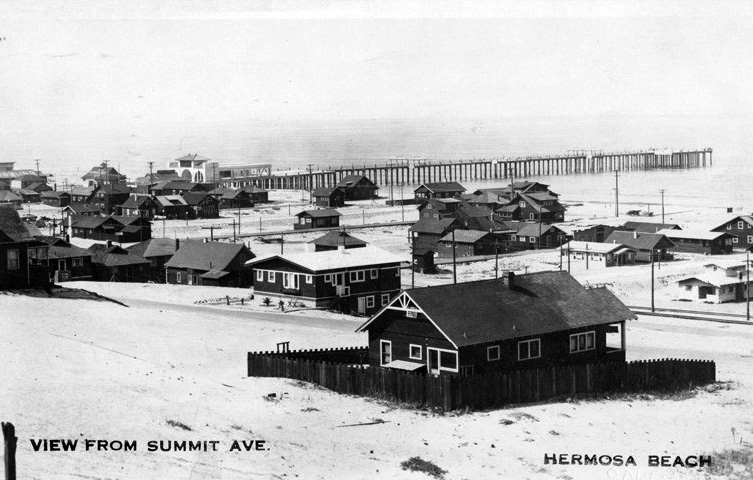 |
|
| (1914)^*# – Postcard view of Hermosa Beach and Pier as seen from Summit Avenue. |
Historical Notes Soon after the concrete pier was built in 1914, an auditorium building was constructed; it has housed various enterprises and at present the public rest rooms, the Los Angeles Life Guard Service, and the local branch of the Los Angeles County Public Library occupy rooms in the building. This pier is municipally owned. |
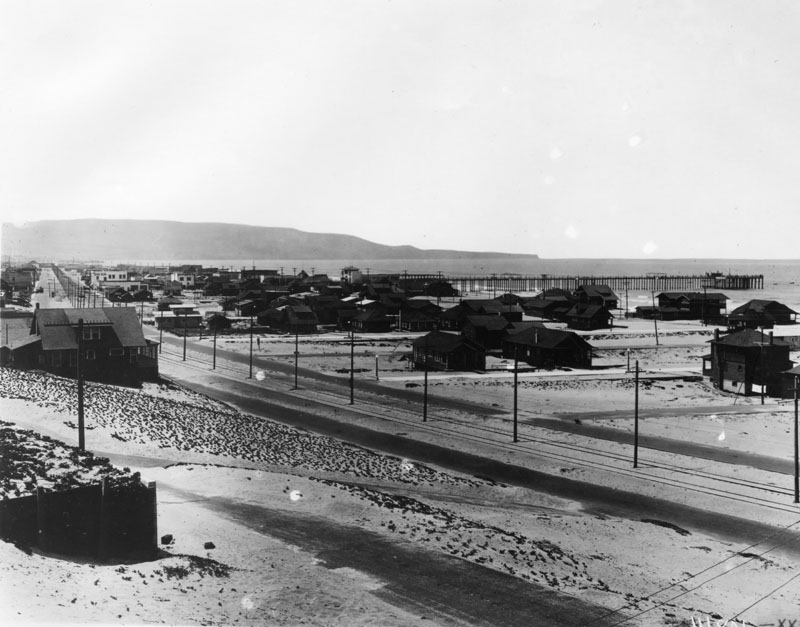 |
|
| (1918)^ - View showing Hermosa Beach as it appeared in 1918 with Palos Verdes Peninsula seen in the distance. Note the tracks and electric trolley lines that run along the beach. |
Historical Notes The Los Angeles Pacific Railway, a "trolley" system, was the first railway in Hermosa Beach, running the entire length of Hermosa Avenue on its way from L.A. to Redondo Beach. A few years later it was merged with most all other "trolley" companies in the region to form the new Pacific Electric Railway Company, informally called the Red Cars.*^ |
.jpg) |
|
| (1923)^ - Beachgoers enjoy the day at Hermosa Beach. Crowds of people relax under an umbrella on the sand, while others enjoy swimming or wading in the cool water. Building on the right is the Strand Bath House. |
The Strand
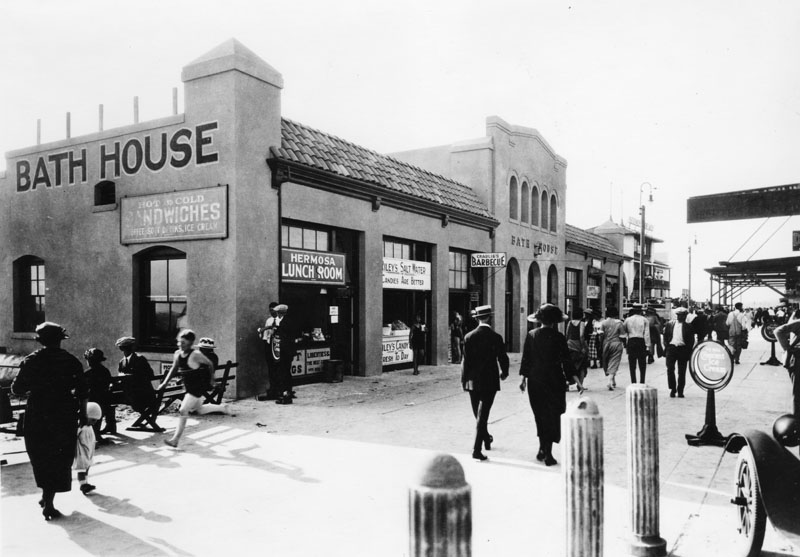 |
|
| (1923)^- View of the Bath House building located in Hermosa Beach. Several storefronts around the bathhouse are also seen. Some of them are: Hermosa Lunch Room, Riley's Salt Water Candies, Charlie's Barbecue and The Bath House. |
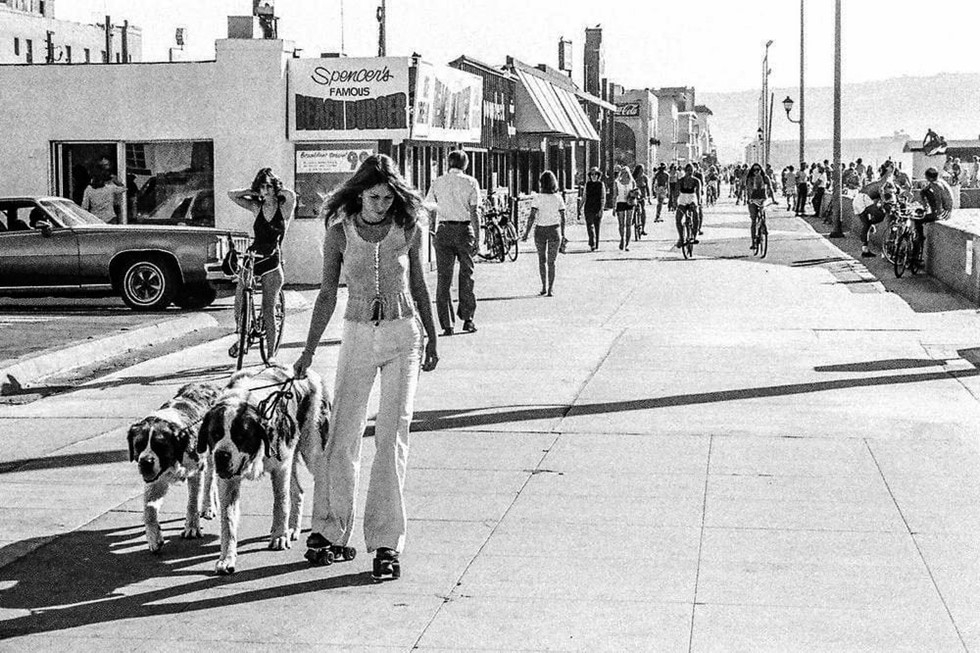 |
|
| (1970s)* - Along the strand in Hermosa Beach. |
Then and Now (1920s vs 1970s)
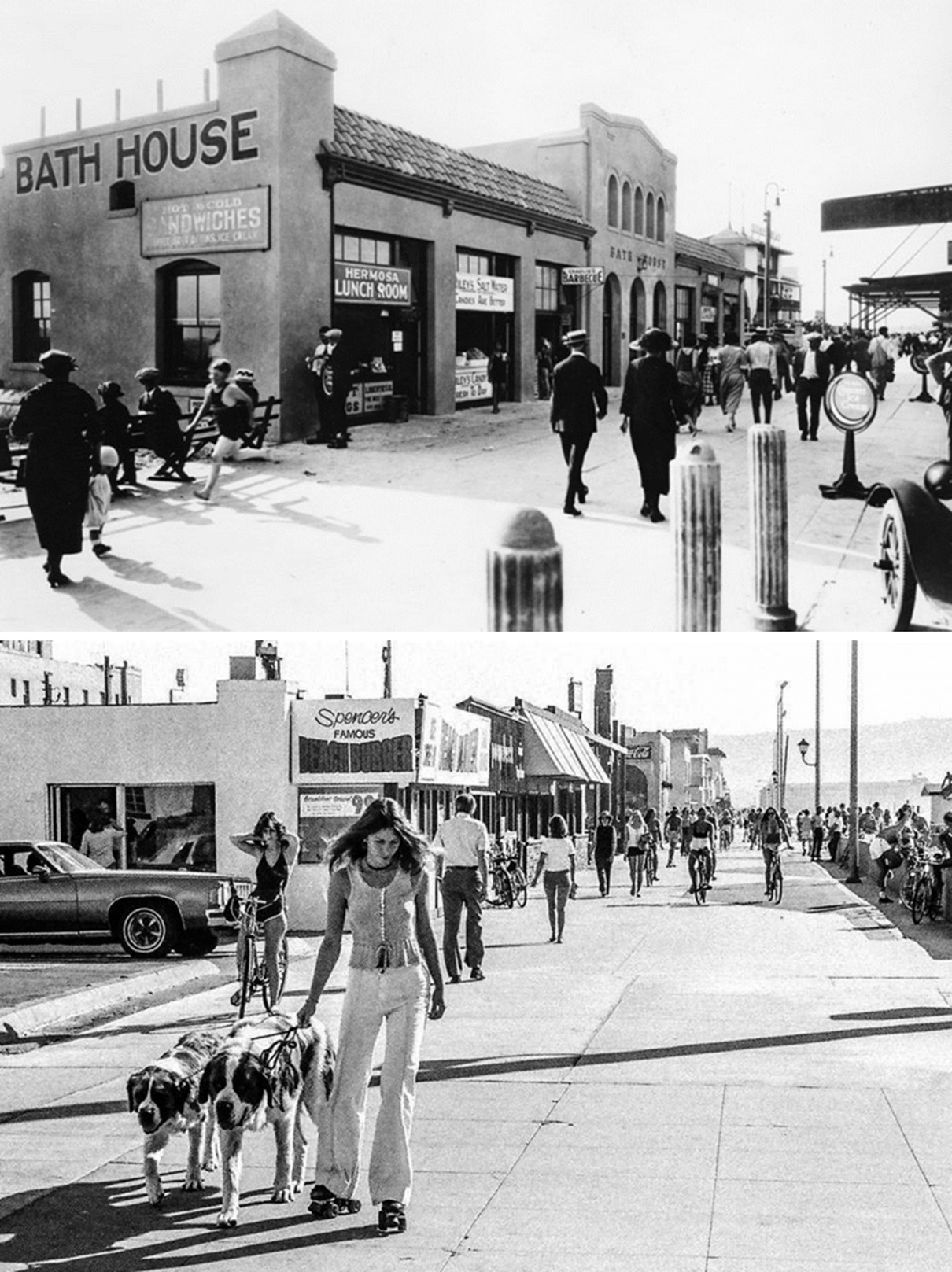 |
|
| (1920s vs 1970s)* – Hermosa Beach Strand |
Then and Now (1970s vs 2020s)
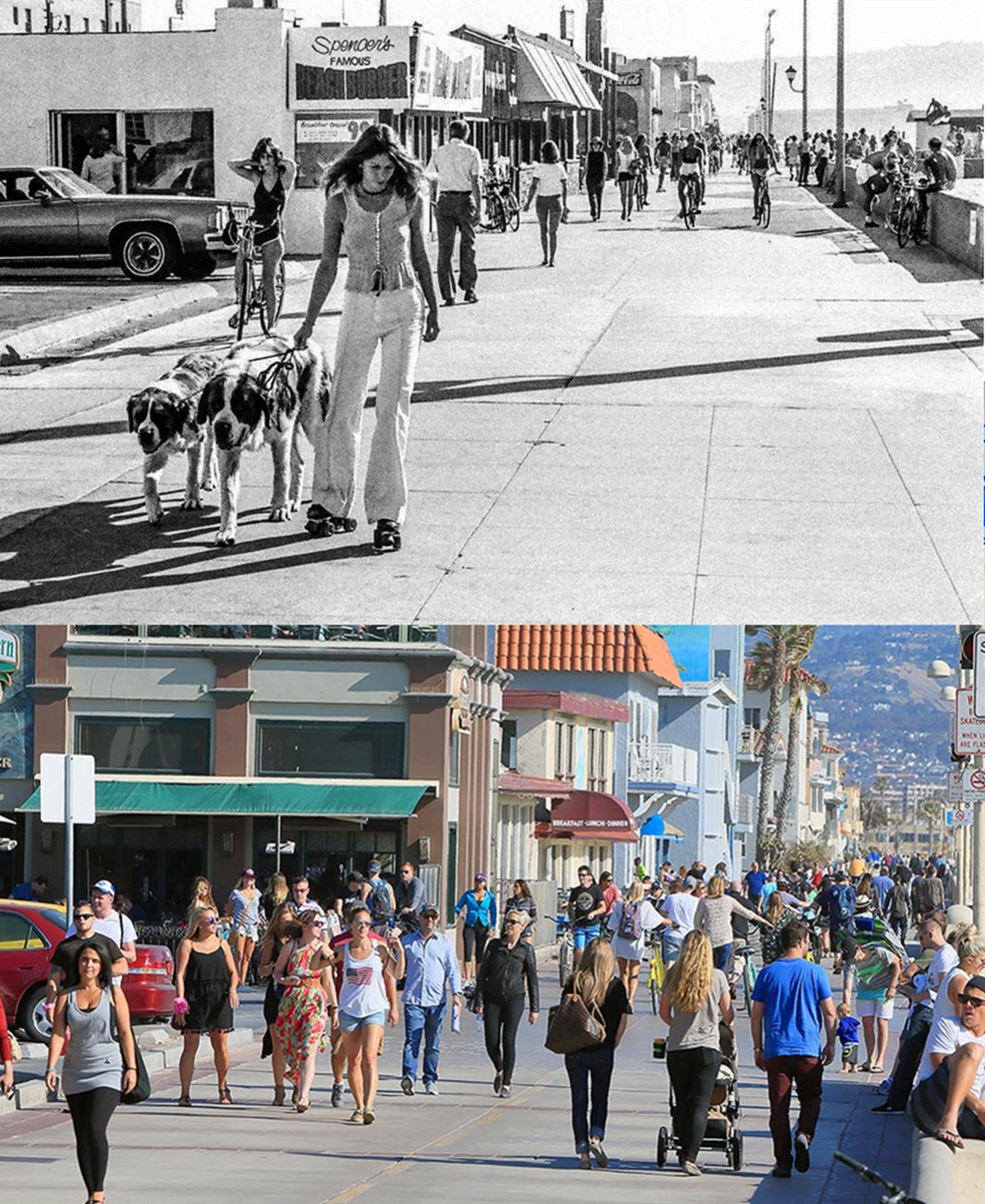 |
|
| (1970s vs 2020s)* – Hermosa Beach Strand |
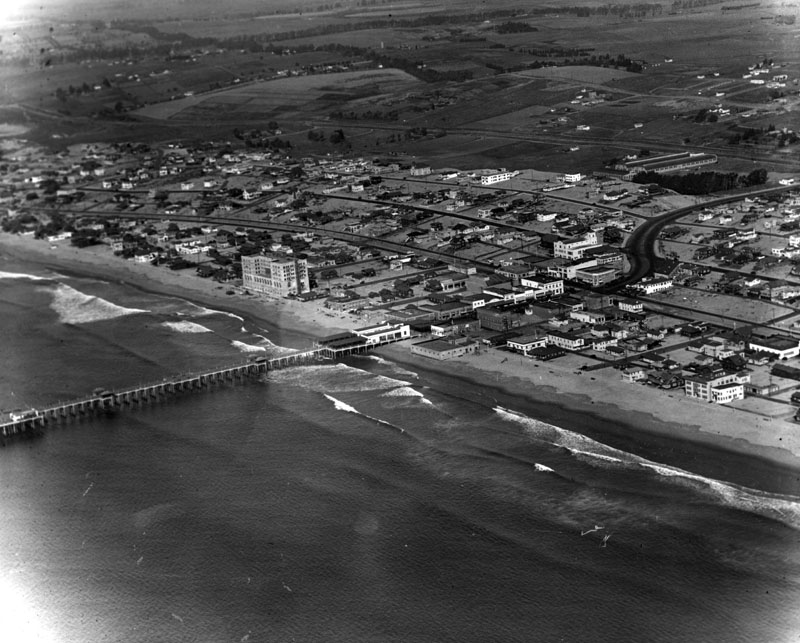 |
|
| (1924)^ - Aerial view is looking northeast at Hermosa Beach. The Surf and Sand Club is the large building left of the pier. Many dwellings can be see along the oceanfront with sparsely populated areas in the background. |
Historical Notes The Los Angeles Pacific Railway, a "trolley" system, was the first railway in Hermosa Beach, running the entire length of Hermosa Avenue on its way from L.A. to Redondo Beach. A few years later it was merged with most all other "trolley" companies in the region to form the new Pacific Electric Railway Company, informally called the Red Cars. The Santa Fe Railway was next through Hermosa Beach. It was seven blocks from the beach. The street that led to the tracks was called Santa Fe Avenue, but was later renamed Pier Avenue. There was no Santa Fe railway station for Hermosa, but Burbank and Baker built a railway platform on the west side of the tracks near Santa Fe Avenue, and later the Railroad Company donated an old boxcar to be used as a storage place for freight. In 1926, the Santa Fe Company built a modern stucco depot and installed Western Union telegraph service in it.*^ |
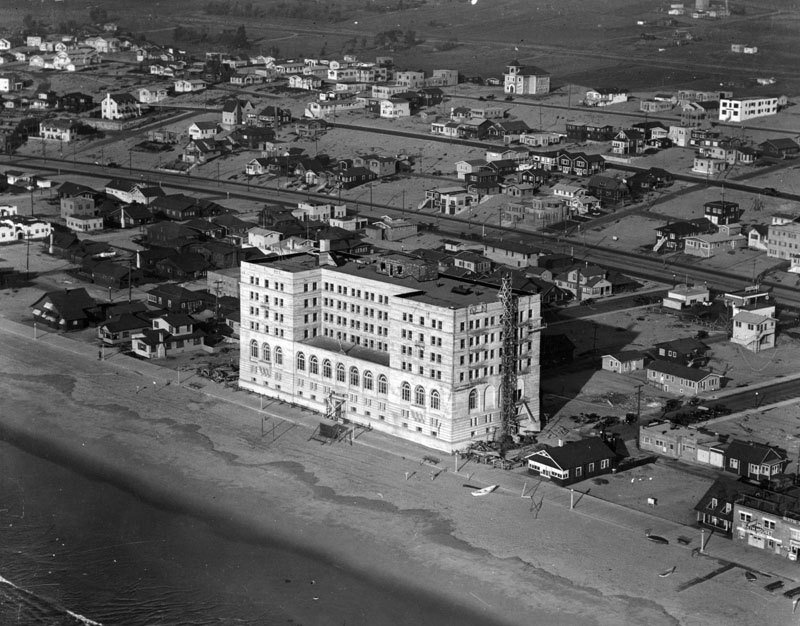 |
|
| (1924)^ - Aerial view of the Surf and Sand Club on the oceanfront of Hermosa Beach. Several residential homes are next to the club, and in the surrounding area. A Bath House can be seen in the lower right corner of photo. |
Historical Notes One of the most ambitious projects attempted in the city came in the mid-1920's with the opening of the above building, which later became the Hermosa Biltmore Hotel. The Hotel was located between 14th and 15th Streets on the Strand. In those days it was the headquarters for the Surf and Sand Club, and was run on a private club basis. A number of wealthy persons backed the project and for several years the building, a notable achievement in those days, was the showplace and social center of Hermosa. The private club idea proved to be a losing proposition, however, and a few years later the founders and owners sold out to the Los Angeles Athletic Club. This group, with better financing, attempted to run the property on more or less the same basis but finally sold out to hotel interests about 1930. During World War II, for a short time the building was taken over by the federal government and used as a youth training center. This property was torn down in the late 1960's for development, and is now the site of a public park.*#^ |
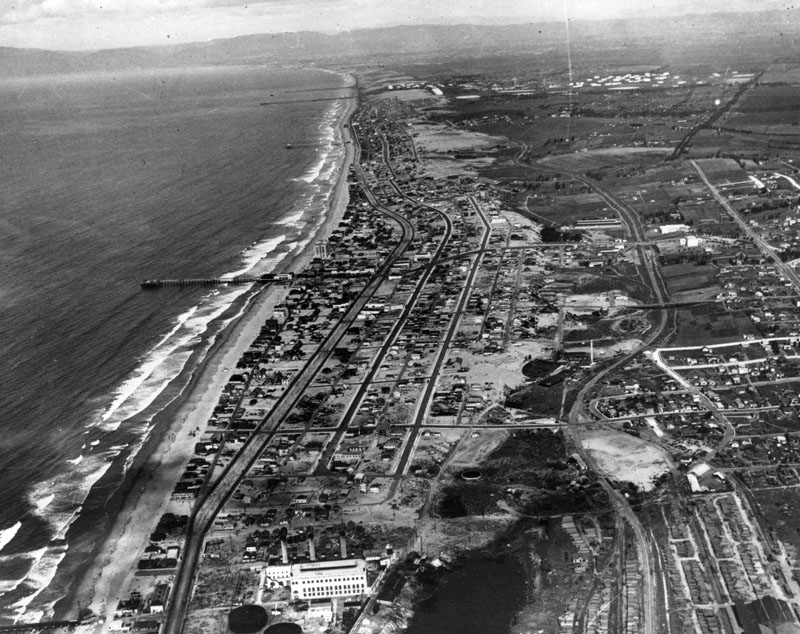 |
|
| (1925)^ - Aerial view of Hermosa Beach and part of Redondo Beach. The Hermosa pier may be seen in the center of this photo. The large white building at the bottom of the photo is a power plant built by Pacific Light and Power Corp. |
Historical Notes This Pacific Light and Power Company power plant was built in 1902 to provide electricity for the Pacific Electric Red Car system in Los Angeles and the surrounding Redondo Beach area. In 1917, Southern California Edison Co. (SCE) purchased Pacific Light and Power Company. In 1946, SCE constructed another power plant at the same site. Today a modified version of this new plant is owned and operated by AES.^ Click HERE to see more in Early Power Generation. |
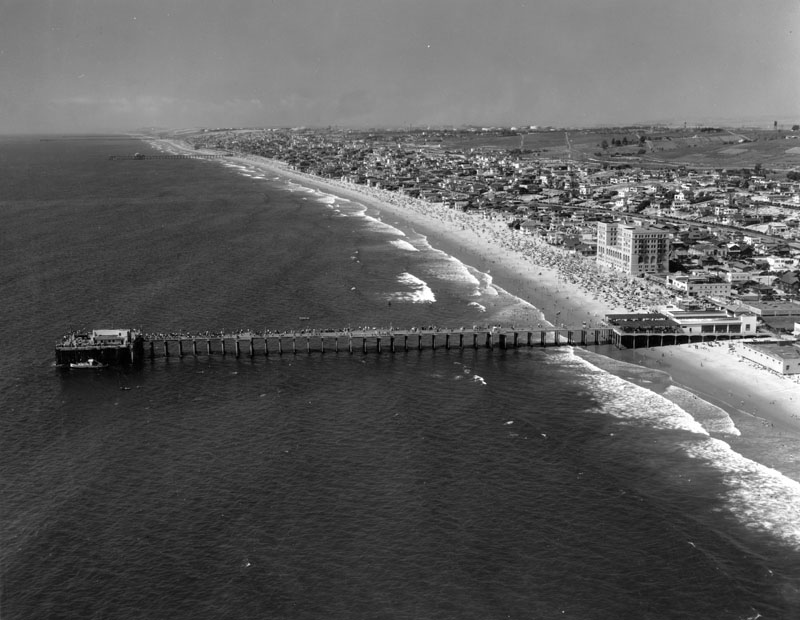 |
|
| (1932)^ - Aerial view of Hermosa Beach Pier. The Surf and Sand Club is the large building on the oceanfront. The dwelling density is already increasing, however the areas in the backround are still sparsely populated. |
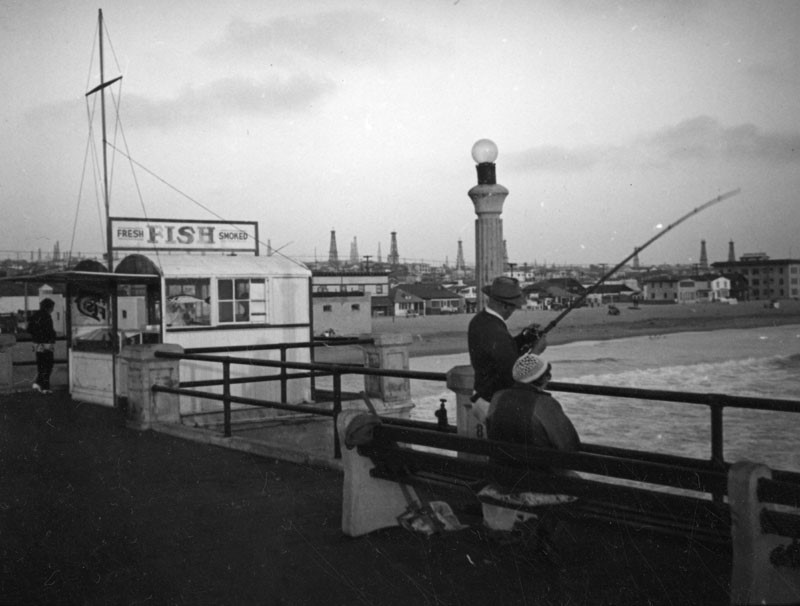 |
|
| (ca. 1937)^ - A man fishes off the pier at Hermosa Beach. A small stand in the background, sells fresh smoked fish. Oil derricks can be seen in the background. |
Click HERE to see more Early Views of the Hermosa Beach Pier. |
* * * * * |
Redondo Beach
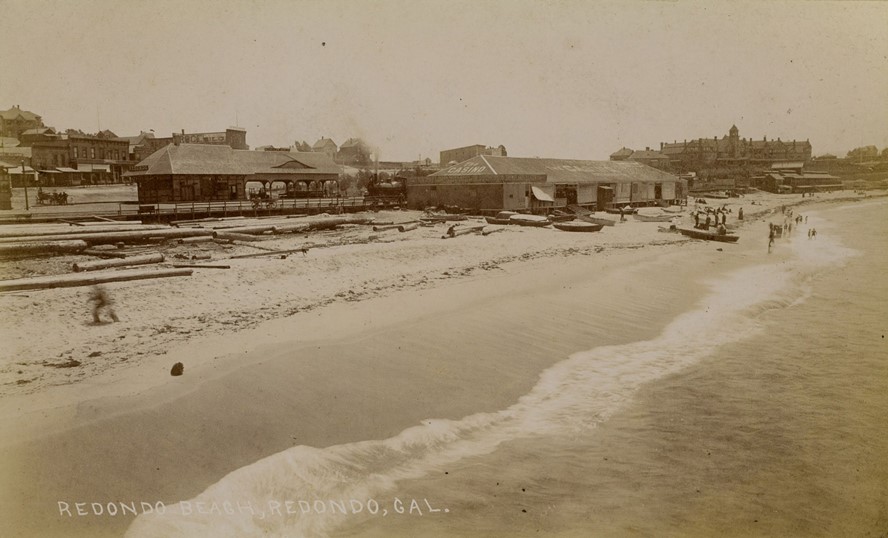 |
|
| (ca. 1896)* - Image of people, boats, and lumber on the beach with the Redondo Beach Hotel (also known as Hotel Redondo), on the hill at right, and a restaurant, boardinghouse, and market on Pacific Avenue in the background in Redondo Beach, California. Signs on the buildings read "Casino" and "John Weilands lager draught." A passenger train depot for the Santa Fe Railway is visible on the beach at right, with a locomotive and signs "Redondo" and "Santa Fe Route." Photo from the Ernest Marquez Collection. |
Historical Notes The transformation of Redondo Beach into a resort and port city began in the late 19th century. In 1889, the Redondo Beach Improvement Company purchased 433 acres of land from the Dominguez family. This land purchase laid the groundwork for the development of the city. In 1890, the Hotel Redondo opened, marking the beginning of Redondo Beach as a tourist destination. The hotel featured luxurious accommodations, an 18-hole golf course, and tennis courts. The city's location and the presence of a deep offshore canyon made it an ideal site for a port, which further boosted its economy. |
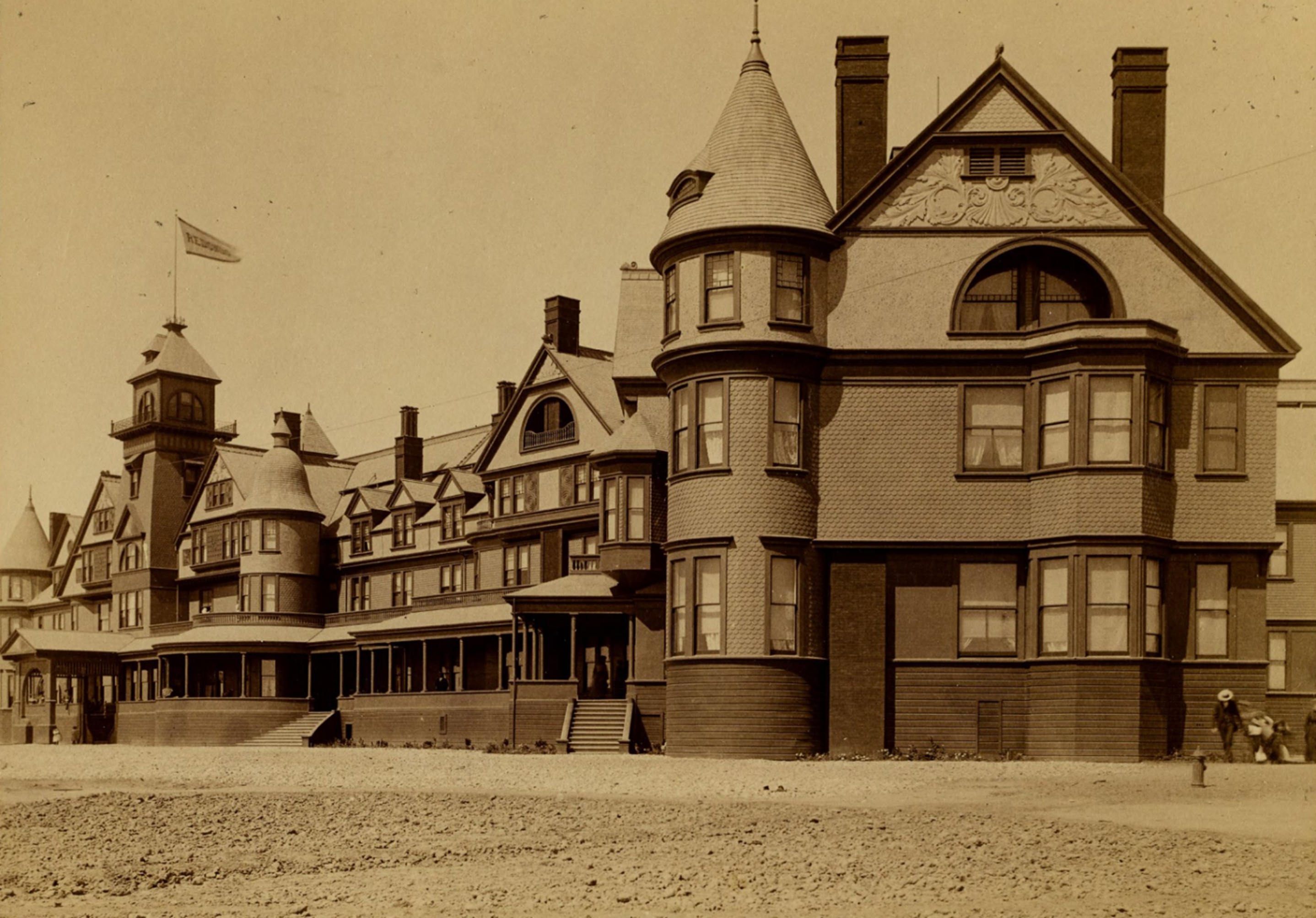 |
|
| (ca. 1890)* – View of the south side of the Redondo Beach Hotel, also known as Hotel Redondo. Photo from the Ernest Marquez Collection. |
Historical Notes The Hotel Redondo, a grand Victorian-style resort, opened in Redondo Beach on May 1, 1890. Situated on a 22-acre tract, it was designed to be a major tourist attraction, featuring 225 luxurious rooms and modern amenities for its time, including a bath on each floor. |
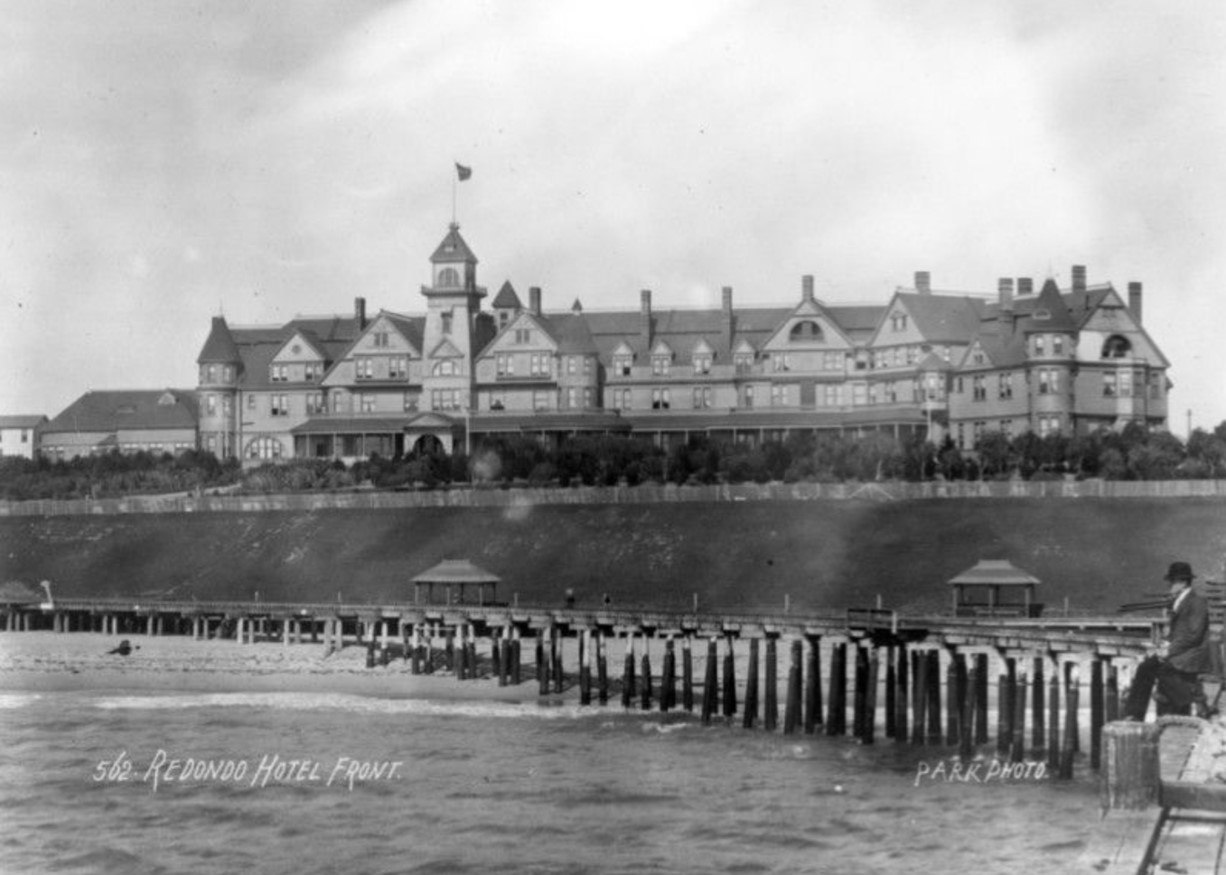 |
|
| (ca. 1890s)* – A man is seen standing on the pier in front of the Redondo Hotel. |
Historical Notes The hotel played a crucial role in establishing Redondo Beach as a premier tourist destination. It was part of a broader effort by developers to promote the area, which included building rail connections and developing the port facilities. The hotel attracted thousands of visitors, contributing significantly to the local economy. Despite its initial success, the hotel's fortunes declined as San Pedro Harbor developed and became the primary port for Los Angeles. The hotel closed in 1925, partly due to the economic impacts of Prohibition, and was sold for scrap lumber. |
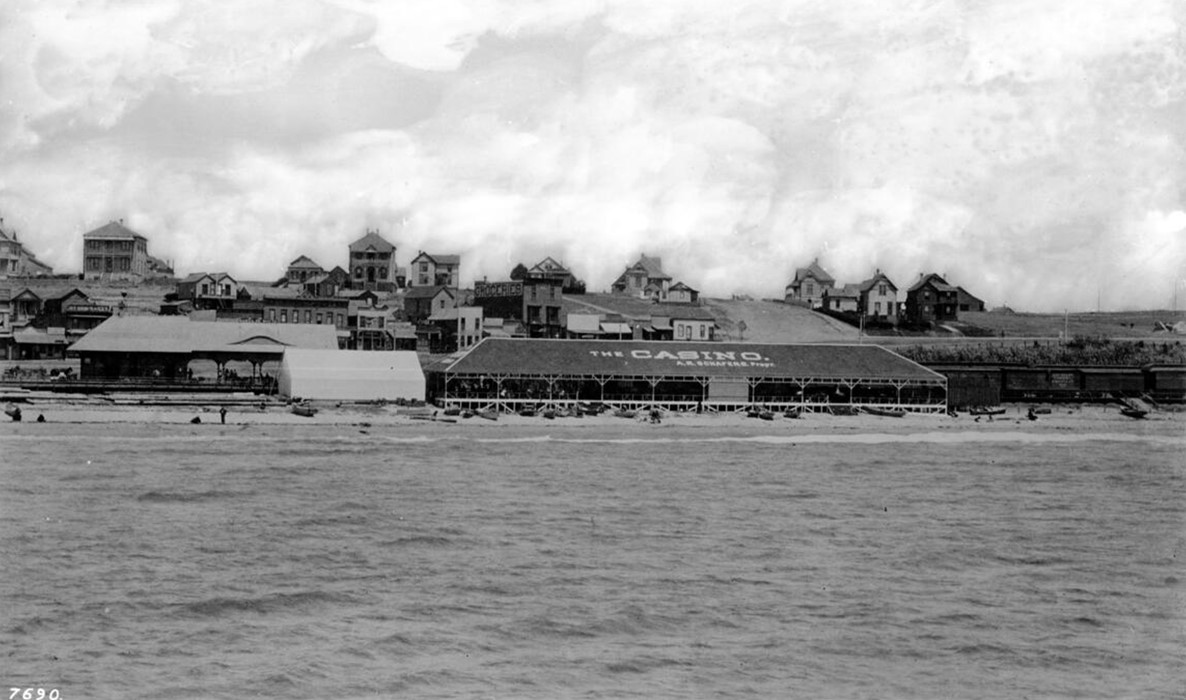 |
|
| (1890s)* - Photograph of Redondo Beach from its first pier, featuring the A.R. Schafers Casino. The ocean surf dominates the foreground, with the shoreline in the distance. The casino, an open-air pavilion, stands prominently at the center with its name displayed on the roof. To the left, a smaller beach pavilion, possibly a train depot, and a tent are visible, with train cars positioned behind to the right. In the background, shopfronts line Pacific Avenue, displaying signs, while the town's predominantly two-story Victorian houses are seen on the hillside. Small canoes rest on the sand in front of the casino. Visible signs include: "Santa Fe Route," "Restaurant," and "Groceries." |
Historical Notes In the early development phase from 1889 to the 1920s, three successive piers played crucial roles in facilitating industry and tourism. Wharf No. 1, constructed in 1889, served as a key point for transferring timber from ships to trains but was eventually destroyed by a storm. In 1895, Wharf No. 2 was built south of the original pier, featuring a Y-shaped design with railroad tracks on one prong. This pier supported fishing and tourism but was severely damaged by a storm in 1919 and later demolished for safety. Wharf No. 3, constructed in 1903 further south, continued to support the lumber industry until 1923. Following the expiration of Pacific Electric’s lease and the decline of the lumber industry, Wharf No. 3 was also demolished. |
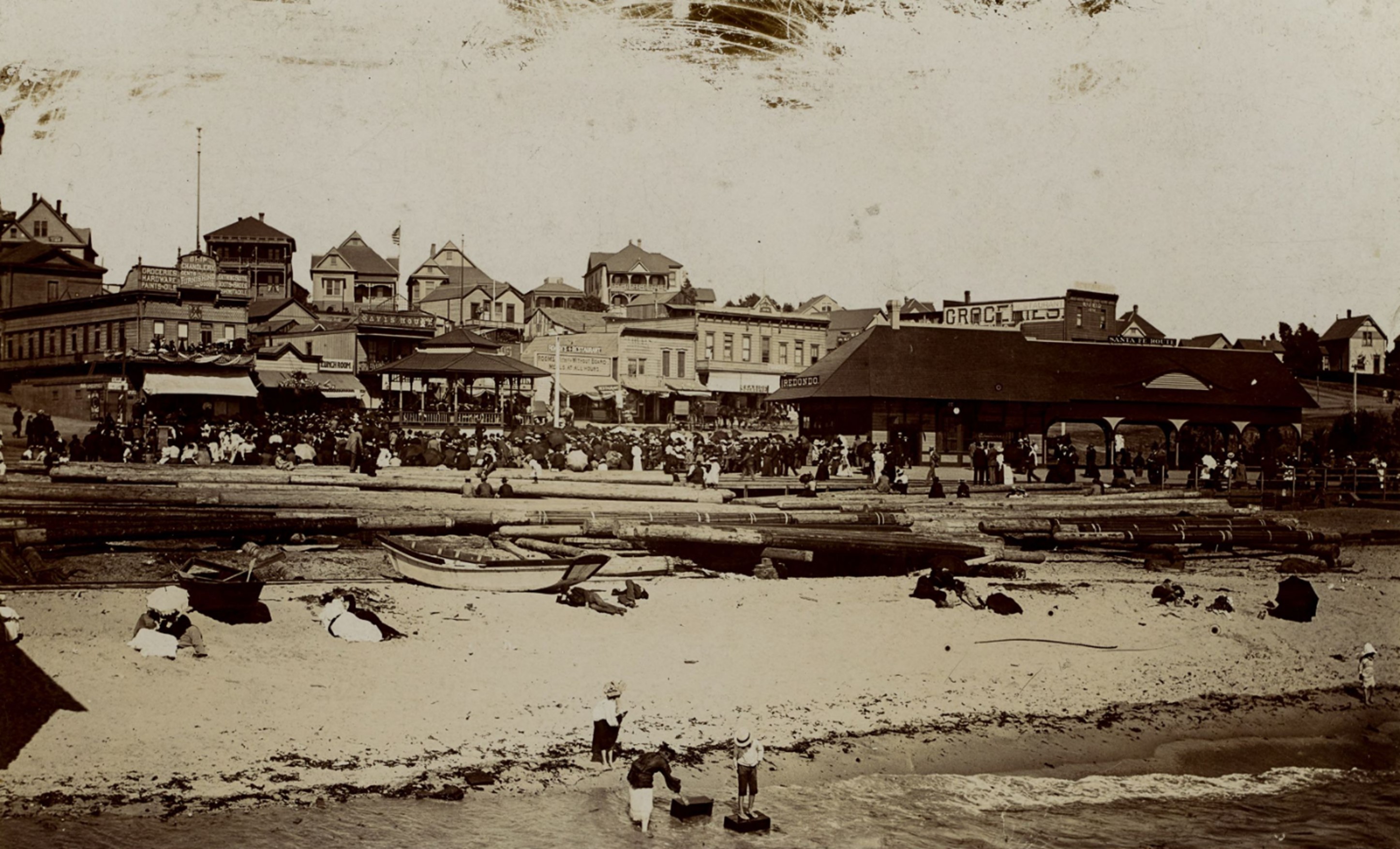 |
|
| (ca. 1890s)* - Image of a crowd of people gathered around a pagoda-style pavilion, with boats, and lumber on the beach and storefronts on Pacific Avenue for restaurants, boardinghouses, houses, and markets in the background in Redondo Beach, California. A passenger train depot for the Santa Fe Railway is visible on the beach at right, with the signs "Redondo" and "Santa Fe Route." Signs on the buildings include "Groceries, hardware, paints and oils, ship chandlery, gents furnishings goods, bathing suits, boots and shoes, fishing tackle," "Lunch Room," "Davis House," "Roach's Restaurant," "Seaside Market," and "W.A. Field." Photo from the Ernest Marquez Collection. |
Historical Notes In the 1910s, Redondo Beach was a bustling hub of activity, known for its vibrant recreational and commercial scene, making it a prominent destination in Southern California. The area’s economy was heavily supported by its multiple wharves, particularly Wharf No. 3, which was constructed in 1903. This pier played a crucial role in the lumber industry and remained operational until 1926, underscoring the importance of the waterfront to the region's economic development. |
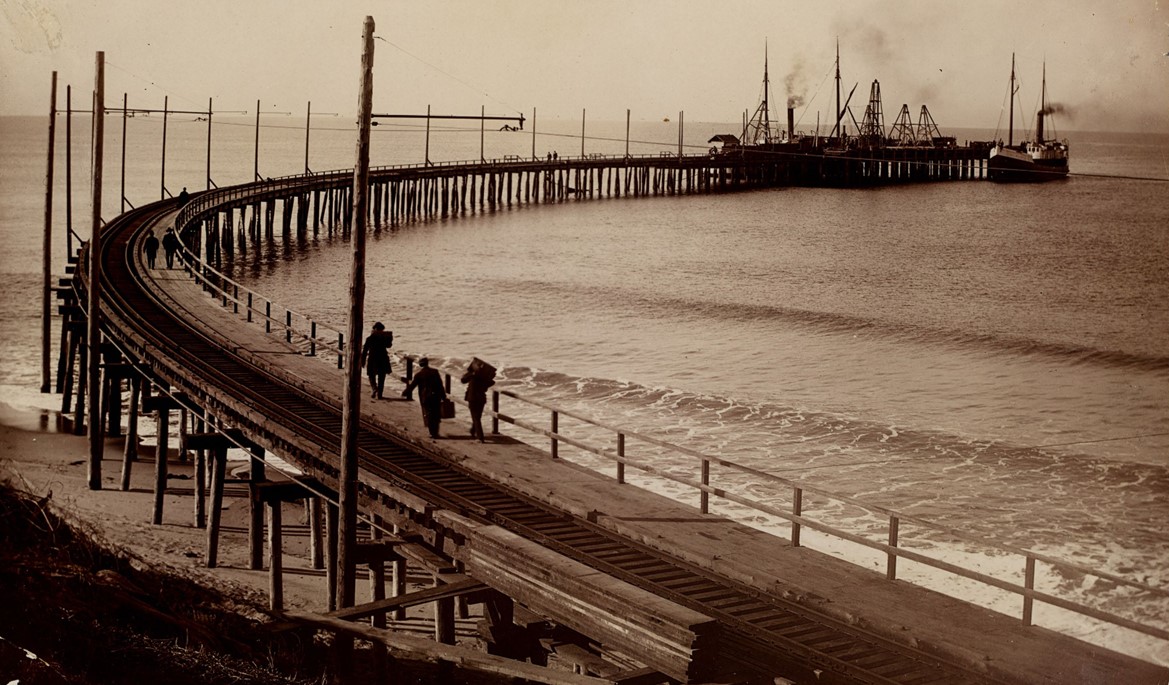 |
|
| (1910)* - Image of Redondo Beach Wharf with people and railroad tracks on the wharf in Redondo Beach. A couple of schooners are seen docked at the end of the pier. Photo from the Ernest Marquez Collection. |
Historical Notes During the late 19th and early 20th centuries, Redondo Beach had significant potential to become a major port, with efforts including the construction of multiple wharves to compete with the San Pedro harbor for freight activity. The presence of the Santa Fe railroad, which provided rail service to the piers, bolstered this ambition. However, several factors hindered Redondo Beach's development into a major port. Natural challenges, such as severe storms, frequently damaged the piers, undermining their reliability for commercial use. Additionally, economic shifts, including the decline of the lumber industry and changes in freight delivery patterns, diminished the commercial viability of the piers. Over time, the focus shifted from commercial to recreational uses, with the development of pleasure piers drawing tourists rather than freight. |
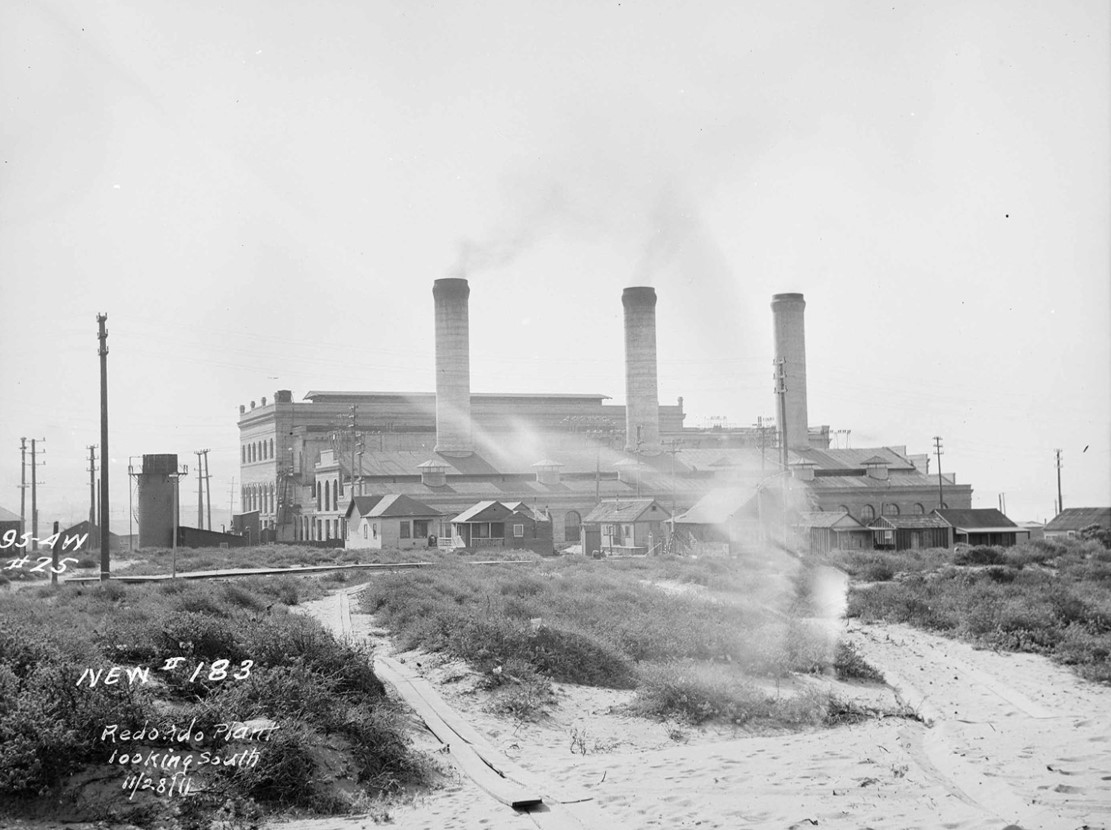 |
|
| (1911)* - Redondo Beach Steam Plant looking South. |
Historical Notes The Pacific Light and Power Corporation (PLPC), established by Henry Huntington in 1906, built a concrete-and-metal steam plant in Redondo Beach, strategically located for its access to clean water and local oil for fuel. This plant was crucial in powering Huntington's electric railway cars and by 1911, had doubled in size, becoming the fourth largest in the United States. However, by 1913, its output was replaced by other plants, and it was relegated to backup status. After Southern California Edison (SCE) acquired PLPC in 1917, the plant fell into disuse and was abandoned during the Great Depression. In response to post-World War II growth, SCE constructed a new generating facility on the site in 1948, which operated until 1987. In 1997, AES Southland Energy acquired the plant, modernizing it to meet contemporary energy needs. However, the facility has faced opposition from residents concerned about pollution, leading to plans to downsize and repurpose the land for non-industrial uses. Throughout its history, the Redondo Beach Steam Plant has evolved from a vital power provider to a facility grappling with environmental and community challenges. |
Pacific Avenue, Redondo Beach
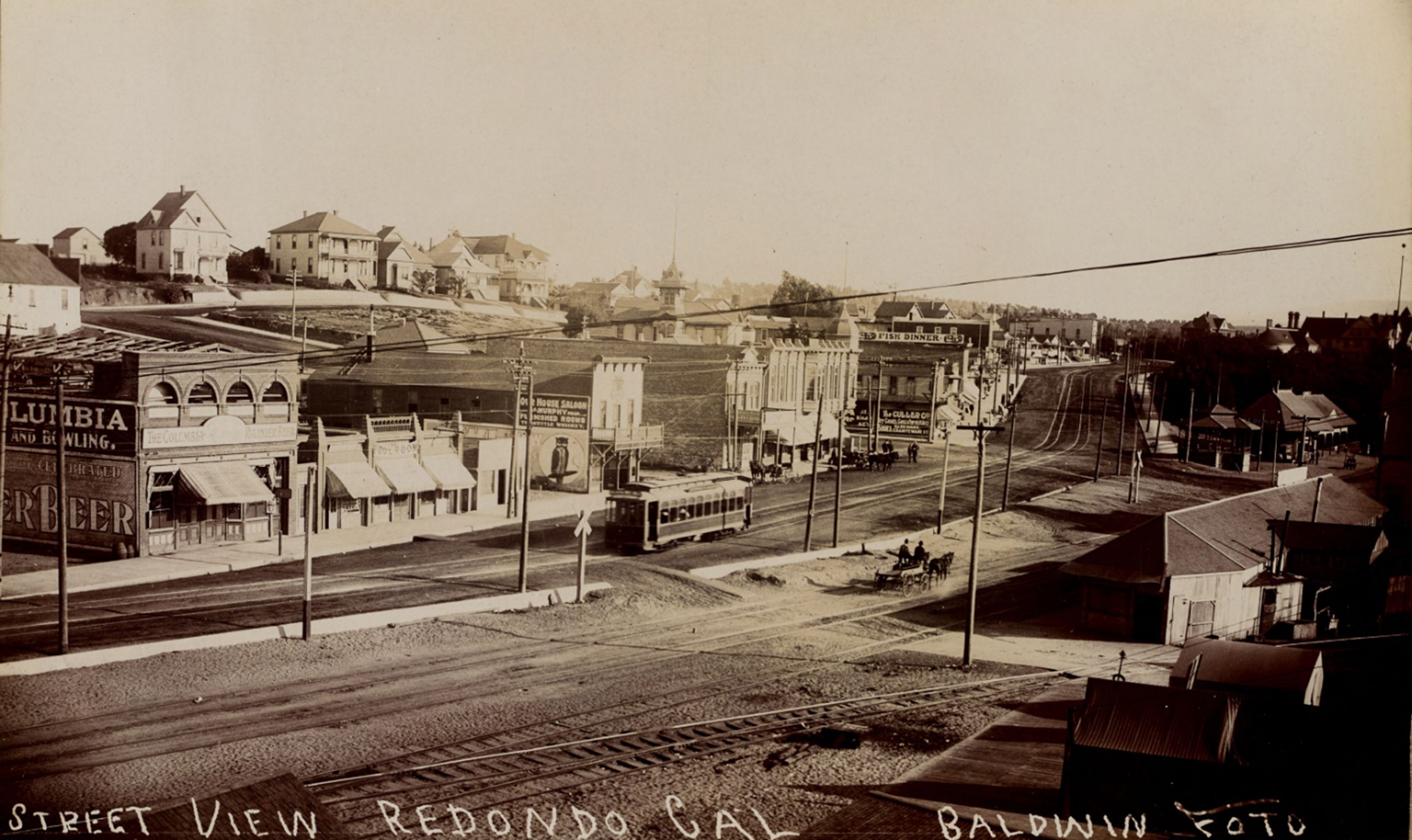 |
|
| (1902)* – Businesses along Pacific Avenue in Redondo Beach, California, are depicted, with a streetcar on tracks and horse-drawn wagons. Visible signs on the buildings include 'The Columbia,' 'Bowling,' 'Rainier Beer,' 'The Pool Room,' 'Our House Saloon, Murphy Prop., Furnished Rooms, Tea Kettle Whiskey,' 'Fish Dinner,' and 'The Culler Co.' A pagoda-style pavilion and a passenger train depot for the Santa Fe Railway are seen at the far right, with houses visible on the hill in the background. Photo from the Ernest Marquez Collection. |
Historical Notes Pacific Avenue in Redondo Beach played a central role in the early development of the city, serving as a bustling commercial thoroughfare during the late 19th and early 20th centuries. Redondo Beach, founded in 1887, quickly grew into a popular seaside resort destination. Pacific Avenue was a key part of the waterfront area, featuring a mix of businesses, hotels, saloons, and recreational facilities catering to visitors and residents alike. The first electric trolley service to Redondo Beach began on November 9, 1902, as part of the Los Angeles-Hermosa Beach & Redondo Railway Company line, soon taken over by the Los Angeles Pacific Railroad. A connecting line between Manhattan Beach and Redondo Beach was built in 1903. In 1911, the Pacific Electric Railway acquired the route, integrating it into its expansive system. |
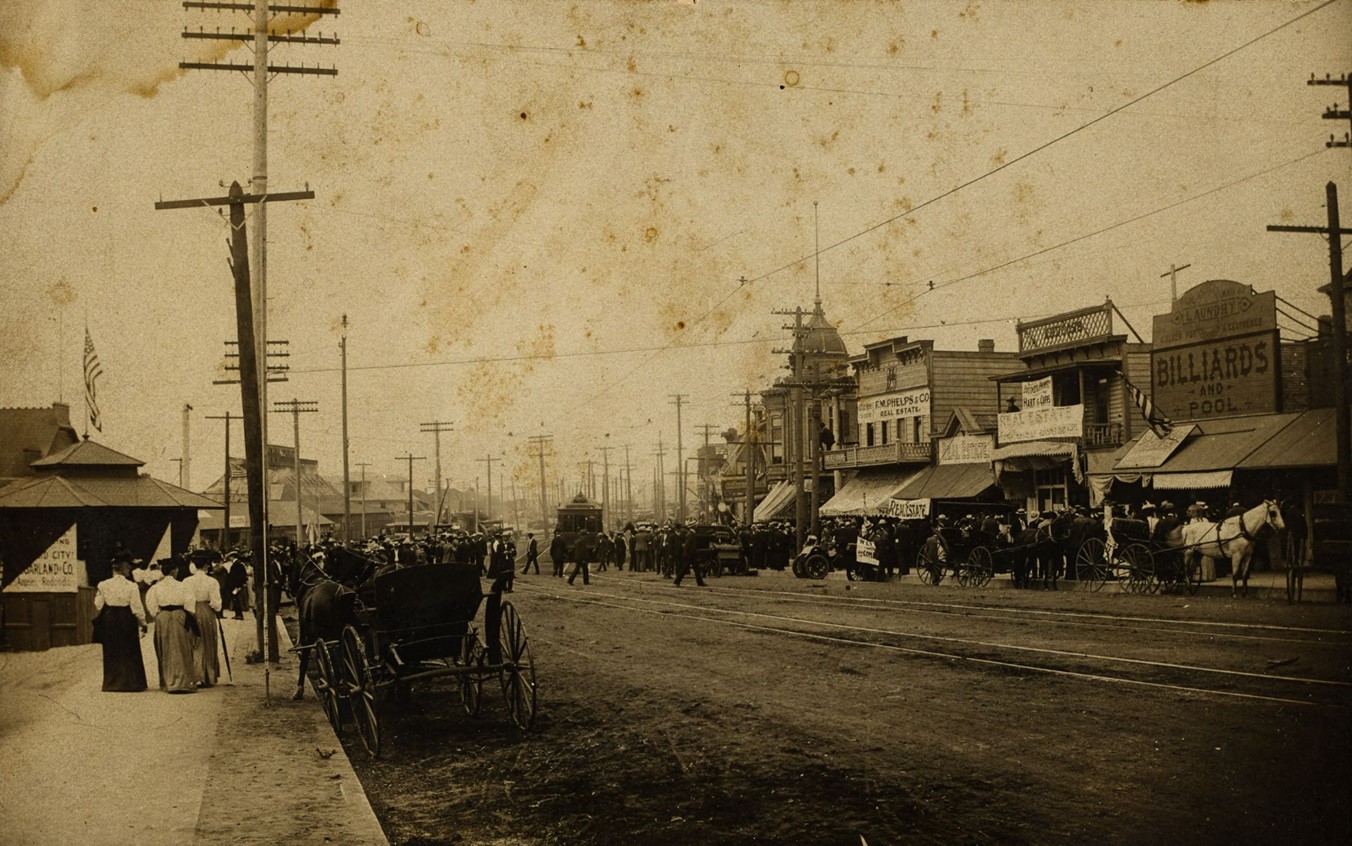 |
|
| (ca. 1905)* - Looking north on Pacific Avenue in Redondo Beach, with an electric street car, horse-drawn wagons, and crowds of people in front of a real estate office. Signs on the storefronts read "Garland & Co.," "F.M. Phelps & Co. Real Estate," "Business Property Hart & Copps," "Billiards and Pool," and "Laundry." Photo from the Ernest Marquez Collection. |
Historical Notes In the early 1900s, the street was lined with attractions like The Columbia Hotel, bowling alleys, saloons, and dining establishments. The Redondo Beach streetcar line ran along Pacific Avenue, making it easily accessible for tourists coming from Los Angeles and surrounding areas. The street was also home to the Redondo Beach Pavilion and the Santa Fe Railway Depot, both important for the city’s connection to regional transportation and its development as a tourist hub. |
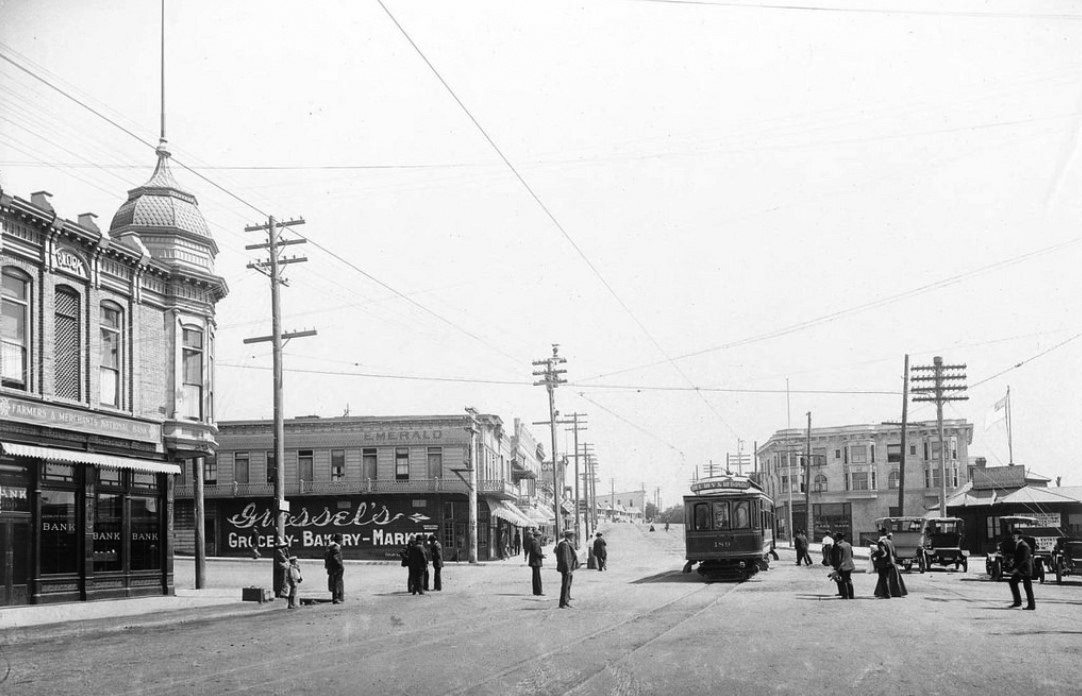 |
|
| (1915)* – View looking south on Pacific Avenue in Redondo Beach showing a streetcar at right with the Garland Hotel in the background behind it. |
Historical Notes In the early 1900s, Pacific Drive in Redondo Beach played a crucial role in the city's development as a transportation and commercial hub. The street was a key artery, featuring a streetcar line that was part of the extensive Pacific Electric Railway system, known as the "Red Cars," connecting various parts of Los Angeles County. By 1915, these streetcars brought both residents and visitors to the beach, making Pacific Drive an important gateway to the area. Alongside its transportation significance, Pacific Drive also saw commercial growth, exemplified by the presence of the Garland Hotel, a prominent landmark in 1915. The hotel's location on Pacific Drive underscored the street's appeal for tourists, due to its proximity to both the beach and efficient transportation links. The building on the N.E corner of Pacific and Emerald, on the left, was called the "English Block," built in 1893 and torn down for condos in the early 1970s. |
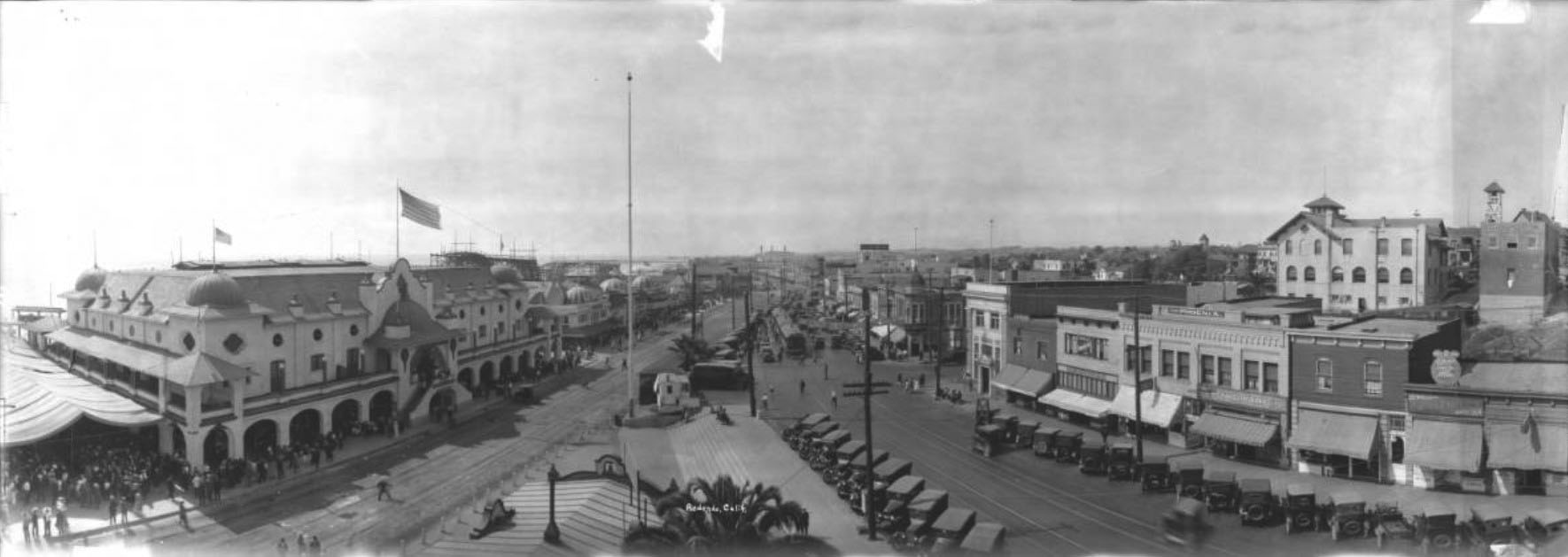 |
|
| (1923)*- Panoramic view of Redondo Beach as seen from the Garland Hotel. |
Historical Notes By the 1910s and 1920s, Redondo Beach experienced continued growth, but with the development of nearby cities like Manhattan Beach and Hermosa Beach, its role as the dominant coastal resort began to shift. During this time, the original charm of Pacific Avenue persisted as an important local artery, with many businesses remaining in operation. |
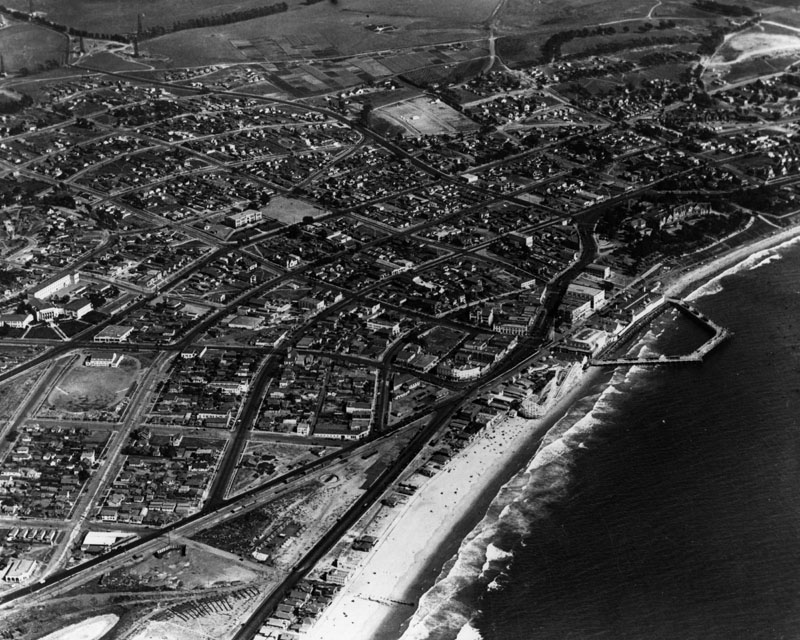 |
|
| (1924)^ - Aerial view of Redondo Beach showing its 'pleasure pier'. |
Historical Notes Between 1916 and 1928, Redondo Beach saw a shift from industrial wharves to pleasure piers, beginning with the Endless/Pleasure Pier, a V-shaped reinforced concrete structure built by George W. Harding for fishing and strolling. Despite its initial popularity, it was condemned for safety reasons in 1928. Captain Hans C. Monstad constructed the Monstad Pier in 1925, originally 300 feet long, which served as a hub for fishing and pleasure boat landings and remains in use today. The Horseshoe Pier, built in 1929 after the Endless/Pleasure Pier was demolished, became a central community feature until it was destroyed by fire in 1988. Following the fire, the pier's southern remnant remained open until a new concrete pier was constructed and opened in 1995, though only a new restaurant was added among the planned attractions. |
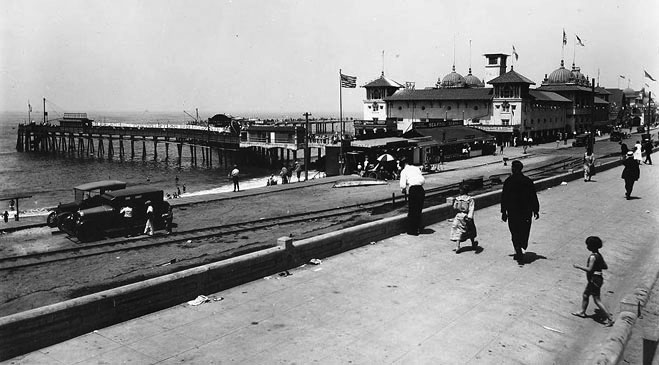 |
|
| (ca. 1925)* - View of Redondo Beach's "Endless Pier" as it appeared by the shoreline. |
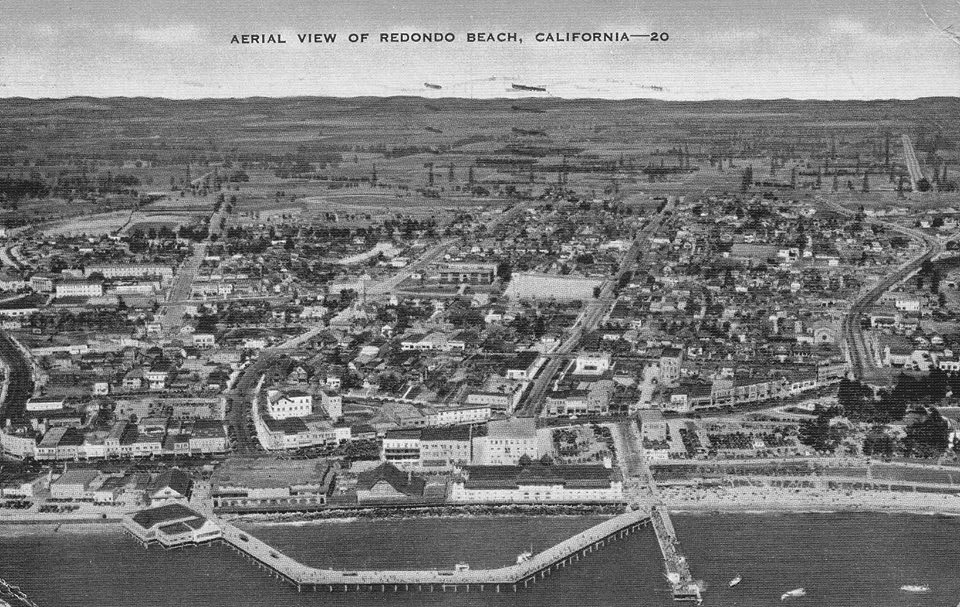 |
|
| (ca. 1920s)* - Aerial postcard view of Redondo Beach and the "Endless Pier". Note the oil field in the distance. |
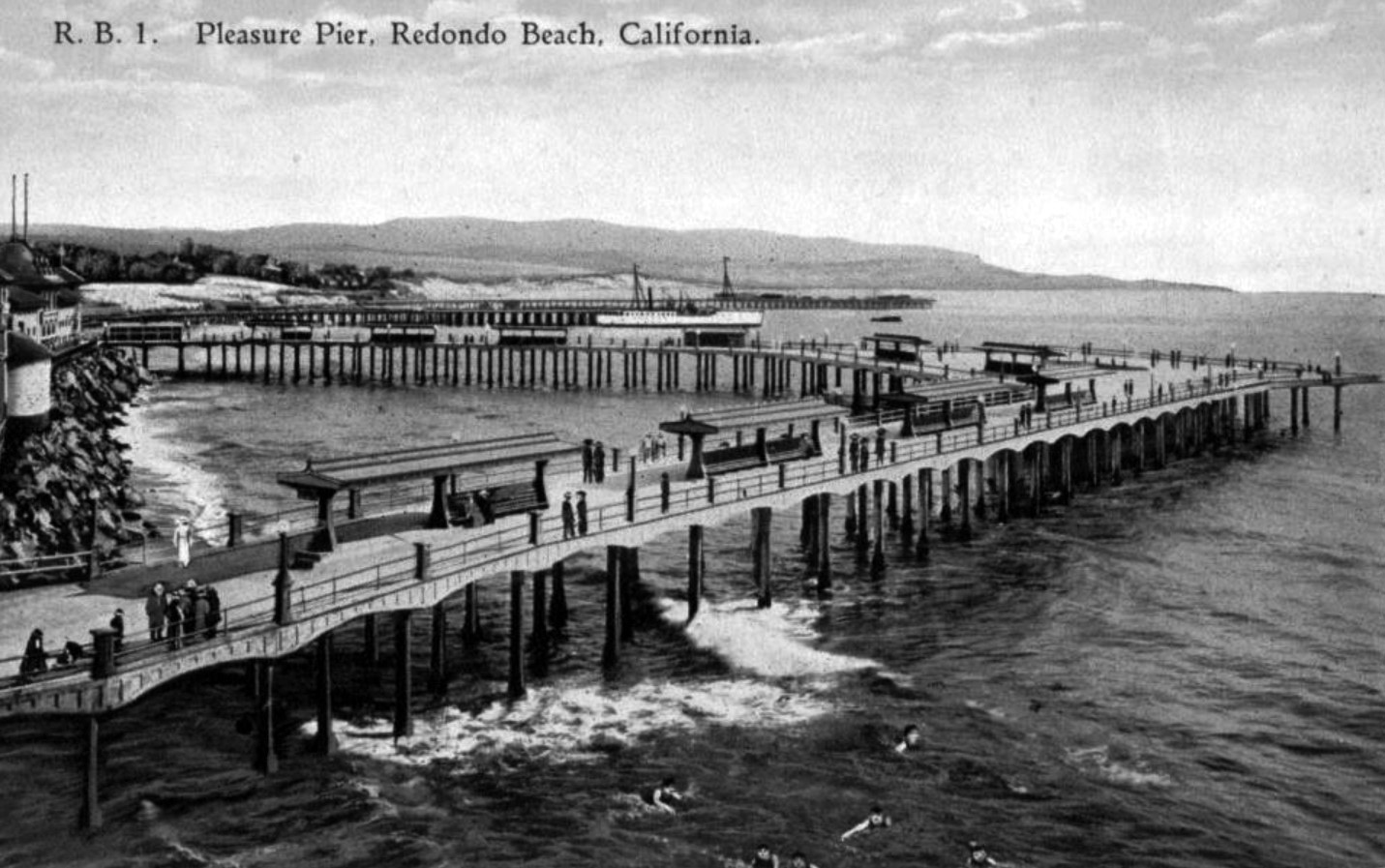 |
|
| (ca. 1920s)* – Postcard view looking south along the coast of Redondo Beach, people can be seen walking along the Endless/Pleasure Pier and swimming in the surf below. The Pavilion, Bath House, and Wharfs No. 2 and 3 can also be seen in the photo. |
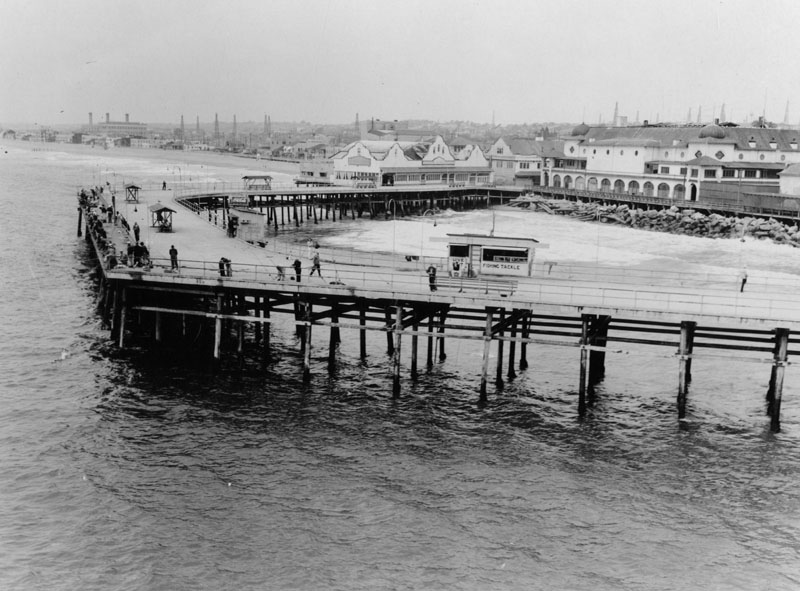 |
|
| (1937)^ - View of the main pier at Redondo Beach on May 27, 1937. Oil derricks can be seen in the background. |
Historical Notes The pier started out as a disjointed group of wharves near the end of the 19th century, but evolved into an interconnected structure after a series of storms and demolitions throughout the 20th century. |
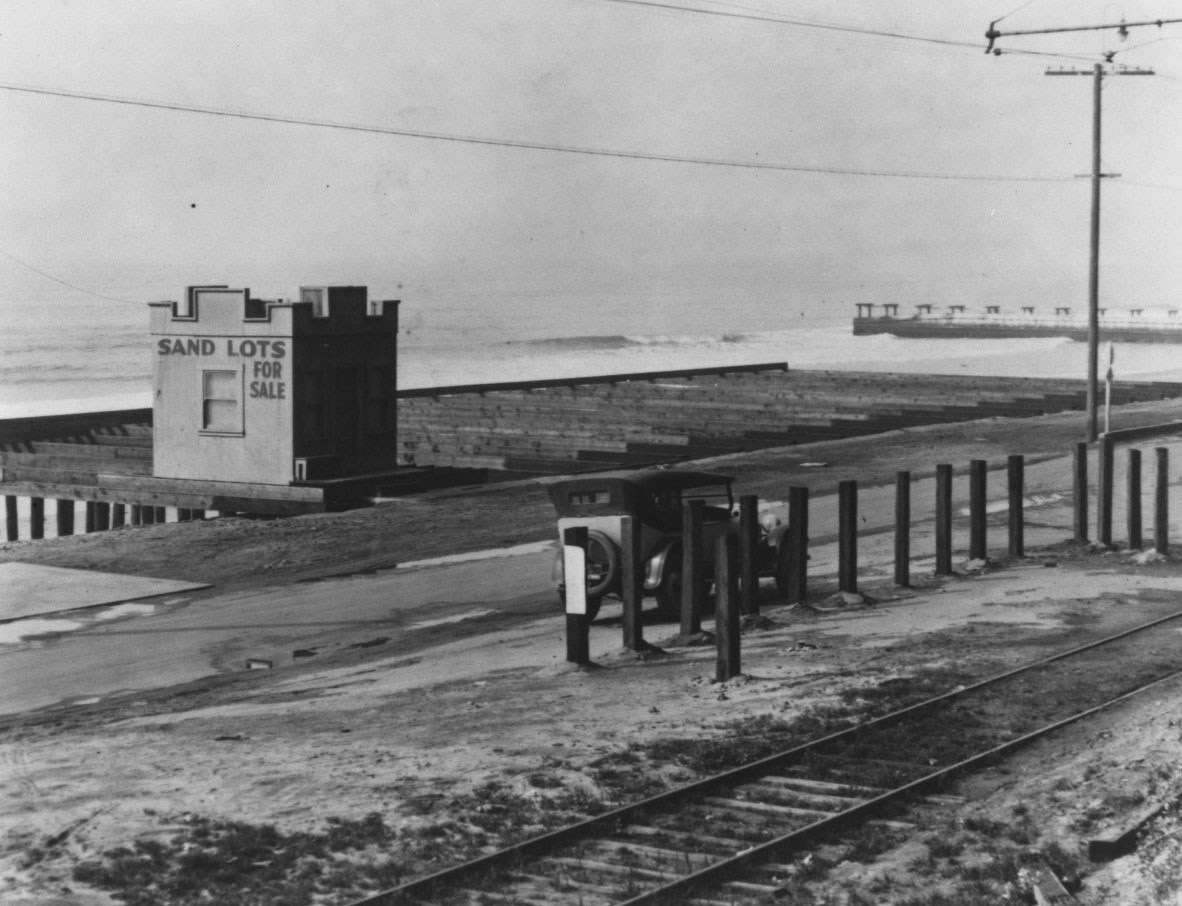 |
|
| (1930s)* – ‘Sand Lots for Sale’ painted on the side of a Real Estate Office in Redondo Beach. Note the tracks in the foreground. |
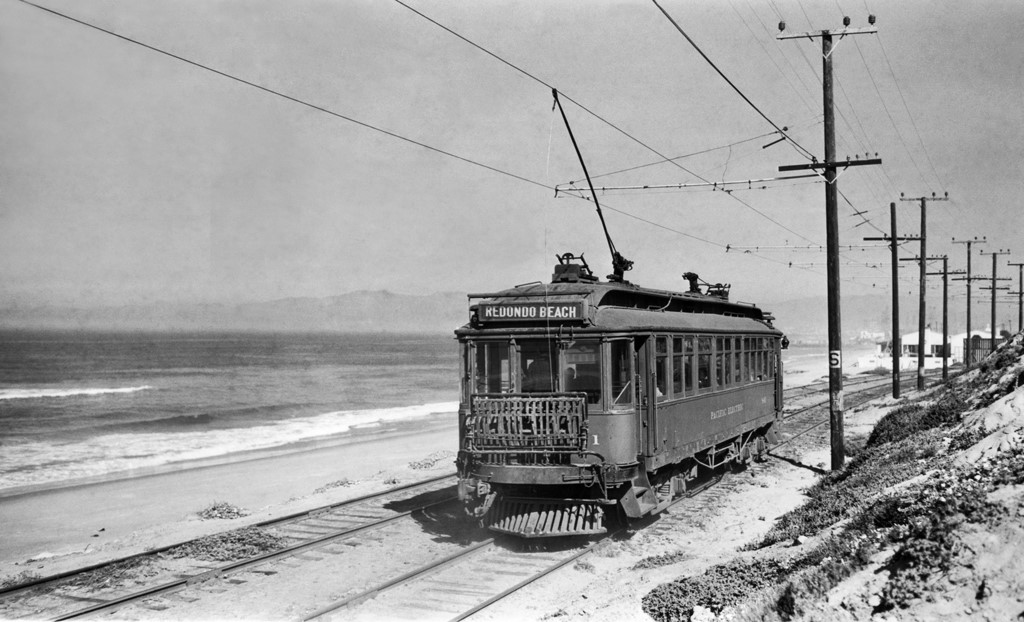 |
|
| (ca 1930s)* - Redondo Beach trolley. Photo: Pacific Electric Railway Historical Society |
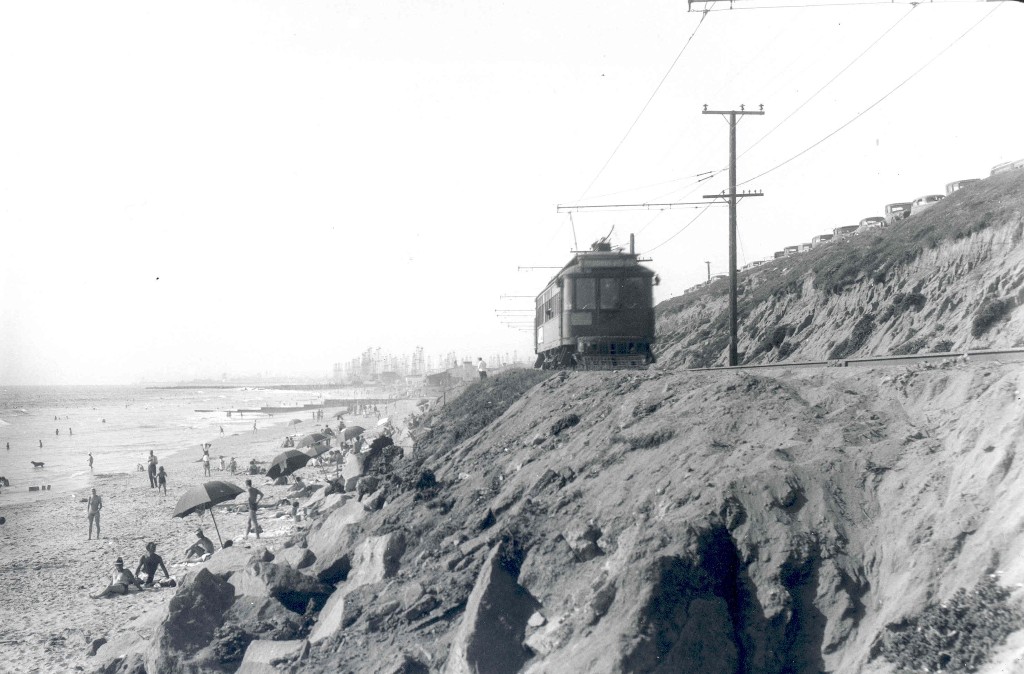 |
|
| (1939)* - The Redondo Beach via Del Rey streetcar is making its way up the grade. Sun bathers are seen enjoying a sunny day on the beach, their cars parked at the top of the bluff. Oil derricks are seen in the far distance. |
* * * * * |
Hollywood Riviera Beach Club
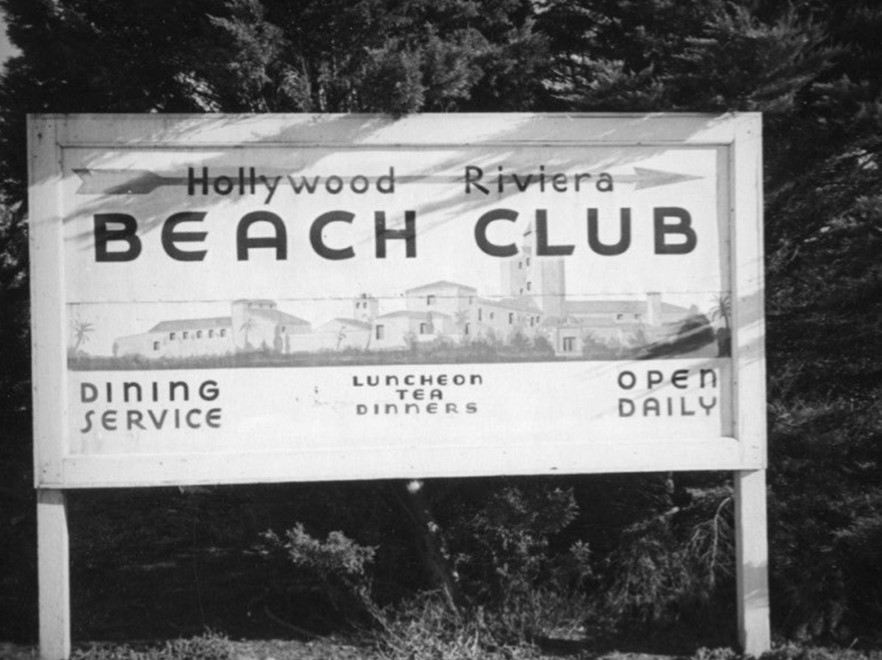 |
|
| (ca. 1937)* - Sign for the Hollywood Riviera Beach Club which features an architectural rendering and indicates that the originally private club was open for lunch and diner every day. |
Historical Notes The Hollywood Riviera Beach Club (1931-1958), designed by Mark Daniels, was located at what is now Miramar Park in Torrance Beach. It was designed as a private club for the original Riviera home owners. The beach club was destroyed by fire and the site was recognized as a Historic Landmark with a plaque by the Torrance Historical Society in conjunction with the Redondo Beach Historical Society. |
 |
|
| (1930s)^ – View looking north from Palos Verdes toward Redondo Beach. At lower-left can be seen the Hollywood Riviera Beach Club which straddled the city limit between Torrance and Redondo Beach. |
Historical Notes Ground had been broken for the private Hollywood Riviera Beach Club on March 4, 1930. Clifford Reid, the developer who envisioned the Hollywood Riviera section of Torrance as a potential playground for the Hollywood elite when he began selling lots there for about $3500 each in 1928, saw the club as a central attraction whose glamorous image would lure homebuyers in to buy lots. It opened on June 27, 1931. Residents of the Hollywood Riviera development automatically became members of the club, though dues were required to use the pool and to attend special events held there. Reid’s plan to attract movie stars foundered on two shoals: the advent of the Depression, and the development’s anti-Semitic policies, which prohibited Hollywood elites such as Louis B. Mayer and Sam Goldwyn from owning property there. But the development’s spectacular location still attracted visits from the rich and famous, though only the late actress Rosemary DeCamp actually became a long-term resident there.* |
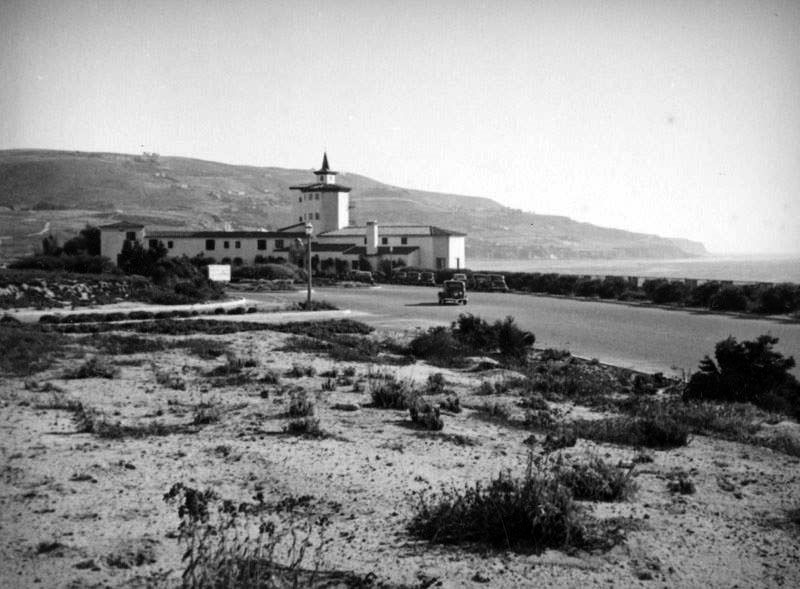 |
|
| (1930s)^ – View looking south showing the Hollywood Riviera Beach Club with the Palos Verdes Peninsula seen in the distance. Photo by Herman Schultheis |
Historical Notes Not long after Pearl Harbor, the military installed anti-aircraft guns in the hills by Torrance beach. The pounding of the ensuing target practice structurally damaged the club, which closed in 1942. It reopened after the war after Reid sold it, and its new owners made it a public club open to all. It had a successful run during the 1950s, though its image became decidedly less elegant and took on more of the atmosphere of a roadhouse than a swanky club. Since the club straddled the city limit between Torrance and Redondo Beach, the story has been told that imbibers would have to cross from one side of the tavern to the other to stay in compliance with each city’s liquor laws.* |
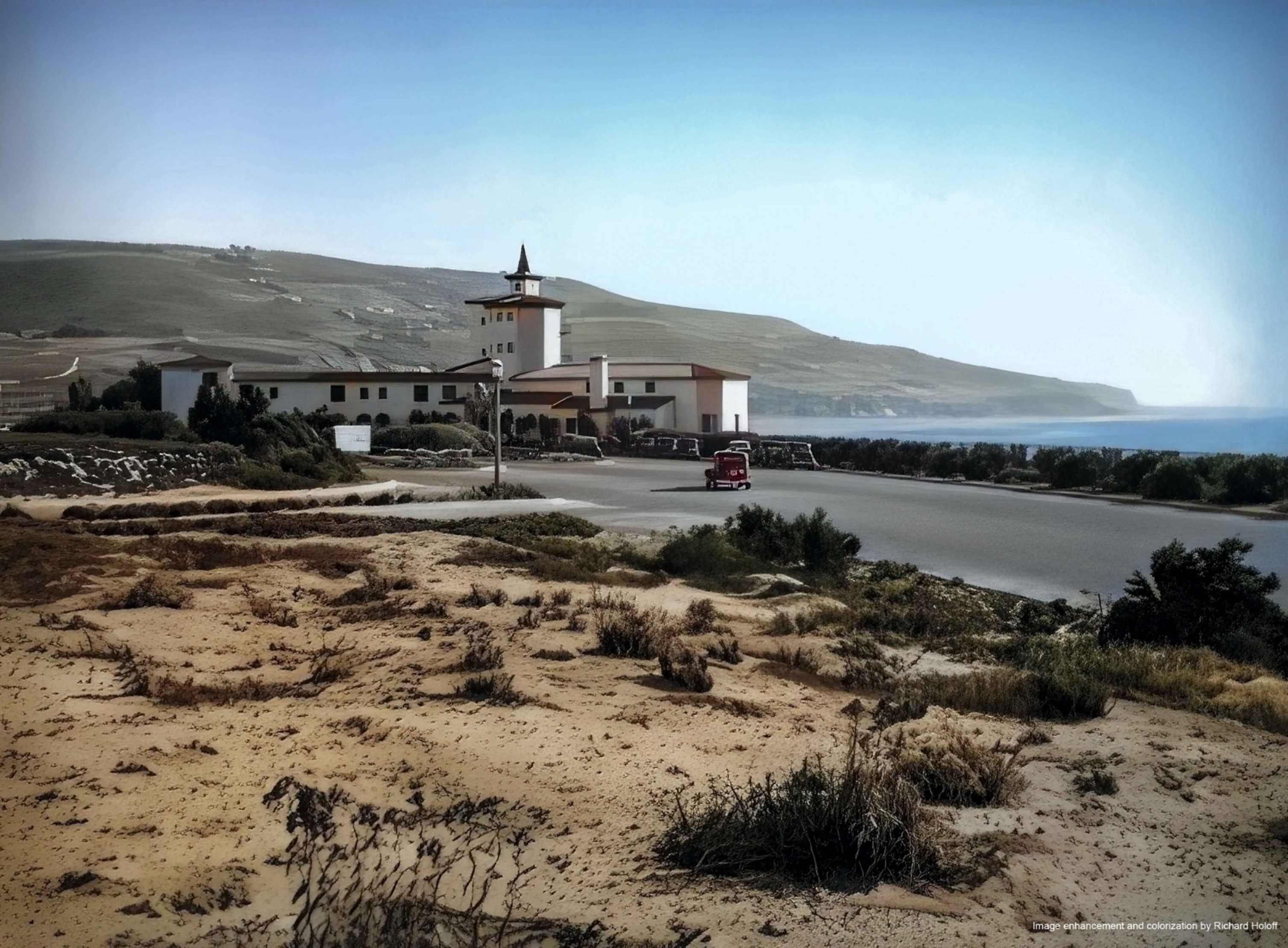 |
|
| (1930s)^ – View looking south showing the Hollywood Riviera Beach Club with the Palos Verdes Peninsula seen in the distance. Photo by Herman Schultheis; Image enhancement and colorization by Richard Holoff. |
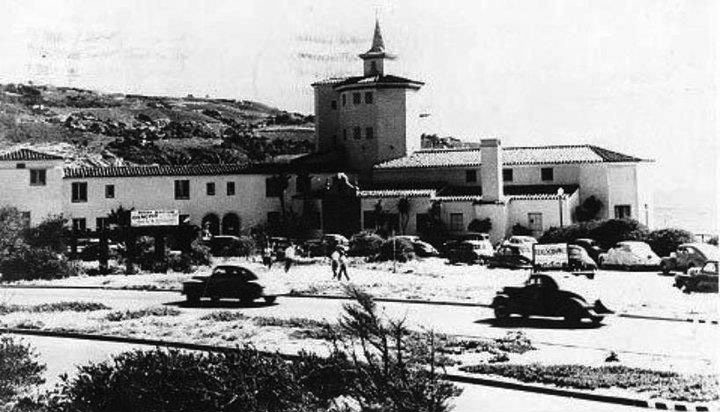 |
|
| (1940s)^ – Postcard view looking at the Hollywood Riviera Beach Club with Palos Verdes in the background. Writing on the postcard bottom (not seen) reads: “Riviera Beach Club, one of California’s most beautiful seaside resorts – REDONDO BEACH, CALIFORNIA” |
Historical Notes On the night September 25, 1958 a spectacular fire consumed the seaside resort. The club was a total loss. For years afterward, plans were made to re-develop the site. Even before the fire, Torrance and Redondo were trying to formulate plans to buy the club and convert it into a teen recreation center, but they had been unable to sort out the site’s tangled ownership situation. As early as 1964, the Sovereign Development Co. had proposed a plan to build a 16-story apartment complex on the site. That proposal was defeated in Aug. 1964, but similar attempts and proposals would be made throughout the rest of the 1960s, all of them opposed by Hollywood Riviera residents. In 1972 a Superior Court ruled that the property had been “dedicated by implication” to the public, and the property’s then-owner, Oscar Berk, could not build upon the property that he had purchased for $600,000. That ruling eventually led to the development of Miramar Park on the site. The small, beautiful park was dedicated by the City of Torrance on January 11, 1984. Surfers still refer to the section of Torrance beach below where the Hollywood Riviera Beach Club once stood as “Burnout Beach.” * |
* * * * * |
Palos Verdes Peninsula
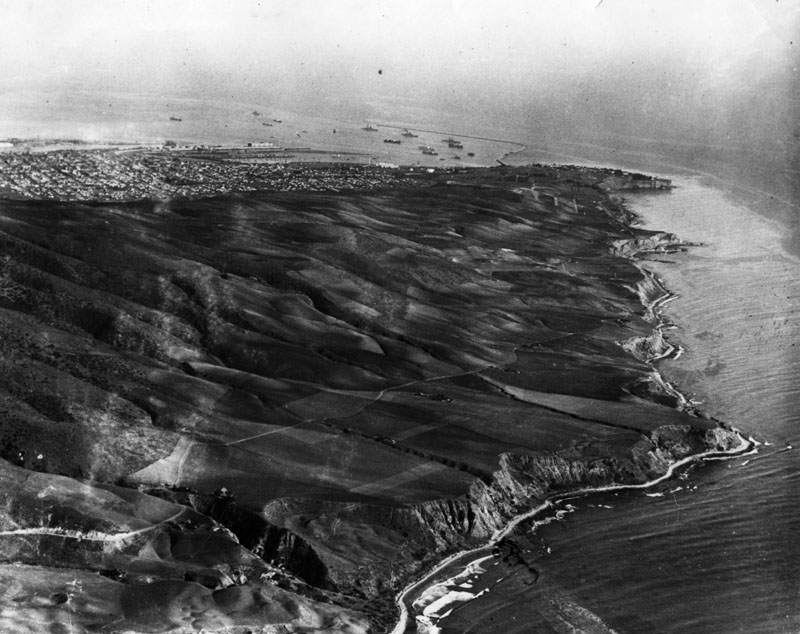 |
|
| (1924)^ - Aerial view of the Palos Verdes Peninsula, looking southeast towards Point Fermin. San Pedro Harbor can be seen in the background. |
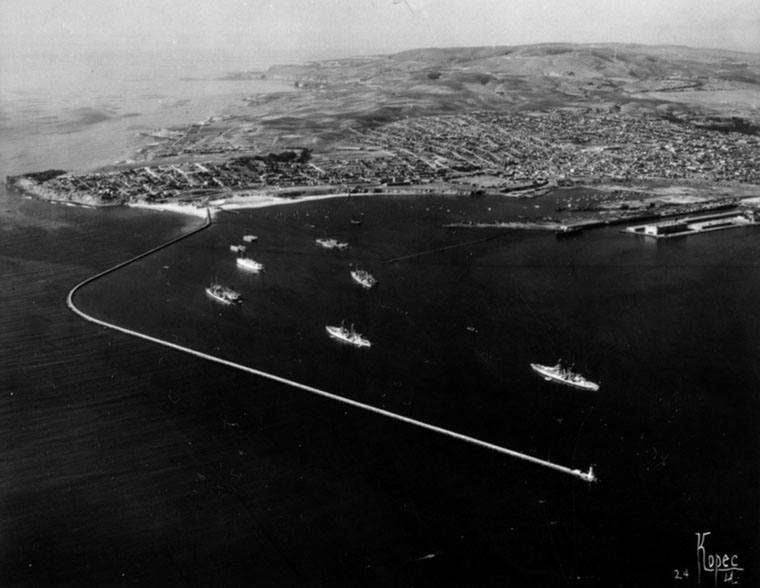 |
|
| (ca. 1924)^ - Aerial view of Point Fermin, Palos Verdes and hills, government breakwaters and the outer harbor. Ships can be seen in the harbor. |
* * * * * |
San Pedro Harbor (LA Harbor)
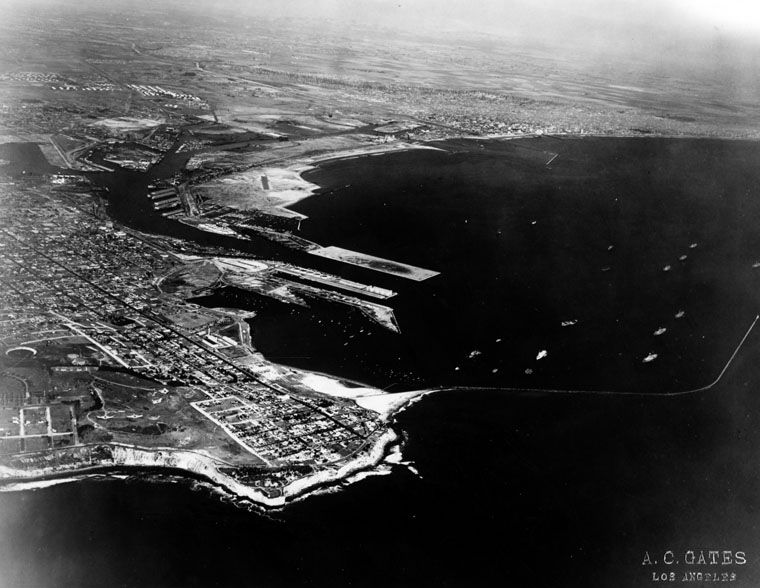 |
|
| (1929)^ - Aerial view of San Pedro, the LA Harbor, and the coastline. |
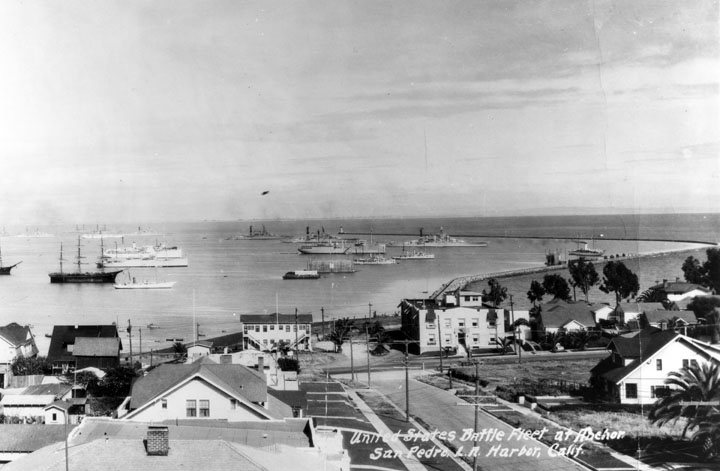 |
|
| (1926)^ - Panoramic photo of San Pedro Harbor in 1926. The United States Battle Fleet is anchored in the harbor. |
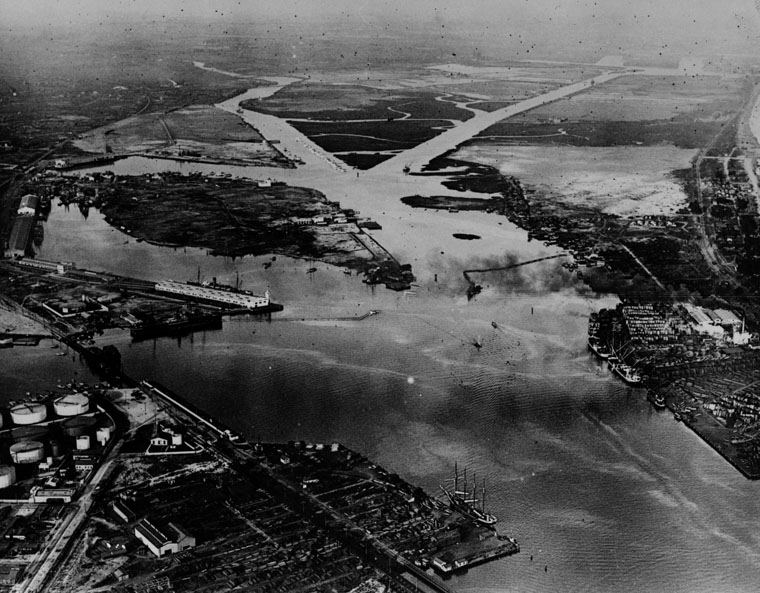 |
|
| (1921)^ - Aerial view of San Pedro Harbor in 1921. The port continued to expand and would become the busiest seaport on the west coast. |
Historical Notes During the 1920s, the Los Angeles Port passed San Francisco as the west coast's busiest seaport. In the early 1930s a massive expansion of the port was taken with the construction of a massive breakwater three miles out that was over 2 miles in length. In addition to the construction of this outer breakwater an inner breakwater was built off of Terminal Island with docks for sea going ships and smaller docks built at Long Beach.*^ |
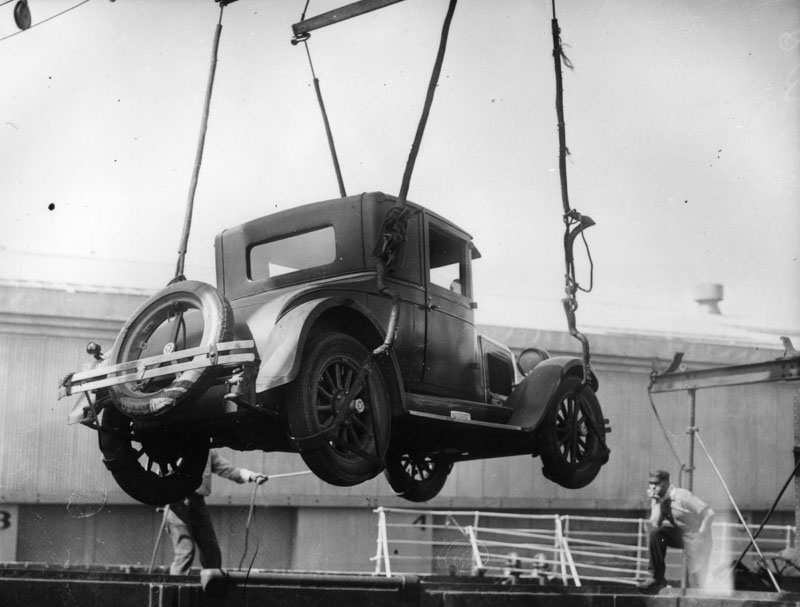 |
|
| (ca. 1920)^*^* - An early model auto is being loaded onto a ship in the San Pedro Harbor. |
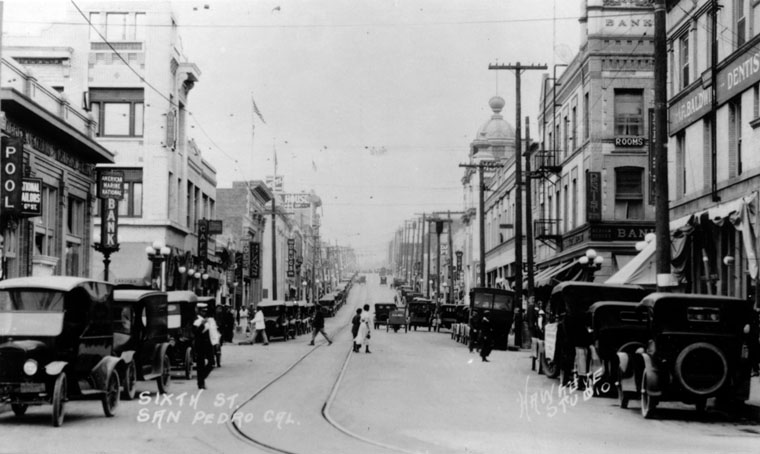 |
|
| (ca. 1920)^ - Scenic view of 6th Street in San Pedro. This street is a busy area with many retail stores on both sides of the street. There are two banks, two pool halls, a cafe, shoe store, drug store, a dentist, and even rooms for rent. Automobiles can be seen parked up and down the street. |
Click HERE to see more in Early Views of San Pedro and Wilmington |
* * * * * |
Long Beach
 |
|
| (ca. 1924)^^ – View looking south on American Avenue (later Long Beach Boulevard) in Long Beach. To the right, traffic seems to be backed-up while a bus in the distance makes a turn in front of a nearby highrise building. At left, the road appears to be relatively free, one lane of traffic moving by the parked cars at left and the streetcar tracks at center. A number of commerical buildings with canopy-shaded windows can be seen to either side, lining the blocks. |
Historical Notes The City of Long Beach was officially incorporated in 1897. The town grew as a seaside resort with light agricultural uses. Gradually the oil industry, Navy shipyard and facilities and port became the mainstays of the city. In the 1950s it was referred to as "Iowa by the sea", due to a large influx of people from that and other Midwestern states. Huge picnics for migrants from each state were a popular annual event in Long Beach until the 1960s.* |
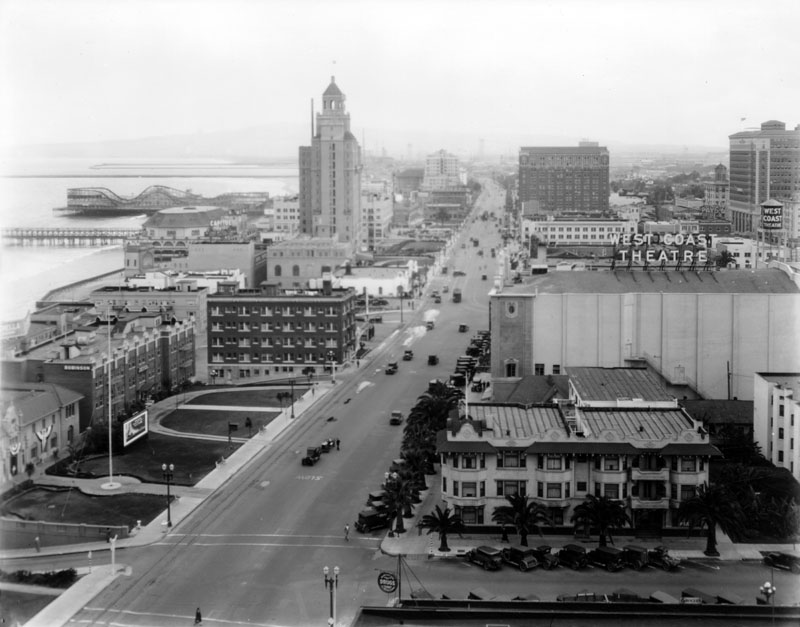 |
|
| (ca. 1920s)^ - Ocean Boulevard winds its way north following the shore in this aerial view of Long Beach. It passes the Municipal Auditorium at the end of Pine Avenue by the pier and The Pike amusement park just north of the auditorium. The roller coaster at the amusement park is on a pier that juts out into the ocean. |
Historical Notes The tall building topped by a cupola on the beach side of Ocean Boulevard is the Breakers Hotel. In front of and between the auditorium and the Breakers is the Capitol Theatre. The sign for the West Coast Theatre at 333 East Ocean Boulevard is visible on the facade of the large building, right. A sign for the theater is also on the water tower at the back. Several cars are parked at the front of the theater. The Robinson Hotel Apartments with its circular driveway is opposite the West Coast Theatre.^ |
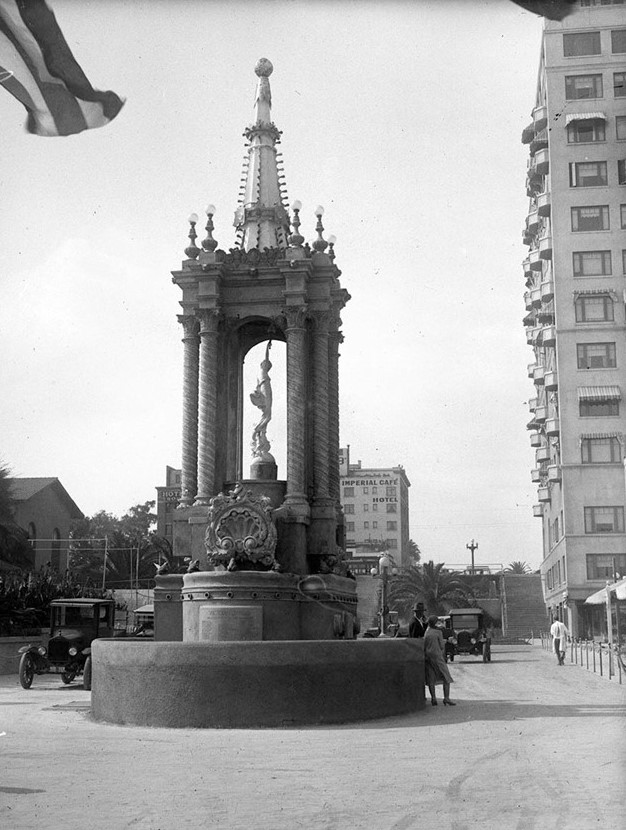 |
|
| (1926)* - The Victory Fountain was a new addition to the north end of the Pike at Chestnut Place in September 1926 in remembrance of World War I veterans. |
Historical Notes Designed by Edwardes Sproat, the Victory Fountain stood 45-ft. high and was equipped with electric lights that flashed in time to the water’s spray. At the top was a mirrored ball that reflected the lights at night. |
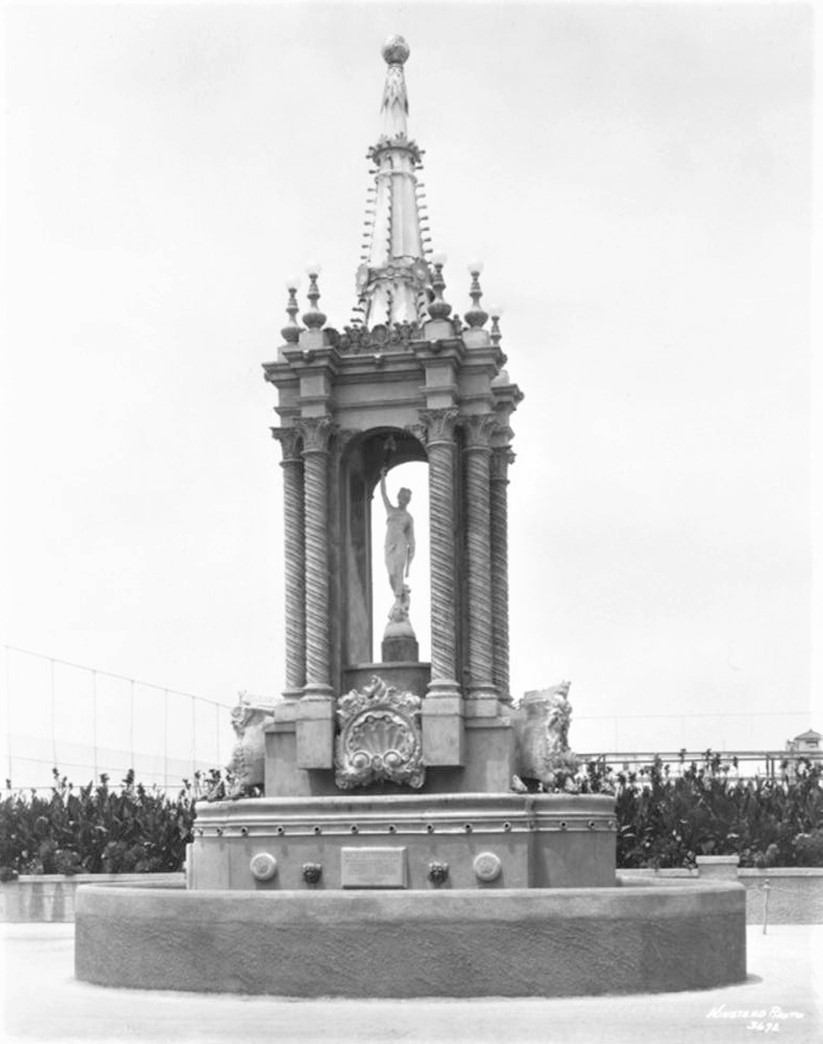 |
|
| (1926)* - Close-up view showing the Victory Fountain, located at the intersection of Chestnut Place near the "Walk of a Thousand Lights" attraction at The Pike in Long Beach. |
Historical Notes Designed by Edwardes Sproat and built by cement contractor S. W. Black, the fountain was dedicated to the American Legion in memory of those who fought in World War I. Financed by homeowners from West Long Beach, the 45 foot high memorial includes flasher lights of many colors and various sprays and cascades for water. A basement directly beneath the fountain included a 600 gallon storage tank and pumps. |
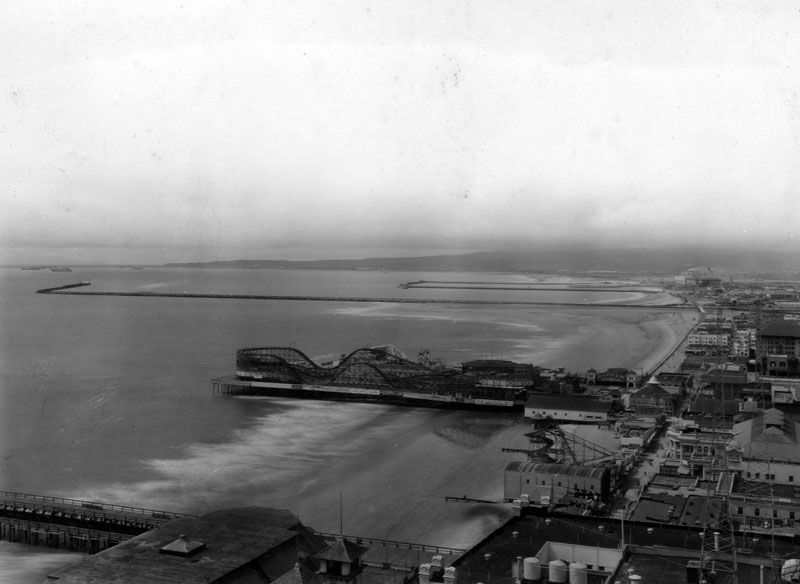 |
|
| (ca. 1920s)^ - The Pike and Pleasure Pier, center, jut out into the ocean from the shore. The ornate bathhouse with its portico sits in the midway. Advertisements for the various attractions at The Pike are on the side of the pier underneath the roller coaster. Portions of the Virginia Hotel and its tennis courts are just beyond The Pike and breakwaters and ocean vessels are on the horizon. |
Historical Notes The Pike was the most famous beachside amusement zone on the West Coast from 1902 until 1969; it offered bathers food, games and rides, such at the Sky Wheel dual Ferris wheel and Cyclone Racer roller coaster. |
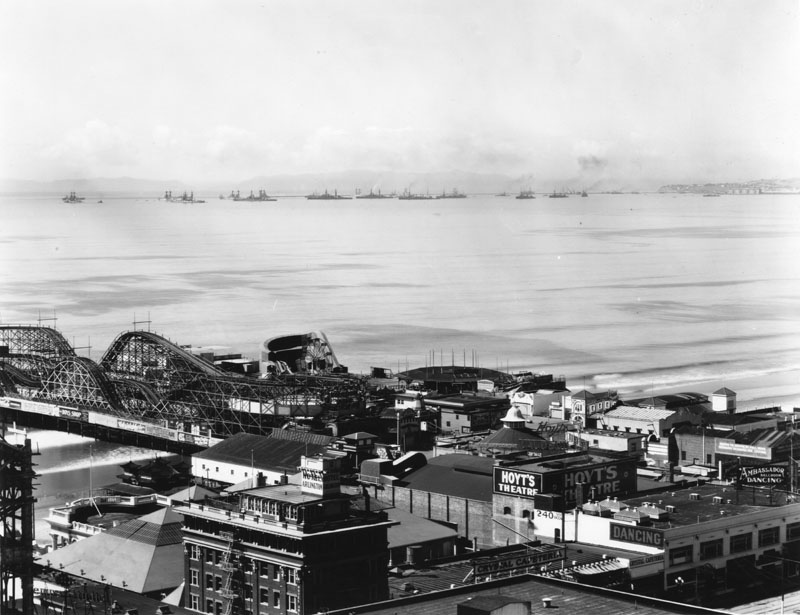 |
|
| (ca. 1920)^ - A view of The Pike amusement park in Long Beach. The roller coaster extends down the pier; underneath it is the Long Beach bath house. The Hotel Arlington is bottom, left. Next to the hotel is the Crystal Cafeteria and next to the cafeteria is the Ambassador ballroom dancing establishment. Hoyt's Theatre abuts the Ambassador. On the horizon are several naval or Coast Guard ships. |
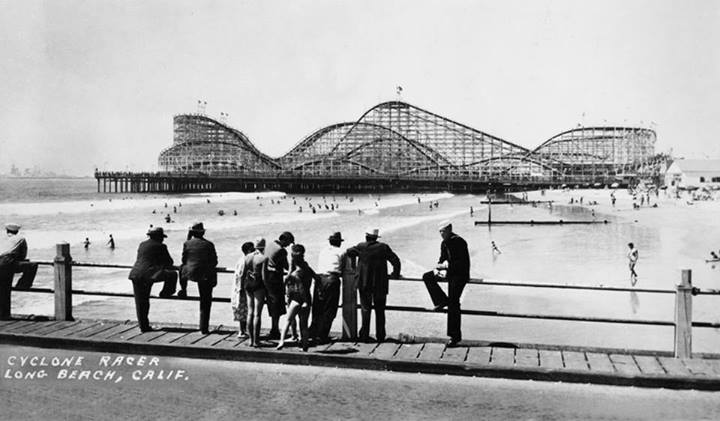 |
|
| (1930)^#^* - A group of people look across the beach toward the Cyclone Racer at the Pike Amusement Park. A lone sailor is looking in a different direction toward perhaps some different scenery. |
Historical Notes The Pike was most noted for the Cyclone Racer, a large wooden dual-track roller coaster, built out on pilings over the water. It was the largest and fastest coaster in the U.S. at the time. They called it 'racer' because there were two trains on two separate tracks that raced one another from start to finish.^ |
Click HERE to see more in Early Views of Southern California Amusement Parks |
* * * * * |
Downtown Los Angeles
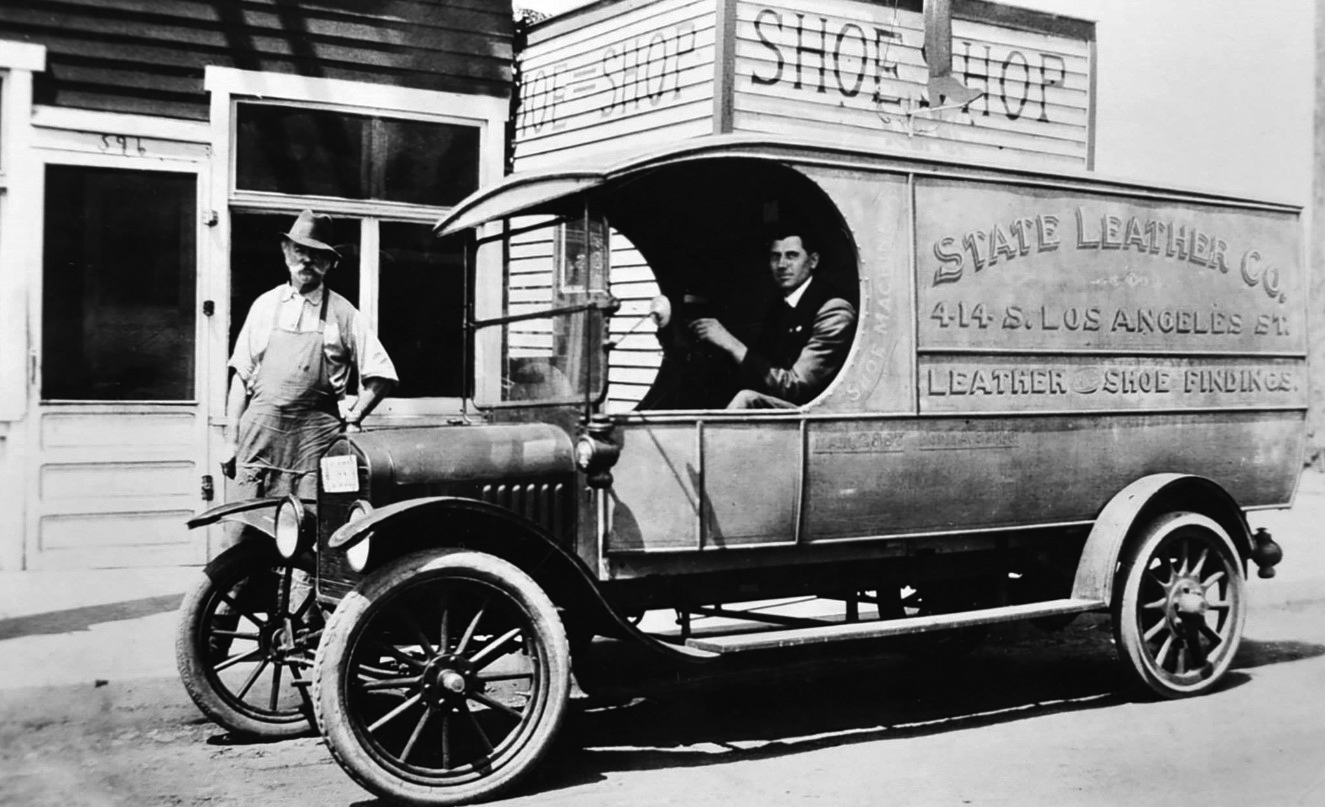 |
|
| (ca. 1918)^#*^ - View showing a service vehicle for the State Leather Co. at 414 S. Los Angeles Street. |
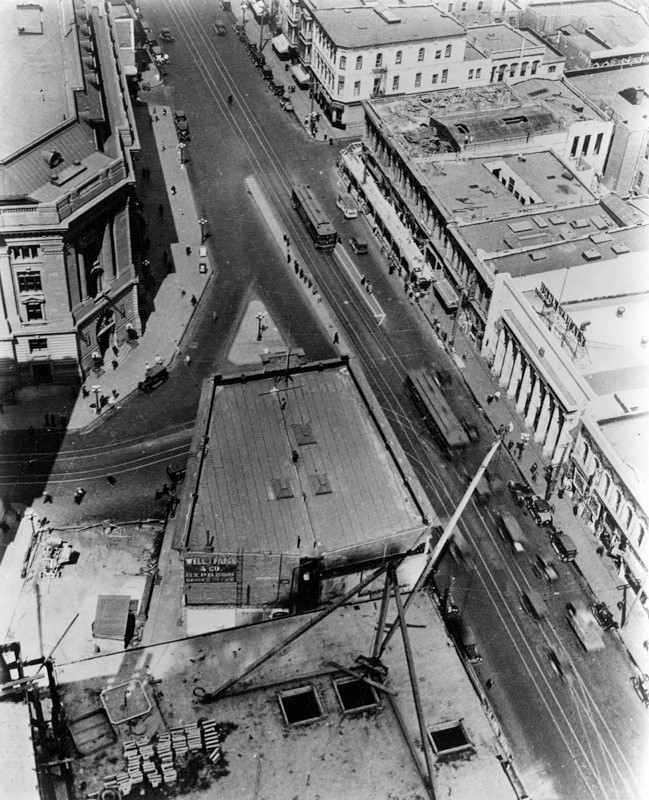 |
|
| (ca. 1920)^ - Aerial view looking north of the intersection of Main, Spring and Temple Streets, with Commercial Street in the upper right. Main extends from top to bottom of the photograph. In the center is the Temple Block. |
Historical Notes The U. S. Post Office is seen on the left. The Ducommun Building is on the northeast corner of Main and Commercial Streets. In the extreme upper right is the first of many buildings erected by Isaias W. Hellman, on the northwest corner of Los Angeles and Commercial Streets. On the southeast corner of Main and Commercial, being renovated, is the Hellman Building.^ |
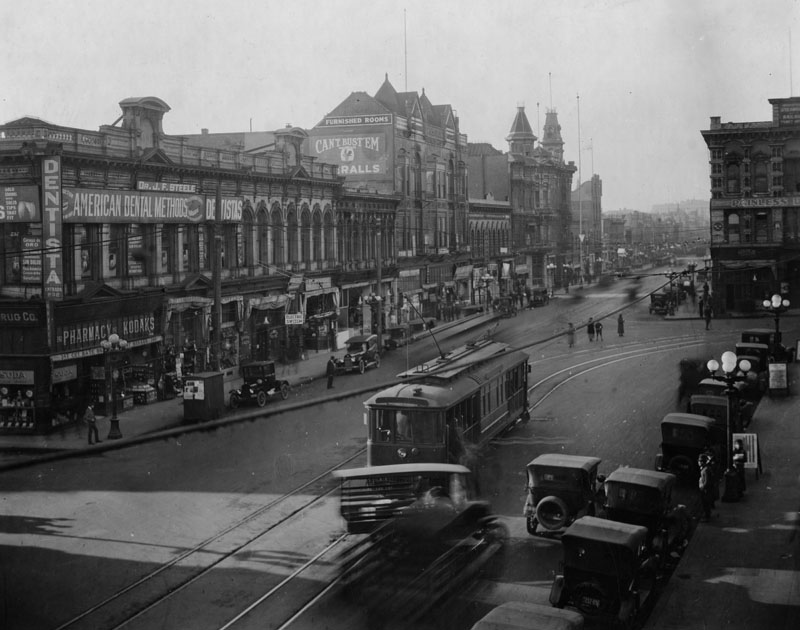 |
|
| (ca. 1920)^ - View looking south on Main Street. At left is the southeast corner of commercial Main Street; street car tracks bend at right, to Temple Street. The building at left is the former home of the Farmers and Merchants Bank. At upper-right can be seen one of LA's most historic blocks, Temple Block. This would become the location of today's City Hall. |
Historical Notes The Farmers and Merchants Bank was the oldest bank in Southern California from 1871 until 1956 when it was merged into the Security First National Bank of Los Angeles. Later, the Security First National Bank of Los Angeles became the Security Pacific National Bank and is now Bank of America. |
* * * * * |
Early LA Streetcars - Interior Views
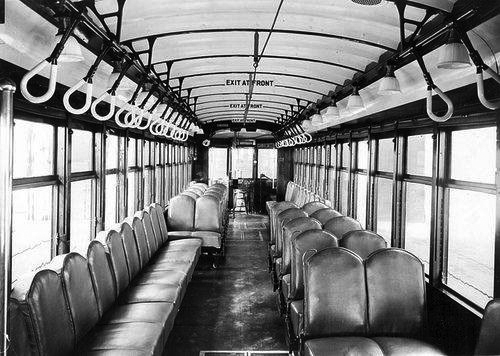 |
|
| (1920s)* - Interior view of an empty Los Angeles Railway (LARy) street car. Signs read: "Exit at Front" |
Historical Notes Early Los Angeles streetcars, including the Los Angeles Railway "Yellow Cars" and Pacific Electric "Red Cars," featured distinctive interior layouts that prioritized efficiency and passenger capacity. The Yellow Cars, which operated from 1895 to 1963, typically had forward-facing double seats arranged in rows on both sides of a central aisle, with hand grips on seat backs for standing passengers. The Red Cars, running from 1901 to 1961, offered a mix of forward-facing and side-facing bench seats, also with double seats along the center aisle in many models. Both systems shared common elements such as large windows for natural light, wooden or rattan-covered seats, overhead hand grips, and advertising displays above the windows. As streetcar technology evolved, newer models incorporated improved lighting, ventilation, and seating arrangements to enhance passenger comfort. These early streetcar interiors were designed to accommodate the growing transportation needs of Los Angeles during the first half of the 20th century, balancing practicality with the comfort of riders. |
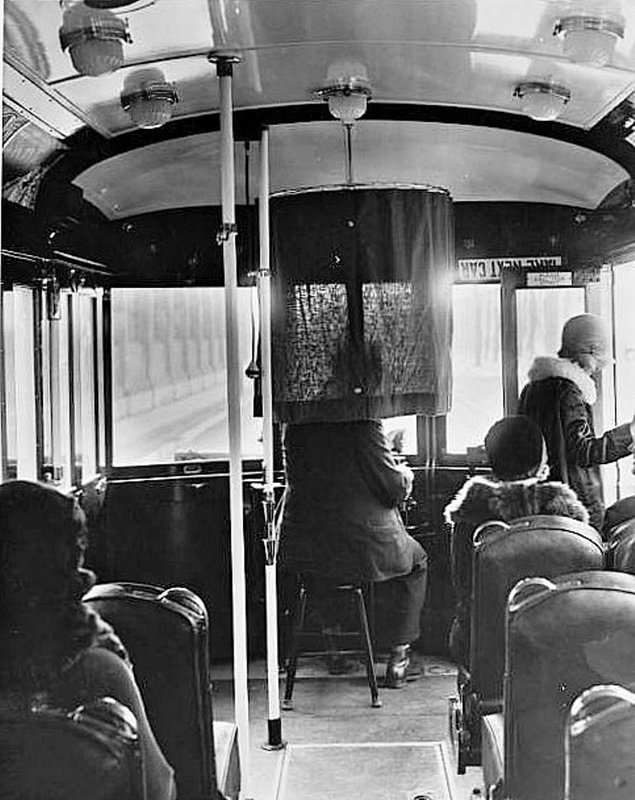 |
|
| (1920s)* - Interior view of a LARy streetcar showing the driver sitting on a stool with a partial curtain separating him from the passengers. |
Historical Notes The Los Angeles Railway (also Yellow Cars, LARy, latterly Los Angeles Transit Lines) was a system of streetcars that operated in central Los Angeles and the immediate surrounding neighborhoods between 1901 and 1963. The company carried many more passengers than the Pacific Electric Railway's 'Red Cars' which served a larger area of Los Angeles. The system was purchased by railroad and real estate tycoon Henry E. Huntington in 1898 and started operation in 1901. At its height, the system contained over 20 streetcar lines and 1,250 trolleys, most running through the core of Los Angeles and serving such nearby neighborhoods as Echo Park, Westlake, Hancock Park, Exposition Park, West Adams, the Crenshaw district, Vernon, Boyle Heights and Lincoln Heights |
 |
|
| (1920)* - Inside view of a Pacific Electric streetcar showing passengers and conductor. |
* * * * * |
Mercantile Place
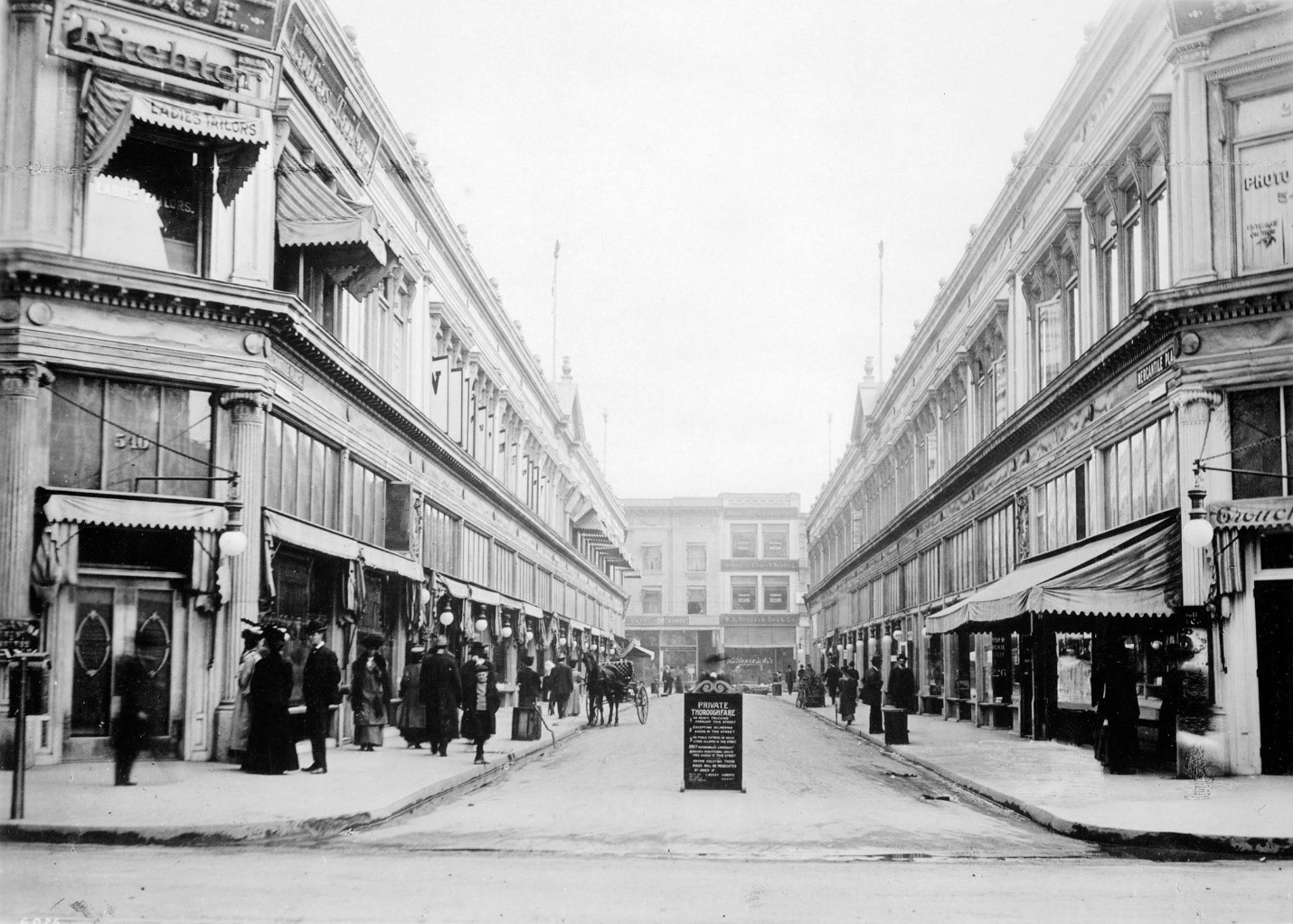 |
|
| (1907)* - A private, open-air shopping street, Mercantile Place stretched 325 feet between Spring and Broadway in downtown Los Angeles. Sign reads "Private Thoroughfare".. |
Historical Notes Long before the Grove, Third Street, or Universal CityWalk, Angelenos flocked to another open-air shopping promenade: Mercantile Place. This tiny, private street, which stretched between Spring and Broadway from 1904 to 1923, measured just 22 feet wide and was flanked by identical, two-story brick buildings, creating an intimate contrast to bustling downtown Los Angeles. Though it resembled a public street with its concrete sidewalks and paved road, Mercantile Place cut through privately owned land leased by developer C. Wesley Roberts in 1904. Roberts ingeniously solved the problem of how to make the central parcel useful—by cutting a street through it, he more than doubled the available storefront frontage from 240 to nearly 600 feet. |
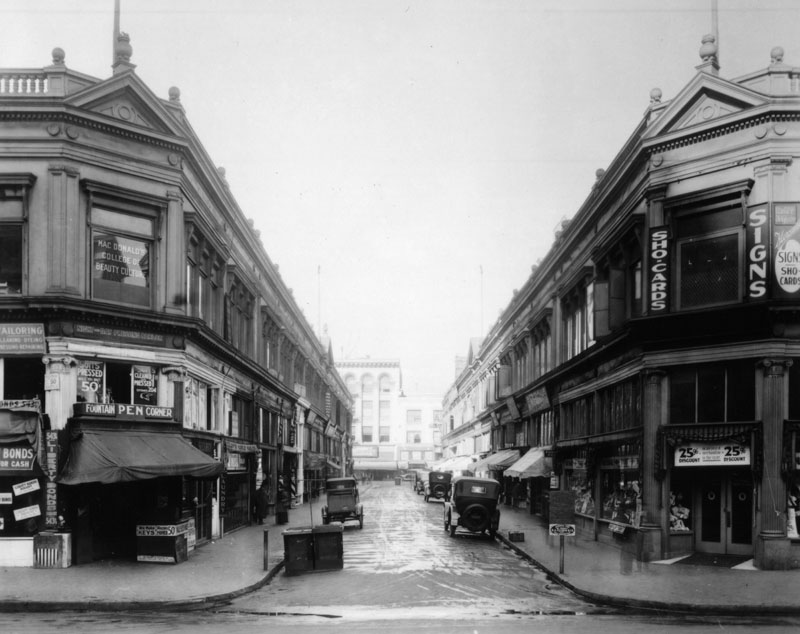 |
|
| (ca. 1920)^ - Mercantile Place, looking west from Spring Street, south of 5th Street. This was the site of Los Angeles' 1st elementary school, Spring Street Elementary School. |
Historical Notes Mercantile Place was planned to be "something entirely new in Los Angeles development"—a private shopping street under the aegis of C. Westley Roberts, who secured a ten-year lease from the Los Angeles School Board and bought the material of the old brick school building, which was to be demolished. |
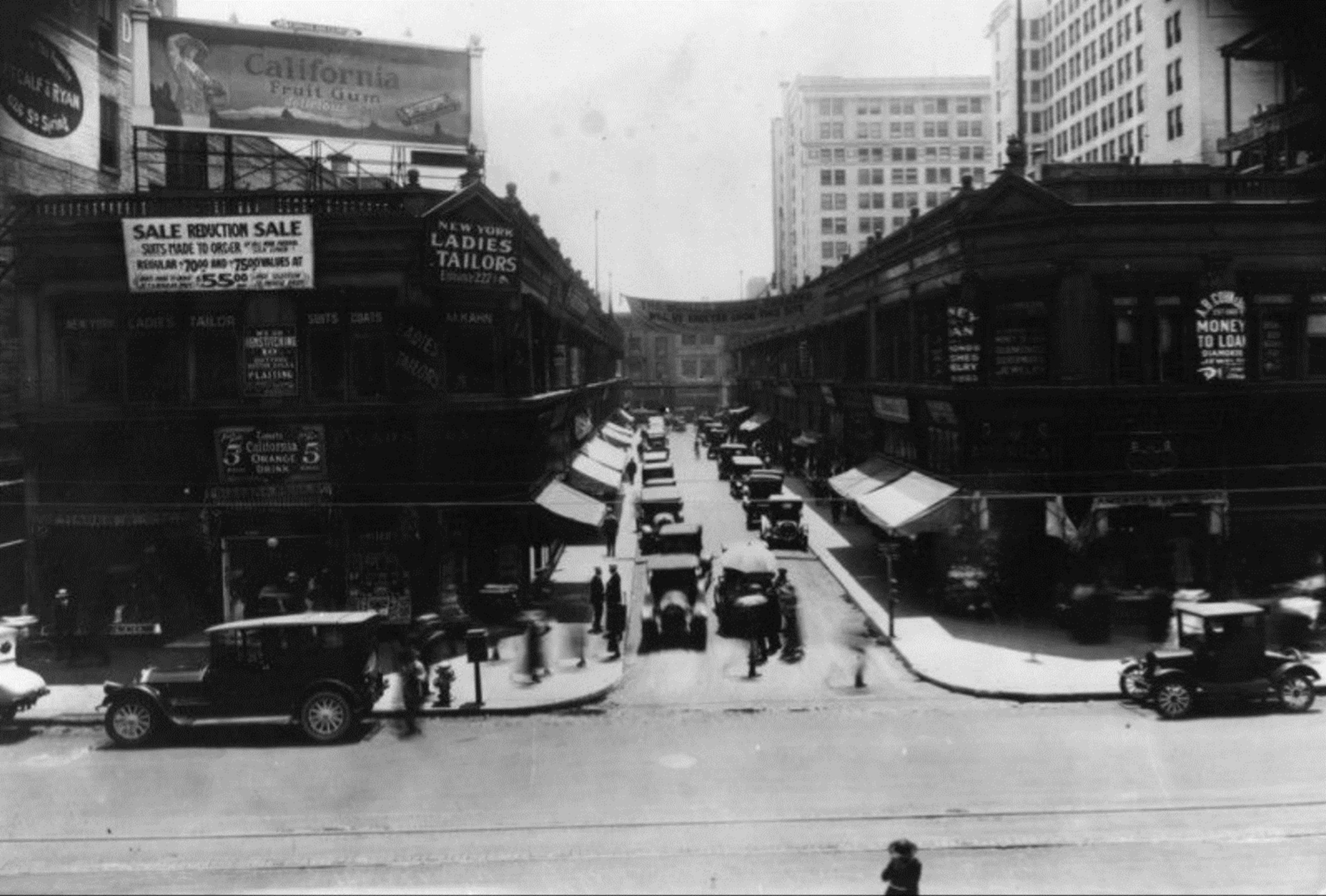 |
|
| (1920s)* – View looking east on Mercantile Place from Broadway. Various signs for stores and good are visible, among them "New York ladies tailors" store, and a billboard atop a building for "Adams California fruit gum. On the right hand side, is a sign for "A.B. Cohn, Money to Loan", established 1869. |
Historical Notes This walkway between two sets of buildings was razed in 1923, and the Mercantile Arcade Building was built in its place. The Arcade Building has entrances from Spring Street and from Broadway, and retains the feel of a passageway. |
Then and Now
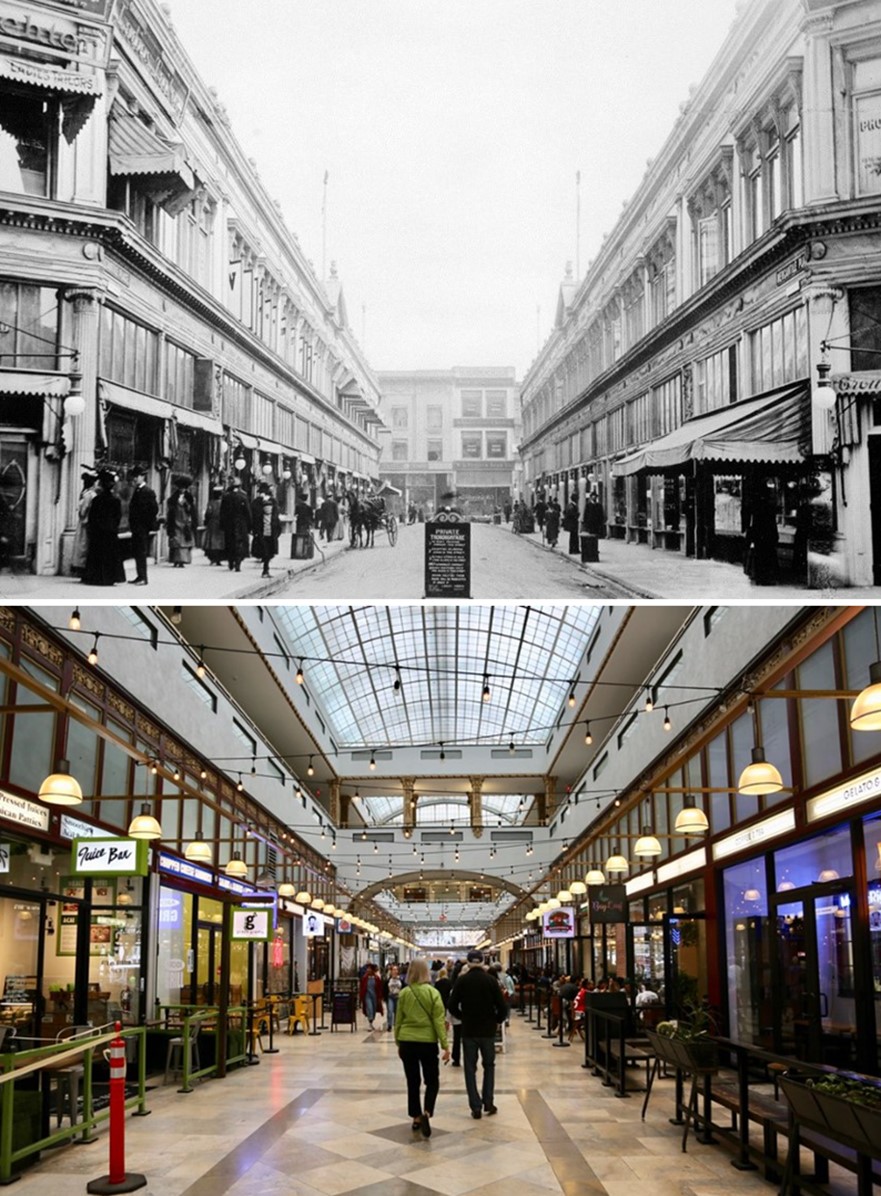 |
|
| (1910 vs 2020s)* - Mercantile Place, today the Mercantile Arcade Building. |
Broadway and Mercantile Place / Broadway and 6th
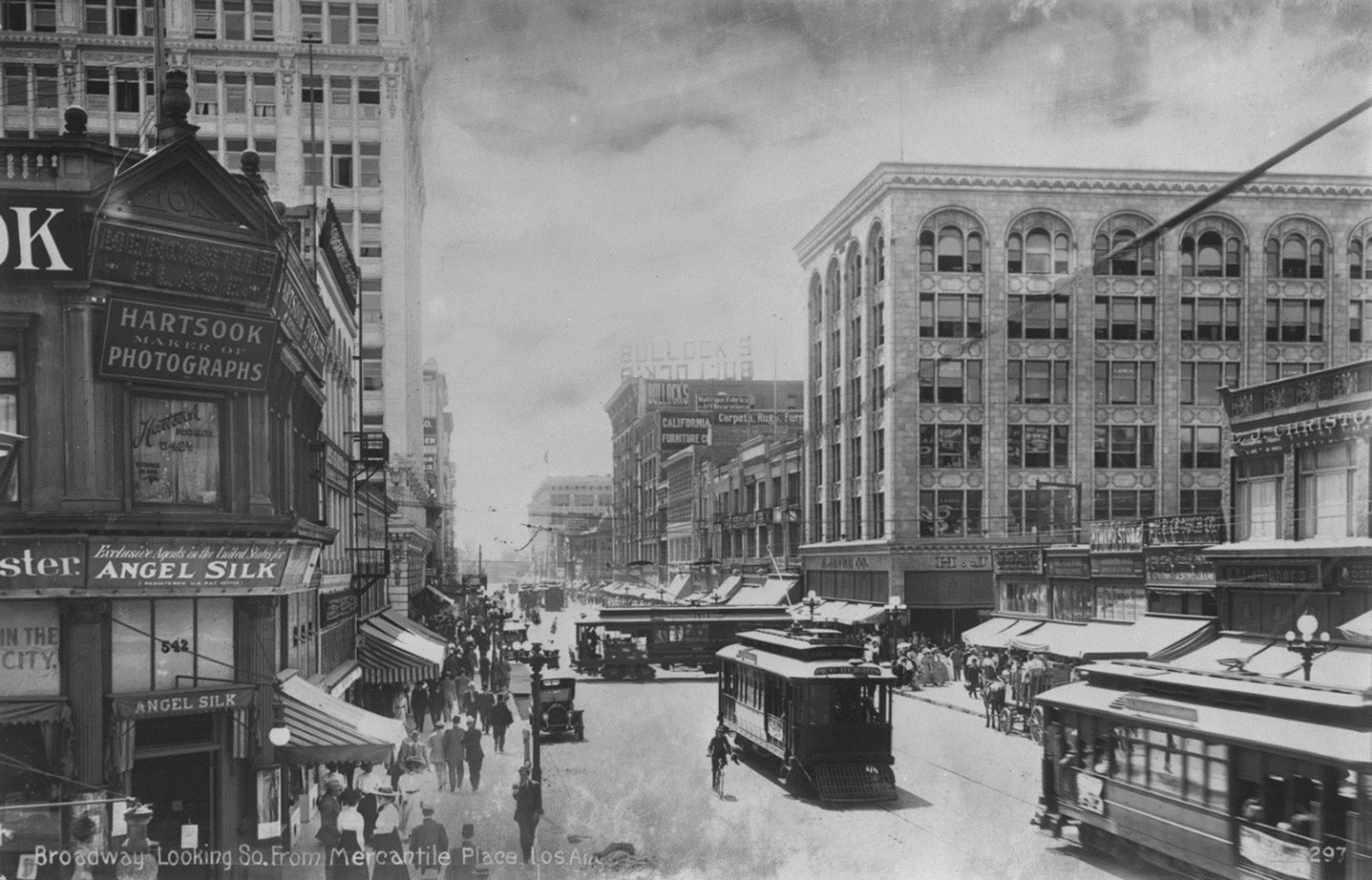 |
|
| (ca. 1910)* - Broadway Street, looking south toward 6th Street from Mercantile Place, showcasing busy sidewalks filled with pedestrians, streetcars, automobiles, and a horse-drawn wagon. In the distance, Bullock’s and the H.J. Jevne Building are visible, with various stores and shops including Hartsook and Angel Silk on the left and Christopher’s on the right. |
Historical Notes The area around Broadway and 6th Street was a bustling commercial district in the 1910s, with many retail stores, theaters, and other businesses. |
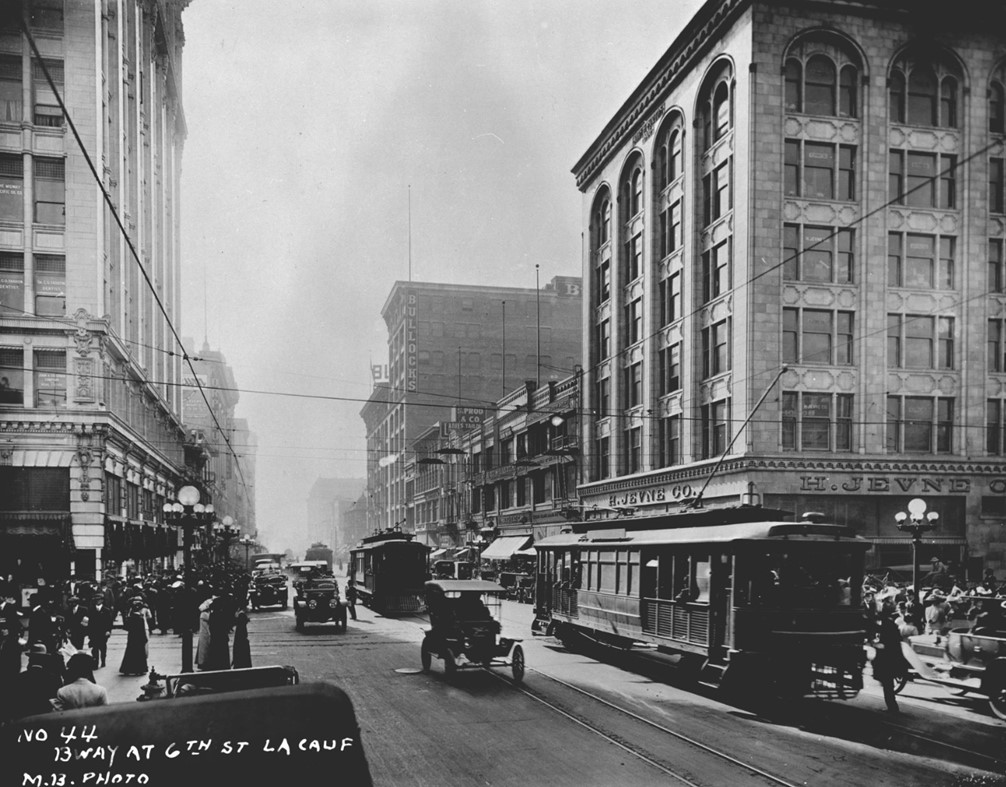 |
|
| (1915)* – Looking south on Broadway at 6th Street, with the H. Jevne Co. building on the southwest corner and Bullock's buildings further down the center. Streetcars and automobiles fill the street, while pedestrians walk along the sidewalk. |
Historical Notes H. Jevne & Company, founded by Hans Jevne in 1882, was a prominent grocer in early Los Angeles. In 1906-1907, the company constructed its flagship store at the southwest corner of 6th Street and Broadway, a building that still stands today next to the Los Angeles Theatre. This store, occupying all six floors of the building, was widely regarded as one of the finest grocery stores in the country, with some even calling it "the finest retail grocery store in the world" due to its equipment and high-end clientele. The store offered a wide selection of groceries, including imported delicacies and products from Jevne's native Norway, as well as liquors and cigars. It represented the pinnacle of H. Jevne & Co.'s success after decades of growth in Los Angeles and was a prominent fixture in downtown Los Angeles during the early 20th century. The store opened at this location in 1907 and operated until 1920, when H. Jevne & Co. closed the retail store to focus on its wholesale business. Today, the H. Jevne & Co. Building remains an important part of Los Angeles' architectural heritage. |
Hill and 5th Streets
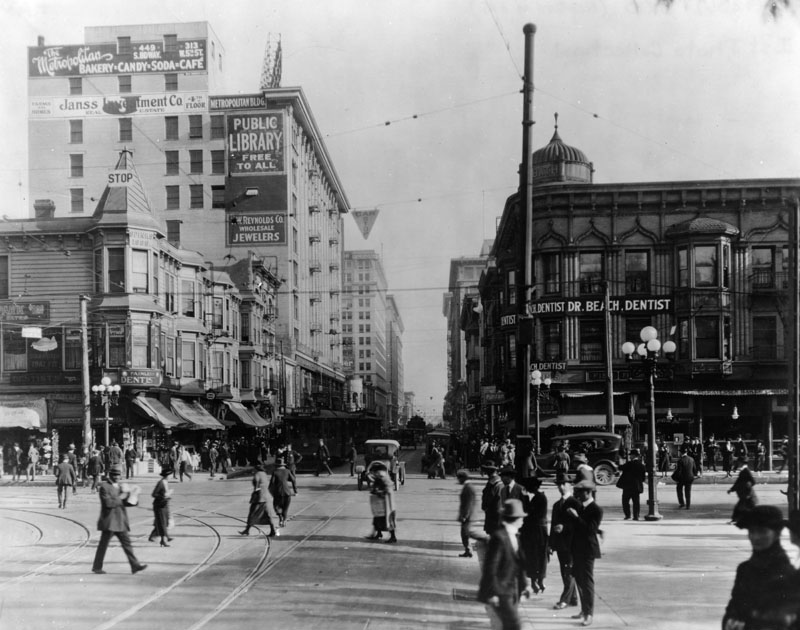 |
|
| (1920)^ - Looking east on 5th and Hill street. Several buildings such as the Spinks, Metropolitan and Bath Building can be seen. As well as several storefronts like Dr. Beach, Dentist. Many automobiles, pedestrians and street cars can be seen throughout the photo. Sign on building reads: "PUBLIC LIBRARY FREE TO ALL". |
Historical Notes Click HERE to see more Early Views of Hill and 5th Streets. |
Hill and 4th Streets
 |
|
| (ca. 1920)^ - A view east down busy 4th St. and its intersection at Hill in downtown Los Angeles. A crowd of pedestrians and autos wait to cross Hill. United Cigars, left, is below the fanciful Brighton Hotel. Center is the Grant Building with the Broadway Department Store opposite. The Teague Drug Co., opposite United Cigars, is below the Hotel Sherman. Other businesses include clothing stores, cafeterias, and dentists. |
Historical Notes Click HERE to see more Early Views of Hill and 4th Streets. |
Los Angeles County Courthouse
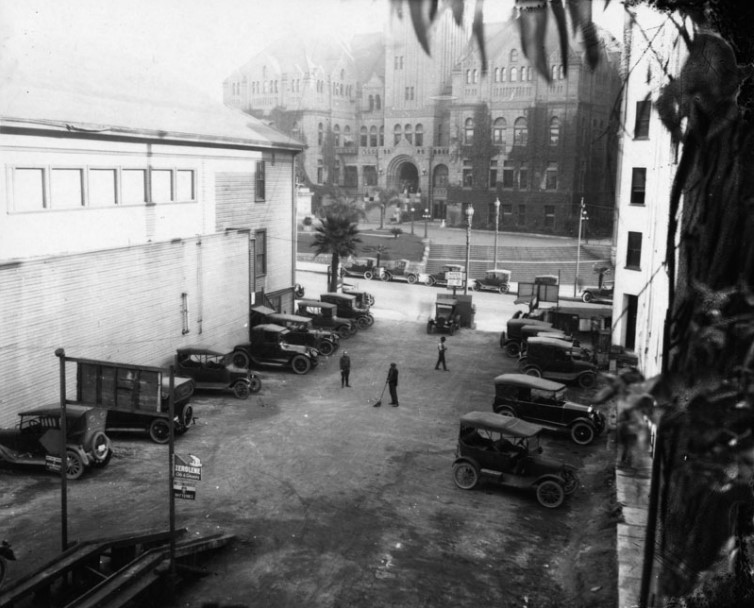 |
|
| (1920)^ - View of the Los Angeles County Courthouse looking across Broadway from between buildings, an area being used as a parking lot. |
Historical Notes The building on the right is the 'New' Hotel Broadway and on the left is the Broadway Christian Church. The 'New' Hotel Broadway survived many, many years, the 'New' becoming ever more ironic. The church is about to be replaced by the Owl Drug Company which would, in its turn, survive until the CRA bulldozers and the coming of the Hollywood Parkway. The 1888 County Courthouse would be doomed in the Long Beach earthquake of 1933. |
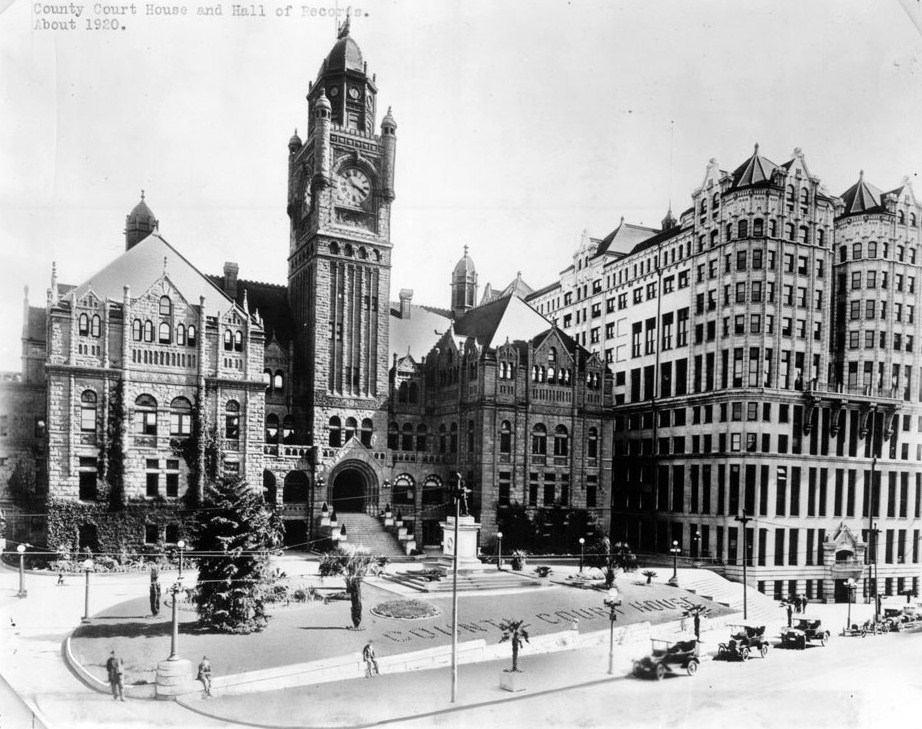 |
|
| (ca. 1920)^^ - View of the Los Angeles County Courthouse and Hall of Records. |
Historical Notes The LA County Courthouse was built in 1888-1891 at the old site of Los Angeles High School. The building was demolished in 1933. The Hall of Records was built in 1906 and demolished in 1973. |
* * * * * |
Los Angeles Early 1920s Video
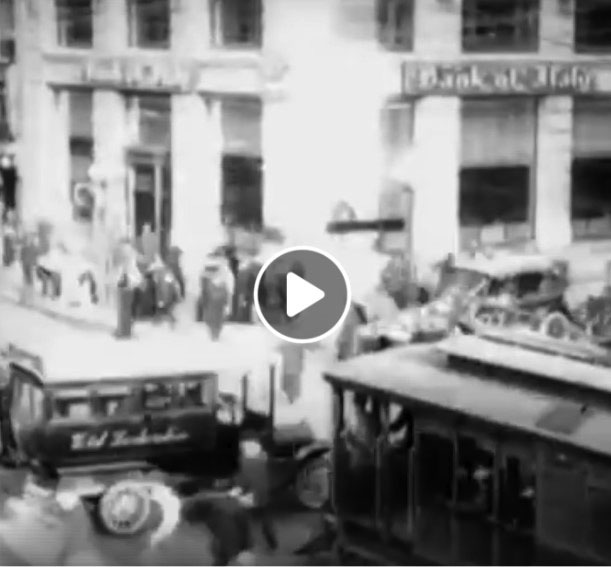 |
|
| (1920s)* - Click HERE to see a rare film of Los Angeles from the early 1920s, including scenes showing Downtown traffic, Pershing Square, Angels Flight, Hill Street Tunnels, LA Aqueduct, and LA/Belmont Oil Field. |
* * * * * |
Hill Street Tunnel
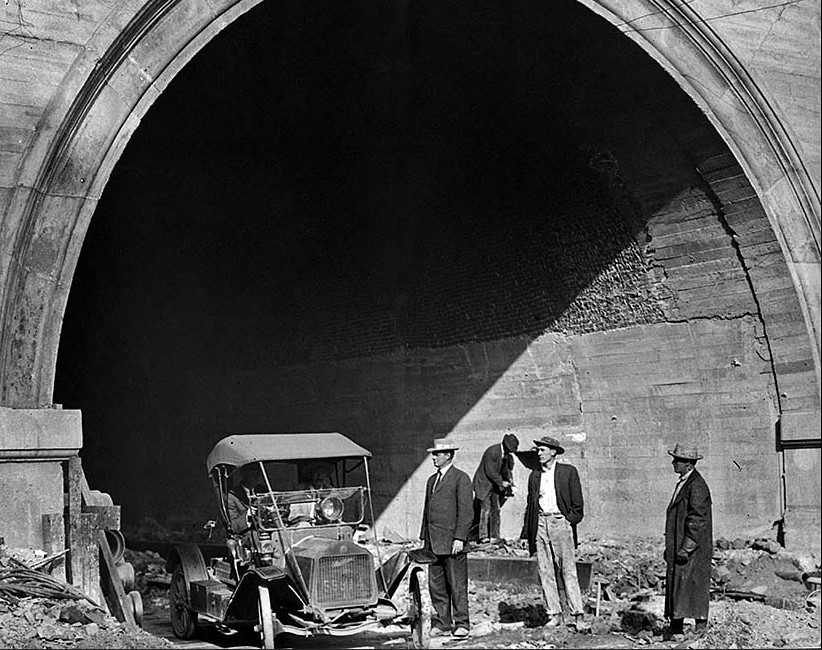 |
|
| (1913)* - Contractors drive a car out of the Hill Street tunnel at 1st Street, a few minutes after a steam shovel had removed the last foot of dirt. LA Times Photo – March 23, 1913 |
Historical Notes This tunnel was the second of twin bores through the northeastern section of Bunker Hill. The hill was also referred to as Court Hill. The tunnel connected Temple St. with 1st Street. |
 |
|
| (ca. 1920)^ - Looking south at Temple to the Hill Street Tunnel. It connects Hill Street from First to Temple. The right tunnel is for streetcar traffic (notice the tracks) and the left for automotive. A group of pedestrians in the median are peering into the tunnel. On the left at the bottom of the hill is a city garage with a poster urging "Vote Yes, Fire & Police pay increase!". |
Historical Notes The first of the two Hill Street Tunnels was bored through a part of Bunker Hill in 1909 by Los Angeles Pacific (a predecessor of Pacific Electric). It connects Hill Street from First to Temple. In 1913, the second tunnel (on the left) was bored for streetcar traffic. |
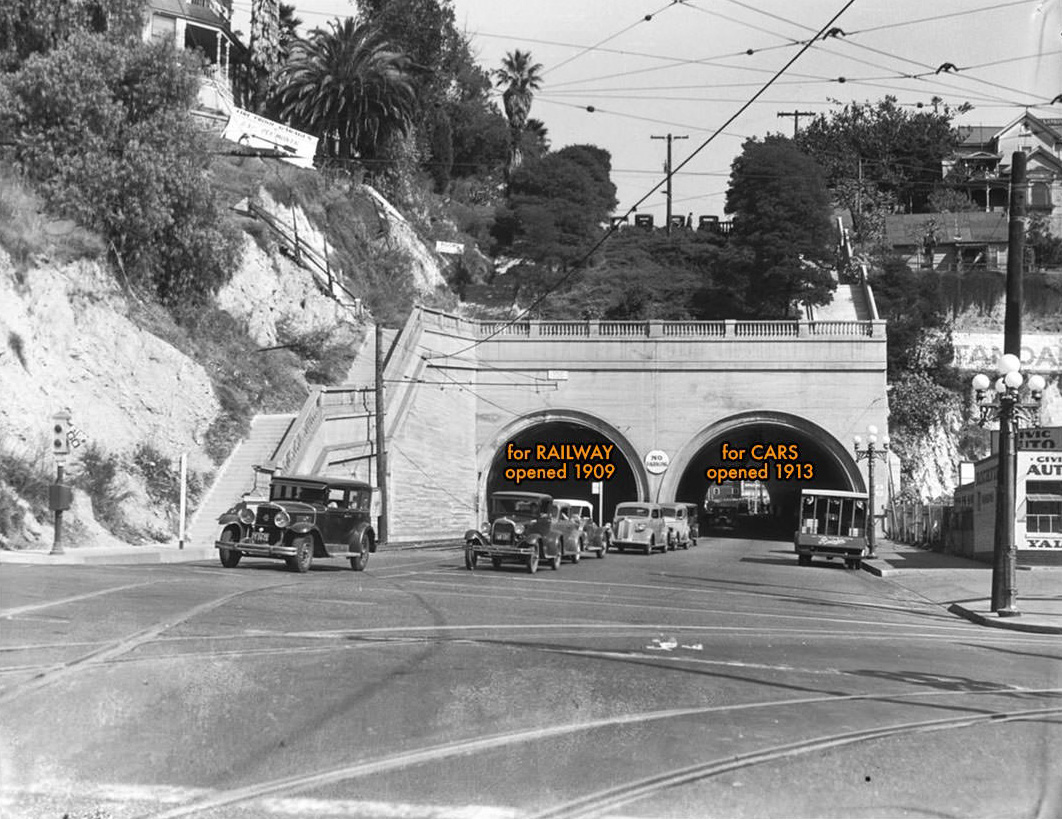 |
|
| (ca. 1923)* - View from the other side of the tunnel (south portal), at Hill Street and 1st looking north.^ |
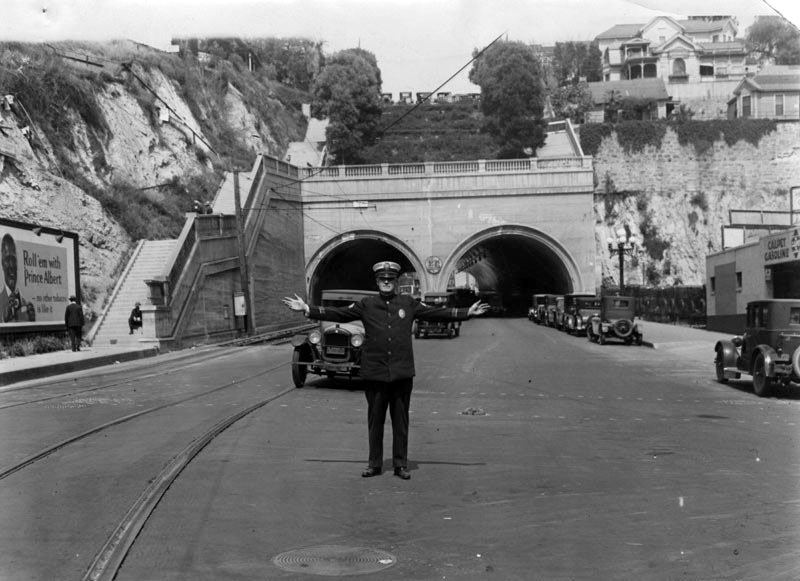 |
|
| (1928)* - Sergeant E.R. Gouldin directs traffic at the south portal of the Hill Street Tunnels at 1st Street. |
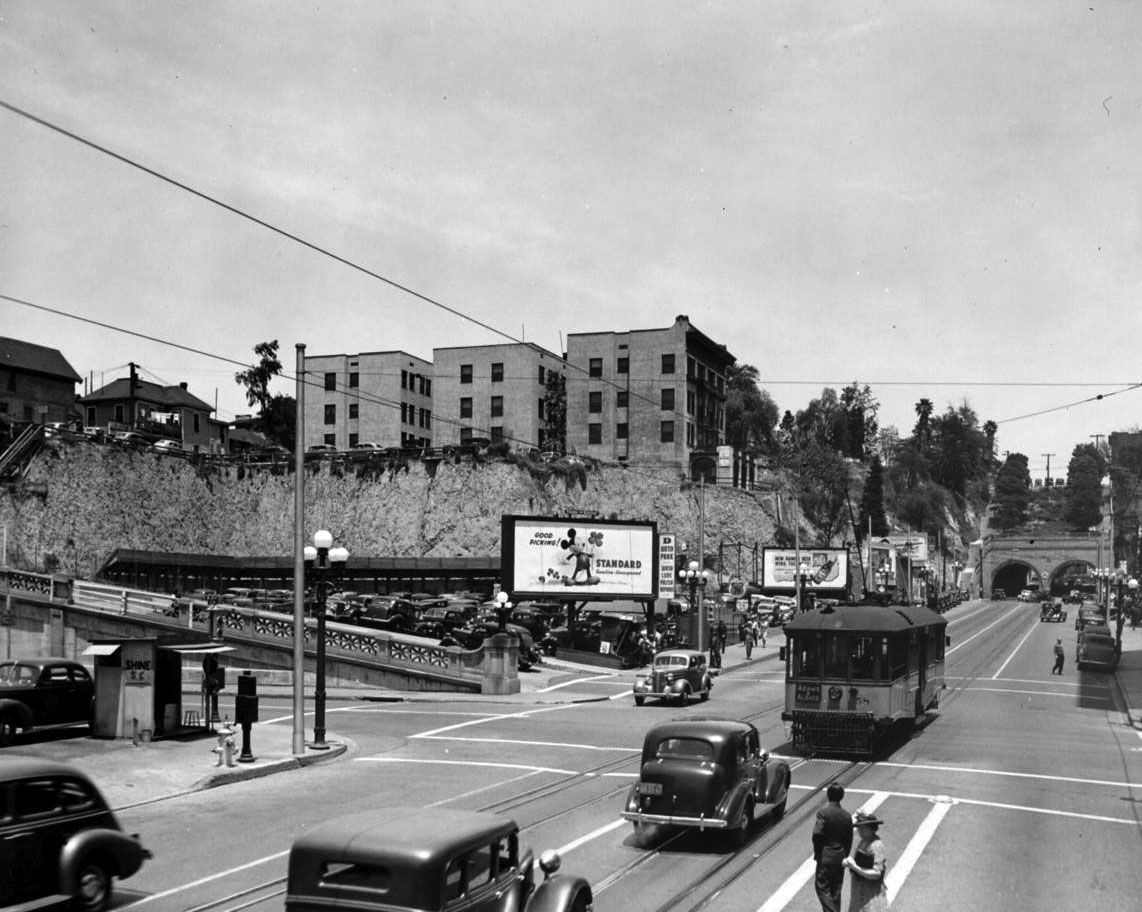 |
|
| (1930s)* – View looking north from the intersection of 2nd & Hill streets showing the Hill Street Tunnels in the distance. Photo Dick Whittington. |
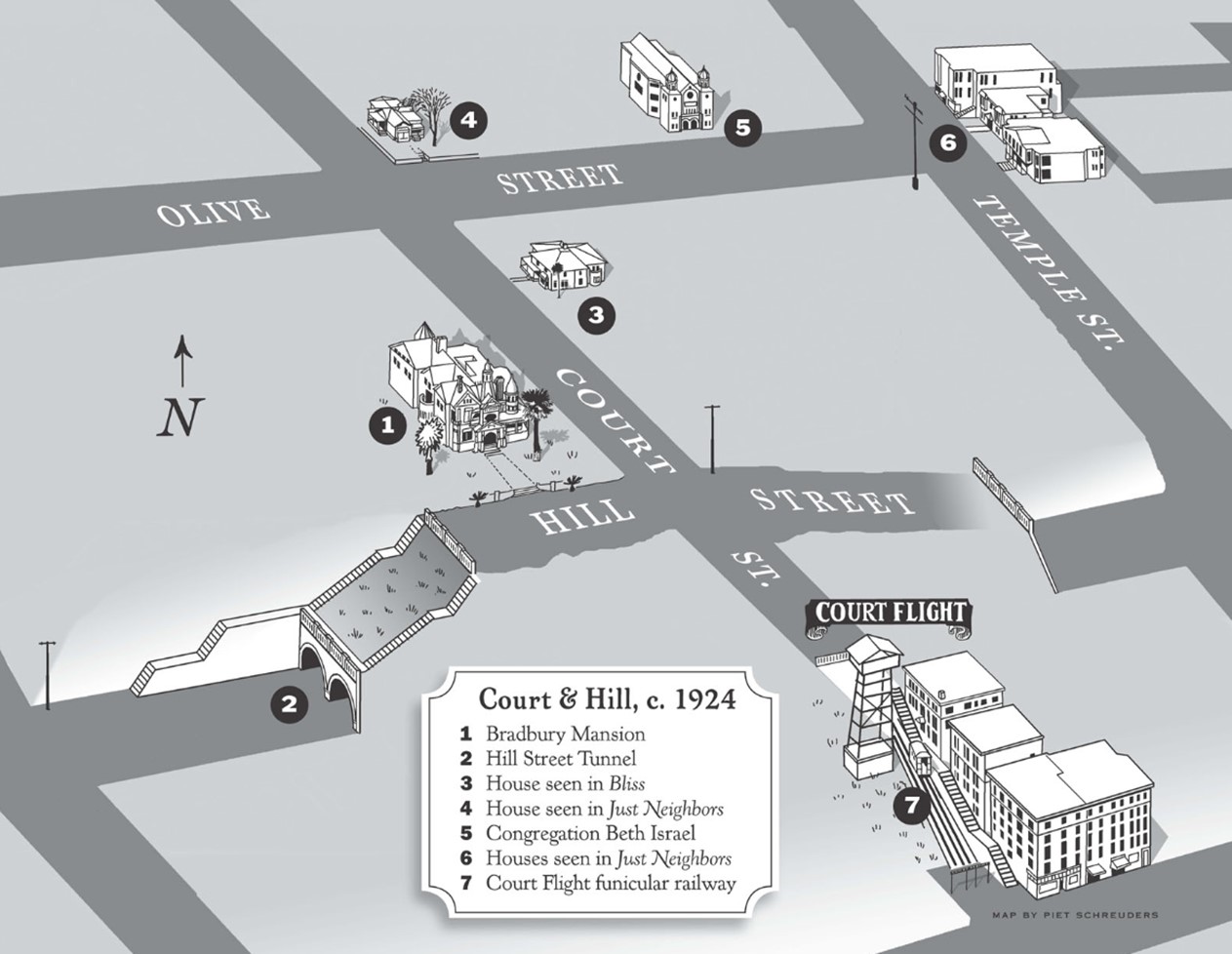 |
|
| (ca. 1924)* - Map of Bunker Hill showing the Hill Street Tunnels between Temple and 1st Streets with Court Flight seen at lower right. Map by Piet Shreuders. |
Historical Notes Click HERE to see more Early Views of the Court Flight. |
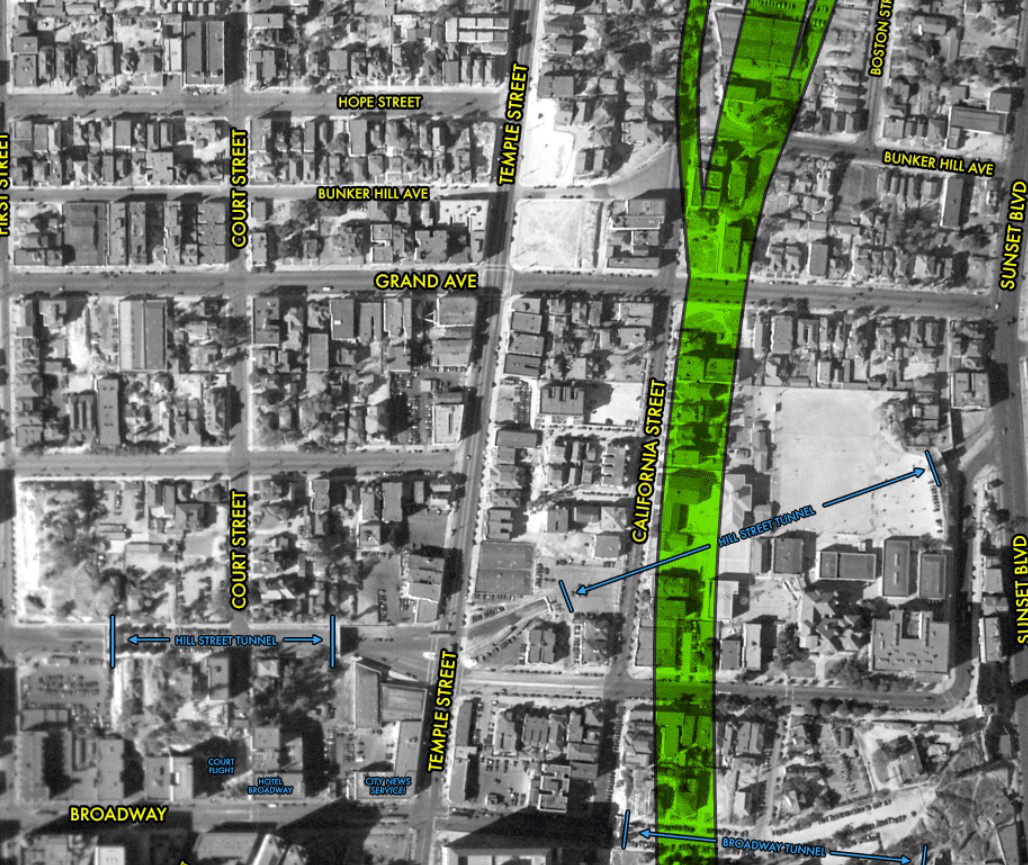 |
|
| (1933)* – Aerial view over Bunker Hill, Court Hill, and Fort Moore Hill, annotated to show the locations of both the Hill Street Tunnel and the Broadway Tunnel. The green shaded area is where the Hollywood Freeway would be constructed in the early 1950s. Photo Courtesy: Scott Charles |
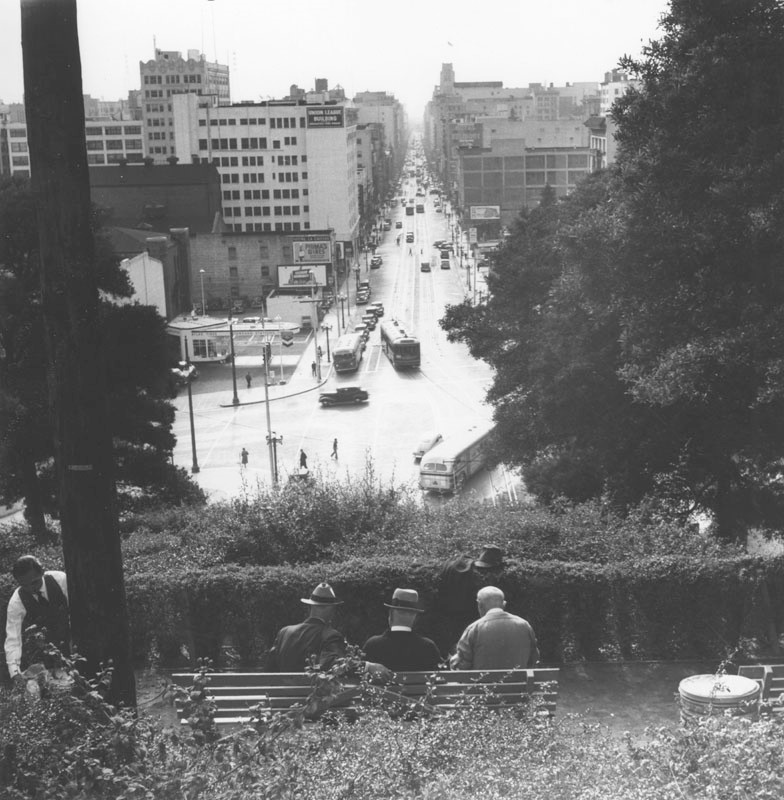 |
|
| (ca. 1940)* - Three elderly gentlemen socialize on a bench on top of the Hill Street Tunnel, looking south. The intersection seen below at street level is where 1st street (only partially visible) meets Hill Street. Cars and streetcars are seen traveling north and south. Photo by Ansel Adams |
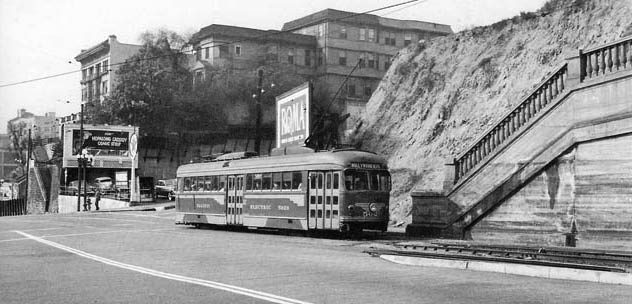 |
|
| (1949)* - View of a streetcar running inbound on the Hollywood Boulevard streetcar line, which runs through Court Hill in a tunnel. |
Historical Notes The Hill Street tunnels ran through a hill called Court Hill. Both Hill Street and Broadway had tunnels through Court Hill. In the photo above we're looking southwest towards First and Hill. First Street comes in behind the streetcar. At this point First Street is in a valley between Bunker Hill and Court Hill. The apartment houses in the center are on Bunker Hill. The hill at right is Court Hill. |
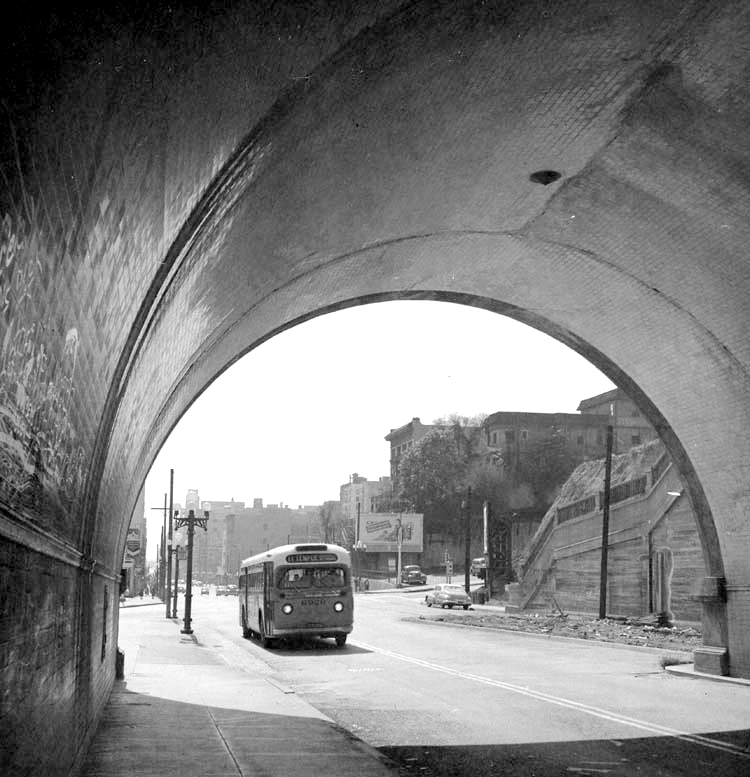 |
|
| (1953)* - The #11 Temple Street bus enters the Hill Street tunnel heading south.*^^ |
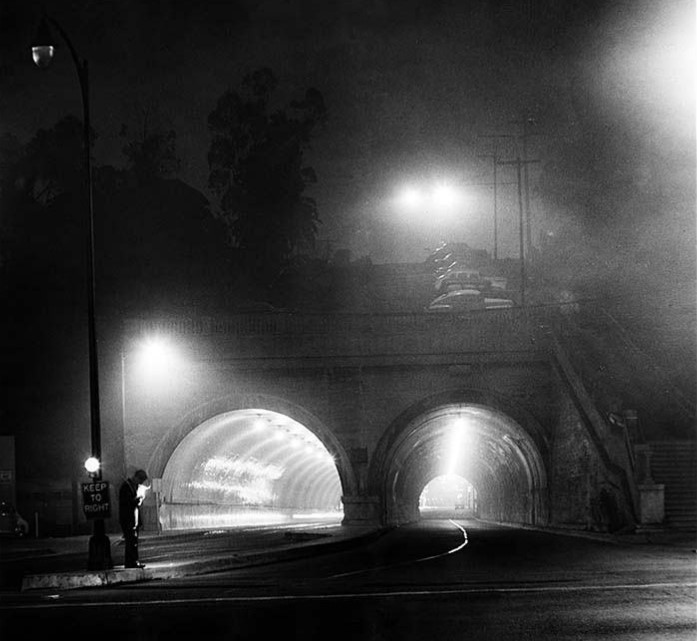 |
|
| (1954)* – Hill Street tunnels seen from Temple Street on a fogbound night. The tunnels connected Temple with 1st Street. Photo by the LA Times on Oct. 12, 1954 |
Historical Notes Within two months of the above photo, construction work to remove the tunnels and enlarge the Los Angeles Civic Center began. |
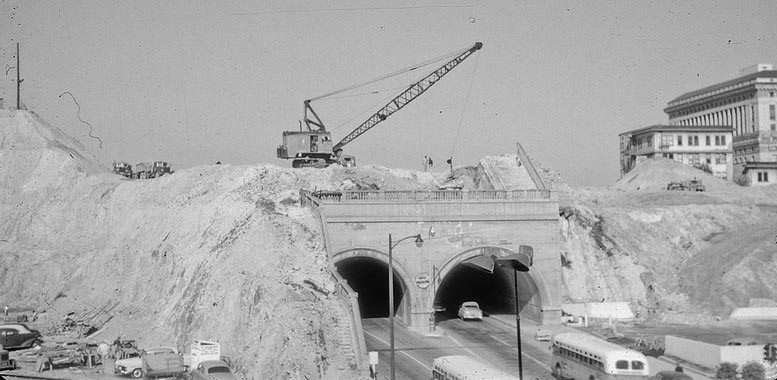 |
|
| (1954)* – Panoramic view showing the Hill Street Tunnels during early stages of demolition. Note that traffic is still flowing through the tunnels. |
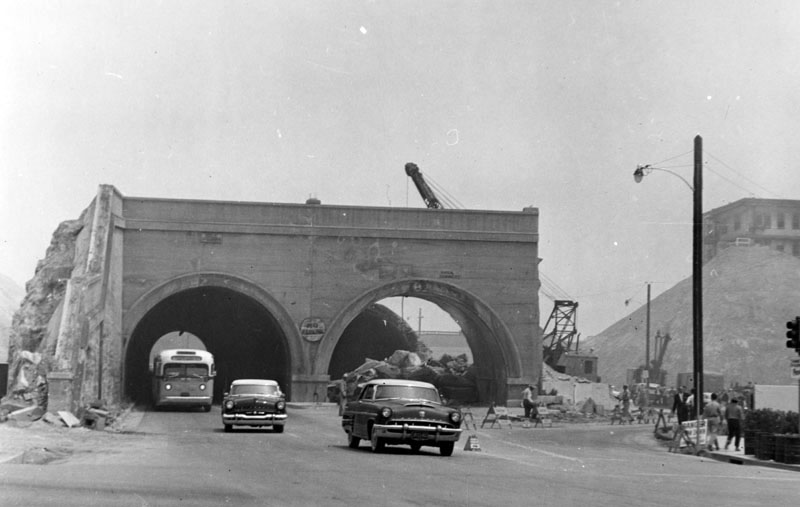 |
|
| (1955)^ - View of the side-by-side Hill Street tunnels, looking north from 1st Street. Two autos and a bus are exiting the left side tunnel, even though the entire surroundings have been demolished, in preparation for future buildings. |
Historical Notes The Hill Street tunnels and the hill above them were completely removed by June 1955 to make way for the current Los Angeles Civic Center. |
Then and Now
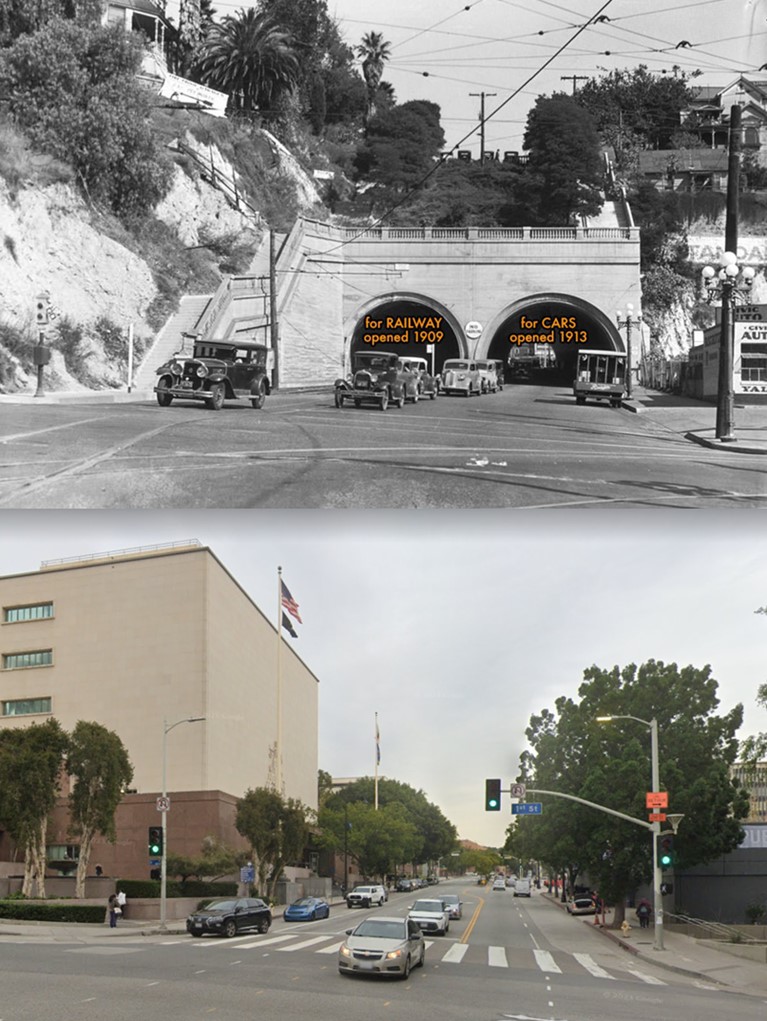 |
|
| (1923 vs 2023)* – Looking north on Hill Street at 1st Street, once the location of the Hill Street Tunnel. Note how much the hill has been shaved off. |
Historical Notes Click HERE to see the Construction and Opening of the First Hill Street Tunnel |
* * * * * |
Agricultural Park (later Exposition Park)
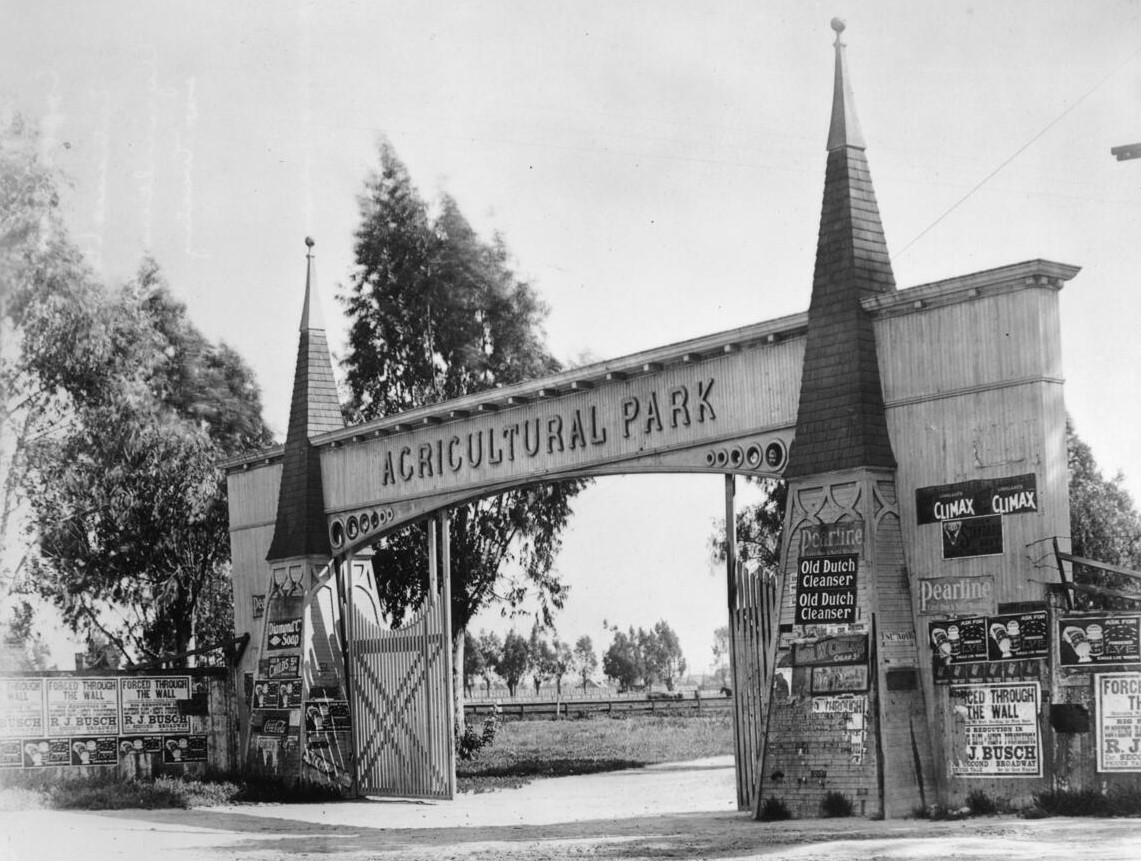 |
|
| (ca. 1910)^ - Before Exposition Park, Los Angeles had Agricultural Park, at the same spot. Right here. Seen here is the Wesley Avenue entrance. |
Historical Notes Exposition Park was originally created in 1872 as an agricultural park, and 160 acres were set aside for the Southern District Agricultural Society. In 1913, it was renamed Exposition Park according to the “City Beautiful” movement with 4 anchor tenants: California Museum of Science and Industry (Exposition Building), National Armory, Domed National History Museum and the Sunken Garden (which in 1928 was later renamed the Rose Garden). |
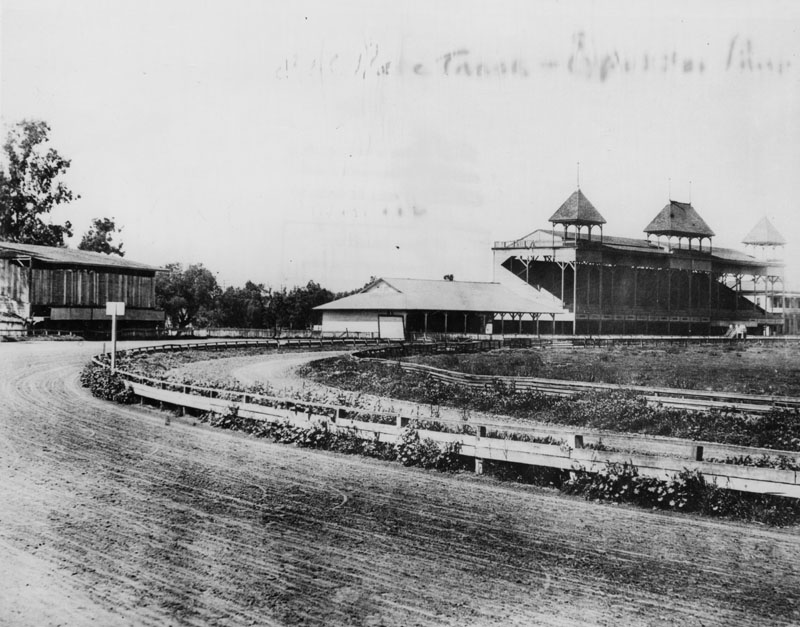 |
|
| (ca. 1900)^ - Partial view of the racetrack at Agriculture Park (Exposition Park) in the early 1900s. Photograph shows the grandstand with three open towers, an adjacent smaller structure, possibly a concession stand, and another unidentified structure on the extreme left. |
Historical Notes Originally, this piece of land served as an agricultural fairground from 1871 to 1911. Farmers sold their harvests on the grounds, while horses, dogs, camels, and later automobiles, competed along the racetrack (seen). In the late 1800s and early 1900s, the city's most influential families moved into the neighborhood but did not appreciate the racing and gambling that came with it. As a result, this racetrack was transformed into the now-famous Exposition Park Rose Garden. |
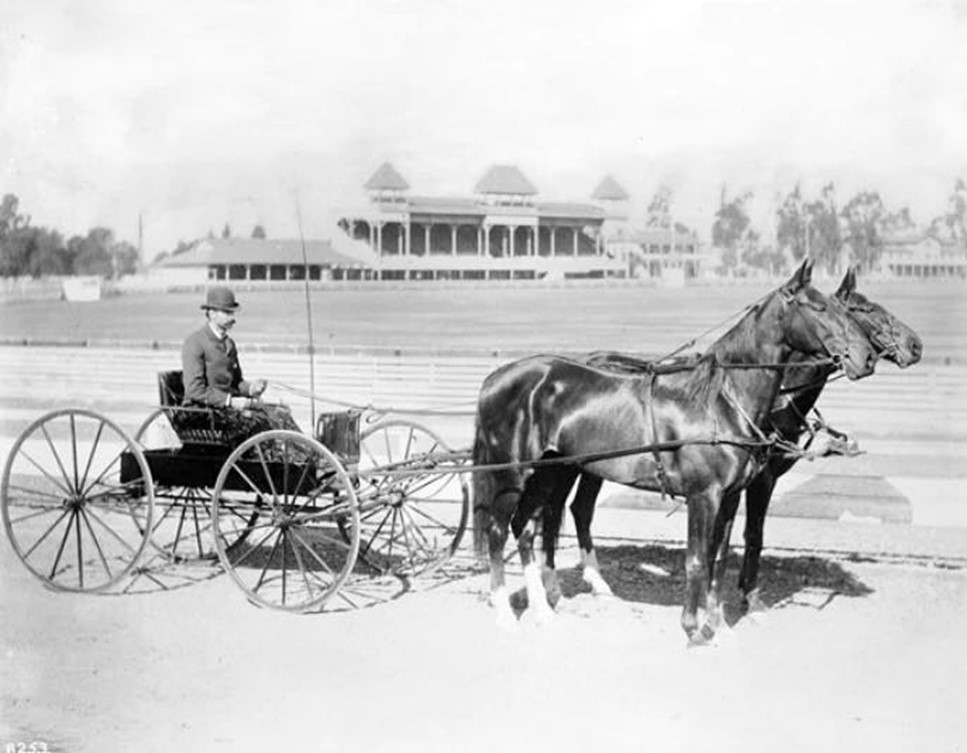 |
|
| (1895)* - Photograph of Captain Pierce of the Los Angeles Police Department on carriage with race horse team at the Agricultural Park Horse Show. Behind the Captain and his horse team are the race tracks. In the distances are the buildings and seating to accommodate the audiences that attend the races. |
.jpg) |
|
| (1893)^^ - Agricultural Park (later renamed Exposition Park) Start of 25 mile bicycle race, October 3, 1893. |
Historical Notes In 1909, plans were nearly complete for the building of the Natural History Museum (only then it was the Museum of History, Science, and Art) and a state armory. Bids were solicited. The next year, the site changed its name from Agricultural to Exposition park. |
* * * * * |
Sunken Gardens (aka Rose Gardens)
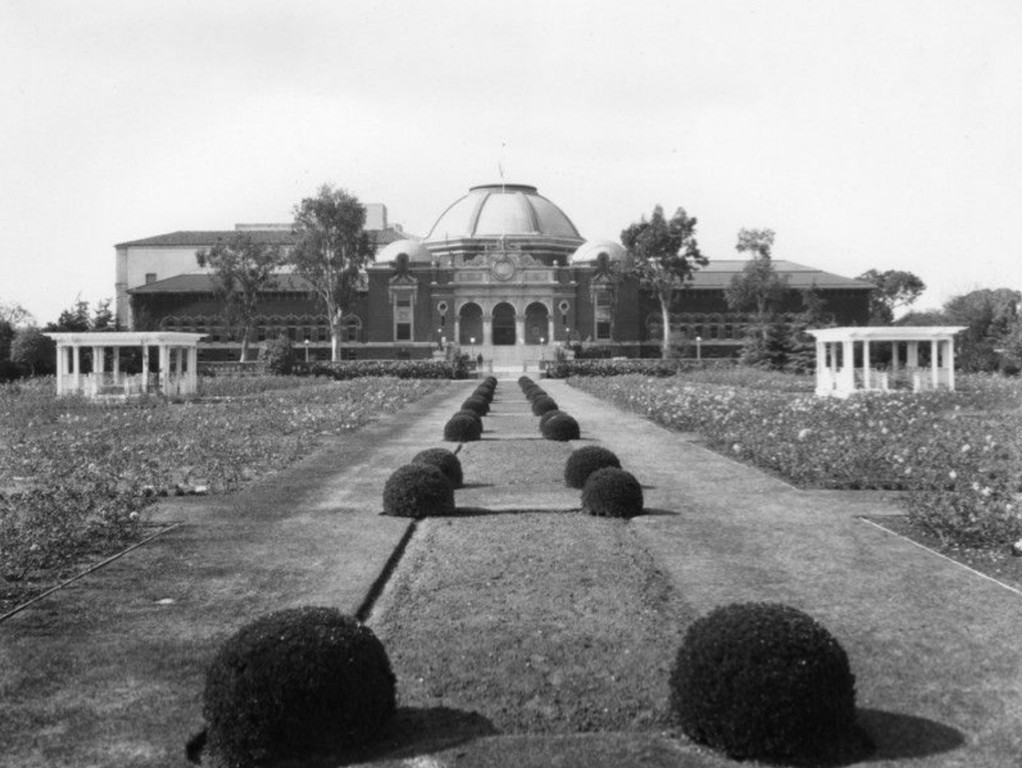 |
|
| (1920s)* – View of the sunken Rose Garden at Exposition Park (formerly Agricultural Park), with the original History, Science and Art Building prominently in the background. Formal paths and rounded shrubs line the garden’s central axis, flanked by rose beds and classical garden structures. |
Historical Notes The land that now hosts Exposition Park's iconic Rose Garden began its public life in 1872 as Agricultural Park—a far cry from the serene oasis it is today. Located on the outskirts of a rapidly growing Los Angeles, the park originally served as a fairground and racetrack, attracting crowds with horse races, gambling, and lively entertainment. This early incarnation reflected the untamed, adventurous spirit of the frontier-era city, where saloons and betting parlors lent the area a reputation for rowdiness. By the early 20th century, Los Angeles had begun maturing into a civic-minded metropolis, and the vision for Agricultural Park began to shift. Recognizing the potential of the centrally located site, civic leaders and reformers advocated for a transformation—one that would replace racetracks with museums and public gardens. In 1913, the area was officially renamed Exposition Park, signaling a new era. The northern end of the grounds was designated for a formal garden, though for several years it remained little more than an open lawn with meandering paths. |
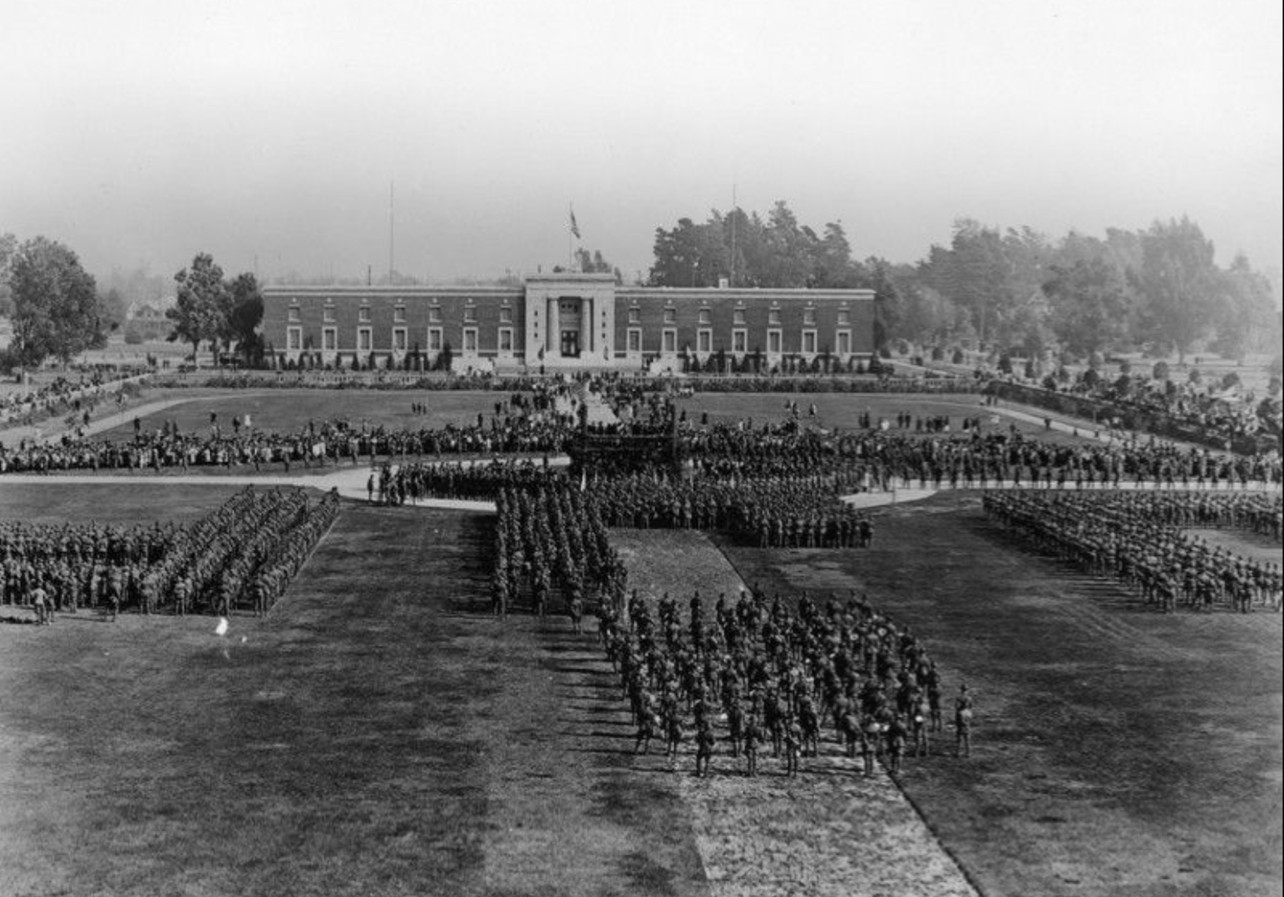 |
|
| (1920)* - Sunken gardens, also called Rose Garden, at Exposition Park, formerly called Agricultural Park, with State armory building. This photo shows Pershing Day, Jan. 26, 1920, at the Sunken Gardens at Exposition Park. |
Historical Notes The old Agricultural Park had a racetrack for cars that was moved during the construction so that the sunken rose garden with a central fountain could be planted between the two buildings--the museum and armory. Long range plans, even in 1909, called for a memorial statue at the fountain to celebrate the bringing of water to Los Angeles from the Owens River. |
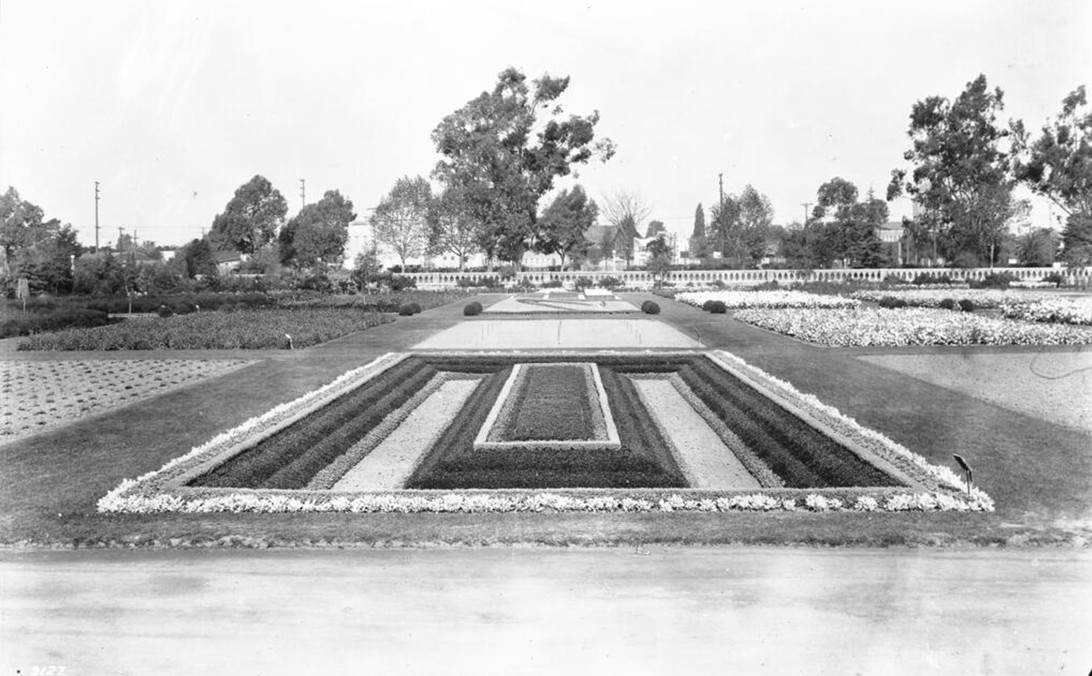 |
|
| (1925)* – Sunken pansy garden in Exposition Park, designed with beveled, flower-lined tiers and a raised central bed. Behind it, additional floral plots are arranged in a grid pattern, bordered by mown grass walkways. A low concrete wall and mature trees define the park’s perimeter. |
Historical Notes Momentum began to build following a major horticultural exposition held on the site in 1921. This event brought renewed interest in the development of a full-scale public garden. It introduced ornamental features and established the layout that would later define the space. Still, the garden remained largely undeveloped until the late 1920s, when the vision of a formal rose garden took root—literally and figuratively. |
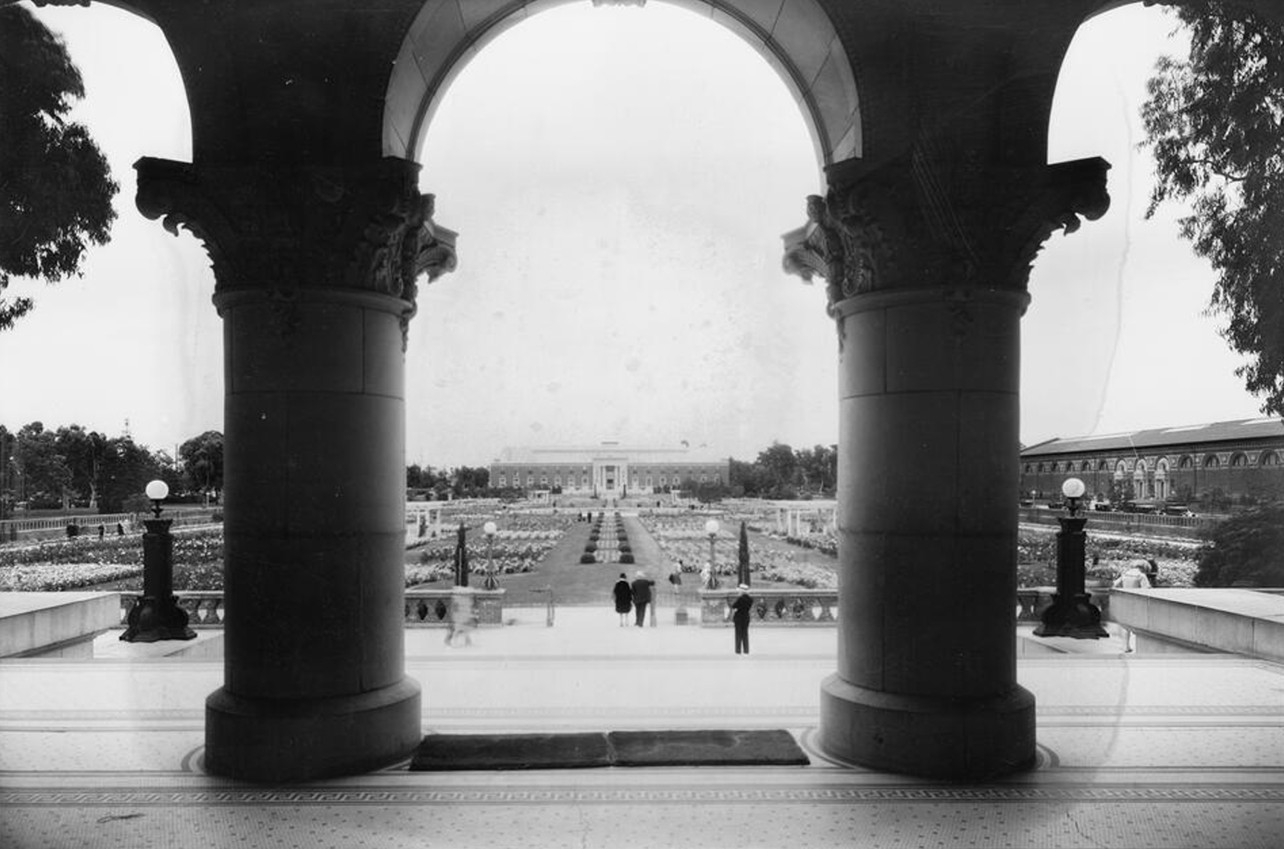 |
|
| (1929)* – View of the Exposition Park Rose Garden framed by the grand arch of the History, Science and Art Building. Formal flower beds, walkways, and pergolas stretch toward the State Armory Building in the distance, showcasing the garden’s symmetry and civic design. |
Historical Notes Between 1926 and 1928, the space underwent a dramatic transformation. City officials partnered with local horticulturalists and nursery owners to develop a sunken garden dedicated entirely to roses. Truckloads of enriched soil were brought in, and over 15,000 rose bushes—donated by growers and enthusiasts from across Southern California—were meticulously arranged in symmetrical beds. With the installation of walkways, fountains, and arched trellises, the garden quickly earned acclaim as one of the largest and most beautiful municipal rose gardens in the nation. |
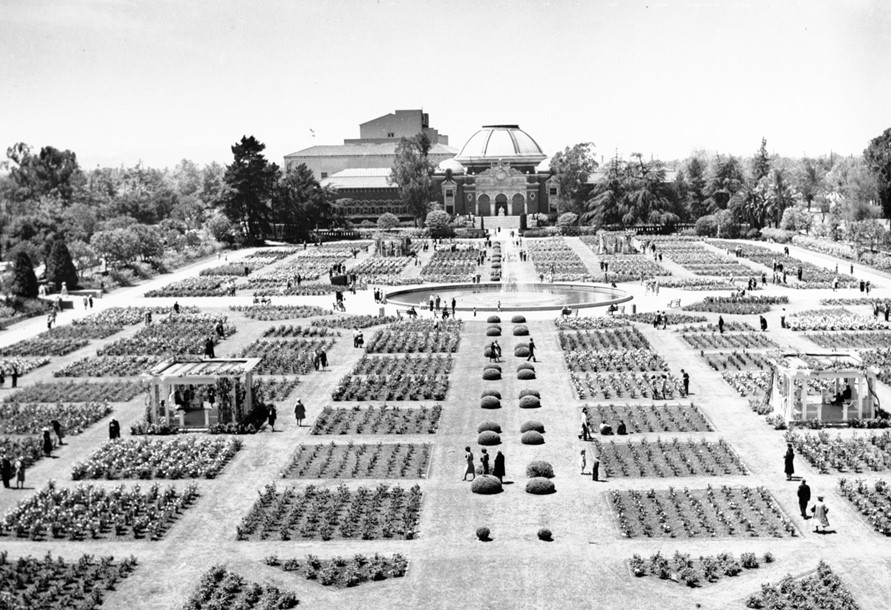 |
|
| (ca. 1950)* - Birdseye view of the sunken rose garden in Exposition Park as seen from the History, Science and Art Building with the State Armory in the distance. The large rose garden is at center and is full of pedestrians wandering among the square plots of roses. A large circular fountain can be seen shooting water into the air in the middle of the garden. |
Historical Notes Over time, the Exposition Park Rose Garden became a cherished cultural asset and a favorite backdrop for countless family photos, weddings, and public gatherings. In 1991, it was officially listed on the National Register of Historic Places, securing its place in Los Angeles history. Today, it remains a tranquil refuge surrounded by institutions of learning and culture, including the Natural History Museum and the California Science Center—an enduring symbol of the city's evolution from rough frontier town to world-class civic center. |
* * * * * |
Exposition Park Fountain
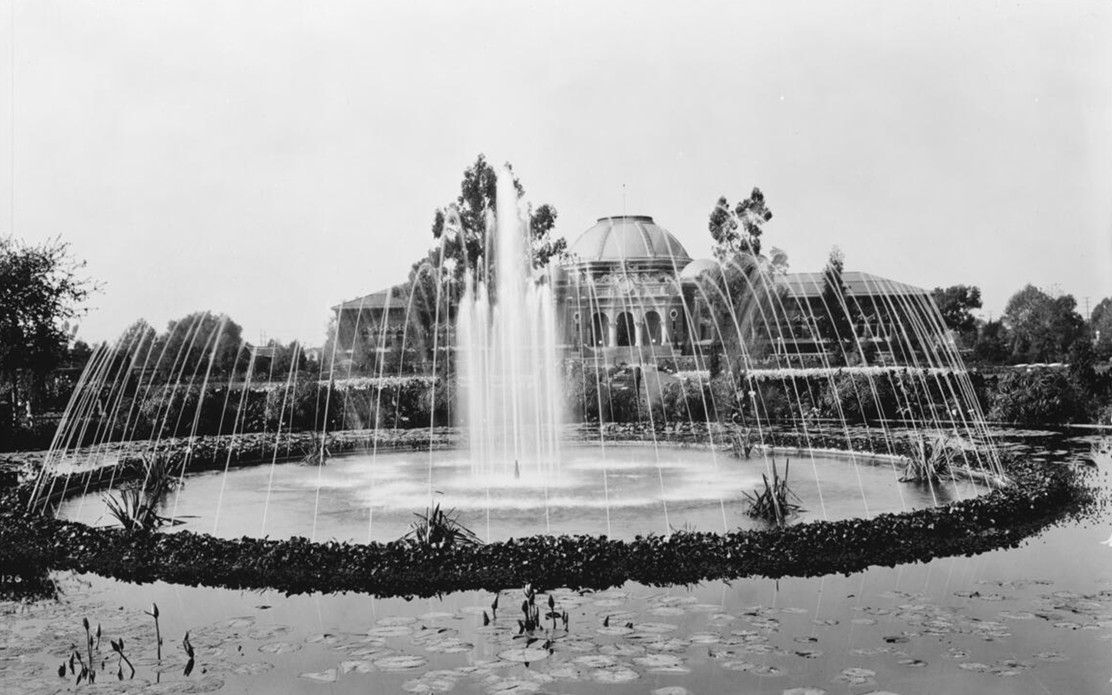 |
|
| (ca. 1925)* – The central fountain in Exposition Park, with arched water jets and surrounding plantings, appears to flow into a lily pond in the foreground. The domed History and Art Museum (later the Natural History Museum) rises behind the hedged perimeter of the sunken gardens. |
Historical Notes November 6, 1913, marked the beginning of a two-week, city-wide celebration that opened Exposition Park and its facilities (also the LA Aqueduct). Click HERE to see the Commemorative of the Official Opening of the LA Aqueduct and Exposition Park. The central fountain in Exposition Park’s Rose Garden carries a symbolic legacy rooted in one of the most important infrastructure achievements in Los Angeles history—the completion of the Los Angeles Aqueduct. On November 5, 1913, water from the distant Owens River arrived in the San Fernando Valley, marking a turning point for the city’s growth. The following day, November 6, civic leaders gathered in what had recently been renamed Exposition Park to celebrate this monumental event alongside the formal dedication of the park’s new museums and cultural buildings. During the ceremony, a dramatic display featured a jet of water shooting 30 feet into the air in the center of the park, representing the arrival of Owens River water and the promise of a new era for Los Angeles. This temporary water feature was not part of a built fountain but rather a symbolic gesture using pressurized water connected to the new supply. It served to publicly visualize the lifeblood of the city’s future—a powerful stream of imported water that would make large-scale urban development possible. |
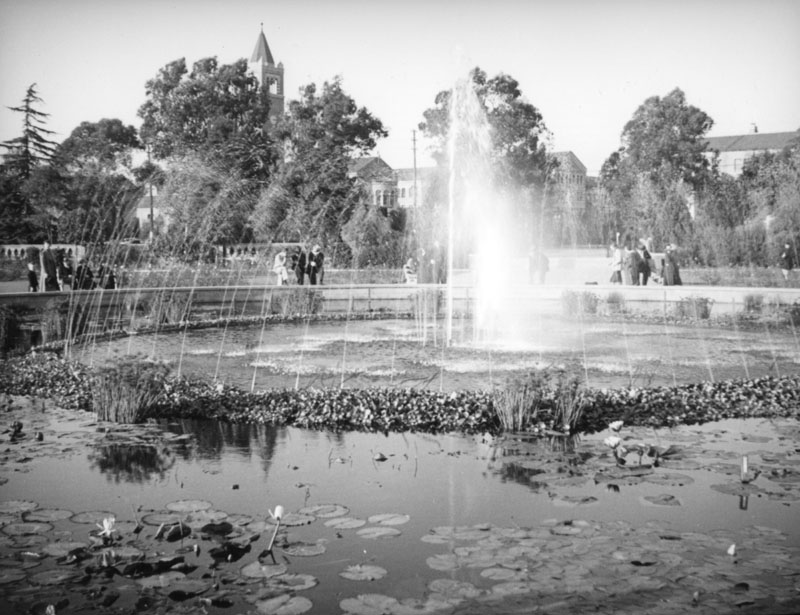 |
|
| (ca. 1937)* - Jets of water converge in the center of the fountain situated in the center of the Sunken Gardens in Exposition Park. The fountain was installed in 1913. Symbolically, it represents the terminus of the new LA Aqueduct, opened on Nobember 5th, 1913. |
Historical Notes On November 6, 1913, Exposition Park was formally dedicated, and became the home to a state Exposition Building and the county Museum of History, Science and Art. Senator John Works dedicated the fountain as a commemoration of the Owens River/Los Angeles Aqueduct whose grand opening coincided with the opening of Exposition Park. As the Senator left the platform, a jet of water shot up 30 feet. Plans were also announced that day for a permanent commemorative fountain to honor the aqueduct’s achievement. A grand design was proposed: a monumental fountain with a 100-foot shaft flanked by sculptures personifying the spirit of California and the civic advancement of Los Angeles. Though endorsed by prominent figures like Senator John D. Works, this ambitious memorial was never built—likely due to shifting priorities and the onset of World War I. Click HERE to see the Opening Ceremonies of the LA Aqueduct. Click HERE to see the Commemorative of the Official Opening of the LA Aqueduct and Exposition Park. |
 |
|
| (ca. 1930s)* - The lily-filled fountain at the center of Exposition Park’s sunken gardens reflects the formal landscaping of the era. In the distance, framed by trees and plantings, stands USC’s Mudd Memorial Hall of Philosophy, visible just beyond the park’s edge. Photo by Bob Plunkett. |
Historical Notes During a 1921 horticultural exposition at Exposition Park, a circular lily pond was installed in the center of what was still an undeveloped grassy field, offering an early glimpse of the site's potential. This modest feature marked the first formal water element in the area. Between 1926 and 1928, the space was dramatically transformed into the Sunken Garden, later known as the Rose Garden. Over 15,000 rose bushes were planted in symmetrical beds, and a new central fountain—elegant though far simpler than the grand memorial fountain originally envisioned in 1913—was installed as the garden’s visual anchor. While this later fountain lacked the scale of the proposed aqueduct monument, it carried forward its symbolic legacy, honoring the arrival of Owens River water and the vital role it played in shaping Los Angeles. |
Then and Now
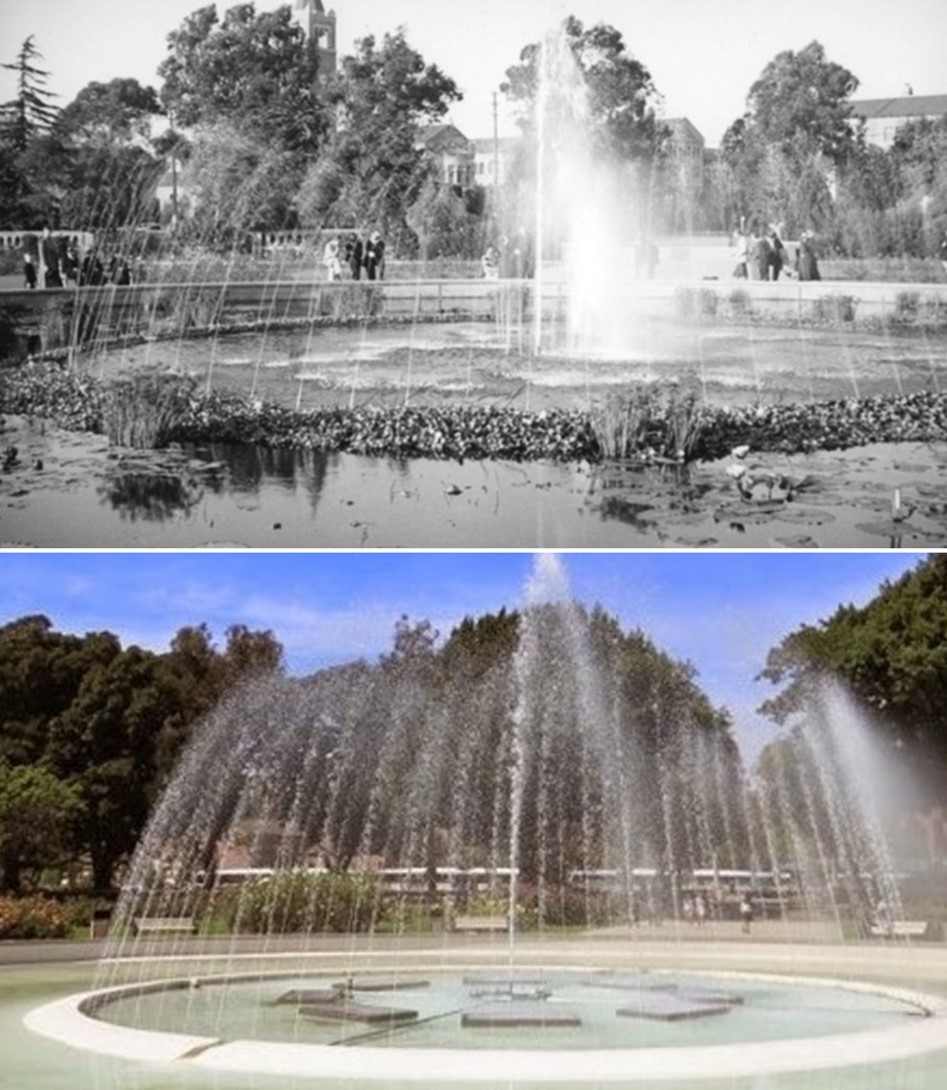 |
|
| (1930s vs. 2014)* - Then and Now - Jets of water converge in the center of a fountain situated in the center of the sunken rose gardens in Exposition Park. The fountain (and park) was dedicated on November 6th, 1913. Symbolically, it represents the terminus of the new LA Aqueduct, opened a day earlier on November 5th, 1913. Click HERE to see the Commemorative of the Official Opening of the LA Aqueduct and Exposition Park. |
* * * * * |
Coliseum - Pre-Construction
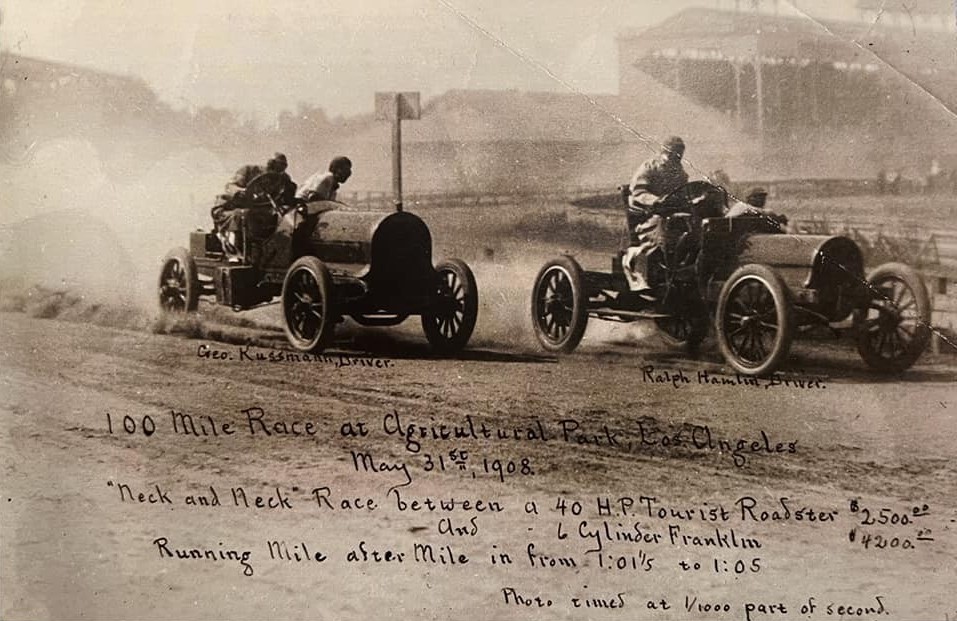 |
|
| (1908)* - Auto racing at Agricultural Park. In 1899, Los Angeles annexed the park, outlawing gambling. The State of California acquired the site in 1908 and by 1913, it was rebranded as Exposition Park. Photo courtesy of Gary Helsinger. |
Historical Notes Originally established in 1872 as Agricultural Park, the 160-acre site began as a farmers' fairground but soon became notorious for gambling and a variety of racing events, including horse, dog, camel, bicycle, and automobile races. In 1899, Los Angeles annexed the park, outlawing gambling. The State of California acquired the site in 1908, and by 1913, it was rebranded as Exposition Park, featuring sunken gardens, museums, and cultural institutions, marking the end of its racing era. |
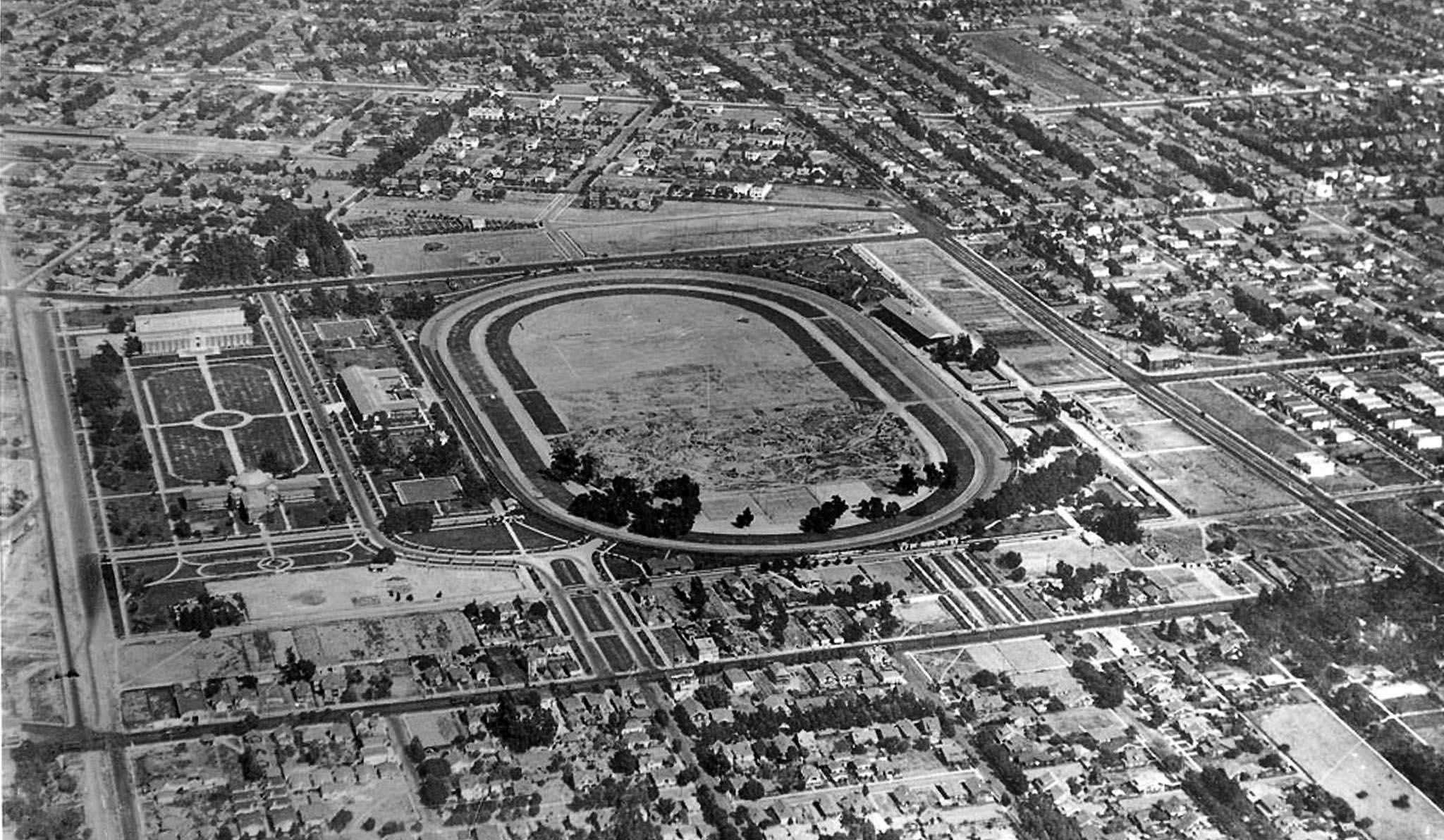 |
|
| (1918)* - This aerial photo was taken five years after Nov. 6, 1913, when Exposition Park first opened. Note the mile-long auto track, a feature that disappeared after the Coliseum was built in 1923. |
Historical Notes The Los Angeles Memorial Coliseum, constructed in 1922/1923 within the boundaries of the old race track, would add another layer of historical significance to Exposition Park. |
Coliseum Construction
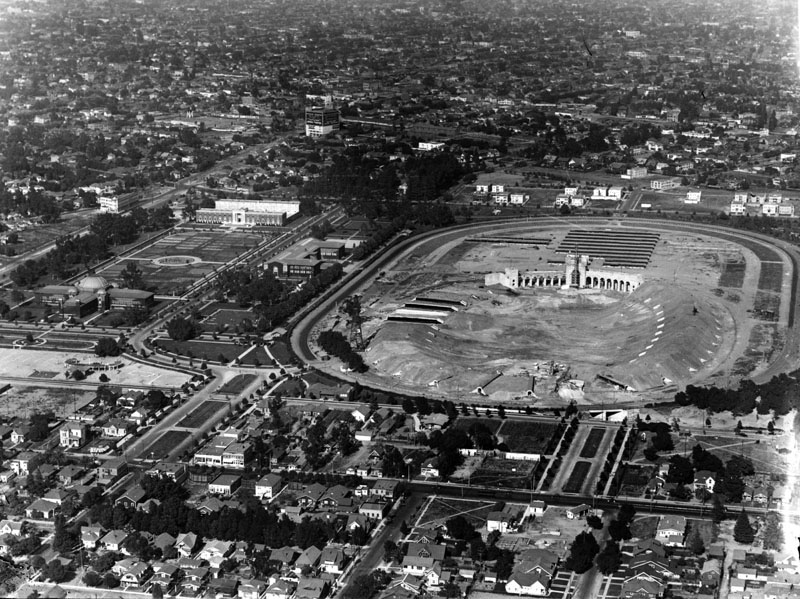 |
|
| (1922)^ - Aerial view of Expositon Park in 1922. On the left can be seen the Rose Gardens surrounded by the state Exposition Building and the county Museum of History, Science and Art (later Natural History Museum). On the right is the Coliseum under construction. |
Historical Notes The Coliseum was commissioned in 1921 as a memorial to veterans of World War 1 (rededicated to veterans of all wars in 1968). The official ground breaking ceremony took place on December 21, 1921 with work being completed in just over 16 months, on May 1, 1923. Designed by John and Donald Parkinson, the original bowl's initial construction costs were $954,873. |
 |
|
| (1922)* - Aerial view of the Coliseum still under construction. |
Historical Notes When the Coliseum opened in 1923, it was the largest stadium in Los Angeles with a capacity of 75,144. In 1930, however, with the Olympics due in two years, the stadium was extended upward to seventy-nine rows with two tiers of tunnels, expanding the seating to 101,574. The now-signature torch was added. For a time it was known as Olympic Stadium. The Olympic cauldron torch which burned through both Games remains above the peristyle at the east end of the stadium as a reminder of this, as do the Olympic rings symbols over one of the main entrances. |
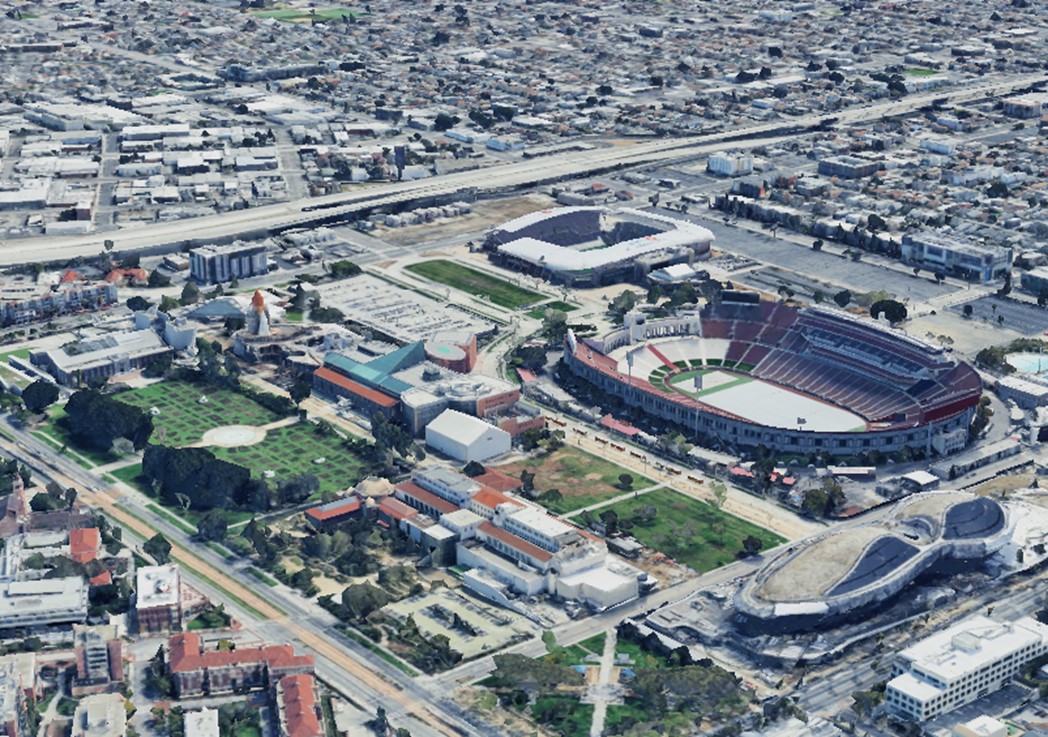 |
|
| (2024)* - Contemporary aerial view of the Coliseum and Exposition Park. |
Then and Now
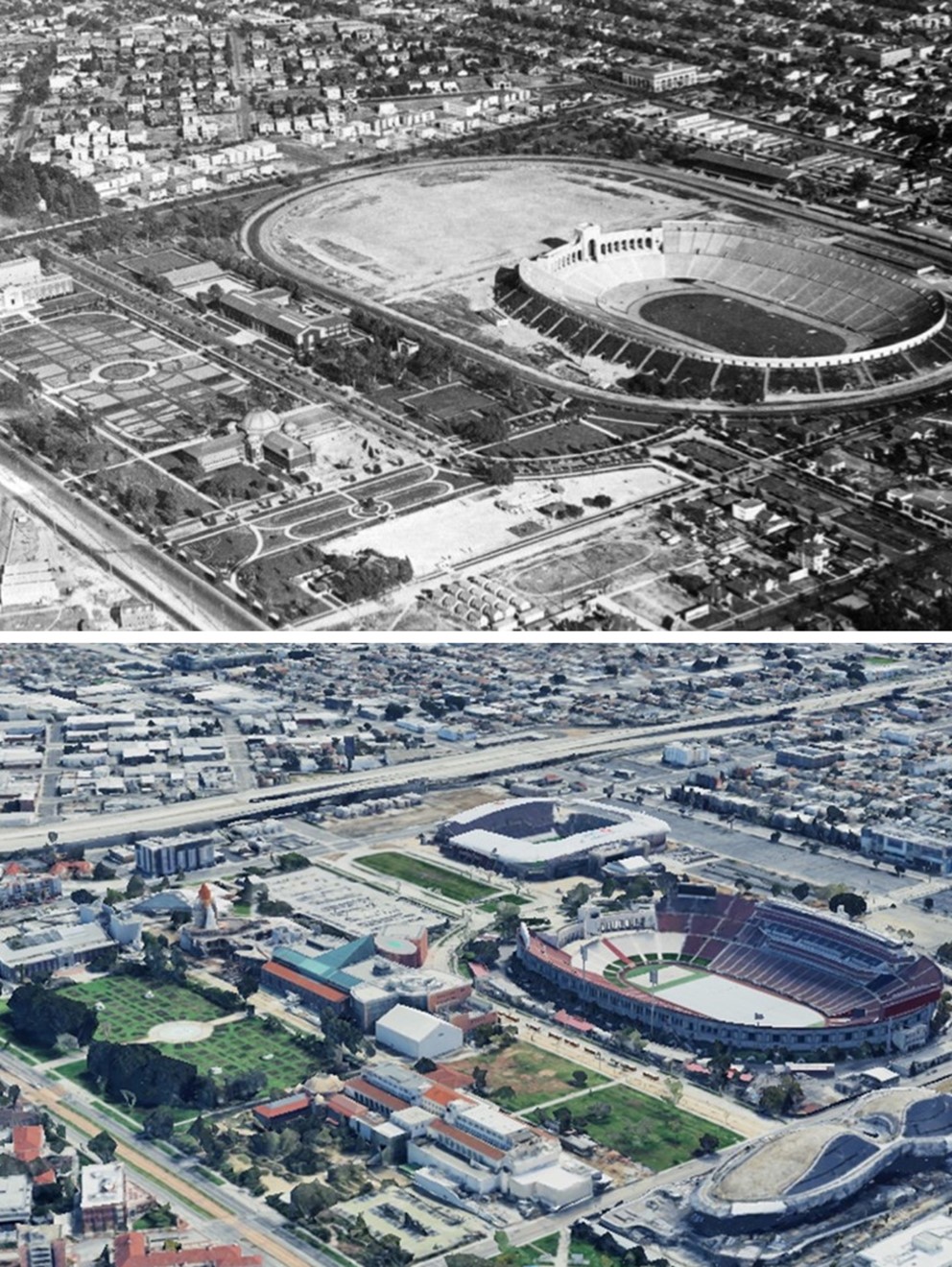 |
|
| (1922 / 2024)* - Aerial view looking down at the Coliseum during construction and how it looks today. Note: In 1930 the stadium was extended upward to expand the seating capacity for the 1932 Olympics. |
Then and Now
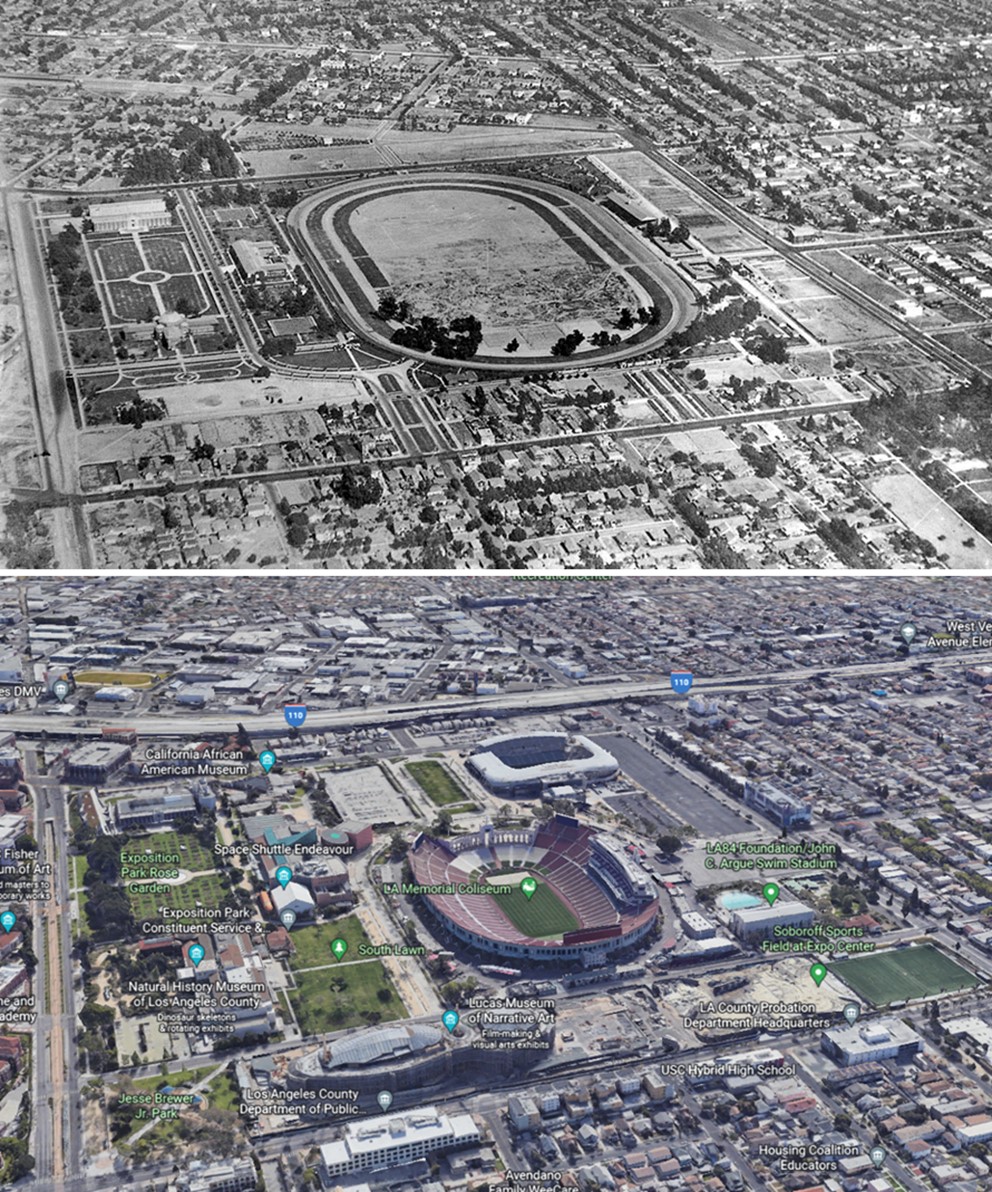 |
|
| (1918 vs. 2022) – Aerial view looking down at what was once a mile-long auto track in Agricultural Park (renamed Exposition Park in 1913) right where the LA Memorial Coliseum stands today. Note that the entire Coliseum was built within the infield of the race track. The Sunken Rose Garden (center-left) is still there as well as a couple of historic buildings which are now part of the Natural History Museum and the California Science Center. |
Historical Notes Click HERE to see more Early Views showing the Construction of the Los Angeles Memorial Coliseum |
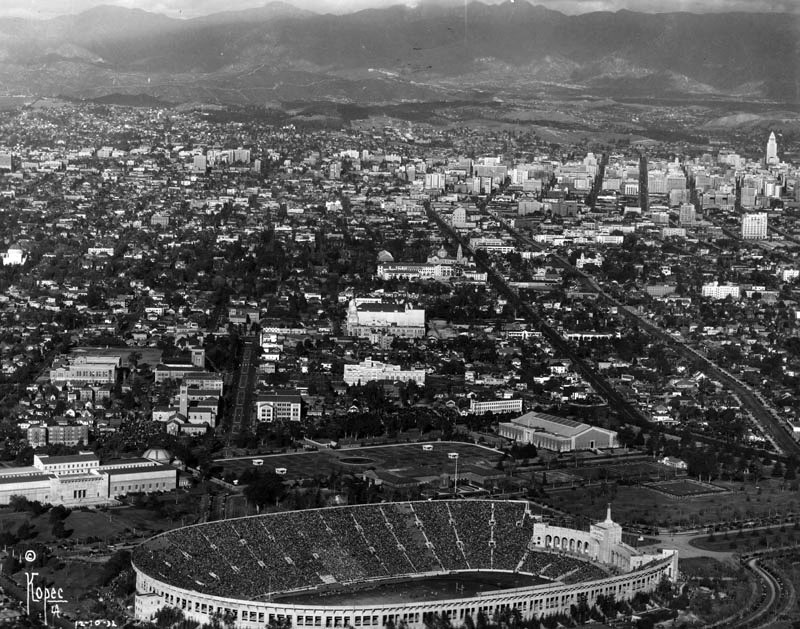 |
|
| (1932)^ - Aerial view of Los Angeles, looking north, with the Coliseum in the foreground. Taken from the Goodyear airship. Downtown LA is in the distant background. Between downtown and the Coliseum can be seen the University of Southern California (USC). |
Historical Notes In 1932, Los Angeles hosted the Olympic Games at the Coliseum. Click HERE to see more Early Views of the Los Angeles Memorial Coliseum during the Olympics. |
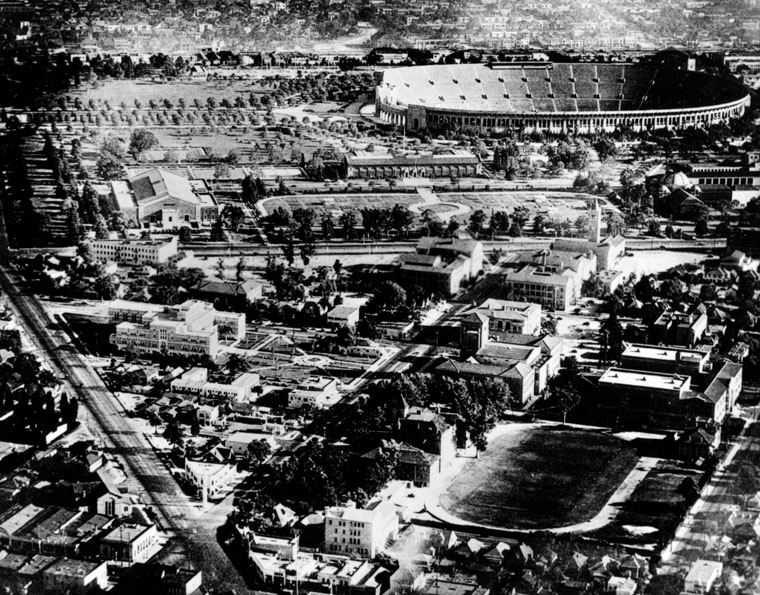 |
|
| (n.d.)^ - Aerial view of the University of Southern California (foreground) and the L.A. Memorial Coliseum. |
Historical Notes Cick HERE to see more in Early Views of U.S.C. |
* * * * * |
2nd Street Tunnel
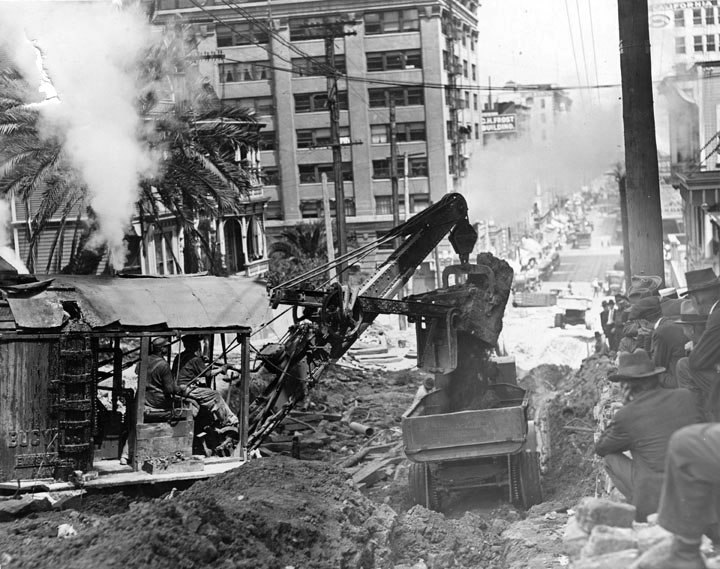 |
|
| (1921)^ - Two men seated in the cabin of a Bucyrus backhoe operate the machine as steam rises from the top. One man holds onto the rope that leads to the pulleys. Another man operates the levers that dumps a mouthful of dirt into a dump truck. They are digging out Bunker Hill to construct the 2nd Street Tunnel. |
Historical Notes The 2nd Street Tunnel was built to relieve congestion on the earlier 3rd Street Tunnel. Construction actually began in 1916 but was stalled for five years by litigation. Steam shovels didn't begin tearing into the hillside until April 11, 1921. |
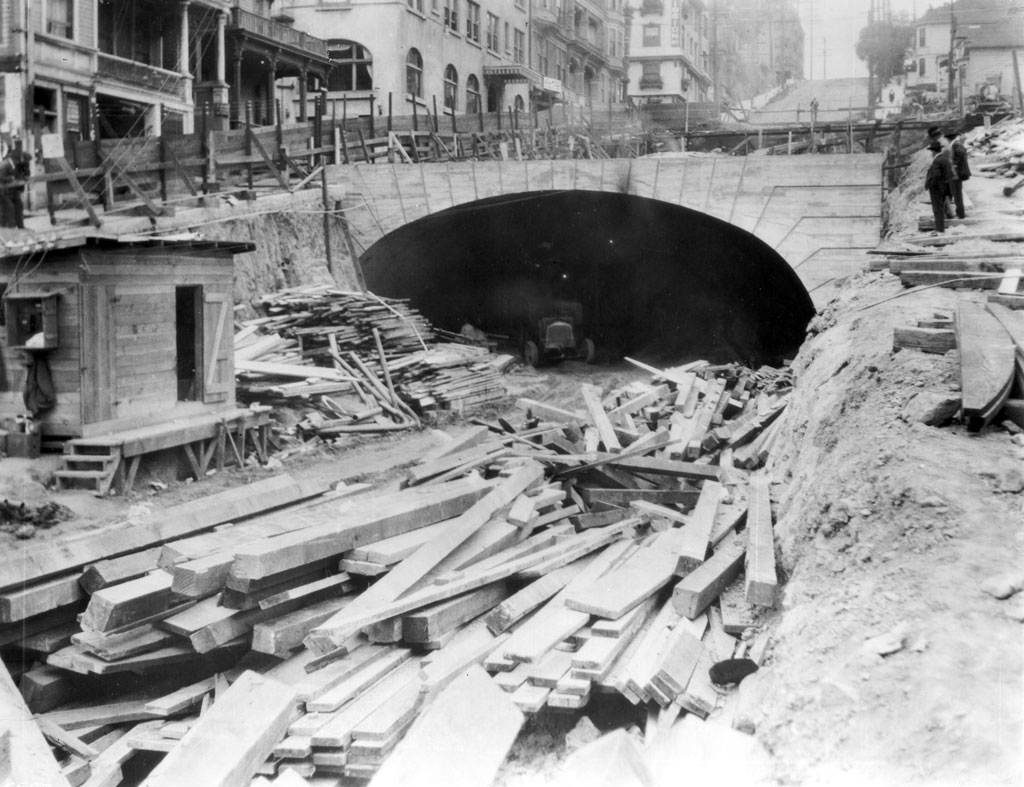 |
|
| (ca. 1921)^^ - Hill Street entrance to the 2nd Street tunnel under construction. A ditch filled with lumber stands in the foreground, quickly meeting an archway under which an automobile can be seen parked. A small workman's shack has been erected to the left, and scaffolding lines the street on the bridge above and the road leading up to it on the left side. Two men in suits stands amidst the building materials at the right side of the ditch. High rise buildings and an inclined street can be seen in the background. |
Historical Notes For a time, it seemed the tunnel would never open; it became the laughingstock of the city. But by July 25, 1924, workers had finally bored 1,502 feet through Bunker Hill’s shale and sandstone.* |
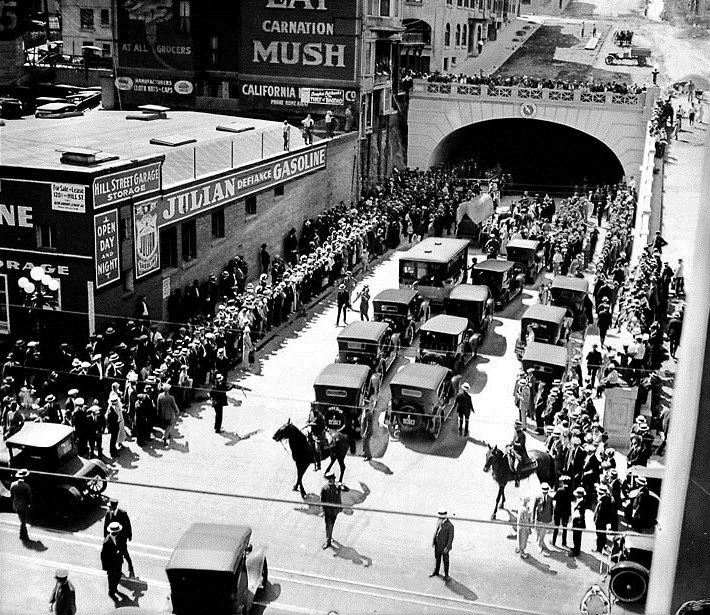 |
|
| (1924)* - Grand opening of the 2nd Street Tunnel on July 25, 1924. A procession of dignitaries await the start of the parade while police on horseback maintain crowd control. |
Historical Notes Construction of the 2nd Street Tunnel began in 1916, and wasn't completed until 1924, with its formal opening on July 25 of that year. The distinctive white tiles, which give the tunnel its glow, came from Germany, which caused controversy at the time due to the legacy of World War I and protectionist feelings.^ |
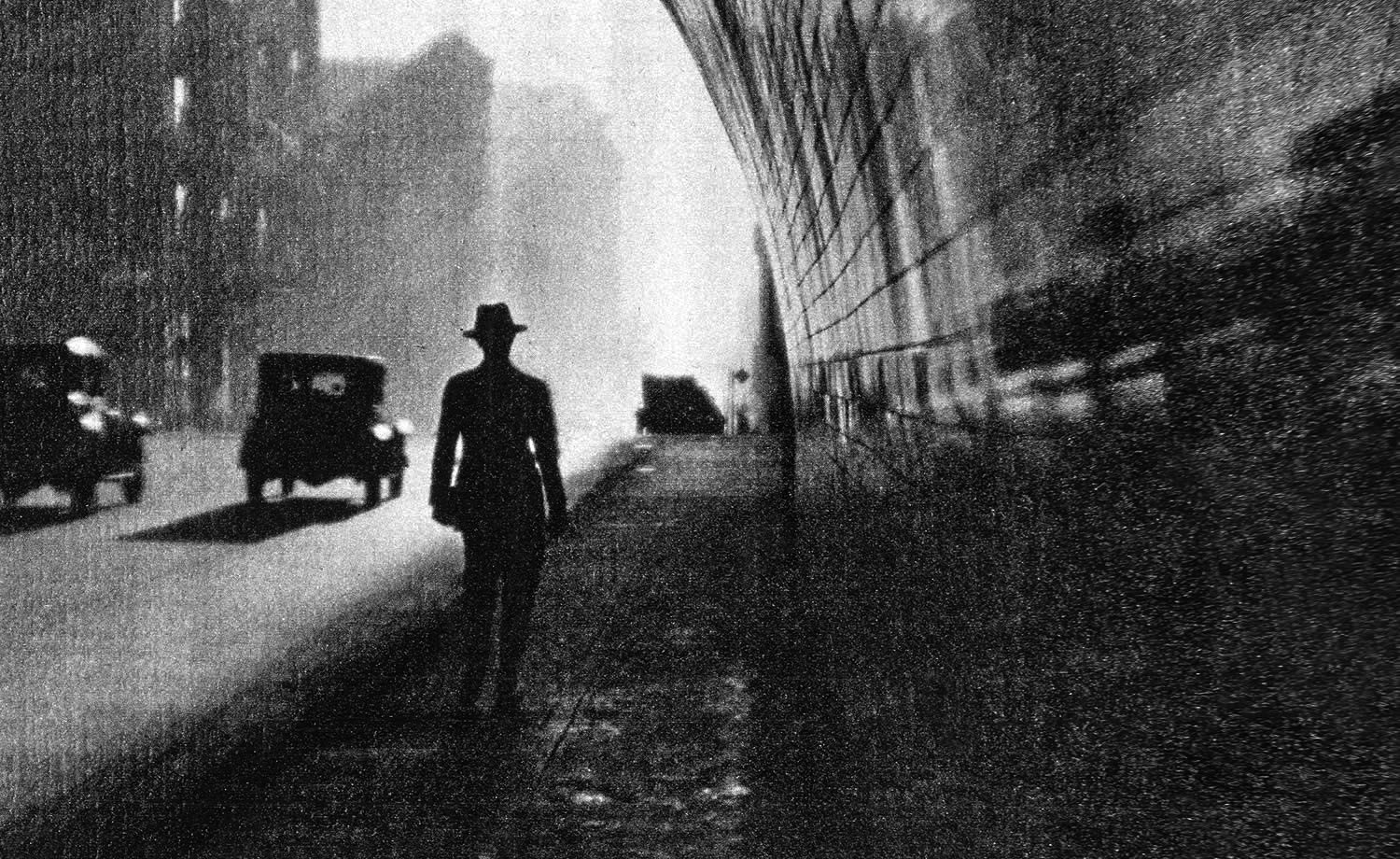 |
|
| (1930s)^ – Noir image showing a man wearing a hat walking through the 2nd Street Tunnel. |
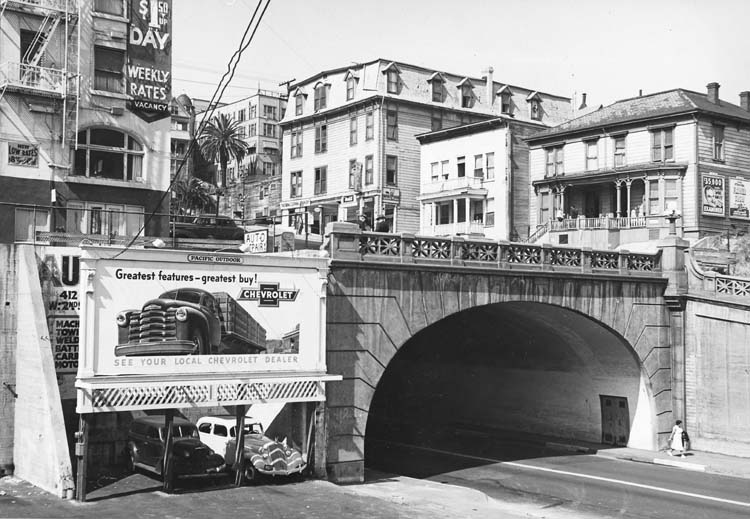 |
|
| (1950s)*^^ - Close-up view of the east end of the 2nd Street Tunnel showing the deterioration of the neighborhood’s boarding houses and residential hotels. |
Historical Notes The last days of Bunker Hill: this view from the Second Street tunnel clearly shows the deterioration of the neighborhood’s boarding houses and residential hotels. The Hill would soon be scraped clean to make way for “redevelopment”. |
 |
|
| (1950s)** – View looking at the eastern portal of the 2nd Street Tunnel showing a line of cars heading toward the civic center. Hill Street is in the foreground. |
.jpg) |
|
| (2017)* – Google street view showing the eastern portal of the 2nd Street Tunnel as seen from Hill Street. |
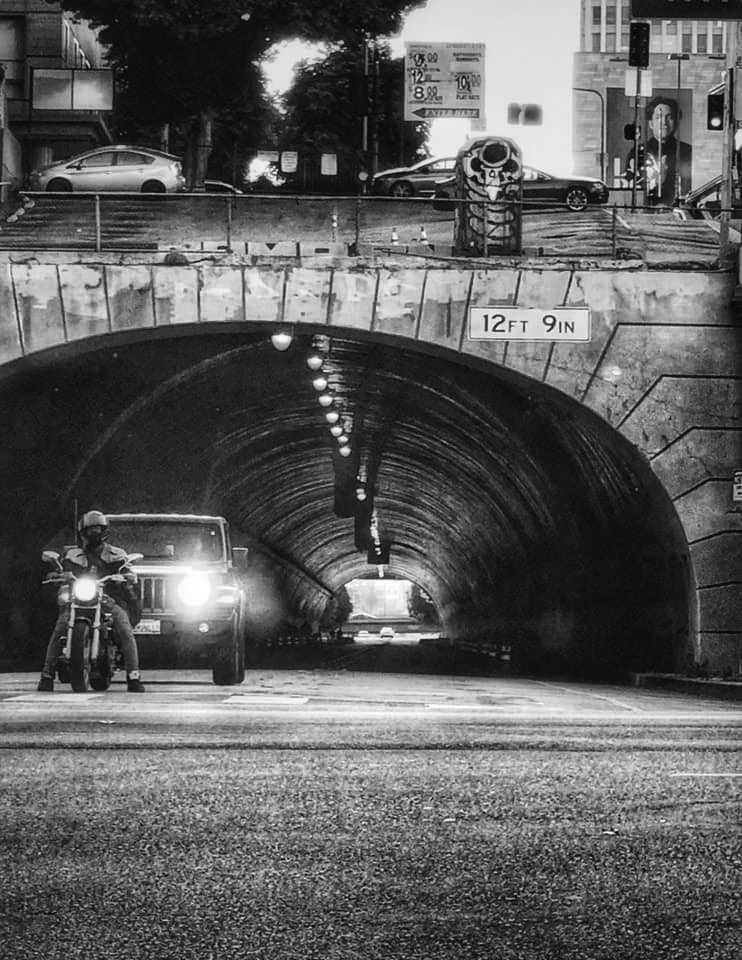 |
|
| (2020)^.^ – Eastern portal of the Second Street Tunnel. Photo by Carlos G. Lucero |
2nd Street Tunnel (Western Portal)
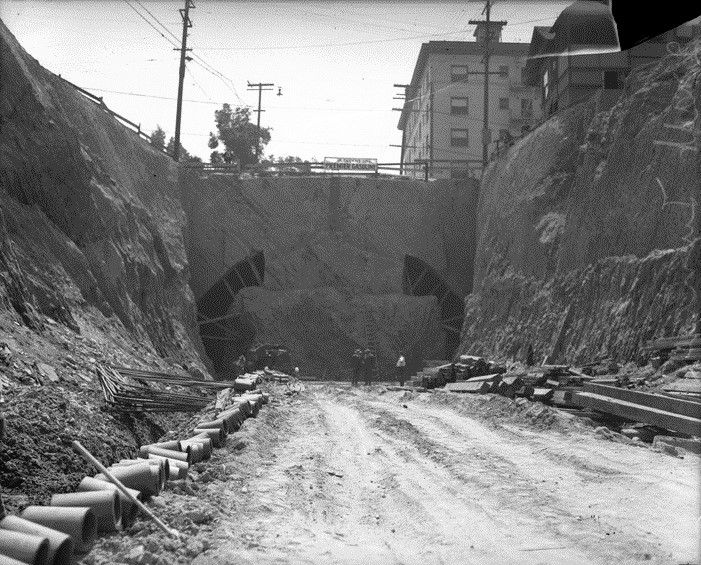 |
|
| (1921)*^ – View showing the 2nd Street Tunnel construction site before the boring of the tunnel, from the Figueroa Street side (Western Portal). The multi-story building at upper-right is the Stanley Hotel and Apartments. |
Historical Notes The above photo was published in the Aug. 22, 1921, Los Angeles Times with story claiming the tunnel would be finished in less than a year. The tunnel did not open for nearly three years. |
 |
|
| (1950s)*^^ - View looking east toward the west end of the 2nd Street Tunnel. The Stanley Hotel and Apartments stand above the tunnel on Bunker Hill. In the distance can be seen the dome of the Dome Hotel and Apartments on the SW corner of 2nd and Hill streets. Bunker Hill would soon be scraped clean to make way for “redevelopment”. |
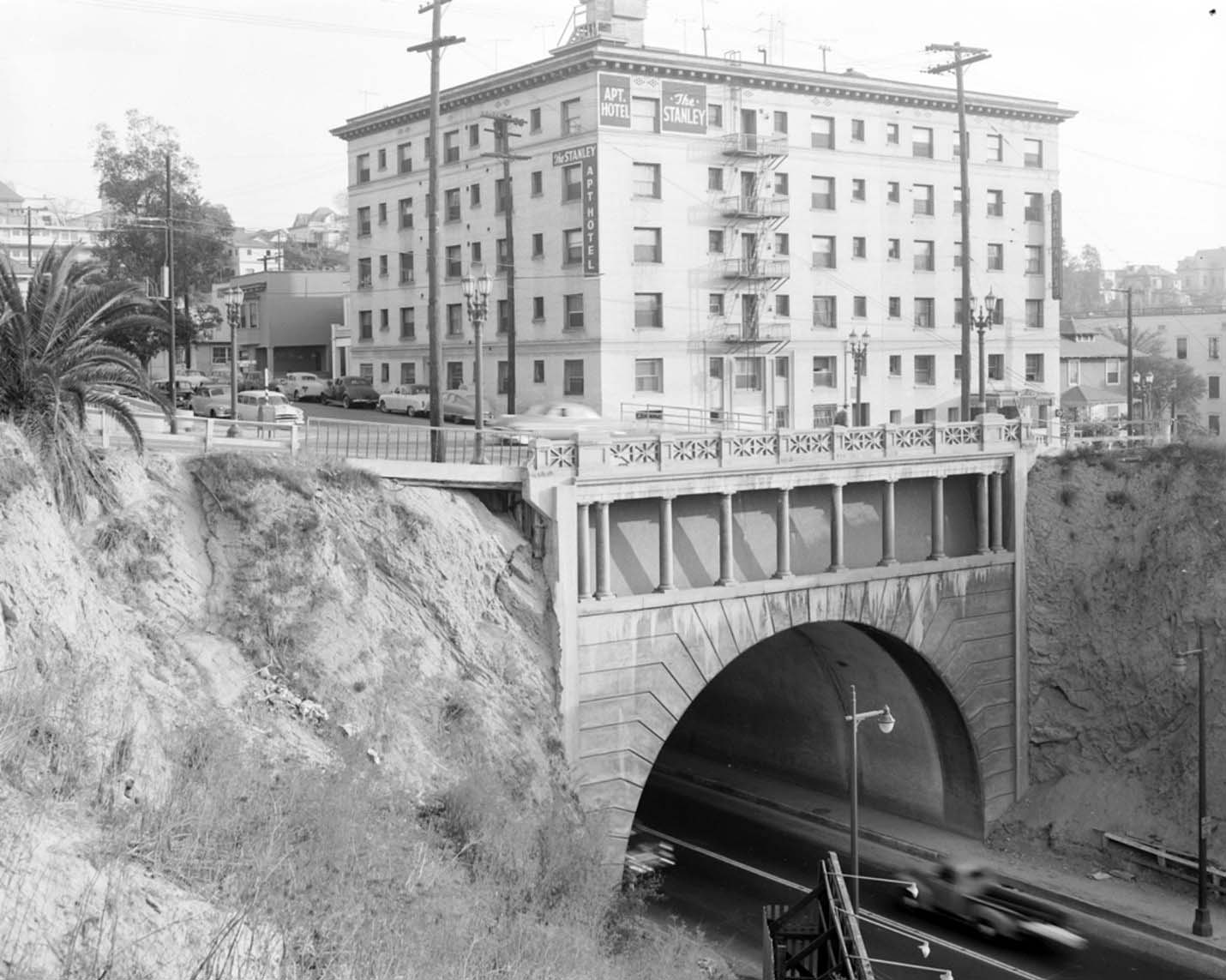 |
|
| (1950s)*++ – Close-up view showing the western portal to the 2nd Street Tunnel with the Stanley Hotel and Apartments above (demolished in 1966) for the redevelopment of Bunker Hill. |
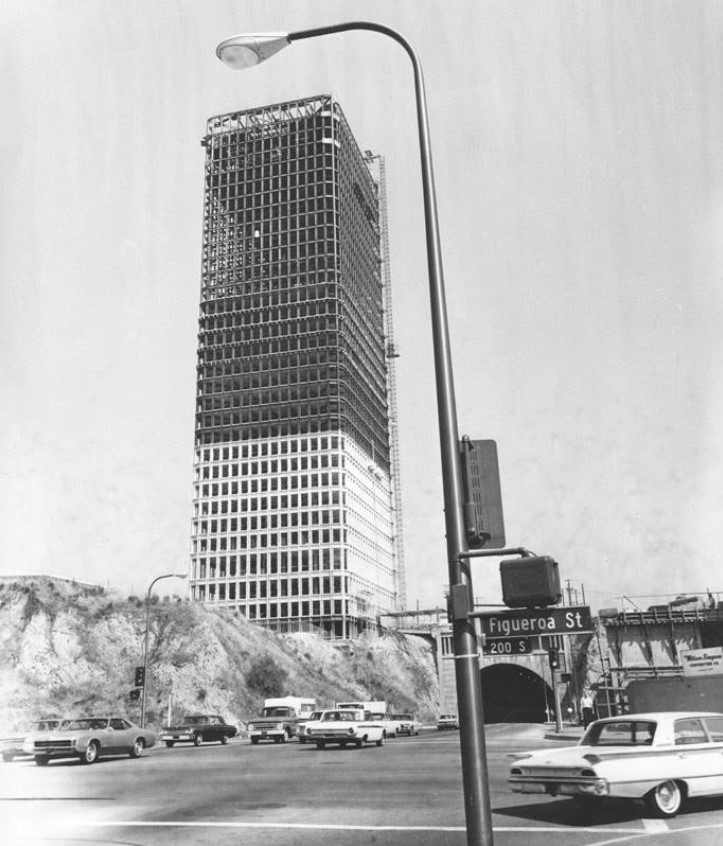 |
|
| (1968)#+ – View looking east toward the west end of 2nd Street Tunnel as seen from the southwest corner of 2nd and Figueroa. Bunker HIll Tower (completed in 1968) is seen near the tunnel. |
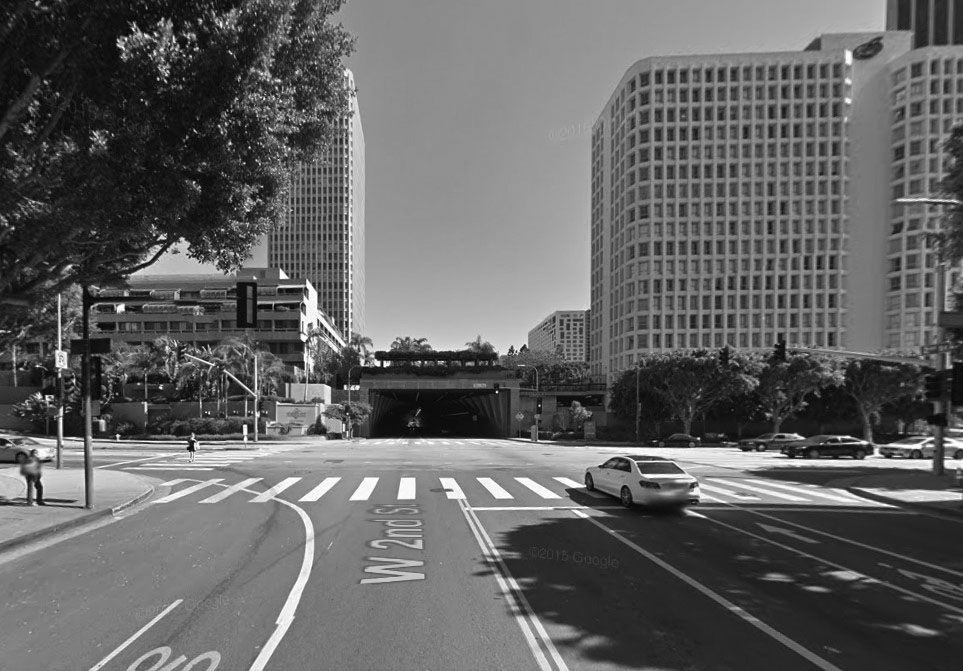 |
|
| (2015)##^* – Google street view showing the west end of the 2nd Street Tunnel as it appears today. |
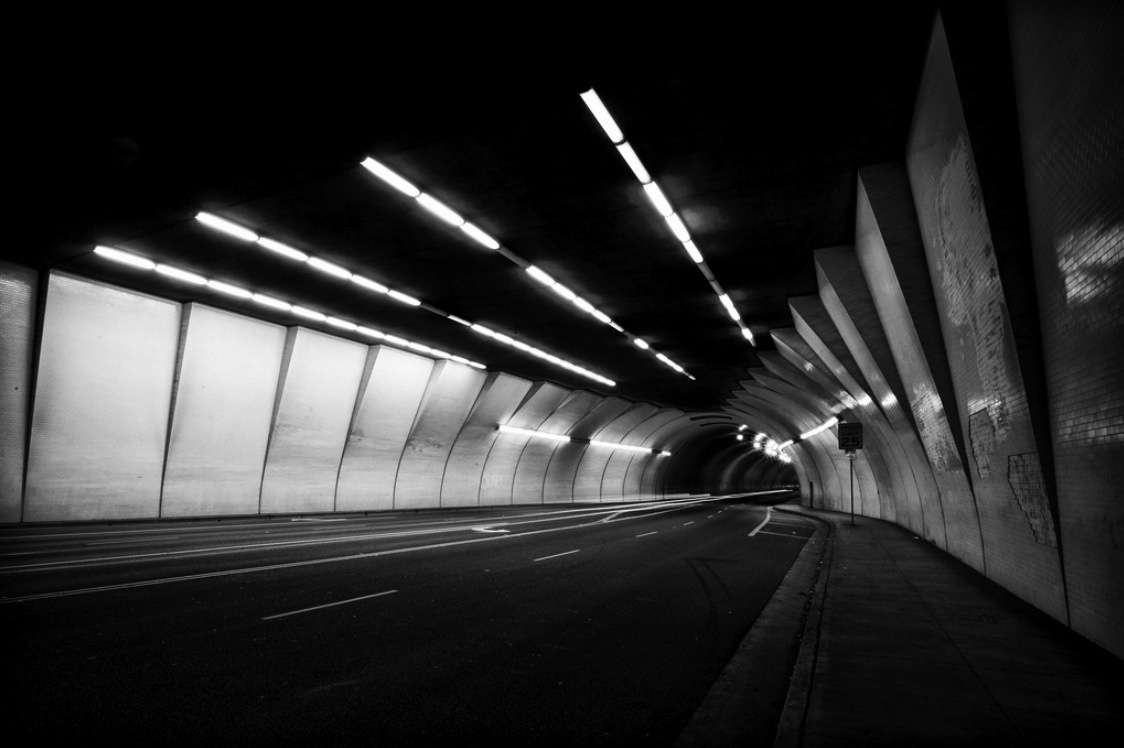 |
|
| (2012)++^ – View showing the west entrance of the 2nd Street Tunnel in downtown Los Angeles. Photo by Rian Long |
Historical Notes The tunnel's two entrances are very different in character – "the grittier east entrance and the glowing aperture of the west side, with flaring buttresses reminiscent of the shell of the Hollywood Bowl." The tunnel creates interesting light textures especially at night. It’s been frequently used as a backdrop in movies and even more frequently in car advertisements.^ |
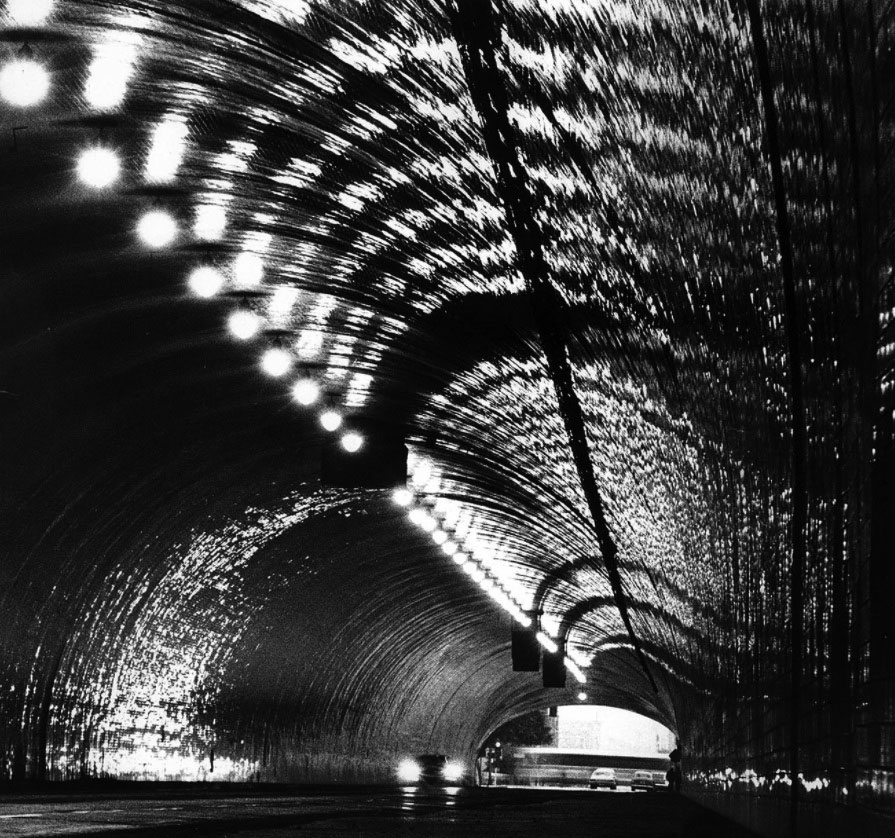 |
|
| (1978)*## - Headlights bounce around on the tiled surface of the 2nd Street Tunnel in downtown Los Angeles during light rain. |
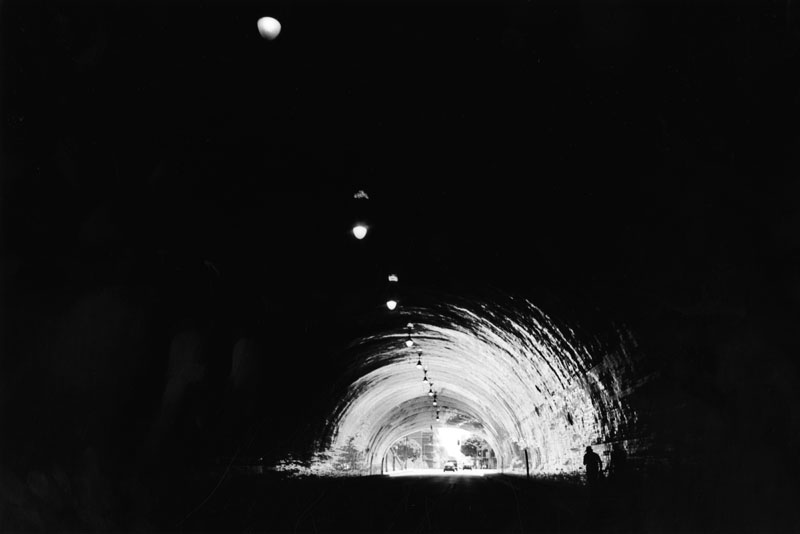 |
|
| (2000)^ - As if straight out of a science fiction movie, cars seem to spill out of the darkness and into the spiral-like light of day. The photo was taken from inside the 2nd Street Tunnel, two pedestrians walking on the right side, and a row of ceiling lights that are spaced out through the entire tunnel are the only visible things inside this black hole. |
Historical Notes The 2nd Street Tunnel in Los Angeles is probably the most recognizable city landmark most Americans have never heard of. The tunnel — a 1,500-foot-long bore lined with white tile, like a bathroom that never ends — has been used as an exterior in dozens of films and TV shows, most famously in the sci-fi masterpiece “Blade Runner.” |
* * * * * |
Glendale
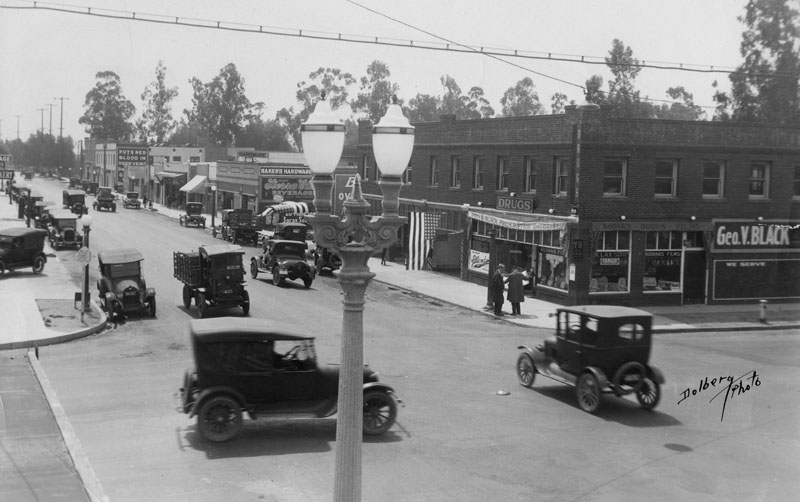 |
|
| (ca. 1920)^ - Looking south at an intersection of Los Feliz Blvd. and San Fernando Rd. Various cars and trucks are traveling on the street. There are businesses on right side of the street some include: "Geo. V. Black prescription Druggist" and "Baker's Hardware". Information provided with the photograph states that Los Feliz Blvd. was formerly called Tropico Boulevard. |
Historical Notes Tropico was the name of the southern portion of Glendale, south of Windsor Road, between the late 1800s and 1918. The name "Glendale" had originated in the 1880s and was utilized north of Windsor Road. Political factions had divided the town in two. By the turn of the century, the commercial center of Tropico was at Central and San Fernando Road and its population was 700.^##^ |
 |
|
| (ca. 1920s)^ - A view of San Fernando Rd. looking north at an intersection of Los Feliz Blvd. Various cars and trucks have stopped at the intersection. There are businesses that run along both sides of the street some include: a drug store, a sports equipment store, the "Piggly Wiggly", "Tavern Buffet", "Glenwood Hotel" and a service station with gasoline pumps. |
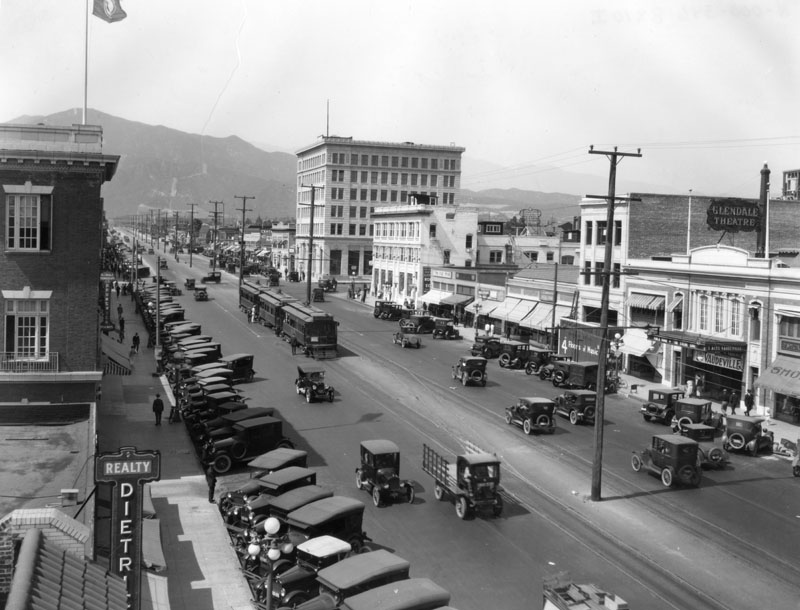 |
|
| (ca. 1920s)^ - View shows several automobiles travelling up and down the business section of Brand Boulevard, in Glendale. Note train stopped in the middle of the road to pick up and drop of passengers. |
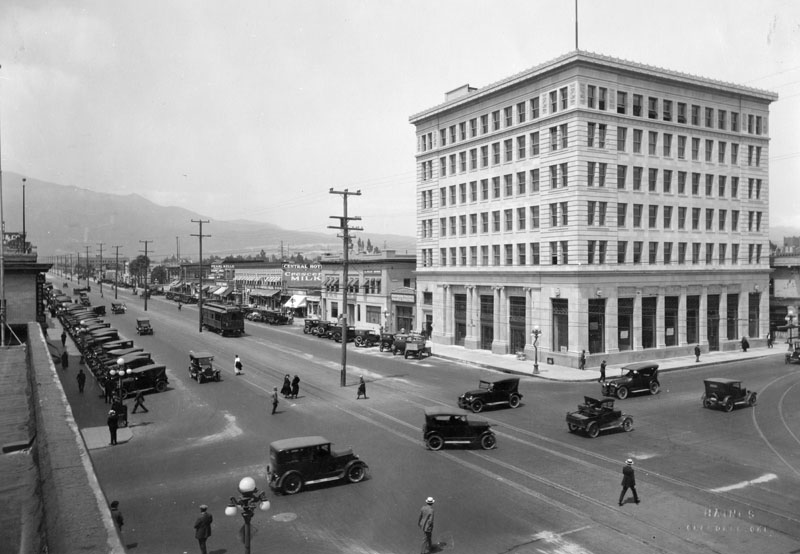 |
|
| (1924)^ - View of the corner of Brand and Broadway in Glendale. Note there are no street lights as pedestrians and automobiles cross the streets. Many businesses may be seen on both sides of the street including railroad tracks which run down the middle of this wide street. A large seven-story building is on the right. |
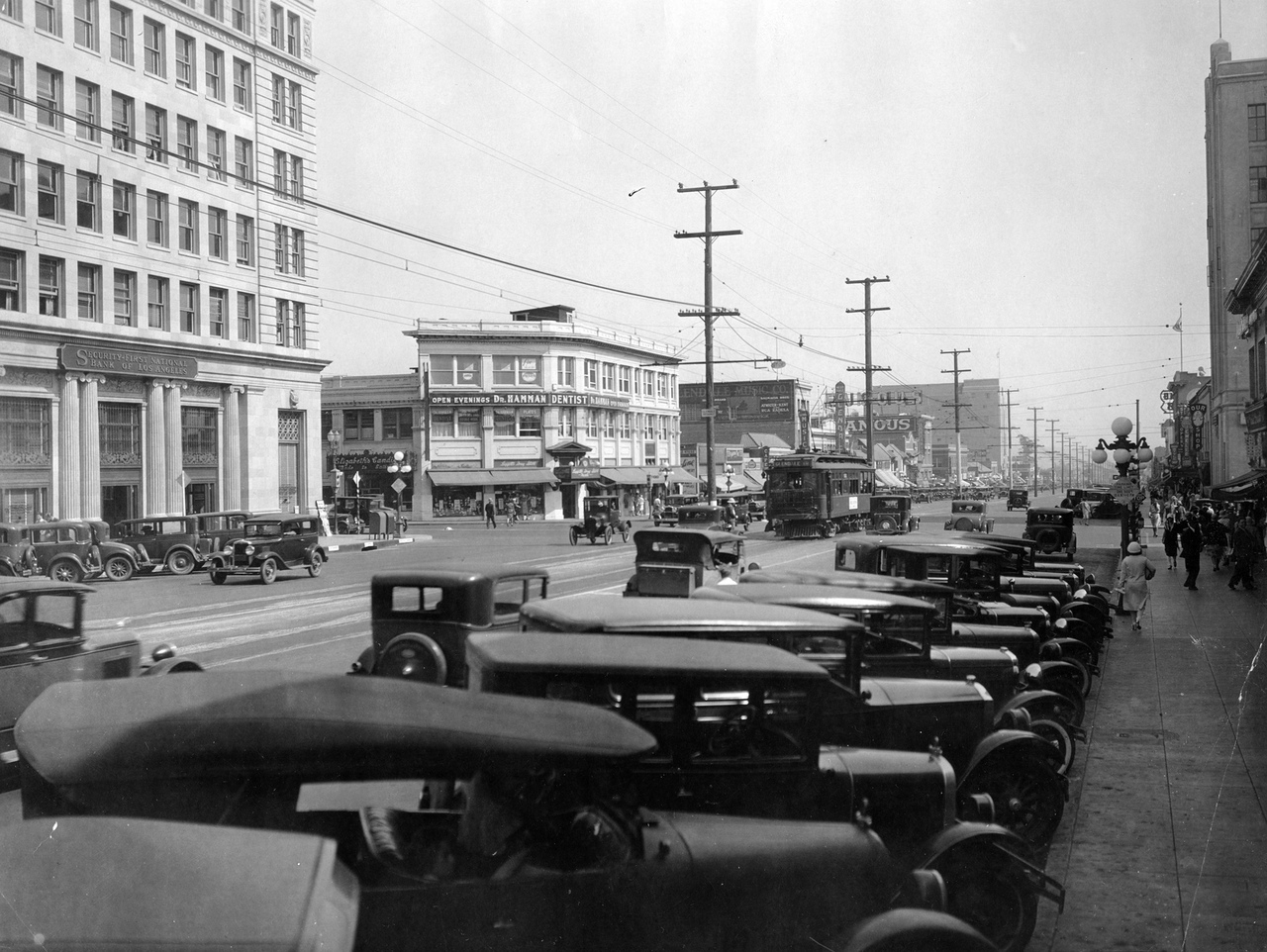 |
|
| (ca. 1920s)^##- Downtown Glendale, looking south on Brand Boulevard from Broadway. |
.jpg) |
|
| (1920s)^ - View of the Business Block on Brand Boulevard, in Glendale. The Palace Grand Theatre may be seen on the right. |
Historical Notes The Palace Grand Theatre was originally built and owned by Henry C. Jensen, who would later build the more palatial Raymond Theatre in Pasadena. The neo-classical building was designed by architect Robert G. Kitts. Construction on the Palace Grand began in August, 1914.^ |
Click HERE to see more Early Views of Glendale |
* * * * * |
Cahuenga Pass
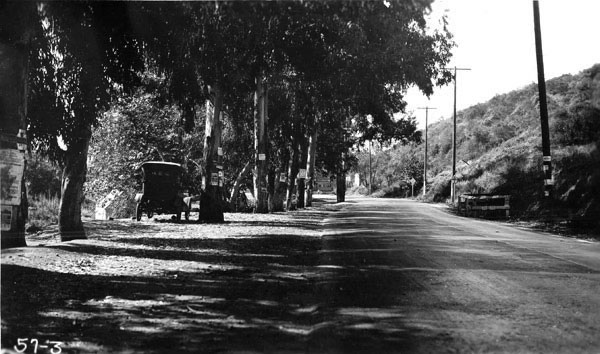 |
|
| (1921)**# - View of the highway through the Cahuenga Pass in 1921. A car is parked on the side of the road next to what appears to be a Eucalyptus tree. |
Historical Notes The Cahuenga Pass connects the Los Angeles Basin to the San Fernando Valley and is the lowest pass through the mountains. It was the site of two major battles, the Battle of Cahuenga Pass in 1831 (a fight between local settlers and the Mexican-appointed governor and his men, two deaths), and the Battle of Providencia or Second Battle of Cahuenga Pass in 1845 (between locals over whether to secede from Mexico. One horse and one mule killed) both on the San Fernando Valley side near present-day Studio City, and cannonballs are still occasionally found during excavations in the area. Along the route of the historic El Camino Real, the historic significance of the pass is also marked by a marker along Cahuenga Blvd. which names the area as Paseo de Cahuenga.^ |
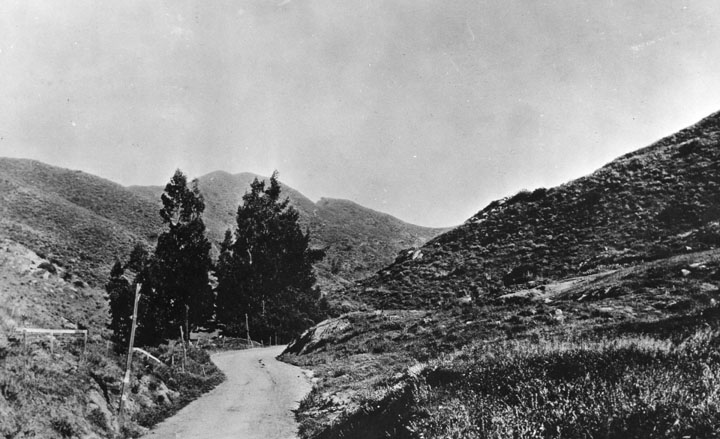 |
|
| (1882)^ - Before roads and rail lines were built, traveling through the Cahuenga Pass was by wagons and horses or on foot. This picture was taken at the summit. There is a saloon concealed among the trees. |
Click HERE to see more in Early Views of Cahuenga Pass |
* * * * * |
Hollywood Bowl
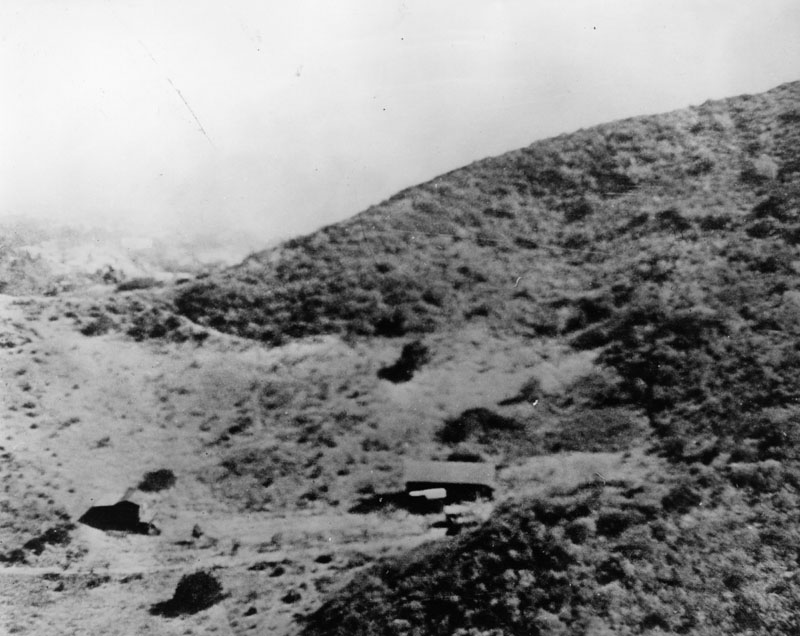 |
|
| (Early 1900s)^ - Site of present day Hollywood Bowl as it appeared at the turn of the century. |
Historical Notes The site of the Hollywood Bowl was chosen in 1919 by William Reed and his son H. Ellis Reed, members of the newly formed Theatre Arts Alliance who were dispatched to find a suitable location for outdoor performances.*^ |
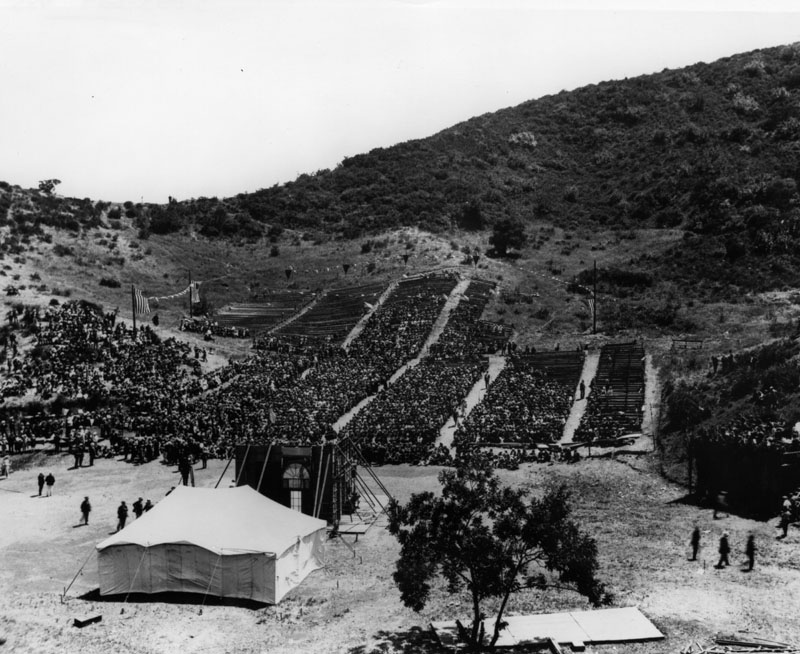 |
|
| (1922)^ - Rotary Club meeting held at the Hollywood Bowl prior to its official opening. |
Historical Notes At first, the Bowl was very close to its natural state, with only makeshift wooden benches for the audience, and eventually a simple awning over the stage. Not until 1926 did the Hollywood Bowl get permanent seating when a group known as the Allied Architects was contracted to regrade the surrounding, provide permanent seating and to construct a shell.*^ |
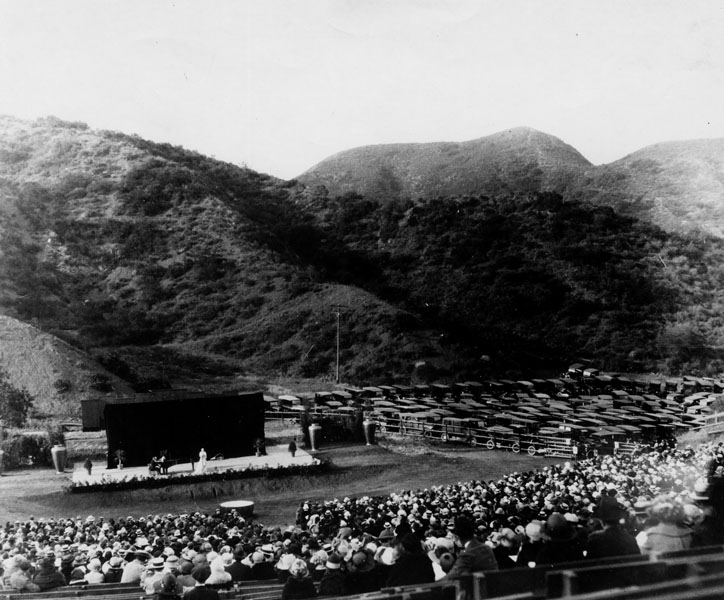 |
|
| (ca. 1922)^ - Concert by Rosa Paniella at the Hollywood Bowl. Note the full parking lot to the right of the stage. |
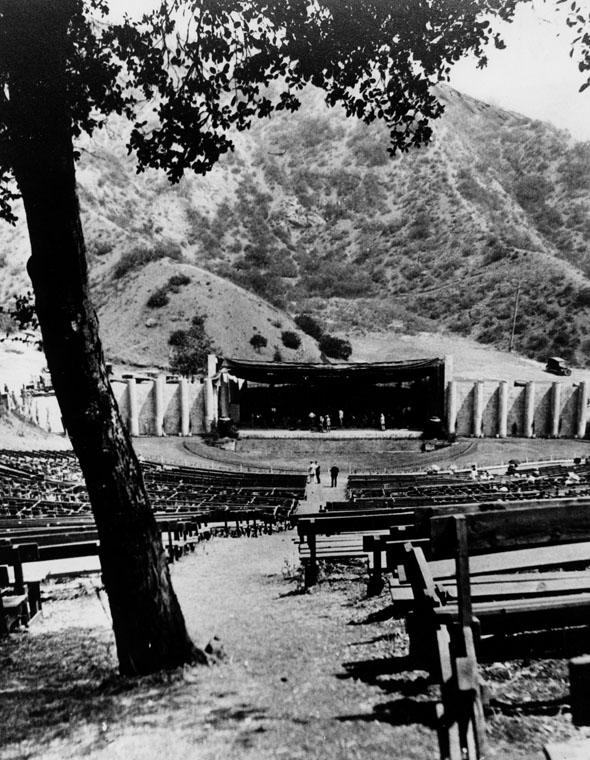 |
|
| (1922)^ - Hollywood Bowl at the first Symphony Under the Stars. This was the "Bowl's" official opening and was on the site of a natural amphitheater formerly known as the Daisy Dell. |
Historical Notes On July 11, 1922, with the audience seated on simple wooden benches placed on the natural hillsides of Bolton Canyon, conductor Alfred Hertz and the Los Angeles Philharmonic inaugurated the first season of music under the stars at the Hollywood Bowl. The Bowl was very close to its natural state, with only makeshift wooden benches for the audience, and eventually a simple awning over the stage. The Hollywood Bowl has been the summer home of the Los Angeles Philharmonic, since its official opening in 1922.*^ The price of admission was only 25 cents in 1922. |
Click HERE to see more in Early Views of the Hollywood Bowl |
* * * * * |
Please Support Our CauseWater and Power Associates, Inc. is a non-profit, public service organization dedicated to preserving historical records and photos. We are of the belief that this information should be made available to everyone—for free, without restriction, without limitation and without advertisements. Your generosity allows us to continue to disseminate knowledge of the rich and diverse multicultural history of the greater Los Angeles area; to serve as a resource of historical information; and to assist in the preservation of the city's historic records.
|
For more Historical Los Angeles Views click one of the following:
For Other Historical Views click one of the following:
See Our Newest Sections:
To see how Water and Electricity shaped the history of Los Angeles click one of the following:
Water:
Power:
* * * * * |
References and Credits
* DWP - LA Public Library Image Archive
^ LA Public Library Image Archive
^*The Valley Observed: Street Name Origins; Timeline of Valley History
*# blogdowntown: Third Street Tunnel
#* About.Com: History of Electric Vehicles
#+Facebook.com: Classic Hollywood/Los Angeles/SFV
#**U.S. Geological Survey Photographic Library
+**You-are-here.com: Buena Vsta-Broadway Bridge
+*^Daily Breeze: Redondo Beach's Endless Pier
+^^Facebook: Garden of Allah Novels
+##Anna Sklar, Brown Acres - An Intimate History of the Los Angeles Sewers (Santa Monica, CA: Angel City Press: 2008). Original photos from the City of Los Angeles Archives/City of Los Angeles Bureau of Engineering.
++^Flickr.com: 2nd Street Tunnel
#*^Library of Congress: Brand Boulevard, ca. 1915
*##LA Times: Dig Into History You'll Find Snake Oil; Historic Bridge to Downtown Reopens; First Car Through Hill Street Tunnel; 2nd Street Tunnel Opens
^##Metropolitan Transportation Library and Archive
###Denver Public Library Image Archive
#^#Santa Monica Public Library Image Archive
#++Facebook.com: Los Angeles Streets and Boulevards
*#*Historical Los Angeles Theatres: The Philharmonic Auditorium; Downtown Theatre; Quinn's Superba; Lyceum Theatre
^#^Noirish Los Angeles - forum.skyscraperpage.com; Windsor Square Aerial; Victoria Park; LARy Driver; Inceville - Inceville - palipost.com; Redondo Beach
*^#LincolnHeightsLA.com: Legion Ascot Speedway
**#KCET - Lost Tunnels of Downtown LA; A Brief History of LA Bridges; When L.A.'s Most Famous Streets Were Dirt Roads; How Oil Wells Once Dominated Southern California's Landscape; Three Forgotten Incline Railways; A Brief History of Bridges in Los Angeles
*#^History of Hermosa Beach - Maureen Megowan
^#*City of Redondo Beach HIstory
^^*Early Downtown Los Angeles - Cory Stargel, Sarah Stargel
***Los Angeles Historic - Cultural Monuments Listing
**^Historicechopark.org: Echo Park Lake
^*#California State Library Image Archive
*^*California Historical Landmarks Listing (Los Angeles)
*^^Nuestra Señora la Reina de los Ángeles: losangelespast.com; Pinterest: losangelespast.com
^^^Aerofiles - US Aviation Firsts
***^Oviatt Library Digital Archives
^**^Pinterest: Splinters n Speed; Cars - Bertrand Lacheze; Beverly Boards Motorcycle Racing
*^^^Highland Park - amoeba.com
*^#^Huntington Digital Library Archive
^^^*Cinema Treasures: Quinn's Superba Theatre
^*^*Beverly HIlls Patch: The Beverly Hills Speedway
^#^^El Pueblo de Los Angeles Historical Monuments Listing
^^*#UCLA Library Digital Archive
^^^#Los Angeles Fire Department Historical Archive
*#^*USC Facebook.com
*#^^LAPL-El Pueblo de Los Angeles Historical Monument Photo Archive
*^*^Big Orange Landmarks: Cesar E. Chavez Avenue Viaduct
*^^*Vintage Los Angeles - Facebook: Pacific Telephone Switchboard
*^*#Santa Monica Beach Stories
^###Exposition Park History - Expositionpark.org
*^##LA Times: What's in a name? A family's history, Sanchez Street
*##*Chatsworth Historical Society
*#^#Flickr.com: Walking Over Santa Monica
^##^Glendale Historical Society
^#^*Facebook.com - City of Angels: Cyclone Racer
##^*Google Maps
##*^Ballona Blog
##++Facebook.com - Beverly Hills Heritage
^^^^Beverly Hills Board Track Racing
**^*# PlayaVistaProperties.com
^*^**Los Angeles City Historical Society
^*^*^Venice History: Roller Coasters and Carousels
*^*^*SantaMonicaPier.com
*^ Wikipedia: H.J. Whitley; Occidental College; Beverly Hills; Beverly Hills Hotel; Los Angeles Railway; Pershing Square; Broadway Tunnel: Isaac Van Nuys; Sawtelle; Port of Los Angeles; Tournament of Roses Parade; Angels Flight; Occidental College; Mt. Washington, LA; Broadway, LA; Hancock Park; La Brea Tar Pits; Los Angeles City Oil Field; Deadman's Island (San Pedro); Moses Sherman; Rose Bowl Game; Hollywood Hotel; Hollywood HIgh School; California Club; San Pedro; Salt Lake Oil Field - Gilmore Oil Field; Westwood; 2nd Street Tunnel; Hermosa Beach; Los Angeles Memorial Coliseum; Redondo Beach Pier; Redondo Beach; West Hollywood; Pacific Palisades; 1910 L.A. International Air Meet at Dominguez Hills; Hancock Park; Marlborough School; Beverly Hills Speedway; Santa Catalina Island; Palisades del Rey; Macy St. Bridge/Caesar Chavez Viaduct; Hollywood Bowl; Ford Model T; History of Los Angeles Population Growth; Quinn's Superba Theatre; Los Angeles Plaza Historic District; Windsor Square; Victoria Park; History of Santa Monica (Long Wharf); Marina del Rey; Glendale; World War I; Armistice Day; Atchison, Topeka and Santa Fe Railway; Hyperion Sewage Treatment Plant
< Back
Menu
- Home
- Mission
- Museum
- Major Efforts
- Recent Newsletters
- Historical Op Ed Pieces
- Board Officers and Directors
- Mulholland/McCarthy Service Awards
- Positions on Owens Valley and the City of Los Angeles Issues
- Legislative Positions on
Water Issues
- Legislative Positions on
Energy Issues
- Membership
- Contact Us
- Search Index